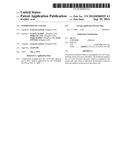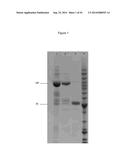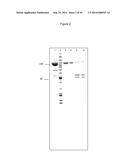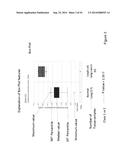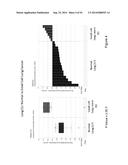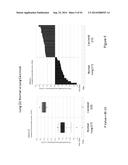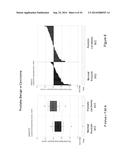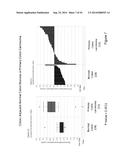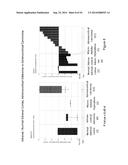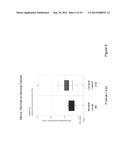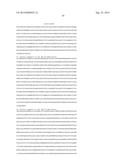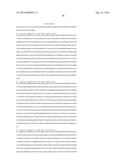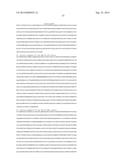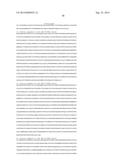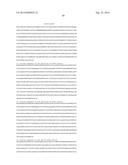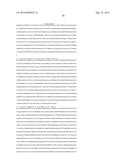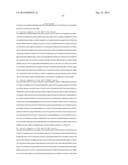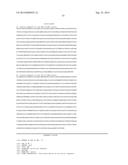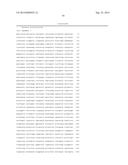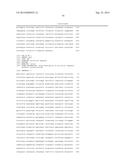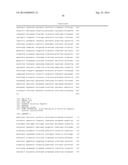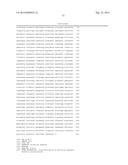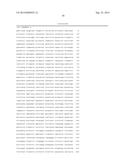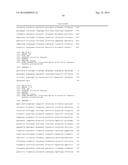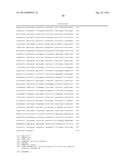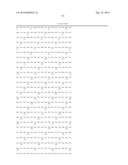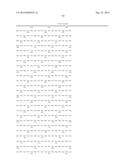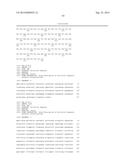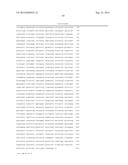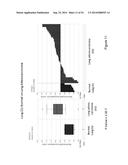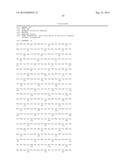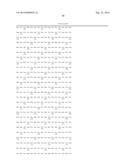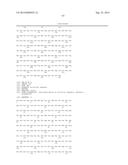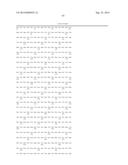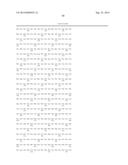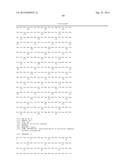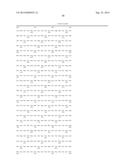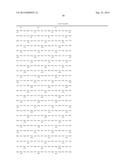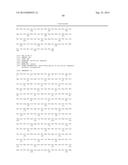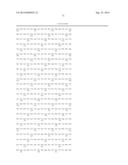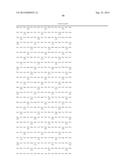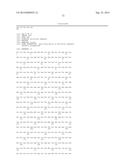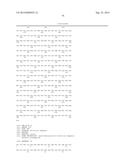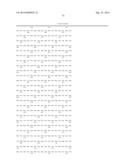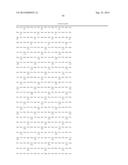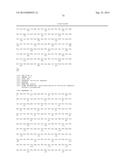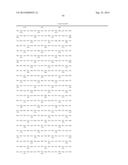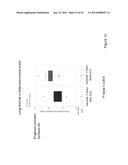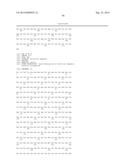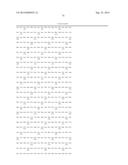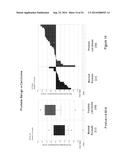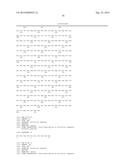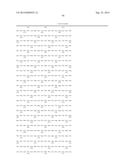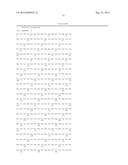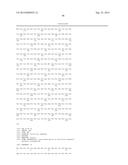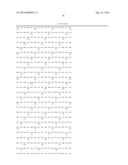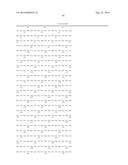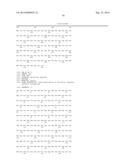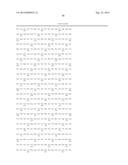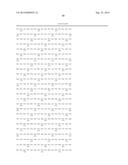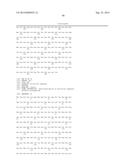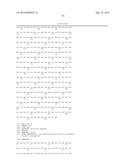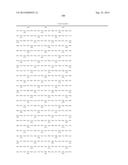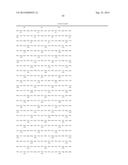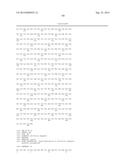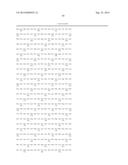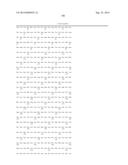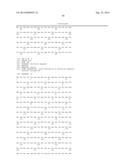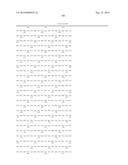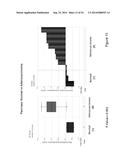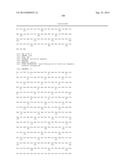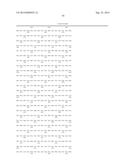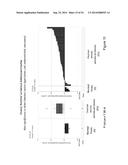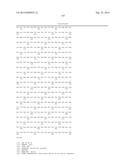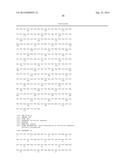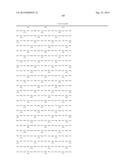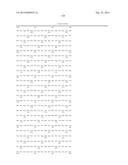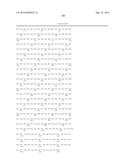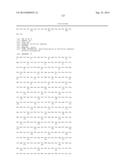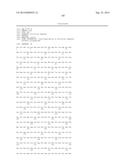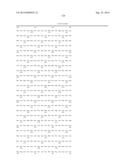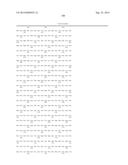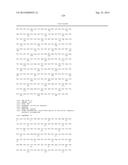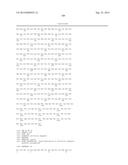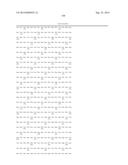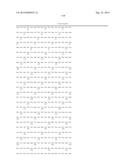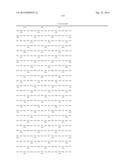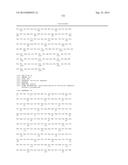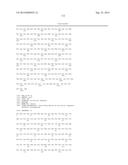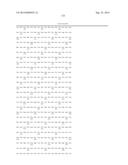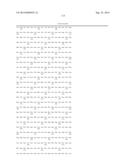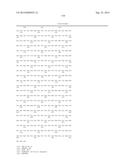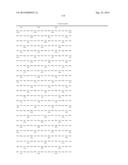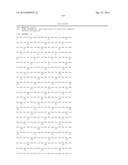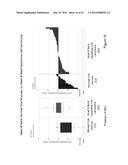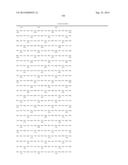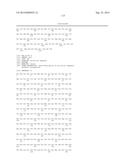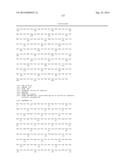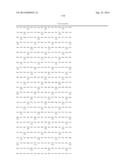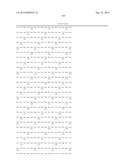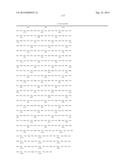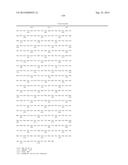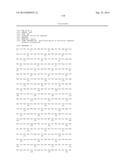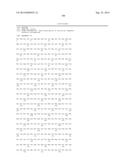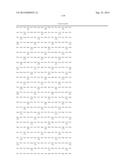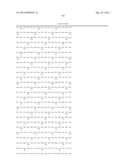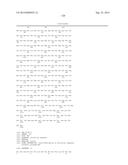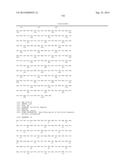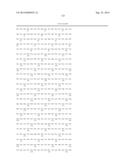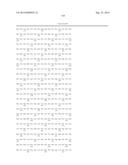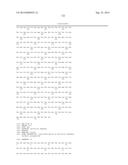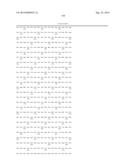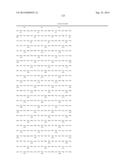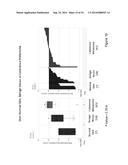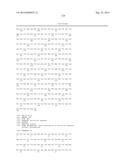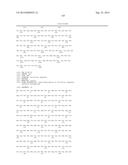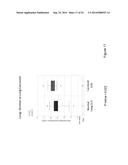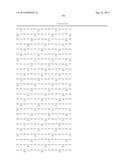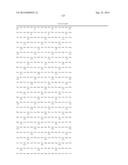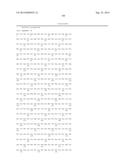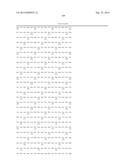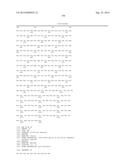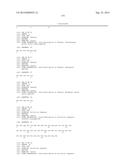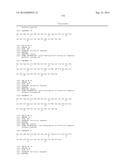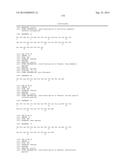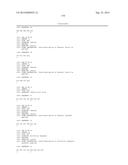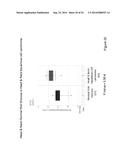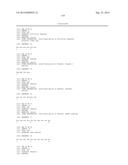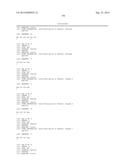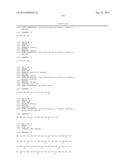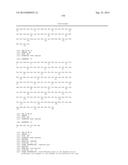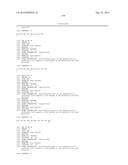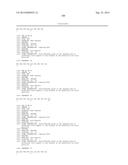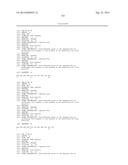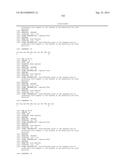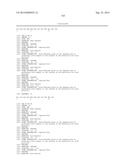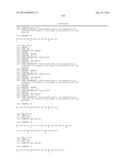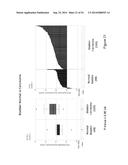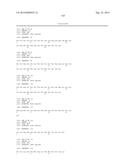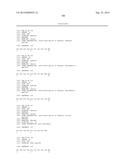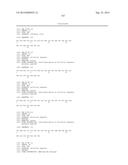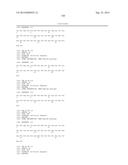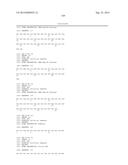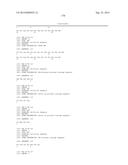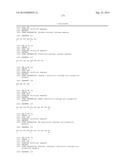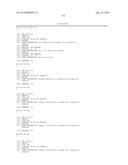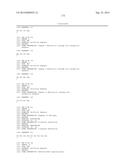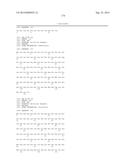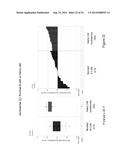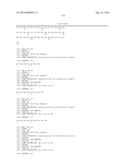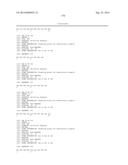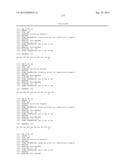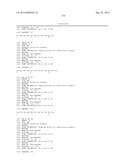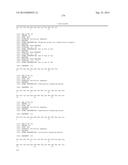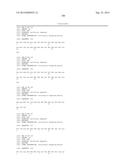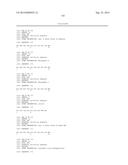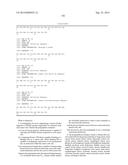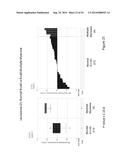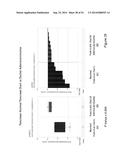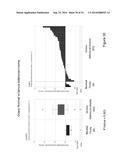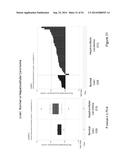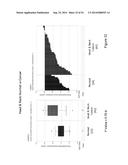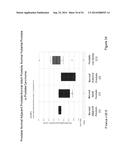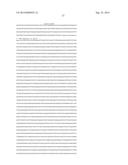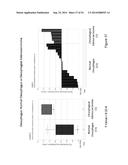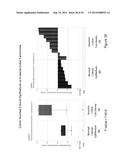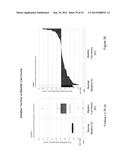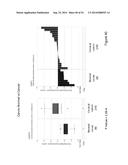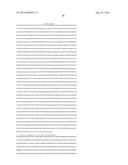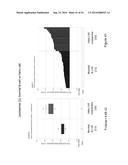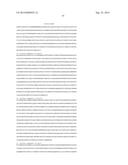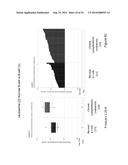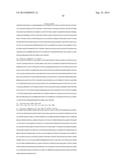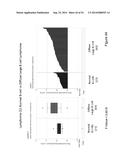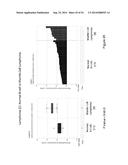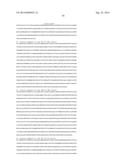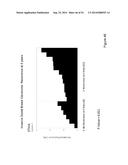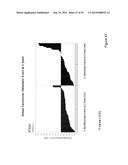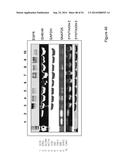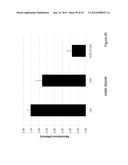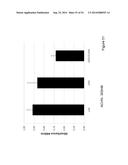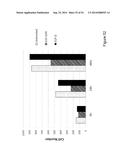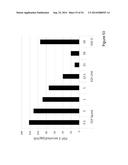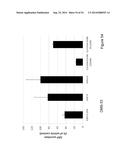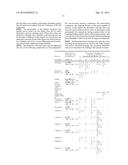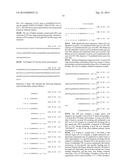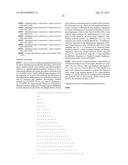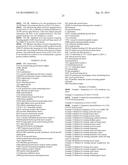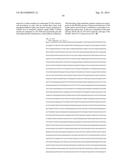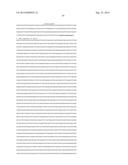Patent application title: SUPPRESSION OF CANCER
Inventors:
Frederic Madec (Abingdon, GB)
Philip Lecane (Abingdon, GB)
Philip Marks (Abingdon, GB)
Philip Marks (Abingdon, GB)
Keith Foster (Abingdon, GB)
Keith Foster (Abingdon, GB)
Assignees:
SYNTAXIN LIMITED
IPC8 Class: AC12N950FI
USPC Class:
424 943
Class name: Drug, bio-affecting and body treating compositions enzyme or coenzyme containing stabilized enzymes or enzymes complexed with nonenzyme (e.g., liposomes, etc.)
Publication date: 2014-09-25
Patent application number: 20140286925
Abstract:
The present invention relates to polypeptides for use in suppressing
cancer and cancer disorders. The treatment employs use of a non-cytotoxic
protease, which is targeted to the cancer cell, and, when so delivered,
the protease is internalised and inhibits secretion from the cancer cell.Claims:
1. A polypeptide, for use in suppressing a cancer cell that expresses a
SNARE protein responsible for secretion from said cancer cell, wherein
the polypeptide comprises: (i) a non-cytotoxic protease, which protease
is capable of cleaving said SNARE protein expressed in said cancer cell;
(ii) a Targeting Moiety (TM) that is capable of binding to a Binding Site
on a cancer cell, which Binding Site is capable of undergoing endocytosis
to be incorporated into an endosome within the cancer cell; and (iii) a
translocation domain that is capable of translocating the protease from
within an endosome, across the endosomal membrane and into the cytosol of
the cancer cell; wherein the polypeptide lacks the natural binding
function of a clostridial neurotoxin HCC domain which enables the
clostridial neurotoxin to bind to nerve terminals at the neuromuscular
junction; with the proviso that the cancer cell is not a neuroendocrine
tumour cell; and with the proviso that the polypeptide is not a
clostridial neurotoxin (holotoxin).
2. The polypeptide according to claim 1, wherein the cancer is selected from the group consisting of: lung cancer, renal cancer, brain cancer, breast cancer, pancreatic cancer, colorectal cancer, adrenal cancer, oesophageal cancer, lymphoma, B-cell lymphoma, mantle cell lymphoma, leukaemia, multiple myeloma, acute leukaemia, bladder cancer, bone cancer, bowel cancer, cervical cancer, chronic lymphocytic leukaemia, Hodgkin's lymphoma, liver cancer, skin cancer, oropharyngeal cancer, myeloma, prostate cancer, prostate soft tissue sarcoma, gastric cancer, testicular cancer, uterine cancer, and Kaposi sarcoma.
3. The polypeptide according to claim 1, wherein the cancer cell is selected from the group consisting of: a lung cancer cell, a renal cancer cell, a brain cancer cell, a breast cancer cell, a pancreatic cancer cell, a colorectal cancer cell, an adrenal cancer cell, an oesophageal cancer cell, a lymphoma cancer cell, a B-cell lymphoma cancer cell, a a mantle cell lymphoma cancer cell, a leukaemia cancer cell, a multiple myeloma cell, an acute leukaemia cancer cell, a bladder cancer cell, a bone cancer cell, a bowel cancer cell, a cervical cancer cell, a chronic lymphocytic leukaemia cell, a Hodgkin's lymphoma cell, a liver cancer cell, a melanoma skin cancer cell, an oropharyngeal cancer cell, a myeloma cell, a prostate cancer cell, a soft tissue sarcoma cell, a gastric cancer cell, a testicular cancer cell, a uterine cancer cell and a Kaposi sarcoma cancer cell.
4. The polypeptide of claim 1, wherein the TM binds to a receptor selected from the group consisting of: an ErbB receptor; an EGF receptor; a growth hormone-releasing hormone (GHRH) receptor; an insulin-like growth factor receptor (IGFR); a gastrin-releasing peptide (GRP) receptor; a bombesin peptide (BB) receptor; a growth hormone (GH) receptor; a vascular endothelial growth factor (VEGF) receptor; an acetylcholine (ACH) receptor; a somatostatin (SST) receptor; a cortistatin (CST) receptor; a chemokine (C-X-C motif) receptor such as CXCR4; a neuropilin receptor; a gonadotropin-releasing hormone (GnRH) receptor; a VIP-glucagon-GRF-secretin superfamily receptor; a PAC receptor; a VPAC receptor; a FLT receptor; a CHRN receptor; an EPH receptor; an EPHA receptor; an EFN receptor; a DLK1 receptor, a DLL3 receptor, a FGF receptor; a JAG receptor; a LIF receptor; a NMB receptor; a NOTCH receptor; a PDGF receptor; a c-kit receptor; a TGF receptor; an endothelin receptor; a chemokine receptor; and an angiopoietin receptor.
5. The polypeptide of claim 1, wherein the TM is selected from the group consisting of: an ErbB peptide, an EGF peptide, an adrenomedullin (ADM) peptide, an AM peptide, an AMF peptide, an amphiregulin peptide, an APRIL peptide, an artemin peptide, a betacellulin peptide, a bombesin peptide, a CTR peptide, an endothelin peptide, an erythropoietin peptide, a FGF peptide, a FSH peptide, a gastrin peptide, a gastrin releasing peptide (GRP), a GDNF peptide, a ghrelin peptide, a GHRH peptide, a G-CSF peptide, a growth hormone peptide, a HB-EGF peptide, a hepatocyte growth factor (HGF) peptide, an IL peptide, a keratinocyte growth factor peptide, a leptin peptide, a LIF peptide, an alpha-melanotropin peptide, a MGSA/GRO peptide, a NRG peptide, an oxytocin peptide, an osteopontin (OPN) peptide, a neuregulin-1 peptide, a VIP or PACAP peptide, a PDGF peptide, a prolactin peptide, a SCF peptide, a somatostatin (SST) peptide, a cortistatin (CST) peptide, a TNF peptide, a TGF peptide, a VEGF peptide, a vasopressin peptide, an angiopoietin peptide, a B-CLL peptide, a BCGF-12KD peptide, a BAFF peptide, a galanin peptide, a GDNF peptide, a GnRH peptide, an IGF-II peptide, a LH peptide, a neurotrophin peptide, a substance P peptide, a TGF-alpha peptide; an IGF peptide, an angiopoietin peptide, a CXC peptide and a CCL peptide.
6. The polypeptide of claim 1, wherein the non-cytotoxic protease comprises a clostridial neurotoxin L-chain or an IgA protease.
7. The polypeptide of claim 1, wherein the translocation domain comprises a clostridial neurotoxin translocation domain.
8. A polypeptide comprising: (i) a non-cytotoxic protease, which protease is capable of cleaving a SNARE protein expressed in a cancer cell, wherein said SNARE protein is responsible for secretion from the cancer cell; (ii) a Targeting Moiety (TM) that is capable of binding to a Binding Site on the cancer cell, which Binding Site is capable of undergoing endocytosis to be incorporated into an endosome within the cancer cell; and (iii) a translocation domain that is capable of translocating the protease from within an endosome, across the endosomal membrane and into the cytosol of the cancer cell; wherein the polypeptide lacks the natural binding function of a clostridial neurotoxin HCC domain which enables the clostridial neurotoxin to bind to nerve terminals at the neuromuscular junction; with the proviso that the cancer cell is not a neuroendocrine tumour cell; and with the proviso that the polypeptide is not a dostridial neurotoxin (holotoxin).
9. The polypeptide of claim 8, wherein the TM binds to a receptor selected from the group consisting of: an ErbB receptor; an EGF receptor; a growth hormone-releasing hormone (GHRH) receptor; an insulin-like growth factor receptor (IGFR); a gastrin-releasing peptide (GRP) receptor; a bombesin peptide (BB) receptor; a growth hormone (GH) receptor; a vascular endothelial growth factor (VEGF) receptor; an acetylcholine (ACH) receptor; a somatostatin (SST) receptor; a cortistatin (CST) receptor; a chemokine (C-X-C motif) receptor such as CXCR4; a neuropilin receptor; a gonadotropin-releasing hormone (GnRH) receptor; a VIP-glucagon-GRF-secretin superfamily receptor; a PAC receptor; a VPAC receptor; a FLT receptor; a CHRN receptor; an EPH receptor; an EPHA receptor; an EFN receptor; a DLK1 receptor, a DLL3 receptor, a FGF receptor; a JAG receptor; a LIF receptor; a NMB receptor; a NOTCH receptor; a PDGF receptor; a c-kit receptor; a TGF receptor; an endothelin receptor; a chemokine receptor; and an angiopoietin receptor.
10. A method of suppressing a cancer in a patient, comprising administering to the patient an effective amount of a polypeptide comprising: (i) a non-cytotoxic protease, which protease is capable of cleaving a SNARE protein expressed in a cancer cell, wherein said SNARE protein is responsible for secretion from the cancer cell; (ii) a Targeting Moiety (TM) that is capable of binding to a Binding Site on the cancer cell, which Binding Site is capable of undergoing endocytosis to be incorporated into an endosome within the cancer cell; and (iii) a translocation domain that is capable of translocating the protease from within an endosome, across the endosomal membrane and into the cytosol of the cancer cell; wherein the polypeptide lacks the natural binding function of a clostridial neurotoxin HCC domain which enables the clostridial neurotoxin to bind to nerve terminals at the neuromuscular junction; with the proviso that the cancer cell is not a neuroendocrine tumour cell; and with the proviso that the polypeptide is not a dostridial neurotoxin (holotoxin).
11. The method according to claim 10, wherein the TM binds to a receptor selected from the group consisting of: an ErbB receptor; an EGF receptor; a growth hormone-releasing hormone (GHRH) receptor; an insulin-like growth factor (IGF) receptor; a gastrin-releasing peptide (GRP) receptor; a bombesin peptide (BB) receptor; a growth hormone (GH) receptor; a vascular endothelial growth factor (VEGF) receptor; an acetylcholine (ACH) receptor; a somatostatin (SST) receptor; a cortistatin (CST) receptor; a chemokine (C-X-C motif) receptor; CXCR4; a neuropilin receptor; a gonadotropin-releasing hormone (GnRH) receptor; a VIP-glucagon-GRF-secretin superfamily receptor; a PAC receptor; a VPAC receptor; a FLT receptor; a CHRN receptor; an EPH receptor; an EPHA receptor; an EFN receptor; a DLK1 receptor, a DLL3 receptor, a FGF receptor; a JAG receptor; a LIF receptor; a NMB receptor; a NOTCH receptor; a PDGF receptor; a c-kit receptor; a TGF receptor; an endothelin receptor; a chemokine receptor; and an angiopoietin receptor.
12. The method according to claim 10, wherein the TM is selected from the group consisting of: an ErbB peptide, an EGF peptide, an adrenomedullin (ADM) peptide, an AM peptide, an autocrine motility factor (AMF) peptide, an amphiregulin peptide, an APRIL peptide, an artemin peptide, an autocrine motility factor (AMF) peptide, a betacellulin peptide, a bombesin peptide, a CTR peptide, an endothelin peptide, an erythropoietin peptide, a FGF peptide, a FSH peptide, a gastrin peptide, a gastrin releasing peptide (GRP), a GDNF peptide, a ghrelin peptide, a GHRH peptide, a G-CSF peptide, a growth hormone peptide, a HB-EGF peptide, a hepatocyte growth factor (HGF) peptide, an IL peptide, a keratinocyte growth factor peptide, a leptin peptide, a LIF peptide, an alpha-melanotropin peptide, a MGSA/GRO peptide, a NRG peptide, an oxytocin peptide, an osteopontin (OPN) peptide, a neuregulin-1 peptide, a VIP peptide, a PACAP peptide, a PDGF peptide, a prolactin peptide, a SCF peptide, a somatostatin (SST) peptide, a cortistatin (CST) peptide, a TNF peptide, a TGF peptide, a VEGF peptide, a vasopressin peptide, an angiopoietin peptide, a B-CLL peptide, a BCGF-12KD peptide, a BAFF peptide, a galanin peptide, a GDNF peptide, a GnRH peptide, an IGF-II peptide, a LH peptide, a NT peptide, a substance-P peptide, a TGF-alpha peptide; an IGF peptide, an angiopoietin peptide, a CXC peptide and a CCL peptide.
13. The method according to claim 10, wherein the non-cytotoxic protease comprises a clostridial neurotoxin protease or an IgA protease.
14. The method according to claim 10, wherein the translocation domain comprises a clostridial neurotoxin translocation domain.
15. The method according to claim 10, wherein said polypeptide comprises an amino acid sequence having at least 90% sequence identity to any one of SEQ ID NOs: 7, 10, 16, 17, 18, 19, 20, 21, 22, 23, 24, 25, 26, 27, 28, 29, 30, 31, 32, 33, 34, 35, 36, 37, 38, 39, 40, 41, 42, 43, or 44.
16. The method according to claim 10, for suppressing a cancer selected from the group consisting of: lung cancer, renal cancer, brain cancer, breast cancer, pancreatic cancer, colorectal cancer, colon cancer, rectal cancer, adrenal cancer, oesophageal cancer, lymphoma, B-cell lymphoma, mantle cell lymphoma, leukaemia, multiple myeloma, acute leukaemia, bladder cancer, bone cancer, bowel cancer, cervical cancer, chronic lymphocytic leukaemia, Hodgkin's lymphoma, liver cancer, skin cancer, oropharyngeal cancer, myeloma, prostate cancer, prostate soft tissue sarcoma, gastric cancer, testicular cancer, uterine cancer and Kaposi sarcoma.
17. The method according to claim 10, for suppressing secretion from a cancer cell selected from the group consisting of: a lung cancer cell, a renal cancer cell, a brain cancer cell, a breast cancer cell, a pancreatic cancer cell, a colorectal cancer cell, an adrenal cancer cell, an oesophageal cancer cell, a lymphoma cancer cell, a B-cell lymphoma cancer cell, a mantle cell lymphoma cancer cell, a leukaemia cancer cell, a multiple myeloma cancer cell, an acute leukemia cancer cell, a bladder cancer cell, a bone cancer cell, a bowel cancer cell, a cervical cancer cell, a chronic lymphocytic leukemia cell, a Hodgkin's lymphoma cell, a liver cancer cell, a skin cancer cell, an oropharyngeal cancer cell, a myeloma cell, a prostate cancer cell, a soft tissue sarcoma cell, a gastric cancer cell, a testicular cancer cell, a uterine cancer cell and a Kaposi sarcoma cell.
18. A nucleic acid encoding a polypeptide according to claim 8.
19. A nucleic acid encoding a polypeptide according to claim 8, wherein said nucleic acid comprises a nucleic acid sequence having at least 90-94%, or at least 95-97%, or at least 98-99% sequence identity to any one of SEQ ID NOs: 6 or 9.
20. A method of suppressing a cancer in a patient, comprising administering to the patient an effective amount of a nucleic acid according to claim 18.
Description:
[0001] This application is a continuation of U.S. patent application Ser.
No. 13/125,407, which is a U.S. National Stage of International Patent
Application Serial No. PCT/GB2009/051559, filed Nov. 17, 2009. Each of
the above-referenced applications is incorporated herein by reference in
its entirety.
[0002] Pursuant to the provisions of 37 C.F.R. §1.52(e)(5), the sequence listing text file named 99336_Seq_Lstng.txt, created on Jun. 4, 2014 and having a size of 357,888 bytes, and which is being submitted herewith, is incorporated by reference herein in its entirety.
[0003] The present invention relates to the suppression of cancer.
[0004] Cancers are made up of cells that divide, invade and survive in an aberrant manner in the body. Cancers develop when alterations to the DNA within cells affect the control of cell division and other processes relevant to cell survival. As cancerous tumours grow, they invade the body tissues surrounding them. This is harmful to the body as it damages surrounding normal tissues and has a significant effect on physiological responses. In addition, cancers may spread to other parts of the body and develop into secondary tumours. Assessment of cancer can be undertaken using a variety of tests including CT scan, MRI imaging, PET scans, combined PET-CT scan and ultrasound tests. Generally, the earlier a cancer is detected and confirmed, the better the overall prognosis for the patient.
[0005] A wide range of treatments are available for patients diagnosed with cancer. These include a variety of surgical interventions, radiotherapy, chemotherapy and hormone therapies. These treatments may be used in isolation but most commonly they are used in combination with each other. The use of a combination of therapies is dependent on the type of cancer diagnosed with certain cancers (such as breast cancer) commonly requiring multiple therapeutic interventions. There are a variety of new therapeutic approaches under development utilising biological products including antibodies, immunotherapies and vaccination techniques to treat cancer. Additional treatment approaches including the use of novel therapeutics designed to block angiogenesis are under development. Novel approaches including the use of gene therapy are also being investigated as potential therapeutics. However, despite the significant scientific efforts and huge financial commitment to developing new cancer therapies, the prognosis for many patients remains extremely poor.
[0006] Breast cancer is the most common cancer in the UK and every year more than 44,000 women are diagnosed with this type of cancer. Worldwide, more than a million women are diagnosed with breast cancer every year. In the UK, approximately 80% of patients will survive for 5 years or longer.
[0007] Lung cancer is the 2nd commonest cancer in the UK and over 37,000 people were diagnosed with lung cancer in the UK in 2003. For patients diagnosed with lung cancer, only approximately 20% will survive for at least 1 year after diagnosis and only approximately 6% will live for 5 years or longer after diagnosis.
[0008] Colorectal cancer is the 3rd commonest cancer type overall and it is the 2nd commonest affecting women (after breast cancer). Just over 35,000 people were diagnosed with colorectal cancer in the UK in 2003. Of those diagnosed with bowel and rectal cancer in England and Wales, 46% will survive for at least 5 years after their diagnosis.
[0009] Pancreatic cancer is the fourth most common cause of death from cancer in the Western world and over 7000 cases are diagnosed in the UK each year. Despite therapeutic advances only 3-4% of those diagnosed with pancreatic cancer survive for 5 years or longer and successful therapeutic intervention is limited to surgery that is applicable to only 15% of patients.
[0010] Renal cancer is the 9th commonest cancer type overall with over 7000 new cases diagnosed and greater than 3500 deaths in the UK each year. Around 208,500 new cases of renal cancer are diagnosed in the world each year, accounting for just under 2% of all cancers. It is commoner in men than in women, with a male to female ratio of 1.5:1. Thirty percent of renal cancer patients show signs of advanced renal cell carcinoma at initial diagnosis, with metastases detected in 15-25% of patients at this time.
[0011] Cancer represents a worldwide problem that is predicted to grow significantly. In the year 2000, malignant tumours were responsible for 12 per cent of the nearly 56 million deaths reported worldwide from all causes. In some countries, more than a quarter of deaths could be attributed to cancer. In 2000, 5.3 million men and 4.7 million women developed a malignant tumour and altogether 6.2 million died from the disease. It is predicted that cancer rates could further increase by 50% to 15 million new cases in the year 2020, (WHO World Cancer Report (IARC, Ed B. W. Stewart and P. Kleihues, 2003).
[0012] For a large number of cancers, autocrine signalling (defined as a mode of hormone action in which a hormone binds to receptors on and affects the function of the cell type that produced it) and/or paracrine signalling (defined as a mode of hormone action in which hormone released from endocrine or endocrine-like cells binds to receptors on nearby cells and affects their function), are believed to play a significant role in development of the disease state. For a given cancer, multiple autocrine signalling loops may be implicated in development and maintenance of the cancer state. In addition to providing a stimulus for cell division, autocrine signalling can enhance cell survival acting to protect cells from mechanisms of apoptosis and necrosis and increase the metastatic potential of the cancer cell.
[0013] There is therefore a need in the art for new therapies/therapeutics capable of specifically addressing cancer. This need is addressed by the present invention, which solves one or more of the above-mentioned problems.
[0014] In more detail, a first aspect of the present invention provides a polypeptide for use in suppressing cancer, wherein the polypeptide comprises:
(i) a non-cytotoxic protease, which protease is capable of cleaving a SNARE protein in a cancer cell; (ii) a Targeting Moiety (TM) that is capable of binding to a Binding Site on a cancer cell, which Binding Site is capable of undergoing endocytosis to be incorporated into an endosome within the cancer cell, and wherein said cancer cell expresses said SNARE protein; and (iii) a translocation domain that is capable of translocating the protease from within an endosome, across the endosomal membrane and into the cytosol of the cancer cell; and with the proviso that the cancer cell is not a neuroendocrine tumour cell; and with the proviso that the polypeptide is not a clostridial neurotoxin (holotoxin) molecule.
[0015] The polypeptide of the present invention is not a naturally-occurring dostridial neurotoxin molecule (also known as ciostridial holotoxin). Clostridial holotoxin is one of the most lethal neurotoxins known to man, and, as such, has significant limitations as a therapeutic molecule. Also, in the context of cancer, clostridial holotoxin is associated with undesirable off-site targeting (ie. targeting of non-cancer cells), for example to the neuromuscular junction.
[0016] In use, a polypeptide of the invention binds to a cancer cell. Thereafter, the translocation component effects transport of the protease component into the cytosol of the cancer cell. Finally, once inside, the protease inhibits the exocytic fusion process of the cancer cell by cleaving SNARE protein present in the cytosol of the cancer cell. Thus, by inactivating the exocytic fusion apparatus of the cancer cell, the polypeptide of the invention inhibits secretion (eg. of TNF-alpha, acetylcholine, fibroblastic growth factor, gastrin releasing peptide, interleukin-6, VEGF, and/or autocrine mobility factor) therefrom. Accordingly, where said secretion peptides are, for example, involved in autocrine or paracrine signalling, the polypeptide of the invention reduces the signalling drive that the autocrine/paracrine loop would otherwise provide to the cancer cell. Accordingly, the polypeptides of the present invention are capable of suppressing or treating cancer.
[0017] The first aspect also embraces a corresponding method for suppressing cancer, said method comprising administering a therapeutically effective amount of a polypeptide of the present invention to a patient. The present invention thereby provides an effective means for treating cancer such as renal, breast, lung, pancreatic, and colorectal (eg. colon).
[0018] The polypeptides of the present invention provide a distinct advantage over other therapeutics in that they have the potential to inhibit the secretion of multiple autocrine and paracrine peptides from a targeted cancer cell using a single therapeutic molecule. This reduces significantly the ability of a cancer to adapt to a specific treatment regime by switching to and using alternative autocrine signalling pathways. Thus, the present invention provides a more efficacious therapy by blocking multiple pathways simultaneously.
[0019] The principal target cell of the present invention is a cancer cell, for example a cancer cell that secretes one or more hormones (or other bioactive molecules), which, once secreted, bind to a receptor on and affect the function of said cancer cell. Examples of cancer cells targeted by the present invention include: breast, lung, pancreatic, colorectal (eg. colon), adrenal, oesophageal, lymphoma (eg. B-cell; Mantell cell), leukaemia (eg. multiple myeloma), acute leukaemia, bladder, bone, brain tumours, bowel, cervical, chronic lymphocytic leukaemia, Hodgkin's lymphoma, renal, liver, skin (eg. basal, squamous, melanoma), oropharyngeal, myeloma, prostate (eg. soft tissue sarcoma), gastric, testicular, and uterine.
[0020] In one embodiment, the target cell of the present invention is a cancer cell in which the level of SNARE protein expression is undesirable.
[0021] For example, undesirable SNARE expression may occur when the expression of a SNARE protein is up-regulated when compared with the same (or very similar) cell type when in a non-cancerous state. In one embodiment, the mRNA encoding a SNARE protein is up-regulated in a target cancer cell. In another (or the same) embodiment, the cellular protein concentration of a SNARE protein is (also) increased in the target cancer cell. When measuring SNARE mRNA or protein levels, a value of `one` may be assigned to the SNARE mRNA or protein concentration in a non-cancerous cell of a normal individual, which cell is otherwise the same (or very similar) to the cell type of the cancer cell in question--this value might be described as a `basal expression level`, and is typically an average of expression level values obtained from several cells (of the same or very similar type) and/or from different normal individuals. For example, a lung cell (e.g. a neuroectodermal lung cell, or a lung epithelium cell) in a normal individual may be used for comparison with a small cell lung cancer cell. Thus, up-regulated in the context of the present invention means that the SNARE mRNA or protein level is `greater than 1` when compared with the same cell type in a non-cancerous state in a normal individual. In one embodiment, the SNARE protein or mRNA level is up-regulated by greater than 2- or 3-fold, or by greater than 4- or 5-fold, or by greater than 6- or 7-fold. In another embodiment, the SNARE protein or mRNA level is up-regulated by greater than 8- or 9-fold, or by greater than 10- or 12-fold, or by greater than 15- or 20-fold. In another embodiment, the SNARE protein or mRNA level is up-regulated by greater than 40- or 50-fold, or by greater than 60- or 70-fold, or by greater than 90- or 100-fold.
[0022] Alternatively, undesirable SNARE expression may occur when the level of SNARE mRNA and/or protein expression in a cancer cell is substantially normal (ie. substantially the same) when compared with that of a corresponding identical or very similar non-cancerous cell type. In this scenario, however, for example when a patient is suffering from a [prostate, bladder or cervical carcinoma], even a low or normal level of SNARE protein expression may support a secretion from the cancer cells of this type that is paracrine or autocrine in function, and so in the context of the cancer, the SNARE protein is supporting an undesirable secretion. In this scenario, the polypeptides of the present invention are capable of suppressing secretion from said cancer cells, and thereby addressing this need in the art.
[0023] In this regard, the present inventors have identified undesirable SNARE expression in a range of cancer cell types. These data are presented as Box Plots in FIGS. 3-47. In summary, the present inventors have confirmed that undesirable SNARE expression such as SNAP-25, syntaxin (eg. syntaxin-1a, syntaxin-2), and VAMP (eg. VAMP-1) is observed in small cell lung cancer cells (eg. when compared with normal lung cells); that undesirable SNARE expression such as SNAP-25, syntaxin (eg. syntaxin-2), VAMP (eg. VAMP-1, VAMP-2, VAMP-3) is observed in lung carcinoid cells; that undesirable SNARE expression such as SNAP-25, syntaxin (eg. syntaxin-2), VAMP (eg. VAMP-1, VAMP-2) is observed in lung carcinoid cells (eg. when compared with normal lung cells); that undesirable SNARE expression such as SNAP-25, syntaxin (eg. syntaxin-2, syntaxin-3), and VAMP (eg. VAMP-1, VAMP-3) is observed in bladder carcinoma cells; that undesirable SNARE expression such as SNAP-25, syntaxin (eg. syntaxin-1a), and VAMP (eg. VAMP-2) is observed in breast cancer cells; that undesirable SNARE expression such as SNAP-25, syntaxin (eg. syntaxin-1a, syntaxin-1b, syntaxin-2, syntaxin-3), and VAMP (eg. VAMP-1, VAMP-2, and VAMP-3) is observed in pancreatic adenocarcinoma cells (eg. when compared with normal pancreatic cells); that undesirable SNARE expression such as SNAP-25, syntaxin (eg. syntaxin-1a, syntaxin-1b, syntaxin-3), and VAMP (eg. VAMP-2, VAMP-3) is observed in prostate carcinoma cells (eg. when compared with benign prostate cells); that undesirable SNARE expression such as SNAP-25, syntaxin (eg. syntaxin-2), and VAMP (eg. VAMP-3) is observed in cervix cancer cells (eg. when compared with normal cervix cells); that undesirable SNARE expression such as syntaxin (eg. syntaxin 3) and VAMP (eg. VAMP-1, VAMP-2, VAMP-3) is observed in B-cell leukaemia cells (eg. when compared with normal B-cell lymphocytes); that undesirable SNARE expression such as syntaxin (eg. syntaxin-1a, syntaxin-3) and VAMP (eg. VAMP-1) is observed (eg. up-regulated) in ovarian cancer cells (eg. when compared with normal ovary cells); that undesirable SNARE expression such as SNAP-25 and VAMP (eg. VAMP-1, VAMP-2, VAMP-3) is observed in gastrointestinal (GI) carcinoid cells (eg. when compared with normal GI cells); and that undesirable SNARE expression such as SNAP-25, syntaxin (eg. syntaxin-1a, syntaxin-2) and VAMP (eg. VAMP-3) is observed (eg. up-regulated) in head and neck cancer cells (eg. when compared with normal head and neck cells). In addition, the present inventors have identified that undesirable SNARE expression such as SNAP-25 and VAMP (eg. VAMP-2) is observed in colon cancer cells; that undesirable SNARE expression such as SNAP-25 is observed in adrenal cancer cells; that undesirable SNARE expression such as syntaxin (eg. syntaxin-2) is observed in skin (eg. melanoma) cancer cells; that undesirable SNARE expression such as syntaxin (eg. syntaxin-3) is observed in leukemia (eg. multiple melanoma) cancer cells; that undesirable SNARE expression such as syntaxin (eg. syntaxin-1a) and VAMP (eg. VAMP-1) is observed in lung adenocarcinoma cells; that undesirable SNARE expression such as VAMP (eg. VAMP-1) is observed in liver cancer cells; that undesirable SNARE expression such as VAMP (eg. VAMP-2) is observed in oesophagus cancer cells; and that undesirable SNARE expression such as VAMP (eg. VAMP-3) is observed in lymphoma cancer cells (eg. B-cell lymphoma and Mantell cell).
[0024] The `bioactive` component of the polypeptides of the present invention is provided by a non-cytotoxic protease. This distinct group of proteases act by proteolytically-cleaving intracellular transport proteins known as SNARE proteins (e.g. SNAP-25, VAMP, or Syntaxin)--see Gerald K (2002) "Cell and Molecular Biology" (4th edition) John Wiley & Sons, Inc. The acronym SNARE derives from the term Soluble NSF Attachment Receptor, where NSF means N-ethylmaleimide-Sensitive Factor. SNARE proteins are integral to intracellular vesicle formation, and thus to secretion of molecules via vesicle transport from a cell. Accordingly, once delivered to a desired target cell, the non-cytotoxic protease is capable of inhibiting cellular secretion from the target cell.
[0025] Non-cytotoxic proteases are a discrete class of molecules that do not kill cells; instead, they act by inhibiting cellular processes other than protein synthesis. Non-cytotoxic proteases are produced as part of a larger toxin molecule by a variety of plants, and by a variety of microorganisms such as Clostridium sp. and Neisseria sp.
[0026] Clostridial neurotoxins represent a major group of non-cytotoxic toxin molecules, and comprise two polypeptide chains joined together by a disulphide bond. The two chains are termed the heavy chain (H-chain), which has a molecular mass of approximately 100 kDa, and the light chain (L-chain), which has a molecular mass of approximately 50 kDa. It is the L-chain, which possesses a protease function and exhibits a high substrate specificity for vesicle and/or plasma membrane associated (SNARE) proteins involved in the exocytic process (eg. synaptobrevin, syntaxin or SNAP-25). These substrates are important components of the neurosecretory machinery.
[0027] Neisseria sp., most importantly from the species N. gonorrhoeae, and Streptococcus sp., most importantly from the species S. pneumoniae, produce functionally similar non-cytotoxic toxin molecules. An example of such a non-cytotoxic protease is IgA protease (see WO99/58571, which is hereby incorporated in its entirety by reference thereto). Thus, the non-cytotoxic protease of the present invention is preferably a dostridial neurotoxin protease or an IgA protease.
[0028] Turning now to the Targeting Moiety (TM) component of the present invention, it is this component that binds the polypeptide of the present invention to a cancer cell. The TM is preferably a peptide.
[0029] The TM binds to a Binding Site on the cancer cell, thereby providing selectivity of the polypeptide to this species of target cell over other cells. By way of example, in gastric cancer, the TM preferably binds to gastric cancer cells in preference to other cells of the stomach, such as those that are not cancerous and/or to other non-cancerous (or cancerous) cells in the body. In this regard, preferred TM embodiments of the present invention include antibodies (eg. monocional antibodies, antibody fragments such as Fab, F(ab)'2, Fv, ScFv, etc., and antibody domains peptides), as well as binding scaffolds, which bind to the receptors identified below. Accordingly, the polypeptides of present invention may include commercially available antibodies or binding scaffolds, which have been designed to achieve specific binding to the target cell or receptor in question. Alternatively, preferred TMs include peptide ligands, such as cytokines, growth factors, neuropeptides, and lectins.
[0030] A TM of the present invention binds to a receptor on a cancer cell. By way of example, a TM of the present invention binds to a receptor on a cancer cell selected from the group comprising: a growth hormone-releasing hormone (GHRH, aka GHRF/GRF) receptor; an insulin-like growth factor receptor (e.g. an IGF-1 receptor); a corticotropin releasing factor receptor (e.g. CRHR-2); a gastrin-releasing peptide (GRP) receptor; a bombesin peptide (BB) receptor such as BRS-1, BRS-2, or BRS-3; a growth hormone (GH) receptor; an interleukin receptor (e.g. IL8RA or IL13RA1); a vascular endothelial growth factor (VEGF) receptor; an acetylcholine (ACH) receptor; a somatostatin (SST) receptor, such as SST1, SST2, SST3, SST4 or SST5; a cortistatin (CST) receptor; a chemokine (C-X-C motif) receptor such as CXCR4; a neuropilin receptor; a gonadotropin-releasing hormone (GnRH) receptor; a VIP-glucagon-GRF-secretin superfamily receptor, such as a PAC (eg. PAC1) receptor or a vasoactive intestinal peptide VPAC receptor (e.g. VPAC-1 or VPAC-2) receptor; or an ErbB family member receptor such as an EGF receptor. All of these receptors are over-expressed in cancer cells.
[0031] In one embodiment of the present invention, the TM binds to a receptor on a cancer cell selected from the group comprising: FLT such as FLT1, FLT4, FLT3, BRS such as BRS3; CHRN such as CHRNA1, CHRND or CHRNE; EPHA such as EPHA7, EPHA4, EPHA5, EPHA3, EPHA1, EPHA2; EFN such as EFNB3, EFNA1, EFNB2, EFNA3, EFNB1; ErbB such as ERBB2, ERBB4; DLK1, DLL3, FGF such as FGFR1, FGFR3, FGFR2; GRPR; GNRHR; GRPR; GnRHR; JAG such as JAG1 (CD339) or JAG2, IFGR such as IGF1R; leukaemia inhibitory factor receptor (LIFR); NMBR; NOTCHR such as NOTCH3 or NOTCH4; VIPR such as VIPR1; VEGFR such as VEGFR2; SSTR such as SSTR1; NMBR; or PDGFR such as PDGFRA or PDGFRB. All of these receptors are over-expressed in cancer cells.
[0032] In one embodiment, the TM is selected from: an adrenomedullin (ADM) peptide, an AM peptide, an autocrine motility factor (AMF) peptide, an amphiregulin peptide, an APRIL (a proliferation-inducing ligand) peptide, an artemin peptide, a betacellulin peptide, a bombesin peptide, a calcitonin receptor (CTR) binding peptide, an ErbB peptide such as an EGF peptide, an endothelin peptide, an erythropoietin peptide (EPO), a fibroblast growth factor (FGF) peptide such as a FGF-5 peptide, an FGF-18 peptide, a bFGF, a FGF8 or a FGF17 peptide, a follicle-stimulating hormone (FSH) peptide, a gastrin peptide, a gastrin releasing peptide (GRP), a glial cell line-defined neurotrophic factor (GDNF) peptide, a ghrelin (GHRL) peptide, a growth hormone-releasing hormone (GHRH) peptide, a granulocyte colony-stimulating factor (G-CSF) peptide, a growth hormone (GH) peptide, a heparin-binding EGF-like growth factor (HB-EGF) peptide, a hepatocyte growth factor/scatter factor (HGF/SF) peptide, an interleukin (IL) such as an IL-1 alpha peptide, an IL-6 peptide, an IL-8 peptide or an IL-10 peptide, an IGF-1 peptide, a stromal cell-derived factor-1 (SDF-1) peptide, a keratinocyte growth factor (KGF) peptide, a proepithelin/granulin peptide, a leptin (LEP) peptide, a LIF peptide, an alpha-melanotropin peptide, a MGSA/GRO-alpha, beta or gamma peptide, a NRG-1 alpha peptide, an oxytocin peptide, an osteopontin (OPN) peptide, a neuregulin-1 peptide, a PACAP peptide, a PDGF peptide such as a PDGF-alpha peptide, a PDGF-beta peptide, a PDGF-C peptide or a PDGF-D peptide, a prolactin peptide, a SCF peptide, a somatostatin peptide, a tumour necrosis factor (TNF) peptide such as a TNF-alpha peptide, a TGF-beta peptide, a TGF-beta1 peptide, a VEGF peptide such as a VEGF-C peptide or a VEGF-D peptide, a vasopressin peptide, a VIP peptide, an angiopoietin peptide such as an angiopoietin-1 peptide or angiopoietin-2 peptide, a B-CLL peptide, a BCGF-12KD peptide, a BAFF peptide, a galanin peptide, a GDNF peptide, a GnRH peptide, an IGF-II peptide, a LH peptide, a neurotrophin peptide, a substance P peptide, or a TGF-alpha peptide; as well as truncations and peptide analogues thereof.
[0033] In one embodiment, a TM of the present invention binds to a leptin receptor. Suitable examples of such TMs include: leptin peptides such as a full-length leptin peptide (eg. leptin167), and truncations or peptide analogues thereof such as leptin22-167, leptin70-95, and leptin116-122.
[0034] In another embodiment, a TM of the present invention binds to a ghrelin receptor. Examples of suitable TMs in this regard include: ghrelin peptides such as full-length ghrelin (eg. ghrelin117) and truncations or peptide analogues thereof such as ghrelin24-117, and ghrelin52-117; [Trp3, Arg5]-ghrelin (1-5), des-Gln-Ghrelin, cortistatin-8, His-D-Trp-Ala-Trp-D-Phe-Lys-NH2, growth hormone releasing peptide (e.g. GHRP-6), or hexarelin.
[0035] In one embodiment, a TM of the present invention binds to a somatostatin (SST) receptor. By way of example, suitable TMs include: SST peptides and cortistatin (CST)-peptides, as well as peptide analogues thereof such as D-Phe-Phe-Phe-D-Trp-Lys-Thr-Phe-Thr-NH2 (BIM 23052), D-Phe-Phe-Tyr-D-Trp-Lys-Val-Phe-D-Nal-NH2 (BIM 23056) or c[Cys-Phe-Phe-D-Trp-Lys-Thr-Phe-Cys]-NH2 (BIM-23268). Further examples include the SST peptides SST-14 and SST-28; as well as peptide and peptide analogues such as: octreotide, lanreotide, BIM23027, vapreotide, seglitide, and SOM230. These TMs are preferred TMs for binding to SST receptors, in particular to sst1, sst2, sst3, sst4 and sst5 receptors.
[0036] In another embodiment, a TM of the present invention binds to a gonadotropin-releasing hormone (GnRH) receptor. GnRH is also known as Luteinizing-Hormone Releasing Hormone (LHRH). Examples of suitable GnRH receptor TMs include: GnRHI peptides, GnRHII peptides and GnRHIII peptides, for example the full-length 92 amino acid GnRH precursor polypeptide and truncations thereof such as the decapeptide: pyroGlu-His-Trp-Ser-Tyr-Gly-Leu-Arg-Pro-Gly CONH2.
[0037] In one embodiment, a TM of the present invention binds to insulin-like growth factor (IGF) receptor. Suitable examples include, for example IGF-1 peptides and IGF-2 peptides.
[0038] In one embodiment, a TM of the present invention binds to a VIP-glucagon-GRF-secretin superfamily receptor, such as to a PAC (eg. PAC1) or to a VPAC (e.g. VPAC-1 or VPAC-2) receptor. Suitable examples of such TMs include pituitary adenylate cyclase-activating peptides (PACAP), vasoactive intestinal peptides (VIP), as well as truncations and peptide analogues thereof.
[0039] In one embodiment the TM is a VIP peptide including VIP-1 and VIP-2 peptides, for example VIP(1-28), or a truncation or peptide analogue thereof. These TMs demonstrate a selective binding to VPAC-1. Alternatively, a TM demonstrating a selective binding to VPAC2 may be employed, such as, for example mROM (see Yu et al., Peptides 27 (6) p1359-66 (2006), which is hereby incorporated by reference thereto). In another embodiment, the TM may be a PACAP peptide, for example PACAP(1-38) or PACAP(1-27), or a truncation of peptide analogue thereof. These TMs are preferred TMs for binding to PAC (eg. PAC-1) receptors.
[0040] In one embodiment, a TM of the present invention binds to an interleukin receptor. Suitable TM examples include: IL-1 peptides (e.g. IL-1α, IL-β, IL-18 peptides) and truncations or peptide analogues thereof, IL-2 peptides (e.g. IL-2, IL-3, IL-12, IL-23 peptides) and truncations or peptide analogues thereof, IL-6 and IL-8 peptides and truncations or peptide analogues thereof, and IL-17 peptides (e.g. II-17A, IL-17C peptides) and truncations or peptide analogues thereof.
[0041] In another embodiment, a TM of the present invention binds to an NGF receptor. Examples of suitable TMs include full-length NGF, and truncations or peptide analogues thereof.
[0042] In one embodiment, a TM of the present invention binds to a vasoactive epidermal growth factor (VEGF) receptor. Examples of suitable TMs include: VEGF peptide (e.g. VEGF-A, VEGF-B, VEGF-C, VEGF-D or VEGF-E and associated splice variants) and truncations or peptide analogues thereof, and placental growth factor (PIGF) and truncations or peptide analogues thereof.
[0043] In another embodiment, a TM of the present invention binds to an ErbB receptor. By way of example, the TM is selected from EGF peptides, transforming growth factor-α (TGF-α) peptides, chimeras of EGF and TGF-α, amphiregulin peptides, betacellulin peptides, epigen peptides, epiregulin peptides, heparin-binding EGF (HB-EGF) peptides, neuregulin (NRG) peptides such as NRG1α, NRG1β, NRG2α, NRG2β, NRG3, NRG4 and neuroregulin splice variants, tomoregulin 1 and 2 peptides, neuroglycan-C peptides, lin-3 peptides, vein peptides, gurken peptides, spitz peptides, or keren peptides; as well as truncations and peptide analogues thereof. There are 4 classes of ErbB receptor (termed ErbB1, erbB2, erbB3 and erbB4), which are also referred to as HER receptors. A number of variants of these receptors exist, which arise from alternate splicing and/or cleavage of the full-length receptor (eg EGFR v1 translation starts at aa543; EGFR vII deletion of aa521-603; EGFR vIII deletion of aa 6-273; EGFRvIII/Δ12-13 deletion of aa 6-273 and 409-520; EGFR vIV deletion of aa 959-1030; EGFR vV truncation at residue 958; EGFR TDM/2-7 tandem duplication of 6-273; EGFR TDM/18-25 tandem duplication of 664-1030; EGFR-TDM/18-26 tandem duplication of 664-1014). In addition, there are four ErbB4 receptor isoforms called erbB4 JM-a, erbB4 JM-b, erbB4 CYT-1 and erbB4 CYT-1.
[0044] Preferred TMs bind to ErbB receptors (eg. ErbB1, ErbB2, ErbB3, ErbB4) and splice variants thereof, in particular the ErbB1 receptor. ErbB TMs may also include proteins which contain EGF motifs with a splice site between the fourth and fifth cysteines within the six cysteine EGF-module, where this module is placed in close proximity to the transmembrane region of the potential ligand. For example, interphotoreceptor matrix proteoglycan-2 (IMP-2), meprin (MEP)1α, MEP1β, mucin (MUC)3, MUC4, MUC12. and MUC17, as well as proteins with a T-knot scaffold such as potato carboxypeptidase inhibitor, and antibodies to ErbB receptors such as cetuximab, ABX-EGF, trastuzumab, or EMD72000. Further examples include chimeras generated by swapping domains (loop sequences and/or connecting amino acids) of different ErbB ligands, such as a mammalian erbB receptor ligand in which the B-loop sequence has replaced by those present in the insect (Drosophila) ErbB ligands, an ErbB ligand in which the C-loop sequence of EGF has been replaced by that of TGFα(44-50), EGF ligands in which one or more domain has been replaced by corresponding sequences in TGFα to create EGF/TGFα chimeras (e.g. E3T, T3E, E4T, T4E, T3E4T, T6E and E3T4E, and EGF chimeras in which the N-terminal TGFα sequence (WSHFND) or the neuregulin sequence (SHLVK) has been used to replace the N-terminal EGF sequence C-terminal of the first cysteine residue (NSDSE), T1E, and Biregulin. Yet further chimeras include EGF in which a domain has been replaced by an EGF-like domain of another protein, such as a blood coagulation, neural development or cell adhesion protein (e.g. Notch 3, Delta 1, EMR1, F4/80, EMR3 and EMR4 receptors).
[0045] In another embodiment, a TM of the present invention binds to a growth-hormone-releasing hormone (GHRH) receptor. GHRH is also known as growth-hormone-releasing factor (GRF or GHRF) or somatocrinin. Suitable TM examples of the present invention include the full-length GHRH (1-44) peptide, and truncations or peptide analogues thereof such as GHRH(1-29); GHRH(1-37); hGHRH(1-40)-OH; [MeTyr1,Ala 15,22,Nle27]-hGHRH(1-29)-NH2; [MeTyr1,Ala8,9,15,22,28,Nle 27]-hGHRH(1-29)-NH2; cyclo(25-29)[MeTyr1,Ala15,DAsp25,Nle27,Orn29+++]-hGHRH(1-29)-NH2; (D-Tyr1)-GHRH (1-29)-NH2; (D-Ala2)-GHRH (1-29)-NH2; (D-Asp3)-GHRH (1-29)-NH2 (D-Ala4)-GHRH (1-29)-NH2; (D-Thr7)-GHRH (1-29)-NH2; (D-Asn8)-GHRH (1-29)-NH2; (D-Ser9)-GHRH (1-29)-NH2; (D-Tyr10)-GHRH (1-29)-NH2; (Phe4)-GHRH (1-29)-NH2; (pCI-Phe6)-GHRH (1-29)-NH2; (N-Ac-Tyr1)-GHRH (1-29)-NH2; (N-Ac-Tyr1, D-Ala2)-GHRH (1-29)-NH2; (N-Ac-D-Tyr1, D-Ala2)-GHRH (1-29)-NH2; (N-Ac-D-Tyr1, D-Ala 2, D-Asp3)-GHRH (1-29)-NH2; (D-Ala2, NLeu27)-GHRH (1-29)-NH2; (His1, D-Ala2, NLeu27)-GHRH (1-29)-NH2; (N-Ac-His1, D-Ala2, N-Leu27)-GHRH (1-29)-NH2; (His1, D-Ala 2, D-Ala 4, Nleu27)-GHRH (1-29)-NH2; (D-Ala2, D-Asp3, D-Asn8, NLeu27)-GHRH (1-29)-NH2; (D-Asp3, D-Asn8, NLeu27)-GHRH (1-29)-NH2; [His1, NLeu27]-hGHRH(1-29)-NH2; [NLeu27]-hGHRH(1-29)-NH2; H-Tyr-Ala-Asp-Ala-Ile-Phe-Thr-Asn-Ser-Tyr-Arg-Lys-Val-Leu-Gly-Gln-Leu-Ser- -Ala-Arg-Lys-Leu-Leu-Gln-Asp-Ile-Met-Ser-Arg-Gln-Gln-Gly-Glu-Ser-Asn-Gln-G- lu-Arg-Gly-Ala-Arg-Ala-Arg-Leu-NH2 (SEQ ID NO: 113); H-Tyr-Ala-Asp-Ala-Ile-Phe-Thr-Asn-Ser-Tyr-Arg-Lys-Val-Leu-Gly-Gln-Leu-Ser- -Ala-Arg-Lys-Leu-Leu-Gln-Asp-Ile-Met-Ser-Arg-NH2 (SEQ ID NO: 114); H-Tyr-D-Ala-Asp-Ala-Ile-Phe-Thr-Asn-Ser-Tyr-Arg-Lys-Val-Leu-Gly-Gln-Leu-S- er-Ala-Arg-Lys-Leu-Leu-Gln-Asp-Ile-Met-Ser-Arg-NH2 (SEQ ID NO: 115); H-Tyr-Ala-Asp-Ala-Ile-Phe-Thr-Asn-Ser-Tyr-Arg-Lys-Ile-Leu-Gly-Gln-Leu-Ser- -Ala-Arg-Lys-Leu-Leu-Gln-Asp-Ile-Met-Asn-Arg-Gln-Gln-Gly-Glu-Arg-Asn-Gln-G- lu-Gln-Gly-Ala-Lys-Val-Arg-Leu-NH2 (SEQ ID NO: 116); H-Tyr-Ala-Asp-Ala-Ile-Phe-Thr-Asn-Ser-Tyr-Arg-Lys-Val-Leu-Gly-Gln-Leu-Ser- -Ala-Arg-Lys-Leu-Leu-Gln-Asp-Ile-Met-Asn-Arg-Gln-Gln-Gly-Glu-Arg-Asn-Gln-G- lu-Gln-Gly-Ala-Lys-Val-Arg-Leu-NH2 (SEQ ID NO: 117); His-Val-Asp-Ala-Ile-Phe-Thr-Gln-Ser-Tyr-Arg-Lys-Val-Leu-Ala-Gln-Leu-Ser-A- la-Arg-Lys-Leu-Leu-Gln-Asp-Ile-Leu-Asn-Arg (SEQ ID NO: 118); and His-Val-Asp-Ala-Ile-Phe-Thr-Gln-Ser-Tyr-Arg-Lys-Val-Leu-Ala-Gln-Leu-Ser-A- la-Arg-Lys-Leu-Leu-Gln-Asp-Ile-Leu-Asn-Arg-Gln-Gln-Gly-Glu-Arg-Asn-Gn-Glu-- Gn-Gly-Ala (SEQ ID NO: 119).
[0046] In a further embodiment, the TM binds to a bombesin receptor (eg. BRS-1, BRS-2, or BRS-3). TMs for use in the present invention that bind to a bombesin receptor include: bombesin-a 14 amino acid peptide originally isolated from the skin of a frog (pGlu-Gln-Arg-Leu-Gly-Asn-Gln-Trp-Ala-Val-Gly-His-Leu-Met-NH2) (SEQ ID NO: 120); and the two known homologs in mammals, namely neuromedin B, and gastrin releasing peptide (GRP) such as porcine GRP-Ala-Pro-Val-Ser-Val-Gly-Gly-Gly-Thr-Val-Leu-Ala-Lys-Met-Tyr-Pro-Arg-G- ly-Asn-His-Trp-Ala-Val-Gly-His-Leu-Met-NH2 (SEQ ID NO: 121), and human GRP-Val-Pro-Leu-Pro-Ala-Gly-Gly-Gly-Thr-Val-Leu-Thr-Lys-Met-Tyr-Pro-Arg-G- ly-Asn-His-Trp-Ala-Val-Gly-His-Leu-Met-NH2 (SEQ ID NO: 122). Additional TMs include corresponding bombesin, neuromedin B and GRP truncations as well as peptide analogues thereof.
[0047] In one embodiment, the cancer cell is a lung cancer cell (e.g. a small cell lung cancer cell, a non-small cell lung cancer cell, or a carcinoid lung cancer cell). The present inventors have confirmed that undesirable SNARE expression is observed in lung cancer cells. In this embodiment, the TM ligand binds to a receptor on the lung cancer cell, such as to a receptor selected from: an erythropoietin (EPO) receptor, a VEGF receptor such as a VEGF-3 receptor, an ErbB receptor such as an EGF receptor, an ErbB2 or 3 receptor, an GRP receptor, an ET(A) receptor, a CCK receptor such as a CCK-A or CCK-B receptor, a FLT receptor such a FLT 3 or FLT4 receptor, a CHRND receptor, an EPHA receptor such as an EPHA7, an EPHA4 or an EPHA5 receptor, an EFNA receptor such as an EFNA3 or EFNB3 receptor, a DLK1 receptor, an FGF receptor such as a FGF1 receptor, or a JAG receptor such as a JAG1 (CD339) or a JAG2 receptor. Preferred TMs in this embodiment include the corresponding natural ligand to said receptors, as well as truncations and peptide analogues thereof. Examples include: erythropoietin (EPO), VEGF such as VEGF-B, VEGF-C, acetylcholine, ephrin peptides such as ephrin-A1, A2, A3, A4 or A5, pro-neuregulin peptides such as pro-neuregulin-2, neuregulin peptides such as neuregulin or NTAK, EGF, TGF such as TGF-beta, GRP, bombesin like peptide, endothelin, PGF, TNF such as TNF-alpha, IL such as IL-6, IL-8, oxytocin, vasopressin, NRG such as NRG-1 alpha, bradykinin, HGF, GHRH, FGF such as bFGF, aFGF, FGF-1, FGF-2, NOTCH peptide ligands, FLT3 cytokine, or gastrin; as well as truncations and peptide analogues thereof.
[0048] In another embodiment the cancer cell is a bladder cancer cell. The present inventors have confirmed that undesirable SNARE expression is observed in bladder cancer cells. In this embodiment, the TM ligand binds to a receptor on the bladder cancer cell, such as to a receptor selected from: an IGF receptor such as an IGF1 receptor, a G-CSF receptor, a VEGF receptor such as a VEGF-2 receptor, an ErbB receptor such as an EGF receptor, a HGF receptor, or a FGF receptor such as a high/low affinity bFGF receptor.
[0049] Preferred TMs in this embodiment include the corresponding natural ligand to said receptors, as well as truncations and peptide analogues thereof.
[0050] Examples include: G-CSF, VEGF, HB-EGF, IGF such as IGF-1 or IGF-2, amphiregulin, betacellulin, hepatocyte growth factor (HGF), ErbB such as EGF, TGF such as TGF-apha, IL such as IL-6, granulin peptide such as granulin-4, or FGF such as bFGF; as well as truncations and peptide analogues thereof.
[0051] In one embodiment the cancer cell is a breast cancer cell. The present inventors have confirmed that undesirable SNARE expression is observed in breast cancer cells. In this embodiment, the TM ligand binds to a receptor on the breast cancer cell, such as to a receptor selected from: an IGF receptor such as an IGF1 receptor, a VIP receptor such as VIPR-1, a GRP receptor, a NMB receptor, a CXC receptor such as CXCR4, a TNF receptor such as TNF receptor 1 or 2, a VEGF receptor such as VEGFR-2 or VEGFR-3, a neuropilin receptor such as NRP-1 or NRP-2, an integrin receptor such as integrin receptor alpha9beta1, an OB receptor, an ET receptor such as ET-RA or ET-RB, an erythropoietin receptor (EpoR), a TGF-beta receptor, an AMF receptor, or a prolactin receptor. Preferred TMs in this embodiment include the corresponding natural ligand to said receptors, as well as truncations and peptide analogues thereof. Examples include: TNF such as TNF-alpha, VEGF such as VEGF-A, VEGF-B, VEGF-C, IL such as IL-6, amphiregulin, leptin, endothelin such as ET-1, ET-2, ET-3, FGF such as FGF-2, GHRH, granulin peptide such as granulin-4, erythropoietin, neuromedin peptides such as GRP neuromedin C, neuromedin B, autocrine motility factor (AMF), prolactin, growth hormone such as hGH, IGF such as IGF-1 or IGF-2, VIP peptides, or PACAP peptides such as PACAP-27 or PACAP-38; as well as truncations and peptide analogues thereof.
[0052] In one embodiment the cancer cell is a pancreatic cancer cell. The present inventors have confirmed that undesirable SNARE expression is observed in pancreatic adenocarcinoma cells. In this embodiment, the TM ligand binds to a receptor on the pancreatic cancer cell, such as to a receptor selected from: a VIP receptor such as a VIP1 receptor, a VEGF receptor such as a VEGF-1 or VEGF2 receptor, a SST receptor such as a SST1 receptor, a CHRN receptor such as CHRNG, CHRNE, CHRNA1 or CHRND, an IGF receptor such as IGF1R, a BRS receptor such as BRS3, a GnRH receptor, a GRP receptor, a NMB receptor, a type-1 growth factor receptor, an ErbB receptor such as EGFR, a CCK receptor such as CCKB or CCKC, a PDGF receptor such as PDGF-alpha, an ADM receptor, a keratinoctye growth factor (KGF) receptor such as FGFR2b, a type I FGF receptor, a GnRH receptor, a GFRalpha3/RET receptor, or a GDNF receptor. Preferred TMs in this embodiment include the corresponding natural ligand to said receptors, as well as truncations and peptide analogues thereof. Examples include: ErbB such as EGF, TGF such as TGF-alpha, gastrin, PDGF, adrenomedullin, VEGF, KGF, FGF such as FGF-5 or FGF (a/b), VIP, SST peptides such as SST-14 or SST-28, acetylcholine, neuromedin peptides such as GRP neuromedin C, neuromedin B, PACAP peptided such as PACAP-27 or PACAP-38, IL such as IL-1a, GnRH, bombesin, artemin, GDNF, or IGF such as IGF-1 or IGF-2; as well as truncations and peptide analogues thereof.
[0053] In one embodiment the cancer cell is a prostate cancer cell. The present inventors have confirmed that undesirable SNARE expression is observed in prostate carcinoma cells. In this embodiment, the TM ligand binds to a receptor on the prostate cancer cell, such as to a receptor selected from: a CHRN such as a CHRNG or CHRNE receptor, an IGF receptor such as an IGF1 receptor, a VIP receptor such as a VIP1 receptor, a CT receptor, an ErbB receptor such as an EGFR (MR2), a [p75(NTR)] or TrkA receptor, a CC receptor such as a CCR2, a FGF receptor such as FGFR-1 to -4, a KGF receptor, a FSH receptor, a GHS receptor such as GHS-R 1a, a CXC receptor such as CXCR2, a VPAC or PAC receptor such as VPAC1 or PAC1, a CRL receptor, a c-Met/HGF receptor, or a GH receptor. Preferred TMs in this embodiment include the corresponding natural ligand to said receptors, as well as truncations and peptide analogues thereof. Examples include: calcitonin (CT), TGF such as TGF-alpha, adrenomedullin, acetylcholine, prolactin, IL such as IL-6 or IL-8, NGF, PDF, MCP such as MCP-1, somatostatin, FGF such as FGF1 (acidic FGF), FGF2 (basic FGF), FGF6 or FGF8, EPO, VEGF, KGF, FSH, ghrelin, FGF17, TNF such as TNF-alpha, VIP, PACAP peptides such as PACAP-27 or PACAP-38, AM, HGF, GH, GM-CSF, or IGF such as IGF-1 or IGF-2; as well as truncations and peptide analogues thereof.
[0054] In one embodiment the cancer cell is a cervix or uterine cancer cell. The present inventors have confirmed that undesirable SNARE expression is observed in cervix cancer cells. In this embodiment, the TM ligand binds to a receptor on the cervix or uterine cancer cell, such as to a receptor selected from: EPHA receptor such as EPHA5, EPHA7, EPHA4, EPHA3 receptor, a PDGF receptor such as PDGFRA, an EFNA receptor such as EFNA1, an SST receptor such as SSTR1, ab ErbB receptor such as an EGFR, a FLT receptor such as a FLT-1 receptor, a FLK receptor such as a FLK-1 receptor, a VEGF receptor such as VEGFR-3, an ET receptor such as ET(A)R, an IGF receptor such as IGF-1R, or an LIF receptor such as LIFR. Preferred TMs in this embodiment include the corresponding natural ligand to said receptors, as well as truncations and peptide analogues thereof. Examples include: ErbB such as EGF, TGF such as TGF-alpha, G-CSF, PDGF peptides such as PDGFA or PDGFC, SST peptides such as SST-14 or SST-28, IGF such as IGF-1 or IGF-2, ephrin peptides such as ephrin-A1, A2, A3, A5 or A5, VEGF such as VEGF-C or VEGF-D, granulin peptide such as granulin-4, endothelin such as ET-1, or IL such as IL-6 or IL-1; as well as truncations and peptide analogues thereof.
[0055] In one embodiment the cancer cell is a leukaemia cancer cell. The present inventors have confirmed that undesirable SNARE expression is observed in leukaemia cells. In this embodiment, the TM ligand binds to a receptor on the leukaemia cell, such as to a receptor selected from: an FLT receptor such as an FLT1 or 3 receptor, an FGF receptor such as FGFR1, 2 or 3, an EFN receptor such as an EFNB1 or EFNB3 receptor, a JAG receptor such as a JAG1 (cd339) receptor, a PDGF receptor such as PDGFRA or B, EPHA1, EPHA2, a NOTCH receptor such as a NOTCH3 or 4 receptor, an EPHA receptor such as an EPHA7 receptor, a LIF receptor, an EFN receptor such as an EFNA1 or 3 receptor, a DLL receptor such as a DLL3 receptor, an ErbB receptor such as an ErbB2 or 3 receptor, a KDR receptor, a GHS receptor such as GHS-R type 1a, an IL receptor such as IL-1 receptor type II, or an IGF receptor such as an IGF1R. Preferred TMs in this embodiment include the corresponding natural ligand to said receptors, as well as truncations and peptide analogues thereof. Examples include: IGF such as IGF-1 or IGF-2, VEGF peptides such as VEGFB, ghrelin, APRIL, pro-neuregulin peptides such as pro-neuregulin-2, neuregulin peptides, NTAK, FGF such as bFGF, aFGF or FGF-1, NOTCH peptides such as NOTCH1, 2 or 3, PGF peptides, PDGF peptides such as PDGFA, PDGFB or PDGFD, ephrin peptides such as ephrin-A (1-5), LIF, GP30 ligand, erythropoietin, JAG peptides such as JAG-1 or JAG-2, Delta-1, IL such as IL1-alpha, or GM-CSF; as well as truncations and peptide analogues thereof.
[0056] In one embodiment the cancer cell is an ovary cancer cell. The present inventors have confirmed that undesirable SNARE expression is observed in ovarian cancer cells. In this embodiment, the TM ligand binds to a receptor on the ovary cancer cell, such as to a receptor selected from: an ErbB receptor such as an ErbB2, 3 or 4 receptor, an FGF receptor such as FGFR3, a JAG receptor such as a JAG2 receptor, an EPH receptor such as an EPHA1 or 2 receptor, an IGF receptor such as an IGF1R, a GRP receptor, an EFN receptor such as an EFNB3, A1 or B2 receptor, or a GNRH receptor. Preferred TMs in this embodiment include the corresponding natural ligand to said receptors, as well as truncations and peptide analogues thereof. Examples include: NRG peptides such as NRG-2 or NRG-3, or heparin-binding EGF-like growth factor peptides; neuregulin peptides, GP30 peptide, NOTCH peptides, granulin peptides such as granulin-4, ephrin-A peptides such as ephrin A1-A5, IGF peptides such as IGF-1 or IGF-2, NTAK, GRP, or GnRH; as well as truncations and peptide analogues thereof.
[0057] In one embodiment the cancer cell is a bone cancer cell. The present inventors have confirmed that undesirable SNARE expression is observed in bone cancer cells. In this embodiment, the TM ligand binds to a receptor on the bone cancer cell, such as to a receptor selected from: an IGF receptor such as an IGF-IR, a GHRH receptor, or a FGF receptor such as a bFGF receptor. Preferred TMs in this embodiment include the corresponding natural ligand to said receptors, as well as truncations and peptide analogues thereof. Examples include: PDGF such as PDGF-alpha or PDGF-beta, TGF such as TGFbeta1, IGF such as IGF-1, GHRH, FGF such as bFGF, G-CSF, or IL such as IL-6; as well as truncations and peptide analogues thereof.
[0058] In one embodiment the cancer cell is a brain cancer cell. The present inventors have confirmed that undesirable SNARE expression is observed in brain cancer cells. In this embodiment, the TM ligand binds to a receptor on the brain cancer cell, such as to a receptor selected from: an EPO receptor, receptor 78 kDa glycoprotein (gp78), an ErbB receptor such as EGFR, as PDGF receptor such as PDGFR-alpha, a CRL receptor such as CRLR/RAMP2 or CRLR/RAMP3, a neuropilin receptor such as NRP-1 or NRP-2, a CXC receptor such as CXCR4, a VEGFR such as VEGFR-1, an IGFR such as IGF1R, a GDNF receptor such as GDNFR-alpha 1, or a MET receptor. Preferred TMs in this embodiment include the corresponding natural ligand to said receptors, as well as truncations and peptide analogues thereof. Examples include: erythropoietin (EPO) peptides, IGF peptides, autocrine motility factor (AMF) peptides, GDNF peptides, HB-EGF peptides, TGF peptides such as TGF-alpha, PDGF peptides such as PDGFA, PDGF-B, PDGF-C or PDGF-D, neuregulin peptides such as neuregulin-1, adrenomedullin, IL peptides such as IL-6, scatter factor/hepatocyte growth factor (SF/HGF) peptides, granulin peptides such as granulin-4, VEGF peptides such as VEGF-A, or TGF peptides such as TGF beta 1 or TGF beta 2; as well as truncations and peptide analogues thereof.
[0059] In one embodiment the cancer cell is a colorectal cancer cell. The present inventors have confirmed that undesirable SNARE expression is observed in colorectal cancer cells In this embodiment, the TM ligand binds to a receptor on the colorectal cancer cell, such as to a receptor selected from: an IGF receptor such as IGF-R1, an ErbB receptor such as EGFR, a GRP receptor, an IL receptor such as IL6-R, a CCK receptor such as CCK-B receptor, or a prolactin receptor. Preferred TMs in this embodiment include the corresponding natural ligand to said receptors, as well as truncations and peptide analogues thereof. Examples include: FGF such as FGF18, IGF such as IGF-1, TGF such as TGF-alpha, GRP, IL such as IL6, ErbB such as EGF, gastrin, or prolactin; as well as truncations and peptide analogues thereof.
[0060] In one embodiment the cancer cell is a liver cancer cell. The present inventors have confirmed that undesirable SNARE expression is observed in liver cancer cells In this embodiment, the TM ligand binds to a receptor on the liver cancer cell, such as to a receptor selected from: a TrkA (NGF) receptor, an IGF receptor such as IGF-IR, a HGF receptor such as a HGF-Met receptor, a c-met receptor, a gp78 receptor, or an ErbB receptor such as an EGFR. Preferred TMs in this embodiment include the corresponding natural ligand to said receptors, as well as truncations and peptide analogues thereof. Examples include: NGF, IL such as IL-6 or IL-8, IGF such as IGF-1 or IGF-2, HGF, SF/HGF, hepatopoietin (HPO), AMF, TGF such as TGF-beta or TGF-alpha, LIF or PDGF; as well as truncations and peptide analogues thereof.
[0061] In one embodiment the cancer cell is a skin cancer cell. The present inventors have confirmed that undesirable SNARE expression is observed in skin cancer cells In this embodiment, the TM ligand binds to a receptor on the skin (eg. basal, melanoma, squamous) cancer cell, such as to a receptor selected from: a FGF receptor such as FGFR-1, a c-kit receptor, a VEGF receptor such as VEGFR-2, a c-Met receptor, or a melanocortin receptor such as a melanocortin-1 receptor. Preferred TMs in this embodiment include the corresponding natural ligand to said receptors, as well as truncations and peptide analogues thereof. Examples include: IL such as IL8 or IL-10, FGF such as bFGF, SCF, VEGF such as VEGF-A, ErbB such as EGF, EPO, osteopontin (OPN), TGF such as TGF-beta, MGSA/GRO such as MGSA/GRO alpha, beta or gamma, HGF/SF, alpha-melanotropin, amphiregulin, or AMF; as well as truncations and peptide analogues thereof.
[0062] In one embodiment the cancer cell is a Kaposi sarcoma cancer cell. The present inventors have confirmed that undesirable SNARE expression is observed in Kaposi sarcoma cancer cells In this embodiment, the TM ligand binds to a receptor on the Kaposi sarcoma cell, such as to a receptor selected from: a PDGF receptor such as PDGFRA, a c-kit receptor, a TGF-beta receptor such as TGFR-1, an endothelin receptor such as ETA-R, a chemokine receptor such as CXCR3 or CCRL2, a VEGF receptor such as VEGFR-2, an IGF receptor such as IGF-IR, or an angiopoietin receptor such as TIE2. Preferred TMs in this embodiment include the corresponding natural ligand to said receptors, as well as truncations and peptide analogues thereof. Examples include: PDGFa, IGF-1, Ang2, IL such as IL6, VEGF such as VEGF-A, endothelin-1, TGF such as TGF-beta, CXCL11, CCL8/14; as well as truncations and peptide analogues thereof.
[0063] In one embodiment the cancer cell is a renal cancer cell. In this embodiment, the TM ligand binds to a receptor on the renal cancer cell, such as to a receptor selected from: an IGF receptor such as IGF-IR, a VEGF receptor, a CXC receptor, or an ErbB receptor such as an EGFR. Preferred TMs in this embodiment include the corresponding natural ligand to said receptors, as well as truncations and peptide analogues thereof. Examples include: IL such as IL-6 or IL-8, IGF such as IGF-1 or IGF-2, TGF such as TGF-beta or TGF-alpha, VEGF such as VEGF-A, chemokines such as CXCL12; as well as truncations and peptide analogues thereof.
[0064] The above embodiments describe particular cancers in which the present inventors have demonstrated undesirable SNARE expression (eg. up-regulated. SNARE expression). The present invention is not, however, limited to said specific cancer types, and embraces all cancer types in which SNARE expression occurs.
[0065] The above-described undesirable SNARE expression (eg. up-regulation) in cancer cells may optionally be linked to an up-regulation of one or more specific receptor types present on the cancer cells in question. In this regard, the present inventors have identified particular receptor types (detailed above), which are up-regulated in the same cells in which undesirable SNARE expression is observed (eg. up-regulated).
Polypeptide Preparation
[0066] The polypeptides of the present invention comprise 3 principal components: a `bioactive` (ie. a non-cytotoxic protease); a TM; and a translocation domain. The general technology associated with the preparation of such fusion proteins is often referred to as re-targeted toxin technology. By way of exemplification, we refer to: WO94/21300; WO96/33273; WO98/07864; WO00/10598; WO01/21213; WO06/059093; WO00/62814; WO00/04926; WO93/15766; WO00/61192; and WO99/58571. All of these publications are herein incorporated by reference thereto.
[0067] In more detail, the TM component of the present invention may be fused to either the protease component or the translocation component of the present invention. Said fusion is preferably by way of a covalent bond, for example either a direct covalent bond or via a spacer/linker molecule. The protease component and the translocation component are preferably linked together via a covalent bond, for example either a direct covalent bond or via a spacer/linker molecule. Suitable spacer/linked molecules are well known in the art, and typically comprise an amino acid-based sequence of between 5 and 40, preferably between 10 and 30 amino acid residues in length.
[0068] In use, the polypeptides have a di-chain conformation, wherein the protease component and the transocation component are linked together, preferably via a disulphide bond.
[0069] The polypeptides of the present invention may be prepared by conventional chemical conjugation techniques, which are well known to a skilled person. By way of example, reference is made to Hermanson, G. T. (1996), Bioconjugate techniques, Academic Press, and to Wong, S. S. (1991), Chemistry of protein conjugation and cross-linking, CRC Press, Nagy et al., PNAS 95 p 1794-99 (1998). Further detailed methodologies for attaching synthetic TMs to a polypeptide of the present invention are provided in, for example, EP0257742. The above-mentioned conjugation publications are herein incorporated by reference thereto.
[0070] Alternatively, the polypeptides may be prepared by recombinant preparation of a single polypeptide fusion protein (see, for example, WO98/07864). This technique is based on the in vivo bacterial mechanism by which native clostridial neurotoxin (i.e. holotoxin) is prepared, and results in a fusion protein having the following `simplified` structural arrangement:
NH2-[protease component]-[translocation component]-[TM]-COOH
[0071] According to WO98/07864, the TM is placed towards the C-terminal end of the fusion protein. The fusion protein is then activated by treatment with a protease, which cleaves at a site between the protease component and the translocation component. A di-chain protein is thus produced, comprising the protease component as a single polypeptide chain covalently attached (via a disulphide bridge) to another single polypeptide chain containing the translocation component plus TM.
[0072] Alternatively, according to WO06/059093, the TM component of the fusion protein is located towards the middle of the linear fusion protein sequence, between the protease cleavage site and the translocation component. This ensures that the TM is attached to the translocation domain (ie. as occurs with native clostridial holotoxin), though in this case the two components are reversed in order vis-a-vis native holotoxin. Subsequent cleavage at the protease cleavage site exposes the N-terminal portion of the TM, and provides the di-chain polypeptide fusion protein.
[0073] The above-mentioned protease cleavage sequence(s) may be introduced (and/or any inherent cleavage sequence removed) at the DNA level by conventional means, such as by site-directed mutagenesis. Screening to confirm the presence of cleavage sequences may be performed manually or with the assistance of computer software (e.g. the MapDraw program by DNASTAR, Inc.). Whilst any protease cleavage site may be employed (ie. clostridial. or non-clostridial), the following are preferred:
TABLE-US-00001 Enterokinase (DDDDK↓) (SEQ ID NO: 123) Factor Xa (IEGR↓/IDGR↓) (SEQ ID NO: 124/125) TEV(Tobacco Etch virus) (SEQ ID NO: 126) (ENLYFQ↓G) Thrombin (LVPR↓GS) (SEQ ID NO: 127) PreScission (LEVLFO↓GP). (SEQ ID NO: 128)
[0074] Additional protease cleavage sites include recognition sequences that are cleaved by a non-cytotoxic protease, for example by a clostridial neurotoxin. These include the SNARE (eg. SNAP-25, syntaxin, VAMP) protein recognition sequences that are cleaved by non-cytotoxic proteases such as clostridial neurotoxins. Particular examples are provided in US2007/0166332, which is hereby incorporated in its entirety by reference thereto.
[0075] Also embraced by the term protease cleavage site is an intein, which is a self-cleaving sequence. The self-splicing reaction is controllable, for example by varying the concentration of reducing agent present. The above-mentioned `activation` cleavage sites may also be employed as a `destructive` cleavage site (discussed below) should one be incorporated into a polypeptide of the present invention.
[0076] In a preferred embodiment, the fusion protein of the present invention may comprise one or more N-terminal and/or C-terminal located purification tags. Whilst any purification tag may be employed, the following are preferred:
His-tag (e.g. 6× histidine), preferably as a C-terminal and/or N-terminal tag MBP-tag (maltose binding protein), preferably as an N-terminal tag GST-tag (glutathione-S-transferase), preferably as an N-terminal tag His-MBP-tag, preferably as an N-terminal tag GST-MBP-tag, preferably as an N-terminal tag Thioredoxin-tag, preferably as an N-terminal tag CBD-tag (Chitin Binding Domain), preferably as an N-terminal tag.
[0077] One or more peptide spacer/linker molecules may be included in the fusion protein. For example, a peptide spacer may be employed between a purification tag and the rest of the fusion protein molecule.
[0078] Thus, a third aspect of the present invention provides a nucleic acid (e.g. DNA) sequence encoding a polypeptide as described above (i.e. the second aspect of the present invention).
[0079] Said nucleic acid may be included in the form of a vector, such as a plasmid, which may optionally include one or more of an origin of replication, a nucleic acid integration site, a promoter, a terminator, and a ribosome binding site.
[0080] The present invention also includes a method for expressing the above-described nucleic acid sequence (i.e. the third aspect of the present invention) in a host cell, in particular in E. coli.
[0081] The present invention also includes a method for activating a polypeptide of the present invention, said method comprising contacting the polypeptide with a protease that cleaves the polypeptide at a recognition site (cleavage site) located between the non-cytotoxic protease component and the translocation component, thereby converting the polypeptide into a di-chain polypeptide wherein the non-cytotoxic protease and translocation components are joined together by a disulphide bond. In a preferred embodiment, the recognition site is not native to a naturally-occurring ciostridial neurotoxin and/or to a naturally-occurring IgA protease.
[0082] The polypeptides of the present invention may be further modified to reduce or prevent unwanted side-effects associated with dispersal into non-targeted areas. According to this embodiment, the polypeptide comprises a destructive cleavage site. The destructive cleavage site is distinct from the `activation` site (i.e. di-chain formation), and is cleavable by a second protease and not by the non-cytotoxic protease. Moreover, when so cleaved at the destructive cleavage site by the second protease, the polypeptide has reduced potency (e.g. reduced binding ability to the intended target cell, reduced translocation activity and/or reduced non-cytotoxic protease activity). For completeness, any of the `destructive` cleavage sites of the present invention may be separately employed as an `activation` site in a polypeptide of the present invention.
[0083] Thus, according to this embodiment, the present invention provides a polypeptide that can be controllably inactivated and/or destroyed at an off-site location.
[0084] In a preferred embodiment, the destructive cleavage site is recognised and cleaved by a second protease (i.e. a destructive protease) selected from a circulating protease (e.g. an extracellular protease, such as a serum protease or a protease of the blood clotting cascade), a tissue-associated protease (e.g. a matrix metalloprotease (MMP), such as an MMP of muscle), and an intracellular protease (preferably a protease that is absent from the target cell).
[0085] Thus, in use, should a polypeptide of the present invention become dispersed away from its intended target cell and/or be taken up by a non-target cell, the polypeptide will become inactivated by cleavage of the destructive cleavage site (by the second protease).
[0086] In one embodiment, the destructive cleavage site is recognised and cleaved by a second protease that is present within an off-site cell-type. In this embodiment, the off-site cell and the target cell are preferably different cell types. Alternatively (or in addition), the destructive cleavage site is recognised and cleaved by a second protease that is present at an off-site location (e.g. distal to the target cell). Accordingly, when destructive cleavage occurs extracellularly, the target cell and the off-site cell may be either the same or different cell-types. In this regard, the target cell and the off-site cell may each possess a receptor to which the same polypeptide of the invention binds.
[0087] The destructive cleavage site of the present invention provides for inactivation/destruction of the polypeptide when the polypeptide is in or at an off-site location. In this regard, cleavage at the destructive cleavage site minimises the potency of the polypeptide (when compared with an identical polypeptide lacking the same destructive cleavage site, or possessing the same destructive site but in an uncleaved form). By way of example, reduced potency includes: reduced binding (to a mammalian cell receptor) and/or reduced translocation (across the endosomal membrane of a mammalian cell in the direction of the cytosol), and/or reduced SNARE protein cleavage.
[0088] When selecting destructive cleavage site(s) in the context of the present invention, it is preferred that the destructive cleavage site(s) are not substrates for any proteases that may be separately used for post-translational modification of the polypeptide of the present invention as part of its manufacturing process. In this regard, the non-cytotoxic proteases of the present invention typically employ a protease activation event (via a separate `activation` protease cleavage site, which is structurally distinct from the destructive cleavage site of the present invention). The purpose of the activation cleavage site is to cleave a peptide bond between the non-cytotoxic protease and the translocation or the binding components of the polypeptide of the present invention, thereby providing an `activated` di-chain polypeptide wherein said two components are linked together via a di-sulfide bond.
[0089] Thus, to help ensure that the destructive cleavage site(s) of the polypeptides of the present invention do not adversely affect the `activation` cleavage site and subsequent di-sulfide bond formation, the former are preferably introduced into polypeptide of the present invention at a position of at least 20, at least 30, at least 40, at least 50, and more preferably at least 60, at least 70, at least 80 (contiguous) amino acid residues away from the `activation` cleavage site.
[0090] The destructive cleavage site(s) and the activation cleavage site are preferably exogenous (i.e. engineered/artificial) with regard to the native components of the polypeptide. In other words, said cleavage sites are preferably not inherent to the corresponding native components of the polypeptide. By way of example, a protease or translocation component based on BoNT/A L-chain or H-chain (respectively) may be engineered according to the present invention to include a cleavage site. Said cleavage site would not, however, be present in the corresponding BoNT native L-chain or H-chain. Similarly, when the Targeting Moiety component of the polypeptide is engineered to include a protease cleavage site, said cleavage site would not be present in the corresponding native sequence of the corresponding Targeting Moiety.
[0091] In a preferred embodiment of the present invention, the destructive cleavage site(s) and the `activation` cleavage site are not cleaved by the same protease. In one embodiment, the two cleavage sites differ from one another in that at least one, more preferably at least two, particularly preferably at least three, and most preferably at least four of the tolerated amino acids within the respective recognition sequences is/are different.
[0092] By way of example, in the case of a polypeptide chimera containing a Factor Xa `activation` site between clostridial L-chain and HN components, it is preferred to employ a destructive cleavage site that is a site other than a Factor Xa site, which may be inserted elsewhere in the L-chain and/or HN and/or TM component(s). In this scenario, the polypeptide may be modified to accommodate an alternative `activation` site between the L-chain and HN components (for example, an enterokinase cleavage site), in which case a separate Factor Xa cleavage site may be incorporated elsewhere into the polypeptide as the destructive cleavage site. Alternatively, the existing Factor Xa `activation` site between the L-chain and HN components may be retained, and an alternative cleavage site such as a thrombin cleavage site incorporated as the destructive cleavage site.
[0093] When identifying suitable sites within the primary sequence of any of the components of the present invention for inclusion of cleavage site(s), it is preferable to select a primary sequence that closely matches with the proposed cleavage site that is to be inserted. By doing so, minimal structural changes are introduced into the polypeptide. By way of example, cleavage sites typically comprise at least 3 contiguous amino acid residues. Thus, in a preferred embodiment, a cleavage site is selected that already possesses (in the correct position(s)) at least one, preferably at least two of the amino acid residues that are required in order to introduce the new cleavage site. By way of example, in one embodiment, the Caspase 3 cleavage site (DMQD) SEQ ID NO: 129 may be introduced. In this regard, a preferred insertion position is identified that already includes a primary sequence selected from, for example, Dxxx, xMxx, xxQx, xxxD, DMxx, DxQx, DxxD, xMQx, xMxD, xxQD, DMQx, xMQD, DxQD, and DMxD.
[0094] Similarly, it is preferred to introduce the cleavage sites into surface exposed regions. Within surface exposed regions, existing loop regions are preferred.
[0095] In a preferred embodiment of the present invention, the destructive cleavage site(s) are introduced at one or more of the following position(s), which are based on the primary amino acid sequence of BoNT/A. Whilst the insertion positions are identified (for convenience) by reference to BoNT/A, the primary amino acid sequences of alternative protease domains and/or translocation domains may be readily aligned with said BoNT/A positions.
[0096] For the protease component, one or more of the following positions is preferred: 27-31, 56-63, 73-75, 78-81, 99-105, 120-124, 137-144, 161-165, 169-173, 187-194, 202-214, 237-241, 243-250, 300-304, 323-335, 375-382, 391-400, and 413-423. The above numbering preferably starts from the N-terminus of the protease component of the present invention.
[0097] In a preferred embodiment, the destructive cleavage site(s) are located at a position greater than 8 amino acid residues, preferably greater than 10 amino acid residues, more preferably greater than 25 amino acid residues, particularly preferably greater than 50 amino acid residues from the N-terminus of the protease component. Similarly, in a preferred embodiment, the destructive cleavage site(s) are located at a position greater than 20 amino acid residues, preferably greater than 30 amino acid residues, more preferably greater than 40 amino acid residues, particularly preferably greater than 50 amino acid residues from the C-terminus of the protease component.
[0098] For the translocation component, one or more of the following positions is preferred: 474-479, 483-495, 507-543, 557-567, 576-580, 618-631, 643-650, 669-677, 751-767, 823-834, 845-859. The above numbering preferably acknowledges a starting position of 449 for the N-terminus of the translocation domain component of the present invention, and an ending position of 871 for the C-terminus of the translocation domain component.
[0099] In a preferred embodiment, the destructive cleavage site(s) are located at a position greater than 10 amino acid residues, preferably greater than 25 amino acid residues, more preferably greater than 40 amino acid residues, particularly preferably greater than 50 amino acid residues from the N-terminus of the translocation component. Similarly, in a preferred embodiment, the destructive cleavage site(s) are located at a position greater than 10 amino acid residues, preferably greater than 25 amino acid residues, more preferably greater than 40 amino acid residues, particularly preferably greater than 50 amino acid residues from the C-terminus of the translocation component.
[0100] In a preferred embodiment, the destructive cleavage site(s) are located at a position greater than 10 amino acid residues, preferably greater than 25 amino acid residues, more preferably greater than 40 amino acid residues, particularly preferably greater than 50 amino acid residues from the N-terminus of the TM component. Similarly, in a preferred embodiment, the destructive cleavage site(s) are located at a position greater than 10 amino acid residues, preferably greater than 25 amino acid residues, more preferably greater than 40 amino acid residues, particularly preferably greater than 50 amino acid residues from the C-terminus of the TM component.
[0101] The polypeptide of the present invention may include one or more (e.g. two, three, four, five or more) destructive protease cleavage sites. Where more than one destructive cleavage site is included, each cleavage site may be the same or different. In this regard, use of more than one destructive cleavage site provides improved off-site inactivation. Similarly, use of two or more different destructive cleavage sites provides additional design flexibility.
[0102] The destructive cleavage site(s) may be engineered into any of the following component(s) of the polypeptide: the non-cytotoxic protease component; the translocation component; the Targeting Moiety; or the spacer peptide (if present). In this regard, the destructive cleavage site(s) are chosen to ensure minimal adverse effect on the potency of the polypeptide (for example by having minimal effect on the targeting/binding regions and/or translocation domain, and/or on the non-cytotoxic protease domain) whilst ensuring that the polypeptide is labile away from its target site/target cell.
[0103] Preferred destructive cleavage sites (plus the corresponding second proteases) are listed in the Table immediately below. The listed cleavage sites are purely illustrative and are not intended to be limiting to the present invention.
TABLE-US-00002 Destructive Tolerated recognition cleavage site sequence variance Second recognition P4-P3-P2-P1--P1'-P2'-P3' protease sequence P4 P3 P2 P1 P1' P2' P3' Thrombin LVPRGS A,F,G, A,F, P R Not D Not -- (SEQ ID NO: 127) I,L,T, G,I,L, or E D or V or T,V, E M W or A Thrombin GRG G R G Factor Xa IEGR A,F,G, D or G R -- -- -- (SEQ ID NO: 124) I,L,T, E V or M ADAM17 PLAQAVRSSS (SEQ ID NO: 130) Human SKGRSLIGRV airway (SEQ ID NO: 131) trypsin-like protease (HAT) ACE -- -- -- -- Not P Not N/A (peptidyl- D or dipeptidase E A) Elastase MEAVTY M,R E A, V, V,T,H Y -- (leukocyte) (SEQ ID NO: 132) H T Furin RXR/KR R X R R (SEQ ID NO: 133) or K Granzyme IEPD I E P D -- -- -- (SEQ ID NO: 134) Caspase 1 F,W,Y, -- H, D Not -- -- L A, P,E.D. T Q.K or R Caspase 2 DVAD D V A D Not -- -- (SEQ ID NO: 135) P,E.D. Q.K or R Caspase 3 DMQD D M Q D Not -- -- (SEQ ID NO: 136) P,E.D. Q.K or R Caspase 4 LEVD L E V D Not -- -- (SEQ ID NO: 137) P,E.D. Q.K or R Caspase 5 L or E H D -- -- -- W Caspase 6 V E H D Not -- -- or P,E.D. I Q.K or R Caspase 7 DEVD D E V D Not -- -- (SEQ ID NO: 138) P,E.D. Q.K or R Caspase 8 I or L E T D Not -- -- P,E.D. Q.K or R Caspase 9 LEHD L E H D -- -- -- (SEQ ID NO: 139) Caspase 10 IEHD I E H D -- -- -- (SEQ ID NO: 140)
[0104] Matrix metalloproteases (MMPs) are a preferred group of destructive proteases in the context of the present invention. Within this group, ADAM17 (EC 3.4.24.86, also known as TACE), is preferred and cleaves a variety of membrane-anchored, cell-surface proteins to "shed" the extracellular domains. Additional, preferred MMPs include adamalysins, serralysins, and astacins.
[0105] Another group of preferred destructive proteases is a mammalian blood protease, such as Thrombin, Coagulation Factor VIIa, Coagulation Factor IXa, Coagulation Factor Xa, Coagulation Factor XIa, Coagulation Factor XIIa, Kallikrein, Protein C, and MBP-associated serine protease.
[0106] In one embodiment of the present invention, said destructive cleavage site comprises a recognition sequence having at least 3 or 4, preferably 5 or 6, more preferably 6 or 7, and particularly preferably at least 8 contiguous amino acid residues. In this regard, the longer (in terms of contiguous amino acid residues) the recognition sequence, the less likely non-specific cleavage of the destructive site will occur via an unintended second protease.
[0107] It is preferred that the destructive cleavage site of the present invention is introduced into the protease component and/or the Targeting Moiety and/or into the translocation component and/or into the spacer peptide. Of these four components, the protease component is preferred. Accordingly, the polypeptide may be rapidly inactivated by direct destruction of the non-cytotoxic protease and/or binding and/or translocation components.
Polypeptide Delivery
[0108] In use, the present invention employs a pharmaceutical composition, comprising a polypeptide, together with at least one component selected from a pharmaceutically acceptable carrier, excipient, adjuvant, propellant and/or salt.
[0109] The polypeptides of the present invention may be formulated for oral, parenteral, continuous infusion, implant, inhalation or topical application. Compositions suitable for injection may be in the form of solutions, suspensions or emulsions, or dry powders which are dissolved or suspended in a suitable vehicle prior to use.
[0110] Local delivery means may include an aerosol, or other spray (eg. a nebuliser). In this regard, an aerosol formulation of a polypeptide enables delivery to the lungs and/or other nasal and/or bronchial or airway passages.
[0111] The preferred route of administration is selected from: systemic, laparoscopic and/or localised injection (e.g. injection directly into the tumour).
[0112] In the case of formulations for injection, it is optional to include a pharmaceutically active substance to assist retention at or reduce removal of the polypeptide from the site of administration. One example of such a pharmaceutically active substance is a vasoconstrictor such as adrenaline. Such a formulation confers the advantage of increasing the residence time of polypeptide following administration and thus increasing and/or enhancing its effect.
[0113] The dosage ranges for administration of the polypeptides of the present invention are those to produce the desired therapeutic effect. It will be appreciated that the dosage range required depends on the precise nature of the polypeptide or composition, the route of administration, the nature of the formulation, the age of the patient, the nature, extent or severity of the patient's condition, contraindications, if any, and the judgement of the attending physician. Variations in these dosage levels can be adjusted using standard empirical routines for optimisation.
[0114] Suitable daily dosages (per kg weight of patient) are in the range 0.0001-1 mg/kg, preferably 0.0001-0.5 mg/kg, more preferably 0.002-0.5 mg/kg, and particularly preferably 0.004-0.5 mg/kg. The unit dosage can vary from less that 1 microgram to 30 mg, but typically will be in the region of 0.01 to 1 mg per dose, which may be administered daily or preferably less frequently, such as weekly or six monthly.
[0115] A particularly preferred dosing regimen is based on 2.5 ng of polypeptide as the 1× dose. In this regard, preferred dosages are in the range 1×-100× (i.e. 2.5-250 ng).
[0116] Fluid dosage forms are typically prepared utilising the polypeptide and a pyrogen-free sterile vehicle. The polypeptide, depending on the vehicle and concentration used, can be either dissolved or suspended in the vehicle. In preparing solutions the polypeptide can be dissolved in the vehicle, the solution being made isotonic if necessary by addition of sodium chloride and sterilised by filtration through a sterile filter using aseptic techniques before filling into suitable sterile vials or ampoules and sealing. Alternatively, if solution stability is adequate, the solution in its sealed containers may be sterilised by autoclaving. Advantageously additives such as buffering, solubilising, stabilising, preservative or bactericidal, suspending or emulsifying agents and or local anaesthetic agents may be dissolved in the vehicle.
[0117] Dry powders, which are dissolved or suspended in a suitable vehicle prior to use, may be prepared by filling pre-sterilised ingredients into a sterile container using aseptic technique in a sterile area. Alternatively the ingredients may be dissolved into suitable containers using aseptic technique in a sterile area. The product is then freeze dried and the containers are sealed aseptically.
[0118] Parenteral suspensions, suitable for intramuscular, subcutaneous or intradermal injection, are prepared in substantially the same manner, except that the sterile components are suspended in the sterile vehicle, instead of being dissolved and sterilisation cannot be accomplished by filtration. The components may be isolated in a sterile state or alternatively it may be sterilised after isolation, e.g. by gamma irradiation.
[0119] Advantageously, a suspending agent for example polyvinylpyrrolidone is included in the composition/s to facilitate uniform distribution of the components.
[0120] Administration in accordance with the present invention may take advantage of a variety of delivery technologies including microparticle encapsulation, viral delivery systems or high-pressure aerosol impingement.
DEFINITIONS SECTION
[0121] Targeting Moiety (TM) means any chemical structure that functionally interacts with a Binding Site to cause a physical association between the polypeptide of the invention and the surface of a target cell. In the context of the present invention, the target cell is a cancerous cell, for example one in which autocrine stimulation is driving proliferation, survival, metastatic potential or angiogenesis. The term TM embraces any molecule (ie. a naturally occurring molecule, or a chemically/physically modified variant thereof) that is capable of binding to a Binding Site on the target cell, which Binding Site is capable of internalisation (eg. endosome formation)--also referred to as receptor-mediated endocytosis. The TM may possess an endosomal membrane translocation function, in which case separate TM and Translocation Domain components need not be present in an agent of the present invention. Throughout the preceding description, specific TMs have been described. Reference to said TMs is merely exemplary, and the present invention embraces all variants and derivatives thereof, which retain the basic binding (i.e. targeting) ability of the exemplified TMs.
[0122] In one embodiment, the cancer cell target of the present invention may be a cancer cell that does not secrete growth hormone (ie. no significant or detectable growth hormone is secreted therefrom).
[0123] As mentioned previously, preferred TMs include antibodies (eg. antibody fragments) and binding scaffolds; especially commercially available antibodies/fragments and scaffolds designed for the purpose of binding (eg. specifically) to cancer cells.
[0124] Protein scaffolds represent a new generation of universal binding frameworks to complement the expanding repertoire of therapeutic monoclonal antibodies and derivatives such as scFvs, Fab molecules, dAbs (single-domain antibodies), diabodies and minibodies, each of which may be employed as a TM of the present invention. Scaffold systems create or modify known protein recognition domains either through creation of novel scaffolds or modification of known protein binding domains. Such scaffolds include but are not limited to:
(i) protein A based scaffolds--affibodies (Nord, K. et al 1997 "Binding proteins selected from combinatorial libraries of an alpha-helical bacterial receptor domain". Nat Biotechnol 15, 772-777); (ii) lipocalin based scaffolds--anticalins (Skerra 2008 "Alternative binding proteins: anticalins--harnessing the structural plasticity of the lipocalin ligand pocket to engineer novel binding activities". FEBS J. 275:2677-83); (iii) fibronectin based scaffolds--adnectin (Dineen et al 2008 "The Adnectin CT-322 is a novel VEGF receptor 2 inhibitor that decreases tumor burden in an orthotopic mouse model of pancreatic cancer". BMC Cancer 8:352); (iv) avimers (Silverman et al 2005 "Multivalent avimer proteins evolved by exon shuffling of a family of human receptor domains". Nat Biotechnol 23:1556-61); (v) ankyrin based scaffolds--darpins (Zahnd et al 2006 "Selection and characterization of Her2 binding-designed ankyrin repeat proteins". J Biol Chem. 281:35167-75); and (vi) centyrin scaffolds--based on a protein fold that has significant structural homology to Ig domains with loops that are analogous to CDRs. Ig domains are a common module in human proteins and have been widely applied as alternative scaffold proteins. Each of the above `scaffold` publications is hereby incorporated (in its entirety) by reference thereto.
[0125] Binding scaffolds can be used to target particular cell types via interaction with specific cell surface proteins, receptors or other cell surface epitopes such as sugar groups. Such modified scaffolds can be engineered onto recombinant non-cytotoxic protease based polypeptides of the present invention to target specific cancer cell types of interest.
[0126] The TM of the present invention binds (preferably specifically binds) to the target cell in question. The term "specifically binds" preferably means that a given TM binds to the target cell with a binding affinity (Ka) of 106 M-1 or greater, preferably 107 M-1 or greater, more preferably 108 M-1 or greater, and most preferably, 109 M-1 or greater.
[0127] Reference to TM in the present specification embraces fragments and variants thereof, which retain the ability to bind to the target cell in question. By way of example, a variant may have at least 80%, preferably at least 90%, more preferably at least 95%, and most preferably at least 97 or at least 99% amino acid sequence homology with the reference TM. Thus, a variant may include one or more analogues of an amino acid (e.g. an unnatural amino acid), or a substituted linkage. Also, by way of example, the term fragment, when used in relation to a TM, means a peptide having at least ten, preferably at least twenty, more preferably at least thirty, and most preferably at least forty amino acid residues of the reference TM. The term fragment also relates to the above-mentioned variants. Thus, by way of example, a fragment of the present invention may comprise a peptide sequence having at least 10, 20, 30 or 40 amino acids, wherein the peptide sequence has at least 80% sequence homology over a corresponding peptide sequence (of contiguous) amino acids of the reference peptide.
[0128] By way of example, ErbB peptide TMs may be modified to generate mutein ErbB ligands with altered properties such as increased stability. By way of example, ErbB TM muteins include ErbB peptides having amino acid modifications such as a valine residue at position 46 or 47 (EGFVal46 or 47), which confers stability to cellular proteases. ErbB TMs may also have amino acids deleted or additional amino acids inserted. This includes but is not limited to EGF having a deletion of the two C-terminal amino acids and a neutral amino acid substitution at position 51 (particularly EGF51Gln51; see US20020098178A1), and EGF with amino acids deleted (e.g. rEGF2-48; rEGF3-48 and rEGF4-48). Fragments of ErbB TMs may include fragments of TGFα which contain predicted β-turn regions (e.g. a peptide of the sequence Ac-C-H-S-G-Y-V-G-A-R-C-O-OMe) (SEQ ID NO: 141), fragments of EGF such as [Ala20]EGF(14-31), and the peptide YHWYGYTPQNVI (SEQ ID NO: 142) or GE11. All of the above patent specifications are incorporated herein by reference thereto.
[0129] By way of further example, somatostatin (SST) and cortistatin (CST) have high structural homology, and bind to all known SST receptors. Full-length SST has the amino acid sequence:
TABLE-US-00003 (SEQ ID NO: 143) MLSCRLQCALAALSIVLALGCVTGAPSDPRLRQFLQKSLAAAAGKQELAK YFLAELLSEPNQTENDALEPEDLSQAAEQDEMRLELQRSANSNPAMAPRE RKAGCKNFFWKTFTSC)
[0130] Full-length CST has the amino acid sequence:
TABLE-US-00004 (SEQ ID NO: 144) MYRHKNSWRLGLKYPPSSKEETQVPKTLISGLPGRKSSSRVGEKLQSAHK MPLSPGLLLLLLSGATATAALPLEGGPTGRDSEHMQEAAGIRKSSLLTFL AWWFEWTSQASAGPLIGEEAREVARRQEGAPPQQSARRDRMPCRNFFWKT FSSCK
Reference to these TMs includes the following fragments (and corresponding variants) thereof:
TABLE-US-00005 (SEQ ID NO: 145) NFFWKTF; (SEQ ID NO: 146) (R or K)NFFWKTF; (SEQ ID NO: 147) C(R or K)NFFWKTF; (SEQ ID NO: 148) (P or G)C(R or K)NFFWKTF; (SEQ ID NO: 149) NFFWKTF(S or T); (SEQ ID NO: 150) NFFWKTF(S or T)S; (SEQ ID NO: 151) NFFWKTF(S or T)SC; (SEQ ID NO: 152) (R or K)NFFWKTF(S or T); (SEQ ID NO: 153) (R or K)NFFWKTF(S or T)S; (SEQ ID NO: 154) (R or K)NFFWKTF(S or T)SC; (SEQ ID NO: 155) C(R or K)NFFWKTF(S or T); (SEQ ID NO: 156) C(R or K)NFFWKTF(S or T)S; (SEQ ID NO: 157) C(R or K)NFFWKTF(S or T)SC; (SEQ ID NO: 158) (P or G)C(R or K)NFFWKTF(S or T); (SEQ ID NO: 159) (P or G)C(R or K)NFFWKTF(S or T)S; or (SEQ ID NO: 160) (P or G)C(R or K)NFFWKTF(S or T)SC.
[0131] With regard to the above sequences, where a (P or G) alternative is given, a P is preferred in the case of a CST TM, whereas a G is preferred in the case of an SST TM. Where an (R or K) alternative is given, an R is preferred in the case of a CST TM, whereas a K is preferred in the case of an SST TM. Where an (S or T) alternative is given, an S is preferred in the case of a CST TM, whereas a T is preferred in the case of an SST TM.
[0132] Preferred fragments comprise at least 7 or at least 10 amino acid residues, preferably at least 14 or at least 17 amino acid residues, and more preferably at least 28 or 29 amino acid residues. By way of example, preferred sequences include:
TABLE-US-00006 (SEQ ID NO: 161) SANSNPAMAPRERKAGCKNFFWKTFTSC (SST-28); (SEQ ID NO: 162) AGCKNFFWKTFTSC (SST-14); (SEQ ID NO: 163) QEGAPPQQSARRDRMPCRNFFWKTFSSCK (CST-29); (SEQ ID NO: 164) QERPPLQQPPHRDKKPCKNFFWKTFSSCK (CST-29); (SEQ ID NO: 165) QERPPPQQPPHLDKKPCKNFFWKTFSSCK (CST-29) (SEQ ID NO: 166) DRMPCRNFFWKTFSSCK (CST-17); (SEQ ID NO: 167) PCRNFFWKTFSSCK (CST-14); and (SEQ ID NO: 168) PCKNFFWKTFSSCK (CST-14).
[0133] The TM may comprise a longer amino acid sequence, for example, at least 30 or 35 amino acid residues, or at least 40 or 45 amino acid residues, so long as the TM is able to bind to a normal GH-secreting cell, preferably to an SST or to a CST receptor on a normal GH-secreting cell. In this regard, the TM is preferably a fragment of full-length SST or CST, though including at least the core sequence "NFFWKTF" or one of the above-defined primary amino acid sequences.
[0134] It is routine to confirm that a TM binds to the selected target cell. For example, a simple radioactive displacement experiment may be employed in which tissue or cells representative of a growth hormone-secreting cell are exposed to labelled (eg. tritiated) TM in the presence of an excess of unlabelled TM. In such an experiment, the relative proportions of non-specific and specific binding may be assessed, thereby allowing confirmation that the TM binds to the target cell. Optionally, the assay may include one or more binding antagonists, and the assay may further comprise observing a loss of TM binding. Examples of this type of experiment can be found in Hulme, E. C. (1990), Receptor-binding studies, a brief outline, pp. 303-311, In Receptor biochemistry, A Practical Approach, Ed. E. C. Hulme, Oxford University Press.
[0135] In the context of the present invention, reference to a peptide TM (e.g. GHRH peptide, or leptin peptide) embraces peptide analogues thereof, so long as the analogue binds to the same receptor as the corresponding `reference` TM. Said analogues may include synthetic residues such as:
β-Nal=β-naphthylalanine β-Pal=β-pyridylalanine hArg(Bu)=N-guanidino-(butyl)-homoarginine hArg(Et)2=N,N'-guanidino-(dimethyl)-homoarginine hArg(CH2CF3)2=N,N'-guanidino-bis-(2,2,2,-trifluoroethyl)-h- omoarginine hArg(CH3, hexyl)=N,N'-guanidino-(methyl, hexyl)-homoarginine Lys(Me)=Ne-methyllysine Lys(iPr)=Ne-isopropyllysine AmPhe=aminomethylphenylalanine AChxAla=aminocyclohexylalanine Abu=α-aminobutyric acid Tpo=4-thiaproline
MeLeu=N-methylleucine
[0136] Orn=omithine Nle--norleucine Nva=norvaline Trp(Br)=5-bromo-tryptophan Trp(F)=5-fluoro-tryptophan Trp(N02)=5-nitro-tryptophan Gaba=γ-aminobutyric acid
Bmp=J-mercaptopropionyl
[0137] Ac=acetyl Pen--pencillamine
[0138] By way of example, the above peptide analogue aspect is described in more detail with reference to specific peptide TMs, such as SST peptides, GHRH peptides, bombesin peptides, GnRH peptides, and ghrelin peptides, though the same principle applies to all TMs of the present invention.
[0139] Somatostatin analogues, which can be used to practice the present invention include, but are not limited to, those described in the following publications, which are hereby incorporated by reference: Van Binst, G. et al. Peptide Research 5: 8 (1992); Horvath, A. et al. Abstract, "Conformations of Somatostatin Analogs Having Antitumor Activity", 22nd European peptide Symposium, Sep. 13-19, 1992, Interlaken, Switzerland; U.S. Pat. No. 5,506,339; EP0363589; U.S. Pat. No. 4,904,642; U.S. Pat. No. 4,871,717; U.S. Pat. No. 4,725,577; U.S. Pat. No. 4,684,620; U.S. Pat. No. 4,650,787; U.S. Pat. No. 4,585,755; U.S. Pat. No. 4,725,577; U.S. Pat. No. 4,522,813; U.S. Pat. No. 4,369,179; U.S. Pat. No. 4,360,516; U.S. Pat. No. 4,328,214; U.S. Pat. No. 4,316,890; U.S. Pat. No. 4,310,518; U.S. Pat. No. 4,291,022; U.S. Pat. No. 4,238,481; U.S. Pat. No. 4,235,886; U.S. Pat. No. 4,211,693; U.S. Pat. No. 4,190,648; U.S. Pat. No. 4,146,612; U.S. Pat. No. 4,133,782; U.S. Pat. No. 5,506,339; U.S. Pat. No. 4,261,885; U.S. Pat. No. 4,282,143; U.S. Pat. No. 4,190,575; U.S. Pat. No. 5,552,520; EP0389180; EP0505680; U.S. Pat. No. 4,603,120; EP0030920; U.S. Pat. No. 4,853,371; WO90/12811; WO97/01579; WO91/18016; WO98/08529 and WO98/08528; WO/0075186 and WO00/06185; WO99/56769; and FR 2,522,655. Each of these publications is incorporated in its entirety by reference thereto.
[0140] Methods for synthesizing analogues are well documented, as illustrated, for example, by the patents cited above. For example, synthesis of H-D-Phe-Phe-Phe-D-Trp-Lys-Thr-Phe-Thr-NH2, can be achieved by following the protocol set forth in Example 1 of EP0395417A1. Similarly, synthesis analogues with a substituted N-terminus can be achieved, for example, by following the protocol set forth in WO88/02756, EP0329295, and U.S. Pat. No. 5,240,561.
[0141] The use of linear SST analogues are also included within the scope of this invention, for example: H-D-Phe-p-chloro-Phe-Tyr-D-Trp-Lys-Thr-Phe-Thr-NH2; H-D-Phe-p-N02-Phe-Tyr-D-Trp-Lys-Val-Phe-Thr-NH2; H-D-*Nal-p-chloro-Phe-Tyr-D-Trp-Lys-Val-Phe-Thr-NH2; H-D-Phe-Phe-Phe-D-Trp-Lys-Thr-Phe-Thr-NH2; H-D-Phe-Phe-Tyr-D-Trp-Lys-Val-Phe-Thr-NH2; H-D-Phe-p-chloro-Phe-Tyr-D-Trp-Lys-Val-Phe-Thr-NH2; and H-D-Phe-Ala-Tyr-D-Trp-Lys-Val-Ala-D-beta-Nal-NH2.
[0142] One or more chemical moieties, eg. a sugar derivative, mono or poly-hydroxy (C2-12) alkyl, mono or poly-hydroxy (C2-12) acyl groups, or a piperazine derivative, can be attached to a SST analogue, e g. to the N-terminus amino acid--see WO88/02756, EP0329295, and U.S. Pat. No. 5,240,561. GHRH peptide analogues date back to the 1990s, and include the `standard antogonist` [Ac-Tyr, D-Arg2jhGH-RH (1-29) Nha. U.S. Pat. No. 4,659,693 discloses GH-RH antagonistic analogs which contain certain N,N'-dialkyl-omega-guanidino alpha-amino acyl residues in position 2 of the GH-RH (1-29) sequence. Additional examples are provided in WO91/16923, U.S. Pat. No. 5,550,212, U.S. Pat. No. 5,942,489, U.S. Pat. No. 6,057,422 U.S. Pat. No. 5,942,489, U.S. Pat. No. 6,057,422, WO96/032126, WO96/022782, WO96/016707, WO94/011397, WO94/011396, each of which is herein incorporated by reference thereto.
Examples of bombesin analogues suitable for use in the present invention include TMs comprising: D-Phe-Gln-Trp-Ala-Val-Gly-His-Leu-Met-NH2 (code named BIM-26218), D-Phe-Gln-Trp-Ala-Val-Gly-His-Leu-Leu-NH2 (code named BIM-26187); D-Cpa-Gln-Trp-Ala-Val-Gly-His-Leu-φ [CH2NH]-Phe-NH2 (code named BIM-26159), and D-Phe-Gln-Trp-Ala-Val-Gly-His-Leu-φ [CH2NH]-Cpa-NH2 (code named BIM-26189); D-Phe-Gln-Trp-Ala-Val-N-methyl-D-Ala-His-Leu-methylester, and D-Fg-Phe-Gln-Trp-Ala-Val-D-Ala-His-Leu-methylester.
[0143] Bombesin analogues include peptides derived from the naturally-occurring, structurally-related peptides, namely, bombesin, neuromedin B, neuromedin C, litorin, and GRP. The relevant amino acid sequences of these naturally occurring TM peptides are listed below:
TABLE-US-00007 Bombesin (last 10 aa's): (SEQ ID NO: 169) Gly-Asn-Gln-Trp-Ala-Val-Gly-His-Leu-Met-NH2 Neuromedin B: (SEQ ID NO: 170) Gly-Asn-Leu-Trp-Ala-Thr-Gly-His-Phe-Met-NH2 Neuromedin C: (SEQ ID NO: 171) Gly-Asn-His-Trp-Ala-Val-Gly-His-Leu-Met-NH2 Litorin: (SEQ ID NO: 172) Glu-Gln-Trp-Ala-Val-Gly-His-Phe-Met-NH2 Human GRP (last 10 aa's): (SEQ ID NO: 173) Gly-Asn-His-Trp-Ala-Val-Gly-His-Leu-Met-NH2
[0144] Analogs suitable for use in the present invention are described in U.S. Serial Number 502,438, filed Mar. 30, 1990, U.S. Ser. No. 397,169, filed Aug. 21, 1989, U.S. Ser. No. 376,555, filed Jul. 7, 1989, U.S. Ser. No. 394,727, filed Aug. 16, 1989, U.S. Ser. No. 317,941, filed Mar. 2, 1989, U.S. Ser. No. 282,328, filed Dec. 9, 1988, U.S. Ser. No. 257,998, filed Oct. 14, 1988, U.S. Ser. No. 248,771, filed Sep. 23, 1988, U.S. Ser. No. 207,759, filed Jun. 16, 1988, U.S. Ser. No. 204,171, filed Jun. 8, 1988, U.S. Ser. No. 173,311, filed Mar. 25, 1988, U.S. Ser. No. 100,571, filed Sep. 24, 1987; and U.S. Ser. No. 520,225, filed May 9, 1990, U.S. Ser. No. 440,039, filed Nov. 21, 1989. All these applications are hereby incorporated by reference. Bombesin analogs are also described in Zachary et al., Proc. Nat. Aca. Sci. 82:7616 (1985); Heimbrook et al., "Synthetic Peptides: Approaches to Biological Problems", UCLA Symposium on Mol. and Cell. Biol. New Series, Vol. 86, ed. Tam and Kaiser; Heinz-Erian et al., Am. J. Physiol. G439 (1986); Martinez et al., J. Med. Chem. 28:1874 (1985); Gargosky et al., Biochem. J. 247:427 (1987); Dubreuil et al., Drug Design and Delivery, Vol 2:49, Harwood Academic Publishers, GB (1987); Heikkila et al., J. Biol. Chem. 262:16456 (1987); Caranikas et al., J. Med. Chem. 25:1313 (1982); Saeed et al., Peptides 10:597 (1989); Rosell et al., Trends in Pharmacological Sciences 3:211 (1982); Lundberg et al., Proc. Nat. Aca. Sci. 80:1120, (1983); Engberg et al., Nature 293:222 (1984); Mizrahi et al., Euro. J. Pharma. 82:101 (1982); Leander et al., Nature 294:467 (1981); Woll et al., Biochem. Biophys. Res. Comm. 155:359 (1988); Rivier et al., Biochem. 17:1766 (1978); Cuttitta et al., Cancer Surveys 4:707 (1985); Aumelas et al., Int. J. Peptide Res. 30:596 (1987); all of which are also hereby incorporated by reference.
[0145] The analogs can be prepared by conventional techniques, such as those described in WO92/20363 and EP0737691. Additional bombesin analogues are described in, for example, WO89/02897, WO91/17181, WO90/03980 and WO91/02746, all of which are herein incorporated by reference thereto.
[0146] Examples of ghrelin analogues suitable for use as a TM of the present invention comprise: Tyr-DTrp-DLys-Trp-DPhe-NH2, Tyr-DTrp-Lys-Trp-DPhe-NH2, His-DTrp-DLys-Trp-DPhe-NH2, His-DTrp-DLys-Phe-DTrp-NH2, His-DTrp-DArg-Trp-DPhe-NH2, His-DTrp-DLys-Trp-DPhe-Lys-NH2, DesaminoTyr-DTrp-Ala-Trp-DPhe-NH2, DesaminoTyr-DTrp-DLys-Trp-DPhe-NH2, DeaminoTyr-DTrp-Ser-Trp-DPhe-Lys-NH2, DesaminoTyr-DTrp-Ser-Trp-DPhe-NH2, His-DTrp-DTrp-Phe-Met-NH2, Tyr-DTrp-DTrp-Phe-Phe-NH2, Glyψ[CH2NH]-Dβal-Ala-Trp-DPhe-Lys-NH2, Glyψ[CH2NH]-DbetaNal-DLyS-TrP-DPhe-Lys-NH2, DAla-DbetaNal-DLys-DTrp-Phe-Lys-NH2, His-DbetaNal-DLys-Trp-DPhe-Lys-NH2, Ala-His-DTrp-DLys-Trp-DPhe-Lys-NH2, Alaφ[CH2NH]-DbetaNal-Ala-Trp-DPhe-Lys-NH2, DbetaNal-Ala-Trp-DPhe-Ala-NH2, DAla-DcyclohexylAla-Ala-Phe-DPhe-Nle-NH2, DcyclohexylAla-Ala-Phe-DTrp-Lys-N H2, DAla-DbetaAla-Thr-DThr-Lys-NH2, DcyclohexylAla-Ala-Trp-DPhe-NH2, DAla-DbetaNal-Ala-Ala-DAla-Lys-NH2, DbetaNal-Ala-Trp-DPhe-Leu-NH2, His-DTrp-Phe-Trp-DPhe-Lys-NH2, DAla-DbetaNal-DAla-DTrp-Phe-Lys-NH2, pAla-Trp-DAla-DTrp-Phe-NH2, His-Trp-DAla-DTrp-Phe-LysNH2, DLys-DβNal-Ala-Trp-DPhe-Lys-NH2, DAla-DbetaNal-DLys-DTrp-Phe-Lys-NH2, Tyr-DAla-Phe-Aib-NH2, Tyr-DAla-Sar-NMePhe-NH2, αγAbu-DTrp-DTrp-Ser-N H2, αγAbu-DTrp-DTrp-Lys-N H2, αγAbu-DTrp-DTrp-Orn-N H2, αAbu-DTrp-DTrp-Orn-NH2, DThr-D{acute over (α)}Nal-DTrp-DPro-Arg-NH2, DAla-Ala-DAla-DTrp-Phe-Lys-NH2, Alaψ[CH2NH]His-DTrp-Ala-Trp-DPhe-Lys-NH2, Lys-DHis-DTrp-Phe-NH2, γAbu-DTrp-DTrp-Orn-NH2, inip-Trp-Trp-Phe-NH2, Ac-DTrp-Phe-DTrp-Leu-NH2, Ac-DTrp-Phe-DTrp-Lys-NH2, Ac-DTrp-DTrp-Lys-NH2, DLys-Tyr-DTrp-DTrp-Phe-Lys-NH2, Ac-DbetaNal-Leu-Pro-NH2, pAla-Trp-DTrp-DTrp-Orn-NH2, DVal-DαNal-DTrp-Phe-Arg-NH2, DLeu-DαNal-DTrp-Phe-Arg-NH2, CyclohexylAla-DαNal-DTrp-Phe-Arg-NH2, DTp-DαNal-DTrp-Phe-Arg-NH2, DAla-DβNal-DPro-Phe-Arg-NH2, Ac-DαNal-DTrp-Phe-Arg-NH2, DαNal-DTrp-Phe-Arg-N H2, His-DTrp-DTrp-Lys-N H2, Ac-DpNal-DTrp-N H2, αAib-DTrp-DcyclohexylAla-N H2, αAib-DTrp-DAla-cyclohexylAla-N H2, DAla-DcyclohexylAla-Ala-Ala-Phe-DPhe-N Ie-NH2, DPhe-Ala-Phe-DPal-NH2, DPhe-Ala-Phe-DPhe-Lys-NH2, DLys-Tyr-DTrp-DTrp-Phe-NH2, Ac-DLys-Tyr-DTrp-DTrp-Phe-NH2, Arg-DTrp-Leu-Tyr-Trp-Pro(cyclic Arg-Pro), Ac-DβNal-PicLys-ILys-DPhe-NH2, DPal-Phe-DTrp-Phe-Met-NH2, DPhe-Trp-DPhe-Phe-Met-NH2, DPal-Trp-DPhe-Phe-Met-NH2, pAla-Pal-DTrp-DTrp-Orn-NH2, αγAbu-Trp-DTrp-DTrp-Orn-NH2, βAla-Trp-DTrp-DTrp-Lys-NH2, γAbu-Trp-DTrp-DTrp-Orn-NH2, Ava-Trp-DTrp-DTrp-Orn-NH2, DLys-Tyr-DTrp-Ala-Trp-DPhe-NH2, His-DTrp-DArg-Trp-DPhe-NH2, <Glu-His-Trp-DSer-DArg-NH2, DPhe-DPhe-DTrp-Met-DLys-NH2, 0-(2-methylallyl) benzophonone oxime, (R)-2-amino-3-(IH-indol-3-yl)-1-(4-phenylpiperidin-1-yl)propan-1-one, N--((R)-1-((R)-1-((S)-3-(IH-indol-3-yl)-1-oxo-1-(4-phenylpiperidin-1-yl)p- ropan-2-ylamino)-6-amino-1-oxohexan-2-ylamino)-3-hydroxy-1-oxopropan-2-yl)- benzamide, (S)--N--((S)-3-(1H-indol-3-yl)-1-oxo-1-(4-phenylpiperidin-1-yl)- propan-2-yl)-6-acetamido-2-((S)-2-amino-3-(benzyloxy)propanamido)hexanamid- e, (S)--N--((R)-3-(1H-indol-3-yl)-1-oxo-1-(4-phenylpiperidin-1-yl)propan-2- -yl)-2-((S)-2-acetamido-3-(benzyloxy)propanamido)-6-aminohexanamide, (R)--N-(3-(1H-indol-3-yl)-1-(4-(2-methoxyphenyl)piperidin-1-yl)-1-oxoprop- an-2-yl)-4-aminobutanamide, (R)--N-(3-(1H-indol-3-yl)-1-(4-(2-methoxyphenyl)piperidin-1-yl)-1-oxoprop- an-2-yl)-2-amino-2-methylpropanamide, methyl 3-(p-tolylcarbamoyl)-2-naphthoate, ethyl 3-(4-(2-methoxyphenyl)piperidine-1-carbonyl)-2-naphthoate, 3-(2-methoxyphenylcarbamoyl)-2-naphthoate, (S)-2,4-diamino-N-((R)-3-(naphthalen-2-ylmethoxy)-1-oxo-1-(4-phenylpiperi- din-1-yl)propan-2-yl)butanamide, naphthalene-2,3-diylbis((4-(2-methoxyphenyl)piperazin-1-yl)methanone), (R)-2-amino-N-(3-(benzyloxy)-1-oxo-1-(4-phenylpiperazin-1-yl)propan-2-yl)- -2-methylpropanamide, or (R)-2-amino-3-(benzyloxy)-1-(4-phenylpiperazin-1-yl)propan-1-one.
[0147] Examples of GnRH analogues suitable for use as a TM in the present invention include those known from, for example, EP171477, WO96/033729, WO92/022322, WO92/013883, and WO91/05563, each of which is herein incorporated by reference thereto. Specific examples comprise:
(NAcDQal1,DPtf2,DPAl3,cjsPzACAla5,DPicLys6,DAla.- sup.10)LHRH; (NAcDNal1,DpClPhe2,DPal3, cjsPzACAla5,DNicLys6,ILys8,DAla10)LHRH;
(NAcDNal1, DpClPhe2,DPal3,Thr4, PicLys5, DPicLys6,ILys8, DAla10)LHRH;
(NAcDNal1,DpClPhe2,DPal3, PicLys5, DPicLys6,Thr7,ILys8,DAla10)LHRH;
(NapDThr1,DpClPhe2,DPal3,PicLys5,DPicLys6,ILys.su- p.8,DAla10)LHRH;
(NAcDNal1,DpClPhe2,DPal3,NicLys5,DNicLys6,Thr.sup- .7,ILys8,DAla10)LHRH;
[0148] (NAcDNal1,DpClPhe2,DPal3,Thr4,NicLys5,DNic- Lys6,Thr7,ILys8, DAla10)LHRH;
(NAcDNal1,DpClPhe2,DPal3,PicLys5,D(PicSar)Lys6,IL- ys8,DAla10)LHRH'
(NAcDNal1,DpClPhe2,DPal3,D(PicSar)Lys6,IlLys8,DAl- a10)LHRH;
(NAcDNal1,DpClPhe2,DPal3,PicLys5,D(6ANic)Lys6,ILy- s8,DAla10)LHRH;
[0149] (NAcDNal1,DpClPhe2,DPal3,PicLys5,D(6ANic)0rn.su- p.6,ILys8,DAla10)LHRH; (NAcDQal1,DCpa2,DPal3,cisPzACAla5,DPicLys6,NLeu.- sup.7,ILys8,DAla10)LHRH;
(NAcDNal1,DCpa2,DPal3,DPicLys5,DAPhe(PicSar).sup..beta- .,ILys8,DAla10)LHRH;
(NAcDQal1,DCpa2,DPal3,PicLys5,DPal6,ILys8,DA- la10)LHRH;
[0150] (NAcDNal1,DCpa2,DPal3,PicLys5,DOrn(ACyp)6,- ILys8,DAla10)LHRH; N-acetyl-D-beta-Nal-D-Phe-D-Phe-Ser-Tyr-D-Lys(cyclo-pentyl)-Phe-Arg-Pro-D- -Ala-NH2; N-acetyl-D-o-Nal-D-Phe-D-Phe-Ser-Tyr-D-Lys(cyclopentyl)-Phe-Lys(cyclopent- yl)-Pro-D-Ala-N H2; N-acetyl-D-beta-Nal-D-Phe-D-Phe-Ser-Tyr-D-Arg-Phe-(isopropyl)D-Lys-Pro-D-- Ala-NH2; N-acetyl-D-beta-Nal-D-Phe-D-Phe-Ser-Tyr-D-Lys(benzyl)-Phe-Arg-Pro-D-Ala-N- H2; N-acetyl-D-beta-Nal-D-Phe-D-Phe-Ser-Tyr-D-Lys(Cl-benzyl)-Phe-Arg-- Pro-D-Ala-NH2; N-acetyl-D-beta-Nal-D-Phe-D-Phe-Ser-Tyr-D-Lys(heptyl)-Phe-Arg-Pro-D-Ala-N- H2; N-acetyl-D-beta-Nal-D-Phe-D-Phe-Ser-Tyr-D-Arg-Phe-Lys-(t-butylmet- hyl)-Pro-D-Ala-NH2; N-acetyl-D-beta-Nal-D-Phe-D-Phe-Ser-Tyr-D-Arg-Phe-Lys-(4-methyl-benzyl)-P- ro-D-Ala-N H2; N-acetyl-D-beta-Nal-D-Phe-D-Phe-Ser-Tyr-D-Arg-Phe-Lys-(benzyl)-Pro-D-Ala-- NH2; N-acetyl-D-beta-Nal-D-p-Cl-Phe-D-Trp-Ser-Tyr-D-p-NH2-Phe-Ph- e-(isopropyl)Lys-Pro-D-Ala-NH2; N-acetyl-D-beta-Nal-D-Phe-D-Phe-Ser-Tyr-D-Lys(heptyl)-Phe-Lys-(heptyl)-Pr- o-D-Ala-NH2; N-acetyl-D-3-Nal-D-Phe-D-Phe-Ser-Tyr-D-Lys(1-butylpentyl)-Phe-Lys(1-butyl- pentyl)-Arg-Pro-D-Ala-NH2.
[0151] The polypeptides of the present invention lack a functional HC domain of a clostridial neurotoxin. Accordingly, said polypeptides are not able to bind rat synaptosomal membranes (via a clostridial HC component) in binding assays as described in Shone et al. (1985) Eur. J. Biochem. 151, 75-82. In a preferred embodiment, the polypeptides preferably lack the last 50 C-terminal amino acids of a clostridial neurotoxin holotoxin. In another embodiment, the polypeptides preferably lack the last 100, preferably the last 150, more preferably the last 200, particularly preferably the last 250, and most preferably the last 300 C-terminal amino acid residues of a clostridial neurotoxin holotoxin. Alternatively, the HC binding activity may be negated/reduced by mutagenesis--by way of example, referring to BoNT/A for convenience, modification of one or two amino acid residue mutations (W1266 to L and Y1267 to F) in the ganglioside binding pocket causes the HC region to lose its receptor binding function. Analogous mutations may be made to non-serotype A clostridial peptide components, e.g. a construct based on botulinum B with mutations (W1262 to L and Y1263 to F) or botulinum E (W1224 to L and Y1225 to F). Other mutations to the active site achieve the same ablation of HC receptor binding activity, e.g. Y1267S in botulinum type A toxin and the corresponding highly conserved residue in the other clostridial neurotoxins. Details of this and other mutations are described in Rummel et al (2004) (Molecular Microbiol. 51:631-634), which is hereby incorporated by reference thereto.
[0152] In another embodiment, the polypeptides of the present invention lack a functional HC domain of a clostridial neurotoxin and also lack any functionally equivalent TM. Accordingly, said polypeptides lack the natural binding function of a clostridial neurotoxin and are not able to bind rat synaptosomal membranes (via a clostridial HC component, or via any functionally equivalent TM) in binding assays as described in Shone et al. (1985) Eur. J. Biochem. 151, 75-82.
[0153] The HC peptide of a native clostridial neurotoxin comprises approximately 400-440 amino acid residues, and consists of two functionally distinct domains of approximately 25 kDa each, namely the N-terminal region (commonly referred to as the HCN peptide or domain) and the C-terminal region (commonly referred to as the HCC peptide or domain). This fact is confirmed by the following publications, each of which is herein incorporated in its entirety by reference thereto: Umland T C (1997) Nat. Struct. Biol. 4: 788-792; Herreros J (2000) Biochem. J. 347: 199-204; Halpem J (1993) J. Biol. Chem. 268: 15, pp. 11188-11192; Rummel A (2007) PNAS 104: 359-364; Lacey DB (1998) Nat. Struct. Biol. 5: 898-902; Knapp (1998) Am. Cryst. Assoc. Abstract Papers 25: 90; Swaminathan and Eswaramoorthy (2000) Nat. Struct. Biol. 7: 1751-1759; and Rummel A (2004) Mol. Microbiol. 51(3), 631-643. Moreover, it has been well documented that the C-terminal region (HCC), which constitutes the C-terminal 160-200 amino acid residues, is responsible for binding of a clostridial neurotoxin to its natural cell receptors, namely to nerve terminals at the neuromuscular junction--this fact is also confirmed by the above publications. Thus, reference throughout this specification to a clostridial heavy-chain lacking a functional heavy chain HC peptide (or domain) such that the heavy-chain is incapable of binding to cell surface receptors to which a native clostridial neurotoxin binds means that the clostridial heavy-chain simply lacks a functional HCC peptide. In other words, the HCC peptide region is either partially or wholly deleted, or otherwise modified (e.g. through conventional chemical or proteolytic treatment) to inactivate its native binding ability for nerve terminals at the neuromuscular junction.
[0154] Thus, in one embodiment, a clostridial HN peptide of the present invention lacks part of a C-terminal peptide portion (HCC) of a clostridial neurotoxin and thus lacks the HC binding function of native clostridial neurotoxin. By way of example, in one embodiment, the C-terminally extended clostridial HN peptide lacks the C-terminal 40 amino acid residues, or the C-terminal 60 amino acid residues, or the C-terminal 80 amino acid residues, or the C-terminal 100 amino acid residues, or the C-terminal 120 amino acid residues, or the C-terminal 140 amino acid residues, or the C-terminal 150 amino acid residues, or the C-terminal 160 amino acid residues of a clostridial neurotoxin heavy-chain. In another embodiment, the clostridial HN peptide of the present invention lacks the entire C-terminal peptide portion (HCC) of a clostridial neurotoxin and thus lacks the HC binding function of native clostridial neurotoxin. By way of example, in one embodiment, the clostridial HN peptide lacks the C-terminal 165 amino acid residues, or the C-terminal 170 amino acid residues, or the C-terminal 175 amino acid residues, or the C-terminal 180 amino acid residues, or the C-terminal 185 amino acid residues, or the C-terminal 190 amino acid residues, or the C-terminal 195 amino acid residues of a clostridial neurotoxin heavy-chain. By way of further example, the clostridial HN peptide of the present invention lacks a clostridial HCC reference sequence selected from the group consisting of:
[0155] Botulinum type A neurotoxin--amino acid residues (Y1111-L1296)
[0156] Botulinum type B neurotoxin--amino acid residues (Y1098-E1291)
[0157] Botulinum type C neurotoxin--amino acid residues (Y1112-E1291)
[0158] Botulinum type D neurotoxin--amino acid residues (Y1099-E1276)
[0159] Botulinum type E neurotoxin--amino acid residues (Y1086-K1252)
[0160] Botulinum type F neurotoxin--amino acid residues (Y1106-E1274)
[0161] Botulinum type G neurotoxin--amino acid residues (Y1106-E1297)
[0162] Tetanus neurotoxin--amino acid residues (Y1128-D1315).
[0163] The above-identified reference sequences should be considered a guide as slight variations may occur according to sub-serotypes.
[0164] The protease of the present invention embraces all non-cytotoxic proteases that are capable of cleaving one or more proteins of the exocytic fusion apparatus in eukaryotic cells.
[0165] The protease of the present invention is preferably a bacterial protease (or fragment thereof). More preferably the bacterial protease is selected from the genera Clostridium or Neisseria/Streptococcus (e.g. a clostridial L-chain, or a neisserial IgA protease preferably from N. gonorrhoeae or S. pneumoniae). The present invention also embraces variant non-cytotoxic proteases (ie. variants of naturally-occurring protease molecules), so long as the variant proteases still demonstrate the requisite protease activity. By way of example, a variant may have at least 70%, preferably at least 80%, more preferably at least 90%, and most preferably at least 95 or at least 98% amino acid sequence homology with a reference protease sequence. Thus, the term variant includes non-cytotic proteases having enhanced (or decreased) endopeptidase activity--particular mention here is made to the increased Kcat/Km of BoNT/A mutants Q161A, E54A, and K165L see Ahmed, S. A. (2008) Protein J. DOI 10.1007/s10930-007-9118-8, which is incorporated by reference thereto. The term fragment, when used in relation to a protease, typically means a peptide having at least 150, preferably at least 200, more preferably at least 250, and most preferably at least 300 amino acid residues of the reference protease. As with the TM `fragment` component (discussed above), protease `fragments` of the present invention embrace fragments of variant proteases based on a reference sequence.
[0166] The protease of the present invention preferably demonstrates a serine or metalloprotease activity (e.g. endopeptidase activity). The protease is preferably specific for a SNARE protein (e.g. SNAP-25, synaptobrevin/VAMP, or syntaxin).
[0167] Particular mention is made to the protease domains of neurotoxins, for example the protease domains of bacterial neurotoxins. Thus, the present invention embraces the use of neurotoxin domains, which occur in nature, as well as recombinantly prepared versions of said naturally-occurring neurotoxins.
[0168] Exemplary neurotoxins are produced by clostridia, and the term clostridial neurotoxin embraces neurotoxins produced by C. tetani (TeNT), and by C. botulinum (BoNT) serotypes A-G, as well as the closely related BoNT-like neurotoxins produced by C. baratii and C. butyricum. The above-mentioned abbreviations are used throughout the present specification. For example, the nomenclature BoNT/A denotes the source of neurotoxin as BoNT (serotype A). Corresponding nomenclature applies to other BoNT serotypes.
[0169] BoNTs are the most potent toxins known, with median lethal dose (LD50) values for mice ranging from 0.5 to 5 ng/kg depending on the serotype. BoNTs are adsorbed in the gastrointestinal tract, and, after entering the general circulation, bind to the presynaptic membrane of cholinergic nerve terminals and prevent the release of their neurotransmitter acetylcholine. BoNT/B, BoNT/D, BoNT/F and BoNT/G cleave synaptobrevin/vesicle-associated membrane protein (VAMP); BoNT/C, BoNT/A and BoNT/E cleave the synaptosomal-associated protein of 25 kDa (SNAP-25); and BoNT/C cleaves syntaxin.
[0170] BoNTs share a common structure, being di-chain proteins of ˜150 kDa, consisting of a heavy chain (H-chain) of ˜100 kDa covalently joined by a single disulphide bond to a light chain (L-chain) of ˜50 kDa. The H-chain consists of two domains, each of ˜50 kDa. The C-terminal domain (Hc) is required for the high-affinity neuronal binding, whereas the N-terminal domain (HN) is proposed to be involved in membrane translocation. The L-chain is a zinc-dependent metalloprotease responsible for the cleavage of the substrate SNARE protein.
[0171] The term L-chain fragment means a component of the L-chain of a neurotoxin, which fragment demonstrates a metalloprotease activity and is capable of proteolytically cleaving a vesicle and/or plasma membrane associated protein involved in cellular exocytosis.
[0172] Examples of suitable protease (reference) sequences include:
[0173] Botulinum type A neurotoxin--amino acid residues (1-448)
[0174] Botulinum type B neurotoxin--amino acid residues (1-440)
[0175] Botulinum type C neurotoxin--amino acid residues (1-441)
[0176] Botulinum type D neurotoxin--amino acid residues (1-445)
[0177] Botulinum type E neurotoxin--amino acid residues (1-422)
[0178] Botulinum type F neurotoxin--amino acid residues (1-439)
[0179] Botulinum type G neurotoxin--amino acid residues (1-441)
[0180] Tetanus neurotoxin--amino acid residues (1-457)
[0181] IgA protease--amino acid residues (1-959)*
[0182] *Pohlner, J. et al. (1987). Nature 325, pp. 458-462, which is hereby
[0183] incorporated by reference thereto.
[0184] The above-identified reference sequence should be considered a guide as slight variations may occur according to sub-serotypes. By way of example, US 2007/0166332 (hereby incorporated by reference thereto) cites slightly different clostridial sequences:
[0185] Botulinum type A neurotoxin--amino acid residues (M1-K448)
[0186] Botulinum type B neurotoxin--amino acid residues (M1-K441)
[0187] Botulinum type C neurotoxin--amino acid residues (M1-K449)
[0188] Botulinum type D neurotoxin--amino acid residues (M1-R445)
[0189] Botulinum type E neurotoxin--amino acid residues (M1-R422)
[0190] Botulinum type F neurotoxin--amino acid residues (M1-K439)
[0191] Botulinum type G neurotoxin--amino acid residues (M1-K446)
[0192] Tetanus neurotoxin--amino acid residues (M1-A457)
[0193] A variety of clostridial toxin fragments comprising the light chain can be useful in aspects of the present invention with the proviso that these light chain fragments can specifically target the core components of the neurotransmitter release apparatus and thus participate in executing the overall cellular mechanism whereby a clostridial toxin proteolytically cleaves a substrate. The light chains of clostridial toxins are approximately 420-460 amino acids in length and comprise an enzymatic domain. Research has shown that the entire length of a clostridial toxin light chain is not necessary for the enzymatic activity of the enzymatic domain. As a non-limiting example, the first eight amino acids of the BoNT/A light chain are not required for enzymatic activity. As another non-limiting example, the first eight amino acids of the TeNT light chain are not required for enzymatic activity. Likewise, the carboxyl-terminus of the light chain is not necessary for activity. As a non-limiting example, the last 32 amino acids of the BoNT/A light chain (residues 417-448) are not required for enzymatic activity. As another non-limiting example, the last 31 amino acids of the TeNT light chain (residues 427-457) are not required for enzymatic activity. Thus, aspects of this embodiment can include clostridial toxin light chains comprising an enzymatic domain having a length of, for example, at least 350 amino acids, at least 375 amino acids, at least 400 amino acids, at least 425 amino acids and at least 450 amino acids. Other aspects of this embodiment can include clostridial toxin light chains comprising an enzymatic domain having a length of, for example, at most 350 amino acids, at most 375 amino acids, at most 400 amino acids, at most 425 amino acids and at most 450 amino acids.
[0194] The polypeptides of the present invention, especially the protease component thereof, may be PEGylated--this may help to increase stability, for example duration of action of the protease component. PEGylation is particularly preferred when the protease comprises a BoNT/A, B or C1 protease. PEGylation preferably includes the addition of PEG to the N-terminus of the protease component. By way of example, the N-terminus of a protease may be extended with one or more amino acid (e.g. cysteine) residues, which may be the same or different. One or more of said amino acid residues may have its own PEG molecule attached (e.g. covalently attached) thereto. An example of this technology is described in WO2007/104567, which is incorporated in its entirety by reference thereto.
[0195] A Translocation Domain is a molecule that enables translocation of a protease into a target cell such that a functional expression of protease activity occurs within the cytosol of the target cell. Whether any molecule (e.g. a protein or peptide) possesses the requisite translocation function of the present invention may be confirmed by any one of a number of conventional assays.
[0196] For example, Shone C. (1987) describes an in vitro assay employing liposomes, which are challenged with a test molecule. Presence of the requisite translocation function is confirmed by release from the liposomes of K.sup.+ and/or labelled NAD, which may be readily monitored [see Shone C. (1987) Eur. J. Biochem; vol. 167(1): pp. 175-180].
[0197] A further example is provided by Blaustein R. (1987), which describes a simple in vitro assay employing planar phospholipid bilayer membranes. The membranes are challenged with a test molecule and the requisite translocation function is confirmed by an increase in conductance across said membranes [see Blaustein (1987) FEBS Letts; vol. 226, no. 1: pp. 115-120].
[0198] Additional methodology to enable assessment of membrane fusion and thus identification of Translocation Domains suitable for use in the present invention are provided by Methods in Enzymology Vol 220 and 221, Membrane Fusion Techniques, Parts A and B, Academic Press 1993.
[0199] The present invention also embraces variant translocation domains, so long as the variant domains still demonstrate the requisite translocation activity. By way of example, a variant may have at least 70%, preferably at least 80%, more preferably at least 90%, and most preferably at least 95% or at least 98% amino acid sequence homology with a reference translocation domain. The term fragment, when used in relation to a translocation domain, means a peptide having at least 20, preferably at least 40, more preferably at least 80, and most preferably at least 100 amino acid residues of the reference translocation domain. In the case of a clostridial translocation domain, the fragment preferably has at least 100, preferably at least 150, more preferably at least 200, and most preferably at least 250 amino acid residues of the reference translocation domain (eg. HN domain). As with the TM `fragment`component (discussed above), translocation `fragments` of the present invention embrace fragments of variant translocation domains based on the reference sequences.
[0200] The Translocation Domain is preferably capable of formation of ion-permeable pores in lipid membranes under conditions of low pH. Preferably it has been found to use only those portions of the protein molecule capable of pore-formation within the endosomal membrane.
[0201] The Translocation Domain may be obtained from a microbial protein source, in particular from a bacterial or viral protein source. Hence, in one embodiment, the Translocation Domain is a translocating domain of an enzyme, such as a bacterial toxin or viral protein.
[0202] It is well documented that certain domains of bacterial toxin molecules are capable of forming such pores. It is also known that certain translocation domains of virally expressed membrane fusion proteins are capable of forming such pores. Such domains may be employed in the present invention.
[0203] The Translocation Domain may be of a clostridial origin, such as the HN domain (or a functional component thereof). HN means a portion or fragment of the H-chain of a clostridial neurotoxin approximately equivalent to the amino-terminal half of the H-chain, or the domain corresponding to that fragment in the intact H-chain. The H-chain lacks the natural binding function of the HC component of the H-chain. In this regard, the HC function may be removed by deletion of the HC amino acid sequence (either at the DNA synthesis level, or at the post-synthesis level by nuclease or protease treatment). Alternatively, the HC function may be inactivated by chemical or biological treatment. Thus, the H-chain is incapable of binding to the Binding Site on a target cell to which native clostridial neurotoxin (i.e. holotoxin) binds.
[0204] Examples of suitable (reference) Translocation Domains include:
[0205] Botulinum type A neurotoxin--amino acid residues (449-871)
[0206] Botulinum type B neurotoxin--amino acid residues (441-858)
[0207] Botulinum type C neurotoxin--amino acid residues (442-866)
[0208] Botulinum type D neurotoxin--amino acid residues (446-862)
[0209] Botulinum type E neurotoxin--amino acid residues (423-845)
[0210] Botulinum type F neurotoxin--amino acid residues (440-864)
[0211] Botulinum type G neurotoxin--amino acid residues (442-863)
[0212] Tetanus neurotoxin--amino acid residues (458-879)
[0213] The above-identified reference sequence should be considered a guide as slight variations may occur according to sub-serotypes. By way of example, US 2007/0166332 (hereby incorporated by reference thereto) cites slightly different clostridial sequences:
[0214] Botulinum type A neurotoxin--amino acid residues (A449-K871)
[0215] Botulinum type B neurotoxin--amino acid residues (A442-S858)
[0216] Botulinum type C neurotoxin--amino acid residues (T450-N866)
[0217] Botulinum type D neurotoxin--amino acid residues (D446-N862)
[0218] Botulinum type E neurotoxin--amino acid residues (K423-K845)
[0219] Botulinum type F neurotoxin--amino acid residues (A440-K864)
[0220] Botulinum type G neurotoxin--amino acid residues (S447-S863)
[0221] Tetanus neurotoxin--amino acid residues (S458-V879)
[0222] In the context of the present invention, a variety of Clostridial toxin HN regions comprising a translocation domain can be useful in aspects of the present invention with the proviso that these active fragments can facilitate the release of a non-cytotoxic protease (e.g. a clostridial L-chain) from intracellular vesicles into the cytoplasm of the target cell and thus participate in executing the overall cellular mechanism whereby a clostridial toxin proteolytically cleaves a substrate. The HN regions from the heavy chains of Clostridial toxins are approximately 410-430 amino acids in length and comprise a translocation domain. Research has shown that the entire length of a HN region from a Clostridial toxin heavy chain is not necessary for the translocating activity of the translocation domain. Thus, aspects of this embodiment can include clostridial toxin HN regions comprising a translocation domain having a length of, for example, at least 350 amino acids, at least 375 amino acids, at least 400 amino acids and at least 425 amino acids. Other aspects of this embodiment can include clostridial toxin HN regions comprising translocation domain having a length of, for example, at most 350 amino acids, at most 375 amino acids, at most 400 amino acids and at most 425 amino acids.
[0223] For further details on the genetic basis of toxin production in Clostridium botulinum and C. tetani, we refer to Henderson et al (1997) in The Clostridia: Molecular Biology and Pathogenesis, Academic press.
[0224] The term HN embraces naturally-occurring neurotoxin HN portions, and modified HN portions having amino acid sequences that do not occur in nature and/or synthetic amino acid residues, so long as the modified HN portions still demonstrate the above-mentioned translocation function.
[0225] Alternatively, the Translocation Domain may be of a non-clostridial origin. Examples of non-clostridial (reference) Translocation Domain origins include, but not be restricted to, the translocation domain of diphtheria toxin [O=Keefe et al., Proc. Natl. Acad. Sci. USA (1992) 89, 6202-6206; Silverman et al., J. Biol. Chem. (1993) 269, 22524-22532; and London, E. (1992) Biochem. Biophys. Acta., 1112, pp. 25-51], the translocation domain of Pseudomonas exotoxin type A [Prior et al. Biochemistry (1992) 31, 3555-3559], the translocation domains of anthrax toxin [Blanke et al. Proc. Natl. Acad. Sci. USA (1996) 93, 8437-8442], a variety of fusogenic or hydrophobic peptides of translocating function [Plank et al. J. Biol. Chem. (1994) 269, 12918-12924; and Wagner et al (1992) PNAS, 89, pp. 7934-7938], and amphiphilic peptides [Murata et al (1992) Biochem., 31, pp. 1986-1992]. The Translocation Domain may mirror the Translocation Domain present in a naturally-occurring protein, or may include amino acid variations so long as the variations do not destroy the translocating ability of the Translocation Domain.
[0226] Particular examples of viral (reference) Translocation Domains suitable for use in the present invention include certain translocating domains of virally expressed membrane fusion proteins. For example, Wagner et al. (1992) and Murata et al. (1992) describe the translocation (i.e. membrane fusion and vesiculation) function of a number of fusogenic and amphiphilic peptides derived from the N-terminal region of influenza virus haemagglutinin. Other virally expressed membrane fusion proteins known to have the desired translocating activity are a translocating domain of a fusogenic peptide of Semliki Forest Virus (SFV), a translocating domain of vesicular stomatitis virus (VSV) glycoprotein G, a translocating domain of SER virus F protein and a translocating domain of Foamy virus envelope glycoprotein. Virally encoded Aspike proteins have particular application in the context of the present invention, for example, the El protein of SFV and the G protein of the G protein of VSV.
[0227] Use of the (reference) Translocation Domains listed in Table (below) includes use of sequence variants thereof. A variant may comprise one or more conservative nucleic acid substitutions and/or nucleic acid deletions or insertions, with the proviso that the variant possesses the requisite translocating function. A variant may also comprise one or more amino acid substitutions and/or amino acid deletions or insertions, so long as the variant possesses the requisite translocating function.
TABLE-US-00008 Translocation Amino acid Domain source residues References Diphtheria toxin 194-380 Silverman et al., 1994, J. Biol. Chem. 269, 22524-22532 London E., 1992, Biochem. Biophys. Acta., 1113, 25-51 Domain II of 405-613 Prior et al., pseudomonas 1992, Biochemistry 31, exotoxin 3555-3559 Kihara & Pastan, 1994, Bioconj Chem. 5, 532-538 Influenza virus GLFGAIAGFIENGW Plank et al., haemagglutinin EGMIDGWYG (SEQ 1994, J. Biol. Chem. 269, ID NO: 174), and 12918-12924 Wagner et al., Variants thereof 1992, PNAS, 89, 7934-7938 Murata et al., 1992, Biochemistry 31, 1986-1992 Semliki Forest Translocation Kielian et al., virus fusogenic domain 1996, J Cell Biol. protein 134(4), 863-872 Vesicular 118-139 Yao et al., Stomatitis virus 2003, Virology glycoprotein G 310(2), 319-332 SER virus F Translocation domain Seth et al., protein 2003, J Virol 77(11) 6520-6527 Foamy virus Translocation domain Picard- envelope Maureau et al., glycoprotein 2003, J Virol. 77(8), 4722-4730
[0228] The polypeptides of the present invention may further comprise a translocation facilitating domain. Said domain facilitates delivery of the non-cytotoxic protease into the cytosol of the target cell and are described, for example, in WO 08/008803 and WO 08/008805, each of which is herein incorporated by reference thereto.
[0229] By way of example, suitable translocation facilitating domains include an enveloped virus fusogenic peptide domain, for example, suitable fusogenic peptide domains include influenzavirus fusogenic peptide domain (eg. influenza A virus fusogenic peptide domain of 23 amino acids), alphavirus fusogenic peptide domain (eg. Semliki Forest virus fusogenic peptide domain of 26 amino acids), vesiculovirus fusogenic peptide domain (eg. vesicular stomatitis virus fusogenic peptide domain of 21 amino acids), respirovirus fusogenic peptide domain (eg. Sendai virus fusogenic peptide domain of 25 amino acids), morbiliivirus fusogenic peptide domain (eg. Canine distemper virus fusogenic peptide domain of 25 amino acids), avulavirus fusogenic peptide domain (eg. Newcastle disease virus fusogenic peptide domain of 25 amino acids), henipavirus fusogenic peptide domain (eg. Hendra virus fusogenic peptide domain of 25 amino acids), metapneumovirus fusogenic peptide domain (eg. Human metapneumovirus fusogenic peptide domain of amino acids) or spumavirus fusogenic peptide domain such as simian foamy virus fusogenic peptide domain; or fragments or variants thereof.
[0230] By way of further example, a translocation facilitating domain may comprise a Clostridial toxin HCN domain or a fragment or variant thereof. In more detail, a Clostridial toxin HCN translocation facilitating domain may have a length of at least 200 amino acids, at least 225 amino acids, at least 250 amino acids, at least 275 amino acids. In this regard, a Clostridial toxin HCN translocation facilitating domain preferably has a length of at most 200 amino acids, at most 225 amino acids, at most 250 amino acids, or at most 275 amino acids. Specific (reference) examples include:
[0231] Botulinum type A neurotoxin--amino acid residues (872-1110)
[0232] Botulinum type B neurotoxin--amino acid residues (859-1097)
[0233] Botulinum type C neurotoxin--amino acid residues (867-1111)
[0234] Botulinum type D neurotoxin--amino acid residues (863-1098)
[0235] Botulinum type E neurotoxin--amino acid residues (846-1085)
[0236] Botulinum type F neurotoxin--amino acid residues (865-1105)
[0237] Botulinum type G neurotoxin--amino acid residues (864-1105)
[0238] Tetanus neurotoxin--amino acid residues (880-1127)
[0239] The above sequence positions may vary a little according to serotype/subtype, and further examples of suitable (reference) Clostridial toxin HCN domains include:
[0240] Botulinum type A neurotoxin--amino acid residues (874-1110)
[0241] Botulinum type B neurotoxin--amino acid residues (861-1097)
[0242] Botulinum type C neurotoxin--amino acid residues (869-1111)
[0243] Botulinum type D neurotoxin--amino acid residues (865-1098)
[0244] Botulinum type E neurotoxin--amino acid residues (848-1085)
[0245] Botulinum type F neurotoxin--amino acid residues (867-1105)
[0246] Botulinum type G neurotoxin--amino acid residues (866-1105)
[0247] Tetanus neurotoxin--amino acid residues (882-1127)
[0248] Any of the above-described facilitating domains may be combined with any of the previously described translocation domain peptides that are suitable for use in the present invention. Thus, by way of example, a non-clostridial facilitating domain may be combined with non-clostridial translocation domain peptide or with clostridial translocation domain peptide. Alternatively, a Clostridial toxin HCN translocation facilitating domain may be combined with a non-clostridal translocation domain peptide. Alternatively, a Clostridial toxin HCN facilitating domain may be combined or with a clostridial translocation domain peptide, examples of which include:
[0249] Botulinum type A neurotoxin--amino acid residues (449-1110)
[0250] Botulinum type B neurotoxin--amino acid residues (442-1097)
[0251] Botulinum type C neurotoxin--amino acid residues (450-1111)
[0252] Botulinum type D neurotoxin--amino acid residues (446-1098)
[0253] Botulinum type E neurotoxin--amino acid residues (423-1085)
[0254] Botulinum type F neurotoxin--amino acid residues (440-1105)
[0255] Botulinum type G neurotoxin--amino acid residues (447-1105)
[0256] Tetanus neurotoxin--amino acid residues (458-1127)
Sequence Homology:
[0257] Any of a variety of sequence alignment methods can be used to determine percent identity, including, without limitation, global methods, local methods and hybrid methods, such as, e.g., segment approach methods. Protocols to determine percent identity are routine procedures within the scope of one skilled in the. Global methods align sequences from the beginning to the end of the molecule and determine the best alignment by adding up scores of individual residue pairs and by imposing gap penalties. Non-limiting methods include, e.g., CLUSTAL W, see, e.g., Julie D. Thompson et al., CLUSTAL W: Improving the Sensitivity of Progressive Multiple Sequence Alignment Through Sequence Weighting, Position-Specific Gap Penalties and Weight Matrix Choice, 22(22) Nucleic Acids Research 4673-4680 (1994); and iterative refinement, see, e.g., Osamu Gotoh, Significant Improvement in Accuracy of Multiple Protein. Sequence Alignments by Iterative Refinement as Assessed by Reference to Structural Alignments, 264(4) J. Mol. Biol. 823-838 (1996). Local methods align sequences by identifying one or more conserved motifs shared by all of the input sequences. Non-limiting methods include, e.g., Match-box, see, e.g., Eric Depiereux and Ernest Feytmans, Match-Box: A Fundamentally New Algorithm for the Simultaneous Alignment of Several Protein Sequences, 8(5) CABIOS 501-509 (1992); Gibbs sampling, see, e.g., C. E. Lawrence et al., Detecting Subtle Sequence Signals: A Gibbs Sampling Strategy for Multiple Alignment, 262(5131) Science 208-214 (1993); Align-M, see, e.g., Ivo Van Walle et al., Align-M--A New Algorithm for Multiple Alignment of Highly Divergent Sequences, 20(9) Bioinformatics:1428-1435 (2004).
[0258] Thus, percent sequence identity is determined by conventional methods. See, for example, Altschul et al., Bull. Math. Bio. 48: 603-16, 1986 and Henikoff and Henikoff, Proc. Natl. Acad. Sci. USA 89:10915-19, 1992. Briefly, two amino acid sequences are aligned to optimize the alignment scores using a gap opening penalty of 10, a gap extension penalty of 1, and the "blosum 62" scoring matrix of Henikoff and Henikoff (ibid.) as shown below (amino acids are indicated by the standard one-letter codes).
Alignment Scores for Determining Sequence Identity
TABLE-US-00009
[0259] A R N D C Q E G H I L K M F P S T W Y V A 4 R -1 5 N -2 0 6 D -2 -2 1 6 C 0 -3 -3 -3 9 Q -1 1 0 0 -3 5 E -1 0 0 2 -4 2 5 G 0 -2 0 -1 -3 -2 -2 6 H -2 0 1 -1 -3 0 0 -2 8 I -1 -3 -3 -3 -1 -3 -3 -4 -3 4 L -1 -2 -3 -4 -1 -2 -3 -4 -3 2 4 K -1 2 0 -1 -3 1 1 -2 -1 -3 -2 5 M -1 -1 -2 -3 -1 0 -2 -3 -2 1 2 -1 5 F -2 -3 -3 -3 -2 -3 -3 -3 -1 0 0 -3 0 6 P -1 -2 -2 -1 -3 -1 -1 -2 -2 -3 -3 -1 -2 -4 7 S 1 -1 1 0 -1 0 0 0 -1 -2 -2 0 -1 -2 -1 4 T 0 -1 0 -1 -1 -1 -1 -2 -2 -1 -1 -1 -1 -2 -1 1 5 W -3 -3 -4 -4 -2 -2 -3 -2 -2 -3 -2 -3 -1 1 -4 -3 -2 11 Y -2 -2 -2 -3 -2 -1 -2 -3 2 -1 -1 -2 -1 3 -3 -2 -2 2 7 V 0 -3 -3 -3 -1 -2 -2 -3 -3 3 1 -2 1 -1 -2 -2 0 -3 -1 4
[0260] The percent identity is then calculated as:
Total number of identical matches [ length of the longer sequence plus the number of gaps introduced into the longer sequence in order to align the sequences ] × 100 ##EQU00001##
[0261] Substantially homologous polypeptides are characterized as having one or more amino acid substitutions, deletions or additions. These changes are preferably of a minor nature, that is conservative amino acid substitutions (see below) and other substitutions that do not significantly affect the folding or activity of the polypeptide; small deletions, typically of one to about 30 amino acids; and small amino- or carboxyl-terminal extensions, such as an amino-terminal methionine residue, a small linker peptide of up to about 20-25 residues, or an affinity tag.
Conservative Amino Acid Substitutions
[0262] Basic: arginine lysine histidine
[0263] Acidic: glutamic acid aspartic acid
[0264] Polar: glutamine asparagine
[0265] Hydrophobic: leucine isoleucine valine
[0266] Aromatic: phenylalanine tryptophan tyrosine
[0267] Small: glycine alanine serine threonine methionine
[0268] In addition to the 20 standard amino acids, non-standard amino acids (such as 4-hydroxyproline, 6-N-methyl lysine, 2-aminoisobutyric acid, isovaline and α-methyl serine) may be substituted for amino acid residues of the polypeptides of the present invention. A limited number of non-conservative amino acids, amino acids that are not encoded by the genetic code, and unnatural amino acids may be substituted for clostridial polypeptide amino acid residues. The polypeptides of the present invention can also comprise non-naturally occurring amino acid residues.
[0269] Non-naturally occurring amino acids include, without limitation, trans-3-methylproline, 2,4-methano-proline, cis-4-hydroxyproline, trans-4-hydroxyproline, N-methylglycine, allo-threonine, methyl-threonine, hydroxy-ethylcysteine, hydroxyethylhomo-cysteine, nitro-glutamine, homoglutamine, pipecolic acid, tert-leucine, norvaline, 2-azaphenylalanine, 3-azaphenyl-alanine, 4-azaphenyl-alanine, and 4-fluorophenylalanine. Several methods are known in the art for incorporating non-naturally occurring amino acid residues into proteins. For example, an in vitro system can be employed wherein nonsense mutations are suppressed using chemically aminoacylated suppressor tRNAs. Methods for synthesizing amino acids and aminoacylating tRNA are known in the art. Transcription and translation of plasmids containing nonsense mutations is carried out in a cell free system comprising an E. coli S30 extract and commercially available enzymes and other reagents. Proteins are purified by chromatography. See, for example, Robertson et al., J. Am. Chem. Soc. 113:2722, 1991; Ellman et al., Methods Enzymol. 202:301, 1991; Chung et al., Science 259:806-9, 1993; and Chung et al., Proc. Natl. Acad. Sci. USA 90:10145-9, 1993). In a second method, translation is carried out in Xenopus oocytes by microinjection of mutated mRNA and chemically aminoacylated suppressor tRNAs (Turcatti et al., J. Biol. Chem. 271:19991-8, 1996). Within a third method, E. coli cells are cultured in the absence of a natural amino acid that is to be replaced (e.g., phenylalanine) and in the presence of the desired non-naturally occurring amino acid(s) (e.g., 2-azaphenylalanine, 3-azaphenylalanine, 4-azaphenylalanine, or 4-fluorophenylalanine). The non-naturally occurring amino acid is incorporated into the polypeptide in place of its natural counterpart. See, Koide et al., Biochem. 2:7470-6, 1994. Naturally occurring amino acid residues can be converted to non-naturally occurring species by in vitro chemical modification. Chemical modification can be combined with site-directed mutagenesis to further expand the range of substitutions (Wynn and Richards, Protein Sci. 2:395-403, 1993).
[0270] A limited number of non-conservative amino acids, amino acids that are not encoded by the genetic code, non-naturally occurring amino acids, and unnatural amino acids may be substituted for amino acid residues of polypeptides of the present invention.
[0271] Essential amino acids in the polypeptides of the present invention can be identified according to procedures known in the art, such as site-directed mutagenesis or alanine-scanning mutagenesis (Cunningham and Wells, Science 244: 1081-5, 1989). Sites of biological interaction can also be determined by physical analysis of structure, as determined by such techniques as nuclear magnetic resonance, crystallography, electron diffraction or photoaffinity labeling, in conjunction with mutation of putative contact site amino acids. See, for example, de Vos et al., Science 255:306-12, 1992; Smith et al., J. Mol. Biol. 224:899-904, 1992; Wlodaver et al., FEBS Lett. 309:59-64, 1992. The identities of essential amino acids can also be inferred from analysis of homologies with related components (e.g. the translocation or protease components) of the polypeptides of the present invention.
[0272] Multiple amino acid substitutions can be made and tested using known methods of mutagenesis and screening, such as those disclosed by Reidhaar-Olson and Sauer (Science 241:53-7, 1988) or Bowie and Sauer (Proc. Natl. Acad. Sci. USA 86:2152-6, 1989). Briefly, these authors disclose methods for simultaneously randomizing two or more positions in a polypeptide, selecting for functional polypeptide, and then sequencing the mutagenized polypeptides to determine the spectrum of allowable substitutions at each position. Other methods that can be used include phage display (e.g., Lowman et al., Biochem. 30:10832-7, 1991; Ladner et al., U.S. Pat. No. 5,223,409; Huse, WIPO Publication WO 92/06204) and region-directed mutagenesis (Derbyshire et al., Gene 46:145, 1986; Ner et al., DNA 7:127, 1988).
[0273] Multiple amino acid substitutions can be made and tested using known methods of mutagenesis and screening, such as those disclosed by Reidhaar-Olson and Sauer (Science 241:53-7, 1988) or Bowie and Sauer (Proc. Natl. Acad. Sci. USA 86:2152-6, 1989). Briefly, these authors disclose methods for simultaneously randomizing two or more positions in a polypeptide, selecting for functional polypeptide, and then sequencing the mutagenized polypeptides to determine the spectrum of allowable substitutions at each position. Other methods that can be used include phage display (e.g., Lowman et al., Biochem. 3:10832-7, 1991; Ladner et al., U.S. Pat. No. 5,223,409; Huse, WIPO Publication WO 92/06204) and region-directed mutagenesis (Derbyshire et al., Gene 46:145, 1986; Ner et al., DNA 7:127, 1988).
[0274] There now follows a brief description of the Figures, which illustrate aspects and/or embodiments of the present invention.
[0275] FIG. 1--Purification of LHN/D-CT-CST28 fusion protein
[0276] Using the methodology outlined in Example 3, a LHN/D-CT-CST28 fusion protein was purified from E. coli BL21 (DE3) cells. Briefly, the soluble products obtained following cell disruption were applied to a nickel-charged affinity capture column. Bound proteins were eluted with 200 mM imidazole, treated with enterokinase to activate the fusion protein and then re-applied to a second nickel-charged affinity capture column. Samples from the purification procedure were assessed by SDS-PAGE. Lane 1: First nickel chelating Sepharose column eluant, Lane 2: Second nickel chelating Sepharose column eluant under non-reducing conditions, Lane 3: Second nickel chelating Sepharose column eluant under reducing conditions, lane 4: Molecular mass markers (kDa).
[0277] FIG. 2--Purification of LHN/A-CT-SST14 fusion protein
[0278] Using the methodology outlined in Example 3, an LHN/A-CT-SST14 fusion protein was purified from E. coli BL21 (DE3) cells. Briefly, the soluble products obtained following cell disruption were applied to a nickel-charged affinity capture column. Bound proteins were eluted with 200 mM imidazole, treated with Factor Xa to activate the fusion protein and then re-applied to a second nickel-charged affinity capture column. Samples from the purification procedure were assessed by SDS-PAGE. Lane 1: First nickel chelating Sepharose column eluant, Lane 2: Molecular mass markers (kDa), Lanes 3-4: Second nickel chelating Sepharose column eluant under non-reducing conditions, Lanes 5-6: Second nickel chelating Sepharose column eluant under reducing conditions.
[0279] FIGS. 3-47--Box Plots showing up-regulation of SNARE protein mRNA in cancer cells
[0280] Statistical analysis of the differences in SNARE expression between normal and primary cancer tissues was completed through use of Oncomine algorithms (Compendia Bioscience, Ann Arbor, Mich., USA) and gene microarray analysis tool. SNARE mRNA expression was compared to the median expression of all other genes in the respective study, for which a Normalised expression value was generated. Only studies with analysis results with P<0.05 are illustrated. In more detail, FIGS. 3-10 illustrate SNAP-25 expression profiles in different cancer versus non-cancer cells. FIGS. 11-16 illustrate syntaxin-1 expression profiles in different cancer versus non-cancer cells. FIGS. 17-20 illustrate syntaxin-2 expression profiles in different cancer versus non-cancer cells. FIGS. 21-24 illustrate syntaxin-3 expression profiles in different cancer versus non-cancer cells. FIGS. 25-32 illustrate VAMP-1 expression profiles in different cancer versus non-cancer cells. FIGS. 33-38 illustrate VAMP-2 expression profiles in different cancer versus non-cancer cells. FIGS. 39-45 illustrate VAMP-3 expression profiles in different cancer versus non-cancer cells. In all cases, the data illustrate up-regulation of SNARE proteins in cancer cells. FIG. 46 illustrates a statistically significant difference in syntaxin-1 mRNA expression level between patients with recurrent invasive ductal breast cancer at 5 years post diagnosis and those patients without recurrence. FIG. 47 illustrates a statistically significant difference in syntaxin-1mRNA expression level in breast cancer patients in whom a metastatic event has occurred at 5 years post diagnosis versus those without metastases. Data is presented in box-plot form (see FIG. 3 for explanation) and/or as a histogram, where each bar represents the normalised gene expression level in each patient tissue sample.
[0281] FIG. 48--Profiling cell surface receptor and SNARE protein expression in Renal Cell carcinoma lines by Western blot analysis.
[0282] Protein extracts from eight human renal cell carcinoma (RCC) lines grown in vitro were prepared in standard Laemmli sample buffer (lanes 3-10). Protein extracts prepared from primary cultures of rat spinal cord neurons and dorsal root ganglia were included as controls. Proteins were separated on 10% SDS-polyacrylamide gels and electrophoretically transferred to a nitrocellulose membrane. After blocking of the membrane, primary antisera were used to probe for each specific protein and detection was enabled by a peroxidise-conjugated anti-species IgG. The receptor proteins detected were ErbB receptor (epidermal growth factor receptor, EGF) and growth hormone releasing hormone receptor (GHRHR). The SNARE proteins tested were SNAP-25, syntaxin-2 and syntaxin-3. Glyceraldehyde-3-phosphate dehydrogenase (GAPDH) was used as a protein loading control.
[0283] FIG. 49--Detection of SNAP-25 protein cleavage in a Renal Cell carcinoma line by Western blot analysis after 24 hr treatment with an EGF-LHA fusion.
[0284] FIG. 49 shows the effect of 24 hour treatment of 786-0 human RCC cells with a number of EGF-liganded fusion protein molecules. In more detail, EGF-LHA, at doses between 1 and 100 nM, generated cleaved SNAP-25 species whereas control molecules, specifically EGF-LHB (non-SNAP-25 targeting), a catalytically inactive form of EGF-LHA, EGF-LH-DE-A (referred to as `EGF-0` from hereon in) and the `free` EGF ligand, did not. Indicated concentrations are in nM.
[0285] FIG. 50--Inhibition of in vitro proliferation of a Renal Cell carcinoma line by an EGF-LHA fusion.
[0286] 786-0 cells seeded into a cell culture vessel were counted in a pre-define region at 24 and 48 hours after treatment with 25 nM of EGF-liganded fusion proteins.
[0287] FIG. 51--Inhibition of FGF-2 secretion from a Renal Cell carcinoma line by an EGF-LHA fusion.
[0288] Culture media from 786-0 cells treated for 24 hours with EGF-liganded fusion proteins were analysed for Fibroblast Growth Factor-2 by standard methods. In more detail, EGF-LHA, at doses between 1 and 50 nM, demonstrated a dose-dependent decrease in FGF-2 levels present in the culture medium whereas control molecules, specifically the catalytically inactive form of EGF-LHA, EGF-0, and `free` EGF ligand, did not. Indicated concentrations are in nM.
[0289] FIG. 52--Inhibition of in vitro proliferation of the A498 Renal Cell carcinoma line by an EGF-LHA fusion.
[0290] FIG. 52 shows the effect of an EGF-liganded fusion protein (EGFv3-LHA, 300 nM) on cellular proliferation of A498 cell line after 48 hours. Cells were stained using the tetrazolium salt WST as per standard protocols. The unliganded molecule LHA was included as a control.
[0291] FIG. 53--Inhibition of in vitro proliferation of the ACHN Renal Cell carcinoma line by an EGF-LHA fusion.
[0292] FIG. 53 shows the effect of an EGF-liganded fusion protein (EGFv3-LHA, at 300 nM) on cellular proliferation of ACHN cell line after 48 hours. Cells were stained using the tetrazolium salt WST as per standard protocols. The unliganded molecule LHA was included as a control.
[0293] FIG. 54--Inhibition of in vitro secretion of gastrin releasing peptide (GRP) from the small cell lung cancer cell line DMS-53 by an EGF-LHA fusion.
[0294] FIG. 54 shows the effect of an EGF-liganded fusion protein (EGFv3-LHA, at 150 nM) on GRP secretion from the DMS-53 cell line after treatment for 24 hr. Medium removed from the cells were analysed 48 hours after removal of fusion proteins. The catalytically inactive form of EGF-LHA, EGF-0, was included as a control, as was cycloheximide, a general protein synthesis inhibitor.
NOMENCLATURE
[0295] SST somatostatin TGF(A) transforming growth factor (alpha) GHRL ghrelin LEP leptin ET(A) endothelin-1 FLT vascular endothelial growth factor receptor CHRN(D) acetylcholine receptor (subunit delta) EPHA ephrin type-A receptor EFNA ephrin-A DLK1 delta-like protein 1 JAG jagged protein NRG neuregulin G-CSF granulocyte colony-stimulating factor AMF autocrine motility factor NMB neuromedin-B CCK cholecystokinin PDGF platelet-derived growth factor ADM adrenomedullin GDNF glial cell line-derived neurotrophic factor TrkA high affinity nerve growth factor FSH follicle-stimulating hormone CXCR C-X-C chemokine receptor CRLR calcitonin-receptor-like receptor PDF prostate differentiation factor MCP monocyte chemotactic protein KGF keratinocyte growth factor FLK1 vascular endothelial growth factor receptor 2 PDGFR platelet-derived growth factor receptor NOTCH neurogenic locus notch homolog protein DLL delta-like protein GHS growth hormone secretagogue c-MET hepatocyte growth factor c-kit mast/stem cell growth factor MGSA/GRO melanoma growth stimulatory activity/growth related gene BCGF B-cell growth factor GnRH gonadotropin-releasing hormone receptor Ang-2 angiopoietin-2 FGF fibroblast growth factor ErbB epidermal growth factor receptor family member VIPR vasoactive intestinal polypeptide receptor BRS bombesin receptor subtype GRP gastrin releasing peptide LIF leukaemia inhibitory factor GHRH growth hormone-releasing hormone IGF insulin-like growth factor CRHR-2 corticotropin releasing factor receptor-2 BB bombesin GH growth hormone IL interleukin VEGF vascular endothelial growth factor ACH acetylcholine CST cortistatin VPAC vasoactive intestinal peptide receptor GRPR gastrin releasing peptide receptor CTR calcitonin binding receptor EPO erythropoietin HB-EGF heparin-binding EGF-like growth factor HGF/SF hepatocyte growth factor/scatter factor SDF-1 stromal cell-derived factor 1 CXCL12 chemokine (C-X-C motif) ligand 12 (SDF-1) TNF tumour necrosis factor PGF placental growth factor Gran4 granulin-4 TIE2 angiopoietin receptor-2 LH luteinising hormone CCL CC chemokine ligand NT neurotrophin NTAK neuregulin-2 BAFF B-cell activating factor GM-CSF granulocyte-macrophage colony stimulating factor NGF nerve growth factor PACAP pituitary adenylate cyclase-activating peptide OB leptin NRP neuropilin receptor
Summary of Examples
[0296] Example 1 Preparation of a LHA backbone construct
Example 2 Construction of LHD-CT-CST28
[0297] Example 3 Expression and purification of a LHD-CT-CST28 fusion protein
Example 4 Construction of LHA-CP-EGF
[0298] Example 5 Expression and purification of a LHA-CP-EGF fusion protein Example 6 Chemical conjugation of LHN/A to GnRH TM Example 7 Method for treating colorectal cancer Example 8 Method for treating breast cancer Example 9 Method for treating prostate cancer Example 10 Method for treating lung carcinoid tumours Example 11 Method for treating bladder cancer Example 12 Method for treating small cell lung cancer Example 13 Method for treating prostate cancer Example 14 Method for treating cervical cancer Example 15 Method for treating leukaemia Example 16 Method for treating small cell lung cancer Example 17 Method for treating pancreatic cancer Example 18 Method for treating metastatic bone cancer Example 19 Method for treating metastatic small cell lung cancer in the brain Example 20 Method for treating bowel cancer Example 21 Method for treating chronic lymphocytic leukaemia Example 22 Method for treating liver cancer Example 23 Method for treating Hodgkin's lymphoma Example 24 Method for treating renal cancer Example 25 Method for treating skin cancer Example 26 Method for treating oropharyngeal cancer Example 27 Method for treating myeloma cancer Example 28 Method for treating soft tissue sarcoma cancer Example 29 Method for treating gastric cancer Example 30 Method for treating testicular cancer Example 31 Method for treating uterine cancer Example 32 Method for treating Karposi sarcoma Example 33 Method for treating primary brain cancer Example 34 Method for treating rectal cancer Example 35 Assessment of proliferation changes, inhibition of cellular secretion and concomitant SNARE cleavage after treatment of in vitro cultured renal cancer cell lines with a polypeptide of the present invention.
Summary of SEQ ID NOs
[0299] Where an initial Met amino acid residue or a corresponding initial codon is indicated in any of the following SEQ ID NOs, said residue/codon is optional.
[0300] 1. DNA sequence of LHN/A
[0301] 2. DNA sequence of LHN/B
[0302] 3. DNA sequence of LHN/C
[0303] 4. DNA sequence of LHN/D
[0304] 5. DNA sequence of the CT-CST28 linker
[0305] 6. DNA sequence of the LHD-CT-CST28 fusion
[0306] 7. Protein sequence of the LHD-CT-CST28 fusion
[0307] 8. DNA sequence of the CP-EGF linker
[0308] 9. DNA sequence of the LHA-CP-EGF fusion
[0309] 10. Protein sequence of the LHA-CP-EGF fusion
[0310] 11. Protein sequence of LHN/A
[0311] 12. Protein sequence of LHN/B
[0312] 13. Protein sequence of LHN/C
[0313] 14. Protein sequence of LHN/D
[0314] 15. Synthesised GnRH peptide
[0315] 16. Protein sequence of the LHB-CT-SST28 fusion
[0316] 17. Protein sequence of the LHA-CP-SST28 fusion
[0317] 18. Protein sequence of the LHD-CT-EGF fusion
[0318] 19. Protein sequence of the LHD-CT-VIP fusion
[0319] 20. Protein sequence of the LHC-CT-IGF1 fusion
[0320] 21. Protein sequence of the LHD-CT-IGF1 fusion
[0321] 22. Protein sequence of the LHC-CT-VIP fusion
[0322] 23. Protein sequence of the LHC-CT-GnRH fusion
[0323] 24. Protein sequence of the LHD-CT-GnRH fusion
[0324] 25. Protein sequence of the LHD-CT-GRP fusion
[0325] 26. Protein sequence of the LHB-CT-GRP fusion
[0326] 27. Protein sequence of the LHC-CT-LIF fusion
[0327] 28. Protein sequence of the LHB-CP-LIF fusion
[0328] 29. Protein sequence of the LHC-CT-FGF1 fusion
[0329] 30. Protein sequence of the LHA-CP-FGF1 fusion
[0330] 31. Protein sequence of the LHA-CT-FGF9 fusion
[0331] 32. Protein sequence of the LHC-CP-FGF9 fusion
[0332] 33. Protein sequence of the IgA-HNtet-CT-SST14 fusion
[0333] 34. Protein sequence of the IgA-HNtet-CP-SST14 fusion
[0334] 35. Protein sequence of the LHA-CT-SST14 fusion
[0335] 36. Protein sequence of the LHA-CT-EGFv3 fusion
[0336] 37. Protein sequence of the LHE-CT-IL6 fusion
[0337] 38. Protein sequence of the LHB-CT-IL8 fusion
[0338] 39. Protein sequence of the LHF-CP-GRAN4 fusion
[0339] 40. Protein sequence of the LHD-CP-TGFa fusion
[0340] 41. Protein sequence of the LHD-CP-TGFb fusion
[0341] 42. Protein sequence of the LHB-CT-TNFa fusion
[0342] 43. Protein sequence of the LHD-CT-SDF1 fusion
[0343] 44. Protein sequence of the LHC-CT-VEGF fusion
EXAMPLES
Example 1
Preparation of a LHN/A Backbone Construct
[0344] The following procedure creates a clone for use as an expression backbone for multidomain protein expression. This example is based on preparation of a serotype A based clone (SEQ ID1), though the procedures and methods are equally applicable to all LHN serotypes such as serotype B (SEQ ID2), serotype C (SEQ ID3) and serotype D (SEQ ID4) and other protease or translocation domains by using the appropriate published sequence for synthesis.
Preparation of Cloning and Expression Vectors
[0345] pCR 4 (Invitrogen) is the chosen standard cloning vector chosen due to the lack of restriction sequences within the vector and adjacent sequencing primer sites for easy construct confirmation. The expression vector is based on the pET (Novagen) expression vector which has been modified to contain the multiple cloning site NdeI-BamHI-SaII-PstI-XbaI-HindIII for construct insertion, a fragment of the expression vector has been removed to create a non-mobilisable plasmid, a variety of different fusion tags have been inserted to increase purification options and an existing XbaI site in the vector backbone has been removed to simplify sub-cloning.
Preparation of LC/A
[0346] The DNA sequence is designed by back translation of the LC/A amino acid sequence (obtained from freely available database sources such as GenBank (accession number P10845) using one of a variety of reverse translation software tools (for example Backtranslation tool v2.0 (Entelechon)). BamHI/SaII recognition sequences are incorporated at the 5' and 3' ends respectively of the sequence maintaining the correct reading frame. The DNA sequence is screened (using software such as SeqBuilder, DNASTAR Inc.) for restriction enzyme cleavage sequences incorporated during the back translation. Any cleavage sequences that are found to be common to those required by the cloning system are removed by the Backtranslation tool from the proposed coding sequence ensuring common E. coli codon usage is maintained. E. coli codon usage is assessed by reference to software programs such as Graphical Codon Usage Analyser (GeneArt), and the % GC content and codon usage ratio assessed by reference to published codon usage tables (for example GenBank Release 143, Sep. 13 2004). This optimised DNA sequence containing the LC/A open reading frame (ORF) is then commercially synthesized (for example by Entelechon, GeneArt or Sigma-Genosys) and is provided in the pCR 4 vector.
Preparation of HN/a Insert
[0347] The DNA sequence is designed by back translation of the HN/A amino acid sequence (obtained from freely available database sources such as GenBank (accession number P10845) using one of a variety of reverse translation software tools (for example Back translation tool v2.0 (Entelechon)). A PstI restriction sequence added to the N-terminus and XbaI-stop codon-HindIII to the C-terminus ensuring the correct reading frame in maintained. The DNA sequence is screened (using software such as SeqBuilder, DNASTAR Inc.) for restriction enzyme cleavage sequences incorporated during the back translation. Any sequences that are found to be common to those required by the cloning system are removed by the Backtranslation tool from the proposed coding sequence ensuring common E. coli codon usage is maintained. E. coli codon usage is assessed by reference to software programs such as Graphical Codon Usage Analyser (GeneArt), and the % GC content and codon usage ratio assessed by reference to published codon usage tables (for example GenBank Release 143, Sep. 13 2004). This optimised DNA sequence is then commercially synthesized (for example by Entelechon, GeneArt or Sigma-Genosys) and is provided in the pCR 4 vector.
Preparation of the Interdomain (LC-HN Linker)
[0348] The LC-HN linker can be designed from first principle, using the existing sequence information for the linker as the template. For example, the serotype A linker (in this case defined as the inter-domain polypeptide region that exists between the cysteines of the disulphide bridge between LC and HN) has the sequence VRGIIPFKTKSLDEGYNKALNDL (SEQ ID NO: 175). This sequence information is freely available from available database sources such as GenBank (accession number P10845). For generation of a specific protease cleavage site, the native recognition sequence for Factor Xa can be used in the modified sequence VDGIITSKTKSLIEGRNKALNLQ (SEQ ID NO: 176) or an enterokinase recognition sequence is inserted into the activation loop to generate the sequence VDGIITSKTKSDDDDKNKALNLQ (SEQ ID NO: 177). Using one of a variety of reverse translation software tools (for example Backtranslation tool v2.0 (Entelechon), the DNA sequence encoding the linker region is determined. BamHI/SaII and PstI/XbaI/stop codon/HindIII restriction enzyme sequences are incorporated at either end, in the correct reading frames. The DNA sequence is screened (using software such as Seqbuilder, DNASTAR Inc.) for restriction enzyme cleavage sequences incorporated during the back translation. Any sequences that are found to be common to those required by the cloning system are removed by the Backtranslation tool from the proposed coding sequence ensuring common E. coli codon usage is maintained. E. coli codon usage is assessed by reference to software programs such as Graphical Codon Usage Analyser (GeneArt), and the % GC content and codon usage ratio assessed by reference to published codon usage tables (for example GenBank Release 143, Sep. 13 2004). This optimised DNA sequence is then commercially synthesized (for example by Entelechon, GeneArt or Sigma-Genosys) and is provided in the pCR 4 vector.
Assembly and Confirmation of the Backbone Clone
[0349] Due to the small size, the activation linker must be transferred using a two step process. The pCR-4 linker vector is cleaved with BamHI+SaII combination restriction enzymes and the cleaved linker vector then serves as the recipient for BamHI+SaIII restriction enzyme cleaved LC DNA. Once the LC encoding DNA is inserted upstream of the linker DNA, the entire LC-linker DNA fragment can then be isolated and transferred to the pET expression vector MCS. The LC-linker is cut out from the pCR 4 cloning vector using BamHI/PstI restriction enzymes digests. The pET expression vector is digested with the same enzymes but is also treated with antarctic phosphatase as an extra precaution to prevent re-circularisation. The LC-linker and the pET vector backbone are gel purified and the purified insert and vector backbone are ligated together using T4 DNA ligase. The product is transformed with TOP10 cells which are then screened for LC-linker using BamHI/PstI restriction digestion. The process is then repeated for the HN insertion into the PstI/HindIII restriction sites of the pET-LC-linker construct.
[0350] Screening with restriction enzymes is sufficient to ensure the final backbone is correct as all components are already sequenced confirmed during synthesis. However, during the sub-cloning of some components into the backbone, where similar size fragments are being removed and inserted, sequencing of a small region to confirm correct insertion is required.
Example 2
Construction of LHN/D-CT-CST28
[0351] The following procedure creates a clone for use as an expression construct for multidomain fusion expression where the targeting moiety (TM) is presented C-terminally to the translocation domain. This example is based on preparation of the LHN/D-CT-CST28 fusion (SEQ ID6), though the procedures and methods are equally applicable to create other protease, translocation and TM fusions, where the TM of C-terminal to the translocation domain. In this example, a flanking 15 amino acid glycine-serine spacer is engineered into the interdomain sequence to ensure accessibility of the ligand to its receptor, but other spacers are applicable.
Preparation of Spacer-CST28 Insert
[0352] For presentation of a CST28 sequence at the C-terminus of the HN domain, a DNA sequence is designed to flank the spacer and targeting moiety (TM) regions allowing incorporation into the backbone clone (SEQ ID4). The DNA sequence can be arranged as BamHI-SaII-PstI-XbaI-spacer-CST28-stop codon-HindIII (SEQ ID5). The DNA sequence can be designed using one of a variety of reverse translation software tools (for example EditSeq best E. coli reverse translation (DNASTAR Inc.), or Backtranslation tool v2.0 (Entelechon)). Once the TM DNA is designed, the additional DNA required to encode the preferred spacer is created in silico. It is preferred to ensure the correct reading frame is maintained for the spacer, TM and restriction sequences and that the XbaI sequence is not preceded by the bases TC, which would result in DAM methylation. The DNA sequence is screened for restriction sequences incorporated and any additional sequences are removed manually from the remaining sequence ensuring common E. coli codon usage is maintained. E. coli codon usage is assessed by reference to software programs such as Graphical Codon Usage Analyser (GeneArt), and the % GC content and codon usage ratio assessed by reference to published codon usage tables (for example GenBank Release 143, Sep. 13 2004). This optimised DNA sequence is then commercially synthesized (for example by Entelechon, GeneArt or Sigma-Genosys) and is provided in the pCR 4 vector.
Assembly and Confirmation of the Backbone Clone
[0353] In order to create a LHN/D-CT-CST28 construct (SEQ ID6) using the backbone construct (SEQ ID4) and the newly synthesised pCR 4-spacer-TM vector encoding the CST28 TM (SEQ ID5), a one or two step method can be used; typically the two step method is used when the TM DNA is less than 100 base pairs. Using the one step method the TM can be inserted directly into the backbone construct buy cutting the pCR 4-spacer-TM vector with XbaI and HindIII restriction enzymes and inserting the TM encoding DNA fragment into a similarly cut pET backbone construct. Using the two-step method the LHN domain is excised from the backbone clone using restriction enzymes BamHI and XbaI and ligated into similarly digested pCR 4-spacer-TM vector. This creates an LHN-spacer-TM ORF in pCR 4 that can be excised from the vector using restriction enzymes BamHI and HindIII for subsequent ligation into the similarly cleaved pET expression construct. The final construct contains the LC-linker-HN-spacer-CST28 DNA (SEQ ID6) which will result in a fusion protein containing the sequence illustrated in SEQ ID7.
Example 3
Expression and purification of a LHN/D-CT-CST28 fusion protein
[0354] This example is based on preparation of an LHN/D protein that incorporates a CST28 TM polypeptide at the carboxyl terminus of the HN domain (SEQ ID7), where the pET expression vector ORF also encodes a histidine purification tag. These procedures and methods are equally applicable to fusion protein sequences shown in SEQ ID 16, 18, 19, 20, 21, 22, 23, 24, 25, 26, 27, 29, 31, 33, 35, 36, 37, 38, 42, 43 or 44. Where appropriate, the activation enzyme should be selected to be compatible with the protease activation site within each sequence.
Expression of LHD-CT-CST28
[0355] Expression of the LHN/D-CT-CST28 protein is achieved using the following protocol. Inoculate 100 ml of modified TB containing 0.2% glucosamine and 30 μg/ml kanamycin in a 250 ml flask with a single colony from the LHN/D-CT-CST28 expression strain. Grow the culture at 37° C., 225 rpm for 16 hours. Inoculate 1 L of modified TB containing 0.2% glucosamine and 30 μg/ml kanamycin in a 2 L flask with 10 ml of overnight culture. Grow cultures at 37° C. until an approximate OD600 nm of 0.5 is reached at which point reduce the temperature to 16° C. After 1 hour induce the cultures with 1 mM IPTG and grow at 16° C. for a further 16 hours.
Purification of LHN/D-CT-CST28 Protein
[0356] Defrost falcon tube containing 35 ml 50 mM HEPES pH 7.2 200 mM NaCl and approximately 10 g of E. coli BL21 (DE3) cell paste. Homogenise the cell paste (20 psi) ensuring the sample remains cool. Spin the lysed cells at 18 000 rpm, 4° C. for 30 minutes. Load the supernatant onto a 0.1 M NiSO4 charged Chelating column (20-30 ml column is sufficient) equilibrated with 50 mM HEPES pH 7.2 200 mM NaCl. Using a step gradient of 10, 40 and 100 mM imidazole, wash away the non-specific bound protein and elute the fusion protein with 200 mM imidazole. The eluted fusion protein is dialysed against 5 L of 50 mM HEPES pH 7.2 200 mM NaCl at 4° C. overnight and the OD280 nm measured to establish the protein concentration. Add 3.2 μl enterokinase (New England Biolabs) per mg fusion protein and incubate static overnight at 25 C. Load onto a 0.1 M NiSO4 charged Chelating column (20-30 ml column is sufficient) equilibrated with 50 mM HEPES pH 7.2 200 mM NaCl. Wash column to baseline with 50 mM HEPES pH 7.2 200 mM NaCl. Using a step gradient of 10, 40 and 100 mM imidazole, wash away the non-specific bound protein and elute the fusion protein with 200 mM imidazole. Dialyse the eluted fusion protein against 5 L of 50 mM HEPES pH 7.2 150 mM NaCl at 4° C. overnight and concentrate the fusion to about 2 mg/ml, aliquot sample and freeze at -20° C. Test purified protein using OD280, BCA and purity analysis. FIGS. 1 and 2 demonstrate purification of fusion proteins following this method as analysed by SDS-PAGE.
Example 4
Construction of LHN/A-CP-EGF
[0357] The following procedure creates a clone for use as an expression construct for multidomain fusion expression where the targeting moiety (TM) is presented centrally between the protease and translocation domain. This example is based on preparation of the LHN/A-CP-EGF fusion (SEQ ID9), though the procedures and methods are equally applicable to create other protease, translocation and TM fusions, where the TM is N-terminal to the translocation domain. In this example, a flanking helical spacer is engineered into the interdomain sequence to ensure accessibility of the ligand to its receptor, but other spacers are applicable.
Preparation of Spacer-Human EGF Insert
[0358] The LC-HN inter-domain polypeptide linker region exists between the cysteines of the disulphide bridge between LC and HN. For insertion of a protease cleavage site, spacer and a targeting moiety (TM) region into the activation loop, one of a variety of reverse translation software tools (for example Backtranslation tool v2.0 (Entelechon) are used to determine the DNA sequence encoding the linker region. For central presentation of a TM sequence at the N-terminus of the HN domain, a DNA sequence is designed for the spacer and targeting moiety (TM) regions allowing incorporation into the backbone clone (SEQ ID1). The DNA sequence can be arranged as BamHI-SaII-spacer-protease activation site-EGF-spacer-PstI-XbaI-stop codon-HindIII (SEQ ID8). Once the TM DNA is designed, the additional DNA required to encode the preferred spacer is created in silico. It is preferred to ensure the correct reading frame is maintained for the spacer, TM and restriction sequences and that the XbaI sequence is not preceded by the bases TC, which would result in DAM methylation. The DNA sequence is screened for restriction sequence incorporated and any additional sites are removed manually from the remaining sequence ensuring common E. coli codon usage is maintained. E. coli codon usage is assessed by reference to software programs such as Graphical Codon Usage Analyser (GeneArt), and the % GC content and codon usage ratio assessed by reference to published codon usage tables (for example GenBank Release 143, Sep. 13 2004). This optimised DNA sequence is then commercially synthesized (for example by Entelechon, GeneArt or Sigma-Genosys) and is provided in the pCR 4 vector.
Assembly and Confirmation of the Backbone Clone
[0359] In order to create a LC-spacer-activation site-EGF-spacer-HN construct (SEQ ID9) using the backbone construct (SEQ ID1) and the newly synthesised pCR 4-spacer-activation site-TM-spacer vector encoding the EGF TM (SEQ ID8), a one or two step method can be used; typically the two step method is used when the TM DNA is less than 100 base pairs. Using the one step method the TM linker region can be inserted directly into the backbone construct buy cutting the pCR 4-spacer-activation site-TM-spacer vector with SaII and PstI restriction enzymes and inserting the TM encoding DNA fragment into a similarly cut pET backbone construct. Using the two-step method the LC domain is excised from the backbone clone using restriction enzymes BamHI and SaII and ligated into similarly digested pCR 4-spacer-activation site-TM-spacer vector. This creates a LC-spacer-activation site-TM-spacer ORF in pCR 4 that can be excised from the vector using restriction enzymes BamHI and PstI for subsequent ligation into similarly pET expression construct. The final construct contains the LC-spacer-activation site-EGF-spacer-HN DNA (SEQ ID9) which will result in a fusion protein containing the sequence illustrated in SEQ ID10.
Example 5
Expression and Purification of a LHN/A-CP-EGF Fusion Protein
[0360] This example is based on preparation of an LHN/A protein that incorporates a EGF TM polypeptide into the interdomain linker region (SEQ ID10), where the pET expression vector ORF also encodes a histidine purification tag. These procedures and methods are equally applicable to the other fusion protein shown in SEQ ID 17, 28, 30, 32, 34, 39, 40 or 41. Where appropriate, the activation enzyme should be selected to be compatible with the protease activation site within each sequence.
Expression of LHNA-CP-EGF
[0361] Expression of the LHN/A-CP-EGF protein is achieved using the following protocol. Inoculate 100 ml of modified TB containing 0.2% glucosamine and μg/ml kanamycin in a 250 ml flask with a single colony from the LHA-CP-EGF expression strain. Grow the culture at 37° C., 225 rpm for 16 hours. Inoculate 1 L of modified TB containing 0.2% glucosamine and 30 μg/ml kanamycin in a 2 L flask with 10 ml of overnight culture. Grow cultures at 37° C. until an approximate OD600 nm of 0.5 is reached at which point reduce the temperature to 16° C. After 1 hour induce the cultures with 1 mM IPTG and grow at 16° C. for a further 16 hours.
Purification of LH/A-CP-EGF Protein
[0362] Defrost falcon tube containing 35 ml 50 mM HEPES pH 7.2 200 mM NaCl and approximately 10 g of E. coli BL21 (DE3) cell paste. Homogenise the cell paste (20 psi) ensuring the sample remains cool. Spin the lysed cells at 18 000 rpm, 4° C. for 30 minutes. Load the supernatant onto a 0.1 M NiSO4 charged Chelating column (20-30 ml column is sufficient) equilibrated with 50 mM HEPES pH 7.2 200 mM NaCl. Using a step gradient of 10, 40 and 100 mM imidazole, wash away the non-specific bound protein and elute the fusion protein with 200 mM imidazole. The eluted fusion protein is dialysed against 5 L of 50 mM HEPES pH 7.2 200 mM NaCl at 4° C. overnight and the OD280 nm measured to establish the protein concentration. Add 3.2 μl enterokinase (New England Biolabs) per mg fusion protein and incubate static overnight at 25 C. Load onto a 0.1 M NiSO4 charged Chelating column (20-30 ml column is sufficient) equilibrated with 50 mM HEPES pH 7.2 200 mM NaCl. Wash column to baseline with 50 mM HEPES pH 7.2 200 mM NaCl. Using a step gradient of 10, 40 and 100 mM imidazole, wash away the non-specific bound protein and elute the fusion protein with 200 mM imidazole. Dialyse the eluted fusion protein against 5 L of 50 mM HEPES pH 7.2 150 mM NaCl at 4° C. overnight and concentrate the fusion to about 2 mg/ml, aliquot sample and freeze at -20° C. Test purified protein using OD280, BCA and purity analysis.
Example 6
Chemical Conjugation of LHN/A to GnRH TM
[0363] The following procedure creates a chemically conjugated molecule containing the LHN/A amino acid sequence (SEQ ID11), prepared from SEQ ID1 using the production method outlined in example 3, and a GnRH peptide which has been chemically synthesised (SEQ ID15). However, the procedures and methods are equally applicable for the conjugation of other peptides to other protease/translocation domain proteins such as those containing the amino acid sequences SEQ ID12, 13 and 14.
[0364] The LHN/A protein was buffer exchanged from 50 mM Hepes 150 mM salt into PBSE (100 mM 14.2 g NA2HPO4, 100 mM 5.85 g NaCl, 1 mM EDTANa2 pH 7.5 with 1M HCl) using the Bio-rad PD10 column. This was done by washing one column volume of PBSE through the PD10 column, the protein was then added to the column until no more drops exit the end of the PD10 column. 8 mls of PBSE was then added and 0.5 ml fractions are collected. The collected fractions are the measured using the A280 reading and fractions containing protein are pooled. A concentration of 1.55 mg/ml of LHN/A was obtained from the buffer exchange step and this was used to set up the following reactions:
TABLE-US-00010 LHN/A 1.55 mg/ml 20 mM SPDP or Sulfo-LC-SPDP A 200 μl 0 B 200 μl 4 fold increase 0.62 μl C 200 μl 8 fold increase 1.24 μl
[0365] Sample were left to tumble at RT for 3 hours before being passed down another PD10 column to buffer exchange into PBSE and the protein containing fractions pooled. A final concentration of 25 mM DTT was then added to derivatised protein and then the samples left at room temperature for 10 minutes. A280 and A343 readings were then taken to work out the ratio of SPDP:LHN/A interaction and the reaction which resulted in a derivatisation ration of between 1 and 3 was used for the peptide conjugation. The SPDP reagent binds to the primary amines of the LHN/A via an N-hydroxysuccinimide (NHS) ester, leaving the sulphydryl-reactive portion to form a disulphide bond to the free SH group on the free cysteine on the synthesised peptide. In this case the peptide sequence is GnRH which has been synthesised with a cysteine contained within the peptide to allow conjugation whilst leaving the N-terminus and C-terminus of the GnRH to interact with its receptor (SEQ ID15). The SPDP-derivatised LHN/A was mixed with a 4-fold excess of the GnRH ligand and the reaction was then left at RT for 90 minutes whilst tumbling. The excess GnRH was then removed using either a PD10 column leaving LHN/A-GnRH conjugated molecule.
Example 7
Method for Treating Colorectal Cancer
[0366] A 62 year old man presents with a stage II colorectal cancer. To reduce and/or to prevent metastasis he receives a direct injection of a polypeptide of the present invention (eg. botulinum type A neurotoxin protease and translocation domain and a VIP peptide). Within 4 weeks a significant shrinkage of the tumour is observed without appearance of metastasis elsewhere. The treatment is optionally performed in combination with chemotherapy, and is repeated 2 months later and 4 weeks later no tumour is observable anymore with the usual detection tools (colonoscopy, CT scan, PET scan, etc.) and the level of carcinoembryonic antigen (CEA) returned to the normal.
Example 8
Method for Treating Breast Cancer
[0367] A 61 year old woman presents with a stage II breast cancer. To treat and/or prevent metastasis she receives an IV injection of a polypeptide of the present invention (eg. a botulinum type C neurotoxin protease, a botulinum type C neurotoxin translocation domain and a GnRH peptide), optionally in combination with chemotherapy. Within 4 weeks a significant shrinkage of the tumour is observed without appearance of metastasis elsewhere. The treatment is repeated 2 months later and 6 weeks later no tumour is observable anymore with the usual detection tools (MRI, ultrasound, breast-specific positron emission tomography, mammography, Scintigraphy, etc).
Example 9
Method for Treating Prostate Cancer
[0368] A 77 year old man presents with a stage II prostate cancer. To treatment and/or to prevent metastasis he receives a intravenous injection of a polypeptide of the present invention (eg. a botulinum type C neurotoxin protease, a botulinum type C neurotoxin translocation domain and an IGF-1 peptide), optionally in combination with hormone therapy. Within 4 weeks a significant shrinkage of the tumour is observed without appearance of metastasis elsewhere. The treatment is repeated 2 months later and 8 weeks later no tumour is observable anymore with the usual detection tools (X-ray, ProstaScint scan, MRI, transrectal ultrasonography, CT scan, etc.) and the levels of PSA came back to normal.
Example 10
Method for Treating Lung Carcinoid Tumours
[0369] A 66 year old woman presents with lung carcinoid tumours. To treat and/or to prevent metastasis she receives an IV injection of a polypeptide of the present invention (eg. a botulinum type A neurotoxin protease, a botulinum type A neurotoxin translocation domain and a bFGF-1 peptide), optionally in combination with chemotherapy. Within 4 weeks a significant decrease in the size of the tumour is observed without appearance of metastasis elsewhere. The treatment is repeated 1 month later and 4 weeks later no tumour is observable anymore with the usual detection tools (X-rays, CT scan, bronchoscopy, etc.) or using the usual blood tests recommended for this cancer.
Example 11
Method for Treating Bladder Cancer
[0370] A 56 year old man presents with a stage II bladder cancer. To treat and/or to prevent metastasis he receives a direct injection of a polypeptide of the present invention (eg. an IgA protease, a tetanus neurotoxin translocation domain and an IGF-1 peptide), optionally in combination with chemotherapy. Within 2 weeks a significant shrinkage of the tumour is observed without appearance of metastasis elsewhere. The treatment is repeated 2 months later and 4 weeks later no tumour is observable anymore with the usual detection tools (colonoscopy, CT scan, PET scan, etc.).
Example 12
Method for Treating Small Cell Lung Cancer
[0371] A 79 year old man is diagnosed with a stage I small cell lung cancer. To treat and/or to prevent metastasis he receives a injection of a polypeptide of the present invention (eg. a botulinum type A neurotoxin protease, a botulinum type A neurotoxin translocation domain and a neuregulin ERBB3 peptide), optionally in combination with chemotherapy. Within 3 weeks a significant decrease in size of the tumour is observed without appearance of metastasis elsewhere. The treatment is repeated 2 months later and 5 weeks later no tumour is observable anymore with the usual detection tools (X-rays, CT scan, MRI, PET scanning, Radionuclide imaging, bronchoscopy, etc.) or using the usual blood tests recommended for this cancer.
Example 13
Method for Treating Prostate Cancer
[0372] A 72 year old man is diagnosed with a stage II prostate cancer. To treat and/or to prevent metastasis he receives a intravenous injection of a polypeptide of the present invention (eg. a botulinum type D neurotoxin protease, a botulinum type C neurotoxin translocation domain, a GS20 linker, and an IGF-1 peptide), optionally in combination with androgen deprivative treatment. Within 10 days a significant shrinkage of the tumour is observed without appearance of metastasis elsewhere. The treatment is repeated 2 months later and 5 weeks later no tumour is observable anymore with the usual detection tools (X-ray, ProstaScint scan, MRI, transrectal ultrasonography, CT scan, etc.) and the levels of PSA came back to normal.
Example 14
Method for Treating Cervical Cancer
[0373] A 60 year old woman diagnosed with cervical cancer at a limited stage is treated with surgery. To improve the effects of the treatment and to prevent metastasis she receives an intravenous injection of a polypeptide of the present invention (eg. botulinum type D neurotoxin protease, a botulinum type D neurotoxin translocation domain, a GS20 linker, and a somatostatin-14 peptide). Within 6 weeks no re-appearance of the tumour is observed. The treatment is repeated 3 months later and 8 weeks later no tumour is observable anymore with the usual detection tools (X-rays, CT scan, MRI, PET scanning, Radionuclide imaging, bronchoscopy, etc.) or using the usual blood tests recommended for this cancer.
Example 15
Method for Treating Leukaemia
[0374] A 42 year old man is diagnosed with a stage II Hairy cell leukaemia cancer. To treat and/or to prevent metastasis he receives an intravenous injection of a polypeptide of the present invention (eg. a botulinum type D neurotoxin protease, a botulinum type D neurotoxin translocation domain, a GS20 linker, and a FGF-1 peptide), optionally in combination with chemotherapy. Within 10 days significant reduction in tumour burden is observed without appearance of metastasis. The treatment is repeated 1 month later and 3 weeks later no tumour is observable anymore with the usual detection tools (MRI, complete blood count, etc).
Example 16
Method for Treating Small Cell Lung Cancer
[0375] A 56 year old man is diagnosed with a small cell lung cancer at an extensive stage. To treat and/or to prevent metastasis elsewhere he receives an intravenous injection of a polypeptide of the present invention (eg. a botulinum type D neurotoxin protease, a botulinum type C neurotoxin translocation domain and an EGF peptide), optionally in combination with chemotherapy and radiation therapy. Within 3 weeks a significant shrinkage of the tumour and a diminution in size of the metastasis is observed without appearance of new metastasis elsewhere. The treatment is repeated twice after 2 months and 5 months. The patients died 11 months later, 6 months later than expected with this type of treatment and this stage of the disease.
Example 17
Method for Treating Pancreatic Cancer
[0376] A 48 year old woman is diagnosed with pancreatic cancer at an advanced stage. She receives an intravenous injection of a polypeptide of the present invention (eg. a botulinum type D neurotoxin protease, a botulinum type C neurotoxin translocation domain and an EGF peptide), optionally in combination with the chemotherapeutic agent, Gemcitabine. Within 3 weeks a significant reduction in primary tumour growth and a diminution in size of the metastases are observed without appearance of new metastasis elsewhere. The treatment is repeated twice after 2 months and 5 months. The patient died 12 months later, 6 months later than expected with this type of treatment and this stage of the disease.
Example 18
Method for Treating Metastatic Bone Cancer
[0377] A 71 year old man is diagnosed with a stage IV prostate cancer. To treat metastatic growth in his bone he receives an intravenous injection of a polypeptide of the present invention (eg. a botulinum type D neurotoxin protease, a botulinum type D neurotoxin translocation domain and a TGF-beta peptide), optionally in combination with external beam radiation plus hormone therapy. Within 4 weeks a significant shrinkage of the tumour at the metastatic sites is observed without appearance of metastasis elsewhere. The treatment is repeated 2 and 4 months later. After 6 months no detectable increase in tumour burden is observable anymore with the usual detection tools (X-ray, ProstaScint scan, MRI, CT scan, etc.).
Example 19
Method for Treating Metastatic Small Cell Lung Cancer in the Brain
[0378] A 65 year old man diagnosed with a small cell lung cancer at an advanced stage also presents with multiple brain metastases. To treat, a polypeptide of the present invention (eg. a botulinum type A neurotoxin protease, a botulinum type A neurotoxin translocation domain, and a SDF-1 peptide) is delivered into his brain by convection enhanced delivery, optionally in combination with chemotherapy and whole brain radiation. Within 4 weeks significant shrinkage of the metastatic tumour sites is observed without appearance of metastasis elsewhere. The treatment is repeated at 2 months and 8 weeks later no metastatic tumour is observable anymore with the usual detection tools (X-rays, CT scan, MRI, PET scanning, Radionuclide imaging, etc.) or using the usual blood tests recommended for this cancer.
Example 20
Method for Treating Bowel Cancer
[0379] A 76 year old man is diagnosed with a stage II small bowel cancer. To treatment and/or to prevent metastasis he receives a direct injection of a polypeptide of the present invention (eg. a botulinum type A neurotoxin protease and translocation domain and an EGF peptide), optionally in combination with chemotherapy. Within 4 weeks a significant shrinkage of the tumour is observed without appearance of metastasis elsewhere and surgery is then realized to remove the tumour.
Example 21
Method for Treating Chronic Lymphocytic Leukaemia
[0380] A 54 year old man is diagnosed with relapsed chronic lymphocytic leukaemia. To treat, he receives an intravenous injection of a polypeptide of the present invention (eg. a botulinum type B neurotoxin protease, a botulinum type B neurotoxin translocation domain and an LIF-1 peptide), optionally in combination with chemotherapy. Within 2 weeks a significant reduction in tumour cell count in the patient's blood is observed which remains stable for an extended period of time as determined by microscopic examination and flow cytometric analysis of the patient's blood
Example 22
Method for Treating Liver Cancer
[0381] A 55 year old woman is diagnosed with a stage IV hepatic cancer. To treat, she receives an intravenous injection of a polypeptide of the present invention (eg. a botulinum type D neurotoxin protease, a botulinum type D neurotoxin translocation domain and a TGF-alpha peptide), optionally in combination with chemotherapy. Within 2 weeks a significant shrinkage of the tumour is observed on PET-CT imaging studies along with a reduction of alpha-fetoprotein in the blood, which was elevated prior to treatment.
Example 23
Method for Treating Hodgkin's Lymphoma
[0382] A 24 year old man is diagnosed with stage IVA Hodgkin's lymphoma. To treat, he receives repeated intravenous injections of a polypeptide of the present invention (eg. a botulinum type B neurotoxin protease, a botulinum type B neurotoxin translocation domain and an VEGF peptide), optionally in combination with chemotherapy. Within 2 weeks a significant reduction in tumour volume is observed and tumour blood flow using the usual detection tools (MRI, CT scans) and leads to complete remission within 2 months.
Example 24
Method for Treating Renal Cancer
[0383] A 54 year old man is diagnosed with advanced renal cell carcinoma. To treat, he receives an intravenous administration of a polypeptide of the present invention (eg. a botulinum type A neurotoxin protease, a botulinum type C neurotoxin translocation domain and a VEGF peptide), optionally in combination with the anti-angiogenic therapeutic, Sunitinib, a small molecule tyrosine kinase inhibitor (TKI). Within 14 days a significant shrinkage of the tumour over and above that expected with TKI alone is observed using the usual detection tools (CT, MRI scans, blood tests).
Example 25
Method for Treating Skin Cancer
[0384] A 31 year old woman is diagnosed with a facial melanoma. To treat, she receives direct administration of a polypeptide of the present invention (eg. a botulinum type D neurotoxin protease, a botulinum type C neurotoxin translocation domain, a GS20 linker, and a VEGF peptide), optionally in combination with chemotherapy and immunotherapy. Within 21 days a significant shrinkage of the tumour over and above that expected with chemo and immunotherapy alone is observed, allowing surgical resection with clear but much reduced margins.
Example 26
Method for Treating Oropharyngeal Cancer
[0385] A 63 year old man is diagnosed with a stage III head and neck cancer. To treat, he receives an intravenous injection of a polypeptide of the present invention (eg. a botulinum type D neurotoxin protease, a botulinum type D neurotoxin translocation domain and a TGF-alpha peptide), optionally in combination with radiotherapy and chemotherapy. Within 4 weeks a significant improvement in the patient's ability to swallow food is apparent which is maintained longer than would be expected with the combination therapy alone.
Example 27
Method for Treating Myeloma Cancer
[0386] A 73 year old woman diagnosed with multiple myeloma associated osteolytic bone lesions and hypercalcemia is treated with the standard chemotherapy. To improve the effects of the treatments she receives an intravenous injection of a polypeptide of the present invention (eg. a botulinum type D neurotoxin protease, a botulinum type C neurotoxin translocation domain and an IL-6 peptide). Within 4 weeks a significant reduction in the size of bone lesions and severity of hypercalcemia is observed without appearance of new lesions elsewhere using the usual detection tools (MRI, X-ray, blood tests).
Example 28
Method for Treating Soft Tissue Sarcoma Cancer
[0387] A 51 year old woman diagnosed with a fibrosarcoma of the leg is treated with radiation therapy in an attempt to reduce tumour size prior to surgical resection. To improve the effects of the radiation treatment she receives an intravenous injection of a polypeptide of the present invention (eg. a botulinum type D neurotoxin protease, a botulinum type C neurotoxin translocation domain, a GS20 linker, and a bFGF peptide). Within 14 days a significant shrinkage of the tumour over and above that expected with radiation therapy alone is observed, allowing surgical resection with clear margins.
Example 29
Method for Treating Gastric Cancer
[0388] A 84 year old man diagnosed with advanced gastric cancer and unable to undergo surgical resection is treated with radiation therapy to relieve tumour associated blockage. To improve the effects of the treatment he receives multiple direct injections of a polypeptide of the present invention (eg. a botulinum type A neurotoxin protease, a botulinum type A neurotoxin translocation domain, a GS20 linker, and a GRP peptide). Within 5 days a significant shrinkage of the tumour is observed with the usual detection tools (gastroscopic examination and CT scan). The treatment is repeated 1 month later and 4 months later tumour blockage has not recurred.
Example 30
Method for Treating Testicular Cancer
[0389] A 32 year old man is diagnosed with a stage I seminoma cancer. To treat and/or to prevent recurrence he receives a intravenous injection of a polypeptide of the present invention (eg. a botulinum type D neurotoxin protease, a botulinum type C neurotoxin translocation domain, a GS20 linker, and a VEGF peptide), optionally in combination with chemotherapy. Within 14 days a significant shrinkage of the tumour is observed. The treatment is repeated 1 month later and 6 weeks later no tumour is observable anymore with the usual detection tools (blood tests and CT scans).
Example 31
Method for Treating Uterine Cancer
[0390] A 76 year old woman diagnosed with a stage IIA endometrial cancer is treated with usual chemotherapy and radiotherapy. To improve the effects of the treatment and to prevent metastasis she receives a direct injection of a polypeptide of the present invention (eg. a botulinum type A neurotoxin protease and translocation domain and an EGF peptide). Within 6 weeks a significant shrinkage of the tumour is observed on direct visualization of the uterine cavity by hysteroscopy without appearance of metastasis elsewhere.
Example 32
Method for Treating Karposi Sarcoma
[0391] A 48 year old man is diagnosed with acquired immunity deficiency syndrome (AIDS) and presents with multiple Karposi sarcoma lesions. To treat, he receives an intravenous injection of a polypeptide of the present invention (eg. a botulinum type A neurotoxin protease, a botulinum type A neurotoxin translocation domain and an IL-6 peptide), optionally in combination with interferon alpha. Within 3 weeks a significant reduction in lesion size is observed without appearance of new lesions elsewhere. The treatment is repeated twice after 1 month and 3 months which effectively stops the progression of the Kaposi sarcoma.
Example 33
Method for Treating Primary Brain Cancer
[0392] A 45 year old woman is diagnosed with glioblastoma. To treat and/or to prevent further metastasis she receives an intracranial application of a polypeptide of the present invention (eg. a botulinum type C neurotoxin protease, a botulinum type C neurotoxin translocation domain and a VEGF peptide), optionally in combination with chemotherapy. Within 4 weeks a significant decrease in the size of the tumour is observed without appearance of metastasis elsewhere. The treatment is repeated 1 month later and 4 weeks later no tumour is observable anymore with the usual detection tools (X-rays, CT scan, etc.).
Example 34
Method for Treating Rectal Cancer
[0393] A 77 year old man diagnosed with a stage II rectal cancer is treated with a polypeptide of the present invention (eg. botulinum type A neurotoxin protease and an anti-EGFR antibody F(ab)'2 fragment), optionally in combination with radiotherapy and surgery. He receives localised injections of polypeptide (eg. 3 days in advance of a standard regiment of fractionated radiation) and within 2 weeks a significant shrinkage of the tumour is observed which enables complete surgical resection. 12 months later no tumour recurrence is observable with the usual detection tools (colonoscopy, CT scan, PET scan, etc.) and the level of carcinoembryonic antigen (CEA) returned to the normal.
Example 35
Assessment of Proliferation Changes, Inhibition of Cellular Secretion and Concomitant SNARE Cleavage after Treatment of In Vitro Cultured Renal Cancer Cell Lines with a Polypeptide of the Present Invention
Methods:
Proliferation Analysis:
[0394] An appropriate volume containing 1000 cells of a suitable renal cancer cell line, for example A498, ACHN or 786-0, are seeded into the wells of a 96-well cell culture plate in a suitable growth medium supplemented with 10% Foetal Bovine Serum and incubated at 37° C. in a humidified atmosphere with 5% CO2. Cells are allowed to adhere overnight after which treatment with an EGF-liganded LHA molecule, such as an LHA molecule with a C-terminal presented EGF ligand, is initiated. After 24 hours, the treatment media are removed, cell monolayers are washed to remove traces of LHA-EGF and fresh medium applied to cells. After a further 24 hours a conventional colorimetric proliferation assay (based on the determination of the cleavage of the tetrazolium salt WST-1 to formazan by cellular enzymes) is performed. Specifically, WST-1 is added to the culture medium for 4 hours after which the optical density at 440 nm is determined for each treatment. FIGS. 50-52 demonstrate inhibition of in vitro proliferation from a renal cell carcinoma line by an EGF-LHA fusion.
Cellular Secretion Analysis:
[0395] 10,000 cells of a suitable renal cancer cell line (for example 786-0, A498 or ACHN) are seeded in the wells of a 24 well plate in an appropriate culture medium containing 10% foetal bovine serum. Plates are incubated overnight in an incubator at 37° C. in a humidified atmosphere with 5% CO2 to allow cells to adhere. Cell cultures are then treated with an appropriate polypeptide of the present invention which targets a specific receptor on the cells of interest (for the cell lines detailed above an appropriate molecule would be an EGF-liganded LHA as these 3 cell lines all express EGF receptors, FIG. 48). After 24 hours, the treatment medium is removed, cell monolayers refed with fresh culture medium and 24-48 hours later samples of the culture medium are removed to fresh microfuge tubes which are subsequently spun at 1500 rpm for 5 minutes to remove floating cells. The resultant supernatants are removed to fresh tubes and aliquots then used for the quantification of specific analytes (for example VEGF, TNF-alpha) by enzyme-linked immunosorbent assay or ELISA (FIG. 53). An example of analysis of inhibition of a secretion (GRP) from a small cell lung carcinoma cell line is provided in FIG. 54.
Western Blot Analysis to Detect SNARE Cleavage Due to Cellular Uptake of Polypeptides of the Present Invention:
[0396] Cell cultures are treated with polypeptides as detailed above for the analysis of cellular secretions. After removal of culture medium for subsequent ELISA analysis, cell monolayers in each well are washed three times with phosphate-buffered saline and protein extracts prepared by cellular lysis in standard Laemmli sample buffer. Cellular protein are separated on 12% SDS-polyacrylamide gels and electrophoretically transferred to a nitrocellulose membrane. After blocking of the membrane, primary antisera are used to probe for the SNARE protein of interest and detection of full length and/or cleaved forms is enabled by a peroxidase-conjugated anti-species IgG. In the case of treatment of the renal cell line 786-0 with an LHA-EGF molecule, cleavage of the SNARE SNAP-25 is observed (see FIG. 49).
TABLE-US-00011 SEQ ID NOs 1. DNA sequence of LHN/A ggatccATGGAGTTCGTTAACAAACAGTTCAACTATAAAGACCCAGTTAACGGTGTTGACATTGCTTAC ATCAAAATCCCGAACGCTGGCCAGATGCAGCCGGTAAAGGCATTCAAAATCCACAACAAAATCTGGGTT ATCCCGGAACGTGATACCTTTACTAACCCGGAAGAAGGTGACCTGAACCCGCCACCGGAAGCGAAACAG GTGCCGGTATCTTACTATGACTCCACCTACCTGTCTACCGATAACGAAAAGGACAACTACCTGAAAGGT GTTACTAAACTGTTCGAGCGTATTTACTCCACCGACCTGGGCCGTATGCTGCTGACTAGCATCGTTCGC GGTATCCCGTTCTGGGGCGGTTCTACCATCGATACCGAACTGAAAGTAATCGACACTAACTGCATCAAC GTTATTCAGCCGGACGGTTCCTATCGTTCCGAAGAACTGAACCTGGTGATCATCGGCCCGTCTGCTGAT ATCATCCAGTTCGAGTGTCTGAGCTTTGGTCACGAAGTTCTGAACCTCACCCGTAACGGCTACGGTTCC ACTCAGTACATCCGTTTCTCTCCGGACTTCACCTTCGGTTTTGAAGAATCCCTGGAAGTAGACACGAAC CCACTGCTGGGCGCTGGTAAATTCGCAACTGATCCTGCGGTTACCCTGGCTCACGAACTGATTCATGCA GGCCACCGCCTGTACGGTATCGCCATCAATCCGAACCGTGTCTTCAAAGTTAACACCAACGCGTATTAC GAGATGTCCGGTCTGGAAGTTAGCTTCGAAGAACTGCGTACTTTTGGCGGTCACGACGCTAAATTCATC GACTCTCTGCAAGAAAACGAGTTCCGTCTGTACTACTATAACAAGTTCAAAGATATCGCATCCACCCTG AACAAAGCGAAATCCATCGTGGGTACCACTGCTTCTCTCCAGTACATGAAGAACGTTTTTAAAGAAAAA TACCTGCTCAGCGAAGACACCTCCGGCAAATTCTCTGTAGACAAGTTGAAATTCGATAAACTTTACAAA ATGCTGACTGAAATTTACACCGAAGACAACTTCGTTAAGTTCTTTAAAGTTCTGAACCGCAAAACCTAT CTGAACTTCGACAAGGCAGTATTCAAAATCAACATCGTGCCGAAAGTTAACTACACTATCTACGATGGT TTCAACCTGCGTAACACCAACCTGGCTGCTAATTTTAACGGCCAGAACACGGAAATCAACAACATGAAC TTCACAAAACTGAAAAACTTCACTGGTCTGTTCGAGTTTTACAAGCTGCTGTGCGTCGACGGCATCATT ACCTCCAAAACTAAATCTGACGATGACGATAAAAACAAAGCGCTGAACCTGCAGTGTATCAAGGTTAAC AACTGGGATTTATTCTTCAGCCCGAGTGAAGACAACTTCACCAACGACCTGAACAAAGGTGAAGAAATC ACCTCAGATACTAACATCGAAGCAGCCGAAGAAAACATCTCGCTGGACCTGATCCAGCAGTACTACCTG ACCTTTAATTTCGACAACGAGCCGGAAAACATTTCTATCGAAAACCTGAGCTCTGATATCATCGGCCAG CTGGAACTGATGCCGAACATCGAACGTTTCCCAAACGGTAAAAAGTACGAGCTGGACAAATATACCATG TTCCACTACCTGCGCGCGCAGGAATTTGAACACGGCAAATCCCGTATCGCACTGACTAACTCCGTTAAC GAAGCTCTGCTCAACCCGTCCCGTGTATACACCTTCTTCTCTAGCGACTACGTGAAAAAGGTCAACAAA GCGACTGAAGCTGCAATGTTCTTGGGTTGGGTTGAACAGCTTGTTTATGATTTTACCGACGAGACGTCC GAAGTATCTACTACCGACAAAATTGCGGATATCACTATCATCATCCCGTACATCGGTCCGGCTCTGAAC ATTGGCAACATGCTGTACAAAGACGACTTCGTTGGCGCACTGATCTTCTCCGGTGCGGTGATCCTGCTG GAGTTCATCCCGGAAATCGCCATCCCGGTACTGGGCACCTTTGCTCTGGTTTCTTACATTGCAAACAAG GTTCTGACTGTACAAACCATCGACAACGCGCTGAGCAAACGTAACGAAAAATGGGATGAAGTTTACAAA TATATCGTGACCAACTGGCTGGCTAAGGTTAATACTCAGATCGACCTCATCCGCAAAAAAATGAAAGAA GCACTGGAAAACCAGGCGGAAGCTACCAAGGCAATCATTAACTACCAGTACAACCAGTACACCGAGGAA GAAAAAAACAACATCAACTTCAACATCGACGATCTGTCCTCTAAACTGAACGAATCCATCAACAAAGCT ATGATCAACATCAACAAGTTCCTGAACCAGTGCTCTGTAAGCTATCTGATGAACTCCATGATCCCGTAC GGTGTTAAACGTCTGGAGGACTTCGATGCGTCTCTGAAAGACGCCCTGCTGAAATACATTTACGACAAC CGTGGCACTCTGATCGGTCAGGTTGATCGTCTGAAGGACAAAGTGAACAATACCTTATCGACCGACATC CCTTTTCAGCTCAGTAAATATGTCGATAACCAACGCCTTTTGTCCACTctagaataatgaaagctt 2. DNA sequence of LHN/B GGATCCATGCCGGTTACCATCAACAACTTCAACTACAACGACCCGATCGACAACAACAACATCATTATG ATGGAACCGCCGTTCGCACGTGGTACCGGACGTTACTACAAGGCTTTTAAGATCACCGACCGTATCTGG ATCATCCCGGAACGTTACACCTTCGGTTACAAACCTGAGGACTTCAACAAGAGTAGCGGGATTTTCAAT CGTGACGTCTGCGAGTACTATGATCCAGATTATCTGAATACCAACGATAAGAAGAACATATTCCTTCAG ACTATGATTAAACTCTTCAACCGTATCAAAAGCAAACCGCTCGGTGAAAAACTCCTCGAAATGATTATC AACGGTATCCCGTACCTCGGTGACCGTCGTGTCCCGCTTGAAGAGTTCAACACCAACATCGCAAGCGTC ACCGTCAACAAACTCATCAGCAACCCAGGTGAAGTCGAACGTAAAAAAGGTATCTTCGCAAACCTCATC ATCTTCGGTCCGGGTCCGGTCCTCAACGAAAACGAAACCATCGACATCGGTATCCAGAACCACTTCGCA AGCCGTGAAGGTTTCGGTGGTATCATGCAGATGAAATTCTGCCCGGAATACGTCAGTGTCTTCAACAAC GTCCAGGAAAACAAAGGTGCAAGCATCTTCAACCGTCGTGGTTACTTCAGCGACCCGGCACTCATCCTC ATGCATGAACTCATCCACGTCCTCCACGGTCTCTACGGTATCAAAGTTGACGACCTCCCGATCGTCCCG AACGAGAAGAAATTCTTCATGCAGAGCACCGACGCAATCCAGGCTGAGGAACTCTACACCTTCGGTGGC CAAGACCCAAGTATCATAACCCCGTCCACCGACAAAAGCATCTACGACAAAGTCCTCCAGAACTTCAGG GGTATCGTGGACAGACTCAACAAAGTCCTCGTCTGCATCAGCGACCCGAACATCAATATCAACATATAC AAGAACAAGTTCAAAGACAAGTACAAATTCGTCGAGGACAGCGAAGGCAAATACAGCATCGACGTAGAA AGTTTCGACAAGCTCTACAAAAGCCTCATGTTCGGTTTCACCGAAACCAACATCGCCGAGAACTACAAG ATCAAGACAAGGGCAAGTTACTTCAGCGACAGCCTCCCGCCTGTCAAAATCAAGAACCTCTTAGACAAC GAGATTTACACAATTGAAGAGGGCTTCAACATCAGTGACAAAGACATGGAGAAGGAATACAGAGGTCAG AACAAGGCTATCAACAAACAGGCATACGAGGAGATCAGCAAAGAACACCTCGCAGTCTACAAGATCCAG ATGTGCGTCGACGGCATCATTACCTCCAAAACTAAATCTGACGATGACGATAAAAACAAAGCGCTGAAC CTGCAGTGCATCGACGTTGACAACGAAGACCTGTTCTTCATCGCTGACAAAAACAGCTTCAGTGACGAC CTGAGCAAAAACGAACGTATCGAATACAACACCCAGAGCAACTACATCGAAAACGACTTCCCGATCAAC GAACTGATCCTGGACACCGACCTGATAAGTAAAATCGAACTGCCGAGCGAAAACACCGAAAGTCTGACC GACTTCAACGTTGACGTTCCGGTTTACGAAAAACAGCCGGCTATCAAGAAAATCTTCACCGACGAAAAC ACCATCTTCCAGTACCTGTACAGCCAGACCTTCCCGCTGGACATCCGTGACATCAGTCTGACCAGCAGT TTCGACGACGCTCTGCTGTTCAGCAACAAAGTTTACAGTTTCTTCAGCATGGACTACATCAAAACCGCT AACAAAGTTGTTGAAGCAGGGCTGTTCGCTGGTTGGGTTAAACAGATCGTTAACGACTTCGTTATCGAA GCTAACAAAAGCAACACTATGGACAAAATCGCTGACATCAGTCTGATCGTTCCGTACATCGGTCTGGCT CTGAACGTTGGTAACGAAACCGCTAAAGGTAACTTTGAAAACGCTTTCGAGATCGCTGGTGCAAGCATC CTGCTGGAGTTCATCCCGGAACTGCTGATCCCGGTTGTTGGTGCTTTCCTGCTGGAAAGTTACATCGAC AACAAAAACAAGATCATCAAAACCATCGACAACGCTCTGACCAAACGTAACGAAAAATGGAGTGATATG TACGGTCTGATCGTTGCTCAGTGGCTGAGCACCGTCAACACCCAGTTCTACACCATCAAAGAAGGTATG TACAAAGCTCTGAACTACCAGGCTCAGGCTCTGGAAGAGATCATCAAATACCGTTACAACATCTACAGT GAGAAGGAAAAGAGTAACATCAACATCGACTTCAACGACATCAACAGCAAACTGAACGAAGGTATCAAC CAGGCTATCGACAACATCAACAACTTCATCAACGGTTGCAGTGTTAGCTACCTGATGAAGAAGATGATC CCGCTGGCTGTTGAAAAACTGCTGGACTTCGACAACACCCTGAAAAAGAACCTGCTGAACTACATCGAC GAAAACAAGCTGTACCTGATCGGTAGTGCTGAATACGAAAAAAGTAAAGTGAACAAATACCTGAAGACC ATCATGCCGTTCGACCTGAGTATCTACACCAACGACACCATCCTGATCGAAATGTTCAACAAATACAAC TCtctagaataatgaaagctt 3. DNA sequence of LHN/C ggatccATGCCGATCACCATCAACAACTTCAACTACAGCGATCCGGTGGATAACAAAAACATCCTGTAC CTGGATACCCATCTGAATACCCTGGCGAACGAACCGGAAAAAGCGTTTCGTATCACCGGCAACATTTGG GTTATTCCGGATCGTTTTAGCCGTAACAGCAACCCGAATCTGAATAAACCGCCGCGTGTTACCAGCCCG AAAAGCGGTTATTACGATCCGAACTATCTGAGCACCGATAGCGATAAAGATACCTTCCTGAAAGAAATC ATCAAACTGTTCAAACGCATCAACAGCCGTGAAATTGGCGAAGAACTGATCTATCGCCTGAGCACCGAT ATTCCGTTTCCGGGCAACAACAACACCCCGATCAACACCTTTGATTTCGATGTGGATTTCAACAGCGTT GATGTTAAAACCCGCCAGGGTAACAATTGGGTGAAAACCGGCAGCATTAACCCGAGCGTGATTATTACC GGTCCGCGCGAAAACATTATTGATCCGGAAACCAGCACCTTTAAACTGACCAACAACACCTTTGCGGCG CAGGAAGGTTTTGGCGCGCTGAGCATTATTAGCATTAGCCCGCGCTTTATGCTGACCTATAGCAACGCG ACCAACGATGTTGGTGAAGGCCGTTTCAGCAAAAGCGAATTTTGCATGGACCCGATCCTGATCCTGATG CATGAACTGAACCATGCGATGCATAACCTGTATGGCATCGCGATTCCGAACGATCAGACCATTAGCAGC GTGACCAGCAACATCTTTTACAGCCAGTACAACGTGAAACTGGAATATGCGGAAATCTATGCGTTTGGC GGTCCGACCATTGATCTGATTCCGAAAAGCGCGCGCAAATACTTCGAAGAAAAAGCGCTGGATTACTAT CGCAGCATTGCGAAACGTCTGAACAGCATTACCACCGCGAATCCGAGCAGCTTCAACAAATATATCGGC GAATATAAACAGAAACTGATCCGCAAATATCGCTTTGTGGTGGAAAGCAGCGGCGAAGTTACCGTTAAC CGCAATAAATTCGTGGAACTGTACAACGAACTGACCCAGATCTTCACCGAATTTAACTATGCGAAAATC TATAACGTGCAGAACCGTAAAATCTACCTGAGCAACGTGTATACCCCGGTGACCGCGAATATTCTGGAT GATAACGTGTACGATATCCAGAACGGCTTTAACATCCCGAAAAGCAACCTGAACGTTCTGTTTATGGGC CAGAACCTGAGCCGTAATCCGGCGCTGCGTAAAGTGAACCCGGAAAACATGCTGTACCTGTTCACCAAA TTTTGCGTCGACGCGATTGATGGTCGTAGCCTGTACAACAAAACCCTGCAGTGTCGTGAACTGCTGGTG AAAAACACCGATCTGCCGTTTATTGGCGATATCAGCGATGTGAAAACCGATATCTTCCTGCGCAAAGAT ATCAACGAAGAAACCGAAGTGATCTACTACCCGGATAACGTGAGCGTTGATCAGGTGATCCTGAGCAAA AACACCAGCGAACATGGTCAGCTGGATCTGCTGTATCCGAGCATTGATAGCGAAAGCGAAATTCTGCCG GGCGAAAACCAGGTGTTTTACGATAACCGTACCCAGAACGTGGATTACCTGAACAGCTATTACTACCTG GAAAGCCAGAAACTGAGCGATAACGTGGAAGATTTTACCTTTACCCGCAGCATTGAAGAAGCGCTGGAT AACAGCGCGAAAGTTTACACCTATTTTCCGACCCTGGCGAACAAAGTTAATGCGGGTGTTCAGGGCGGT CTGTTTCTGATGTGGGCGAACGATGTGGTGGAAGATTTCACCACCAACATCCTGCGTAAAGATACCCTG GATAAAATCAGCGATGTTAGCGCGATTATTCCGTATATTGGTCCGGCGCTGAACATTAGCAATAGCGTG CGTCGTGGCAATTTTACCGAAGCGTTTGCGGTTACCGGTGTGACCATTCTGCTGGAAGCGTTTCCGGAA TTTACCATTCCGGCGCTGGGTGCGTTTGTGATCTATAGCAAAGTGCAGGAACGCAACGAAATCATCAAA ACCATCGATAACTGCCTGGAACAGCGTATTAAACGCTGGAAAGATAGCTATGAATGGATGATGGGCACC TGGCTGAGCCGTATTATCACCCAGTTCAACAACATCAGCTACCAGATGTACGATAGCCTGAACTATCAG GCGGGTGCGATTAAAGCGAAAATCGATCTGGAATACAAAAAATACAGCGGCAGCGATAAAGAAAACATC AAAAGCCAGGTTGAAAACCTGAAAAACAGCCTGGATGTGAAAATTAGCGAAGCGATGAATAACATCAAC AAATTCATCCGCGAATGCAGCGTGACCTACCTGTTCAAAAACATGCTGCCGAAAGTGATCGATGAACTG AACGAATTTGATCGCAACACCAAAGCGAAACTGATCAACCTGATCGATAGCCACAACATTATTCTGGTG GGCGAAGTGGATAAACTGAAAGCGAAAGTTAACAACAGCTTCCAGAACACCATCCCGTTTAACATCTTC AGCTATACCAACAACAGCCTGCTGAAAGATATCATCAACGAATACTTCAAtctagaataatgaaagctt 4. DNA sequence of LHN/D ggatccATGACGTGGCCAGTTAAGGATTTCAACTACTCAGATCCTGTAAATGACAACGATATTCTGTAC CTTCGCATTCCACAAAATAAACTGATCACCACACCAGTCAAAGCATTCATGATTACTCAAAACATTTGG GTCATTCCAGAACGCTTTTCTAGTGACACAAATCCGAGTTTATCTAAACCTCCGCGTCCGACGTCCAAA TATCAGAGCTATTACGATCCCTCATATCTCAGTACGGACGAACAAAAAGATACTTTCCTTAAAGGTATC ATTAAACTGTTTAAGCGTATTAATGAGCGCGATATCGGGAAAAAGTTGATTAATTATCTTGTTGTGGGT TCCCCGTTCATGGGCGATAGCTCTACCCCCGAAGACACTTTTGATTTTACCCGTCATACGACAAACATC GCGGTAGAGAAGTTTGAGAACGGATCGTGGAAAGTCACAAACATCATTACACCTAGCGTCTTAATTTTT GGTCCGCTGCCAAACATCTTAGATTATACAGCCAGCCTGACTTTGCAGGGGCAACAGTCGAATCCGAGT
TTCGAAGGTTTTGGTACCCTGAGCATTCTGAAAGTTGCCCCGGAATTTCTGCTCACTTTTTCAGATGTC ACCAGCAACCAGAGCTCAGCAGTATTAGGAAAGTCAATTTTTTGCATGGACCCGGTTATTGCACTGATG CACGAACTGACGCACTCTCTGCATCAACTGTATGGGATCAACATCCCCAGTGACAAACGTATTCGTCCC CAGGTGTCTGAAGGATTTTTCTCACAGGATGGGCCGAACGTCCAGTTCGAAGAGTTGTATACTTTCGGA GGCCTGGACGTAGAGATCATTCCCCAGATTGAGCGCAGTCAGCTGCGTGAGAAGGCATTGGGCCATTAT AAGGATATTGCAAAACGCCTGAATAACATTAACAAAACGATTCCATCTTCGTGGATCTCGAATATTGAT AAATATAAGAAAATTTTTAGCGAGAAATATAATTTTGATAAAGATAATACAGGTAACTTTGTGGTTAAC ATTGACAAATTCAACTCCCTTTACAGTGATTTGACGAATGTAATGAGCGAAGTTGTGTATAGTTCCCAA TACAACGTTAAGAATCGTACCCATTACTTCTCTCGTCACTACCTGCCGGTTTTCGCGAACATCCTTGAC GATAATATTTACACTATTCGTGACGGCTTTAACTTGACCAACAAGGGCTTCAATATTGAAAATTCAGGC CAGAACATTGAACGCAACCCGGCCTTGCAGAAACTGTCGAGTGAATCCGTGGTTGACCTGTTTACCAAA GTCTGCGTCGACAAAAGCGAAGAGAAGCTGTACGATGACGATGACAAAGATCGTTGGGGATCGTCCCTG CAGTGTATTAAAGTGAAAAACAATCGGCTGCCTTATGTAGCAGATAAAGATAGCATTAGTCAGGAGATT TTCGAAAATAAAATTATCACTGACGAAACCAATGTTCAGAATTATTCAGATAAATTTTCACTGGACGAA AGCATCTTAGATGGCCAAGTTCCGATTAACCCGGAAATTGTTGATCCGTTACTGCCGAACGTGAATATG GAACCGTTAAACCTCCCTGGCGAAGAGATCGTATTTTATGATGACATTACGAAATATGTGGACTACCTT AATTCTTATTACTATTTGGAAAGCCAGAAACTGTCCAATAACGTGGAAAACATTACTCTGACCACAAGC GTGGAAGAGGCTTTAGGCTACTCAAATAAGATTTATACCTTCCTCCCGTCGCTGGCGGAAAAAGTAAAT AAAGGTGTGCAGGCTGGTCTGTTCCTCAACTGGGCGAATGAAGTTGTCGAAGACTTTACCACGAATATT ATGAAAAAGGATACCCTGGATAAAATCTCCGACGTCTCGGTTATTATCCCATATATTGGCCCTGCGTTA AATATCGGTAATAGTGCGCTGCGGGGGAATTTTAACCAGGCCTTTGCTACCGCGGGCGTCGCGTTCCTC CTGGAGGGCTTTCCTGAATTTACTATCCCGGCGCTCGGTGTTTTTACATTTTACTCTTCCATCCAGGAG CGTGAGAAAATTATCAAAACCATCGAAAACTGCCTGGAGCAGCGGGTGAAACGCTGGAAAGATTCTTAT CAATGGATGGTGTCAAACTGGTTATCTCGCATCACGACCCAATTCAACCATATTAATTACCAGATGTAT GATAGTCTGTCGTACCAAGCTGACGCCATTAAAGCCAAAATTGATCTGGAATATAAAAAGTACTCTGGT AGCGATAAGGAGAACATCAAAAGCCAGGTGGAGAACCTTAAGAATAGTCTGGATGTGAAAATCTCTGAA GCTATGAATAACATTAACAAATTCATTCGTGAATGTTCGGTGACGTACCTGTTCAAGAATATGCTGCCA AAAGTTATTGATGAACTGAATAAATTTGATCTGCGTACCAAAACCGAACTTATCAACCTCATCGACTCC CACAACATTATCCTTGTGGGCGAAGTGGATCGTCTGAAGGCCAAAGTAAACGAGAGCTTTGAAAATACG ATGCCGTTTAATATTTTTTCATATACCAATAACTCCTTGCTGAAAGATATCATCAATGAATATTTCAAT ctagattaataagctt 5. DNA sequence of the CT-CST28 linker GGATCCGTCGACCTGCAGGGTCTAGAAGGCGGTGGCGGTAGCGGCGGTGGCGGTAGCGGCGGTGGCGGT AGCGGCGGTGGCGGTAGCGCACTAGTGCAGGAAAGACCTCCATTACAACAACCTCCACATCGCGATAAG AAACCATGTAAGAATTTCTTTTGGAAAACATTTAGCAGTTGCAAATGATAAAAGCTT 6. DNA sequence of the LHD-CT-CST28 fusion GGATCCATGACGTGGCCAGTTAAGGATTTCAACTACTCAGATCCTGTAAATGACAACGATATTCTGTAC CTTCGCATTCCACAAAATAAACTGATCACCACACCAGTCAAAGCATTCATGATTACTCAAAACATTTGG GTCATTCCAGAACGCTTTTCTAGTGACACAAATCCGAGTTTATCTAAACCTCCGCGTCCGACGTCCAAA TATCAGAGCTATTACGATCCCTCATATCTCAGTACGGACGAACAAAAAGATACTTTCCTTAAAGGTATC ATTAAACTGTTTAAGCGTATTAATGAGCGCGATATCGGGAAAAAGTTGATTAATTATCTTGTTGTGGGT TCCCCGTTCATGGGCGATAGCTCTACCCCCGAAGACACTTTTGATTTTACCCGTCATACGACAAACATC GCGGTAGAGAAGTTTGAGAACGGATCGTGGAAAGTCACAAACATCATTACACCTAGCGTCTTAATTTTT GGTCCGCTGCCAAACATCTTAGATTATACAGCCAGCCTGACTTTGCAGGGGCAACAGTCGAATCCGAGT TTCGAAGGTTTTGGTACCCTGAGCATTCTGAAAGTTGCCCCGGAATTTCTGCTCACTTTTTCAGATGTC ACCAGCAACCAGAGCTCAGCAGTATTAGGAAAGTCAATTTTTTGCATGGACCCGGTTATTGCACTGATG CACGAACTGACGCACTCTCTGCATCAACTGTATGGGATCAACATCCCCAGTGACAAACGTATTCGTCCC CAGGTGTCTGAAGGATTTTTCTCACAGGATGGGCCGAACGTCCAGTTCGAAGAGTTGTATACTTTCGGA GGCCTGGACGTAGAGATCATTCCCCAGATTGAGCGCAGTCAGCTGCGTGAGAAGGCATTGGGCCATTAT AAGGATATTGCAAAACGCCTGAATAACATTAACAAAACGATTCCATCTTCGTGGATCTCGAATATTGAT AAATATAAGAAAATTTTTAGCGAGAAATATAATTTTGATAAAGATAATACAGGTAACTTTGTGGTTAAC ATTGACAAATTCAACTCCCTTTACAGTGATTTGACGAATGTAATGAGCGAAGTTGTGTATAGTTCCCAA TACAACGTTAAGAATCGTACCCATTACTTCTCTCGTCACTACCTGCCGGTTTTCGCGAACATCCTTGAC GATAATATTTACACTATTCGTGACGGCTTTAACTTGACCAACAAGGGCTTCAATATTGAAAATTCAGGC CAGAACATTGAACGCAACCCGGCCTTGCAGAAACTGTCGAGTGAATCCGTGGTTGACCTGTTTACCAAA GTCTGCGTCGACAAAAGCGAAGAGAAGCTGTACGATGACGATGACAAAGATCGTTGGGGATCGTCCCTG CAGTGTATTAAAGTGAAAAACAATCGGCTGCCTTATGTAGCAGATAAAGATAGCATTAGTCAGGAGATT TTCGAAAATAAAATTATCACTGACGAAACCAATGTTCAGAATTATTCAGATAAATTTTCACTGGACGAA AGCATCTTAGATGGCCAAGTTCCGATTAACCCGGAAATTGTTGATCCGTTACTGCCGAACGTGAATATG GAACCGTTAAACCTCCCTGGCGAAGAGATCGTATTTTATGATGACATTACGAAATATGTGGACTACCTT AATTCTTATTACTATTTGGAAAGCCAGAAACTGTCCAATAACGTGGAAAACATTACTCTGACCACAAGC GTGGAAGAGGCTTTAGGCTACTCAAATAAGATTTATACCTTCCTCCCGTCGCTGGCGGAAAAAGTAAAT AAAGGTGTGCAGGCTGGTCTGTTCCTCAACTGGGCGAATGAAGTTGTCGAAGACTTTACCACGAATATT ATGAAAAAGGATACCCTGGATAAAATCTCCGACGTCTCGGTTATTATCCCATATATTGGCCCTGCGTTA AATATCGGTAATAGTGCGCTGCGGGGGAATTTTAACCAGGCCTTTGCTACCGCGGGCGTCGCGTTCCTC CTGGAGGGCTTTCCTGAATTTACTATCCCGGCGCTCGGTGTTTTTACATTTTACTCTTCCATCCAGGAG CGTGAGAAAATTATCAAAACCATCGAAAACTGCCTGGAGCAGCGGGTGAAACGCTGGAAAGATTCTTAT CAATGGATGGTGTCAAACTGGTTATCTCGCATCACGACCCAATTCAACCATATTAATTACCAGATGTAT GATAGTCTGTCGTACCAAGCTGACGCCATTAAAGCCAAAATTGATCTGGAATATAAAAAGTACTCTGGT AGCGATAAGGAGAACATCAAAAGCCAGGTGGAGAACCTTAAGAATAGTCTGGATGTGAAAATCTCTGAA GCTATGAATAACATTAACAAATTCATTCGTGAATGTTCGGTGACGTACCTGTTCAAGAATATGCTGCCA AAAGTTATTGATGAACTGAATAAATTTGATCTGCGTACCAAAACCGAACTTATCAACCTCATCGACTCC CACAACATTATCCTTGTGGGCGAAGTGGATCGTCTGAAGGCCAAAGTAAACGAGAGCTTTGAAAATACG ATGCCGTTTAATATTTTTTCATATACCAATAACTCCTTGCTGAAAGATATCATCAATGAATATTTCAAT CTAGAAGGCGGTGGCGGTAGCGGCGGTGGCGGTAGCGGCGGTGGCGGTAGCGCACTAGTGCAGGAAAGA CCTCCATTACAACAACCTCCACATCGCGATAAGAAACCATGTAAGAATTTCTTTTGGAAAACATTTAGC AGTTGCAAAtaataagctt 7. Protein sequence of the LHD-CT-CST28 fusion TWPVKDFNYSDPVNDNDILYLRIPQNKLITTPVKAFMITQNIWVIPERFSSDTNPSLSKPPRPTSKYQS YYDPSYLSTDEQKDTFLKGIIKLFKRINERDIGKKLINYLVVGSPFMGDSSTPEDTFDFTRHTTNIAVE KFENGSWKVTNIITPSVLIFGPLPNILDYTASLTLQGQQSNPSFEGFGTLSILKVAPEFLLTFSDVTSN QSSAVLGKSIFCMDPVIALMHELTHSLHQLYGINIPSDKRIRPQVSEGFFSQDGPNVQFEELYTFGGLD VEIIPQIERSQLREKALGHYKDIAKRLNNINKTIPSSWISNIDKYKKIFSEKYNFDKDNTGNFVVNIDK FNSLYSDLTNVMSEVVYSSQYNVKNRTHYFSRHYLPVFANILDDNIYTIRDGFNLTNKGFNIENSGQNI ERNPALQKLSSESVVDLFTKVCVDKSEEKLYDDDDKDRWGSSLQCIKVKNNRLPYVADKDSISQEIFEN KIITDETNVQNYSDKFSLDESILDGQVPINPEIVDPLLPNVNMEPLNLPGEEIVFYDDITKYVDYLNSY YYLESQKLSNNVENITLTTSVEEALGYSNKIYTFLPSLAEKVNKGVQAGLFLNWANEVVEDFTTNIMKK DTLDKISDVSVIIPYIGPALNIGNSALRGNFNQAFATAGVAFLLEGFPEFTIPALGVFTFYSSIQEREK IIKTIENCLEQRVKRWKDSYQWMVSNWLSRITTQFNHINYQMYDSLSYQADAIKAKIDLEYKKYSGSDK ENIKSQVENLKNSLDVKISEAMNNINKFIRECSVTYLFKNMLPKVIDELNKFDLRTKTELINLIDSHNI ILVGEVDRLKAKVNESFENTMPFNIFSYTNNSLLKDIINEYFNLEGGGGSGGGGSGGGGSALVQERPPL QQPPHRDKKPCKNFFWKTFSSCK 8. DNA sequence of the CP-EGF linker ggatccGTCGACaacaacaataacaacaacaataacaacaacgacgatgacgataaaAATTCAGATAGC GAATGTCCACTTAGTCACGACGGGTACTGTTTGCATGATGGTGTGTGTATGTATATAGAAGCACTAGAC AAATACGCTTGCAATTGCGTAGTTGGCTATATAGGAGAGCGATGCCAATATAGAGATCTGAAGTGGTGG GAGTTAAGGGCAgaagcggcagccaaagaagcagccgctaaggcgctgcagagtctagaataataagct t 9. DNA sequence of the LHA-CP-EGF fusion ggatccATGGAGTTCGTTAACAAACAGTTCAACTATAAAGACCCAGTTAACGGTGTTGACATTGCTTAC ATCAAAATCCCGAACGCTGGCCAGATGCAGCCGGTAAAGGCATTCAAAATCCACAACAAAATCTGGGTT ATCCCGGAACGTGATACCTTTACTAACCCGGAAGAAGGTGACCTGAACCCGCCACCGGAAGCGAAACAG GTGCCGGTATCTTACTATGACTCCACCTACCTGTCTACCGATAACGAAAAGGACAACTACCTGAAAGGT GTTACTAAACTGTTCGAGCGTATTTACTCCACCGACCTGGGCCGTATGCTGCTGACTAGCATCGTTCGC GGTATCCCGTTCTGGGGCGGTTCTACCATCGATACCGAACTGAAAGTAATCGACACTAACTGCATCAAC GTTATTCAGCCGGACGGTTCCTATCGTTCCGAAGAACTGAACCTGGTGATCATCGGCCCGTCTGCTGAT ATCATCCAGTTCGAGTGTCTGAGCTTTGGTCACGAAGTTCTGAACCTCACCCGTAACGGCTACGGTTCC ACTCAGTACATCCGTTTCTCTCCGGACTTCACCTTCGGTTTTGAAGAATCCCTGGAAGTAGACACGAAC CCACTGCTGGGCGCTGGTAAATTCGCAACTGATCCTGCGGTTACCCTGGCTCACGAACTGATTCATGCA GGCCACCGCCTGTACGGTATCGCCATCAATCCGAACCGTGTCTTCAAAGTTAACACCAACGCGTATTAC GAGATGTCCGGTCTGGAAGTTAGCTTCGAAGAACTGCGTACTTTTGGCGGTCACGACGCTAAATTCATC GACTCTCTGCAAGAAAACGAGTTCCGTCTGTACTACTATAACAAGTTCAAAGATATCGCATCCACCCTG AACAAAGCGAAATCCATCGTGGGTACCACTGCTTCTCTCCAGTACATGAAGAACGTTTTTAAAGAAAAA TACCTGCTCAGCGAAGACACCTCCGGCAAATTCTCTGTAGACAAGTTGAAATTCGATAAACTTTACAAA ATGCTGACTGAAATTTACACCGAAGACAACTTCGTTAAGTTCTTTAAAGTTCTGAACCGCAAAACCTAT CTGAACTTCGACAAGGCAGTATTCAAAATCAACATCGTGCCGAAAGTTAACTACACTATCTACGATGGT TTCAACCTGCGTAACACCAACCTGGCTGCTAATTTTAACGGCCAGAACACGGAAATCAACAACATGAAC TTCACAAAACTGAAAAACTTCACTGGTCTGTTCGAGTTTTACAAGCTGCTGTGCGTCGACaacaacaat aacaacaacaataacaacaacgacgatgacgataaaAATTCAGATAGCGAATGTCCACTTAGTCACGAC GGGTACTGTTTGCATGATGGTGTGTGTATGTATATAGAAGCACTAGACAAATACGCTTGCAATTGCGTA GTTGGCTATATAGGAGAGCGATGCCAATATAGAGATCTGAAGTGGTGGGAGTTAAGGGCAgaagcggca gccaaagaagcagccgctaaggcgCTGCAGTGTATCAAGGTTAACAACTGGGATTTATTCTTCAGCCCG AGTGAAGACAACTTCACCAACGACCTGAACAAAGGTGAAGAAATCACCTCAGATACTAACATCGAAGCA GCCGAAGAAAACATCTCGCTGGACCTGATCCAGCAGTACTACCTGACCTTTAATTTCGACAACGAGCCG GAAAACATTTCTATCGAAAACCTGAGCTCTGATATCATCGGCCAGCTGGAACTGATGCCGAACATCGAA CGTTTCCCAAACGGTAAAAAGTACGAGCTGGACAAATATACCATGTTCCACTACCTGCGCGCGCAGGAA TTTGAACACGGCAAATCCCGTATCGCACTGACTAACTCCGTTAACGAAGCTCTGCTCAACCCGTCCCGT GTATACACCTTCTTCTCTAGCGACTACGTGAAAAAGGTCAACAAAGCGACTGAAGCTGCAATGTTCTTG
GGTTGGGTTGAACAGCTTGTTTATGATTTTACCGACGAGACGTCCGAAGTATCTACTACCGACAAAATT GCGGATATCACTATCATCATCCCGTACATCGGTCCGGCTCTGAACATTGGCAACATGCTGTACAAAGAC GACTTCGTTGGCGCACTGATCTTCTCCGGTGCGGTGATCCTGCTGGAGTTCATCCCGGAAATCGCCATC CCGGTACTGGGCACCTTTGCTCTGGTTTCTTACATTGCAAACAAGGTTCTGACTGTACAAACCATCGAC AACGCGCTGAGCAAACGTAACGAAAAATGGGATGAAGTTTACAAATATATCGTGACCAACTGGCTGGCT AAGGTTAATACTCAGATCGACCTCATCCGCAAAAAAATGAAAGAAGCACTGGAAAACCAGGCGGAAGCT ACCAAGGCAATCATTAACTACCAGTACAACCAGTACACCGAGGAAGAAAAAAACAACATCAACTTCAAC ATCGACGATCTGTCCTCTAAACTGAACGAATCCATCAACAAAGCTATGATCAACATCAACAAGTTCCTG AACCAGTGCTCTGTAAGCTATCTGATGAACTCCATGATCCCGTACGGTGTTAAACGTCTGGAGGACTTC GATGCGTCTCTGAAAGACGCCCTGCTGAAATACATTTACGACAACCGTGGCACTCTGATCGGTCAGGTT GATCGTCTGAAGGACAAAGTGAACAATACCTTATCGACCGACATCCCTTTTCAGCTCAGTAAATATGTC GATAACCAACGCCTTTTGTCCACTctagaataatgaaagctt 10. Protein sequence of the LHA-CP-EGF fusion EFVNKQFNYKDPVNGVDIAYIKIPNAGQMQPVKAFKIHNKIWVIPERDTFTNPEEGDLNPPPEAKQVPV SYYDSTYLSTDNEKDNYLKGVTKLFERIYSTDLGRMLLTSIVRGIPFWGGSTIDTELKVIDTNCINVIQ PDGSYRSEELNLVIIGPSADIIQFECLSFGHEVLNLTRNGYGSTQYIRFSPDFTFGFEESLEVDTNPLL GAGKFATDPAVTLAHELIHAGHRLYGIAINPNRVFKVNTNAYYEMSGLEVSFEELRTFGGHDAKFIDSL QENEFRLYYYNKFKDIASTLNKAKSIVGTTASLQYMKNVFKEKYLLSEDTSGKFSVDKLKFDKLYKMLT EIYTEDNFVKFFKVLNRKTYLNFDKAVFKINIVPKVNYTIYDGFNLRNTNLAANFNGQNTEINNMNFTK LKNFTGLFEFYKLLCVDNNNNNNNNNNDDDDKNSDSECPLSHDGYCLHDGVCMYIEALDKYACNCVVGY IGERCQYRDLKWWELRAEAAAKEAAAKALQCIKVNNWDLFFSPSEDNFTNDLNKGEEITSDTNIEAAEE NISLDLIQQYYLTFNFDNEPENISIENLSSDIIGQLELMPNIERFPNGKKYELDKYTMFHYLRAQEFEH GKSRIALTNSVNEALLNPSRVYTFFSSDYVKKVNKATEAAMFLGWVEQLVYDFTDETSEVSTTDKIADI TIIIPYIGPALNIGNMLYKDDFVGALIFSGAVILLEFIPEIAIPVLGTFALVSYIANKVLTVQTIDNAL SKRNEKWDEVYKYIVTNWLAKVNTQIDLIRKKMKEALENQAEATKAIINYQYNQYTEEEKNNINFNIDD LSSKLNESINKAMININKFLNQCSVSYLMNSMIPYGVKRLEDFDASLKDALLKYIYDNRGTLIGQVDRL KDKVNNTLSTDIPFQLSKYVDNQRLLST 11. Protein sequence of LHN/A EFVNKQFNYKDPVNGVDIAYIKIPNAGQMQPVKAFKIHNKIWVIPERDTFTNPEEGDLNPPPEAKQVPV SYYDSTYLSTDNEKDNYLKGVTKLFERIYSTDLGRMLLTSIVRGIPFWGGSTIDTELKVIDTNCINVIQ PDGSYRSEELNLVIIGPSADIIQFECKSFGHEVLNLTRNGYGSTQYIRFSPDFTFGFEESLEVDTNPLL GAGKFATDPAVTLAHELIHAGHRLYGIAINPNRVFKVNTNAYYEMSGLEVSFEELRTFGGHDAKFIDSL QENEFRLYYYNKFKDIASTLNKAKSIVGTTASLQYMKNVFKEKYLLSEDTSGKFSVDKLKFDKLYKMLT EIYTEDNFVKFFKVLNRKTYLNFDKAVFKINIVPKVNYTIYDGFNLRNTNLAANFNGQNTEINNMNFTK LKNFTGLFEFYKLLCVDGIITSKTKSDDDDKNKALNLQCIKVNNWDLFFSPSEDNFTNDLNKGEEITSD TNIEAAEENISLDLIQQYYLTFNFDNEPENISIENLSSDIIGQLELMPNIERFPNGKKYELDKYTMFHY LRAQEFEHGKSRIALTNSVNEALLNPSRVYTFFSSDYVKKVNKATEAAMFLGWVEQLVYDFTDETSEVS TTDKIADITIIIPYIGPALNIGNMLYKDDFVGALIFSGAVILLEFIPEIAIPVLGTFALVSYIANKVLT VQTIDNALSKRNEKWDEVYKYIVTNWLAKVNTQIDLIRKKMKEALENQAEATKAIINYQYNQYTEEEKN NINFNIDDLSSKLNESINKAMININKFLNQCSVSYLMNSMIPYGVKRLEDFDASLKDALLKYIYDNRGT LIGQVDRLKDKVNNTLSTDIPFQLSKYVDNQRLLST 12. Protein sequence of LHN/B PVTINNFNYNDPIDNNNIIMMEPPFARGTGRYYKAFKITDRIWIIPERYTFGYKPEDFNKSSGIFNRDV CEYYDPDYLNTNDKKNIFLQTMIKLFNRIKSKPLGEKLLEMIINGIPYLGDRRVPLEEFNTNIASVTVN KLISNPGEVERKKGIFANLIIFGPGPVLNENETIDIGIQNHFASREGFGGIMQMKFCPEYVSVFNNVQE NKGASIFNRRGYFSDPALILMHELIHVLHGLYGIKVDDLPIVPNEKKFFMQSTDAIQAEELYTFGGQDP SIITPSTDKSIYDKVLQNFRGIVDRLNKVLVCISDPNININIYKNKFKDKYKFVEDSEGKYSIDVESFD KLYKSLMFGFTETNIAENYKIKTRASYFSDSLPPVKIKNLLDNEIYTIEEGFNISDKDMEKEYRGQNKA INKQAYEEISKEHLAVYKIQMCVDEEKLYDDDDKDRWGSSLQCIDVDNEDLFFIADKNSFSDDLSKNER IEYNTQSNYIENDFPINELILDTDLISKIELPSENTESLTDFNVDVPVYEKQPAIKKIFTDENTIFQYL YSQTFPLDIRDISLTSSFDDALLFSNKVYSFFSMDYIKTANKVVEAGLFAGWVKQIVNDFVIEANKSNT MDAIADISLIVPYIGLALNVGNETAKGNFENAFEIAGASILLEFIPELLIPVVGAFLLESYIDNKNKII KTIDNALTKRNEKWSDMYGLIVAQWLSTVNTQFYTIKEGMYKALNYQAQALEEIIKYRYNIYSEKEKSN INIDFNDINSKLNEGINQAIDNINNFINGCSVSYLMKKMIPLAVEKLLDFDNTLKKNLLNYIDENKLYL IGSAEYEKSKVNKYLKTIMPFDLSIYTNDTILIEMFNKYNS 13. Protein sequence of LHN/C PITINNFNYSDPVDNKNILYLDTHLNTLANEPEKAFRITGNIWVIPDRFSRNSNPNLNKPPRVTSPKSG YYDPNYLSTDSDKDTFLKEIIKLFKRINSREIGEELIYRLSTDIPFPGNNNTPINTFDFDVDFNSVDVK TRQGNNWVKTGSINPSVIITGPRENIIDPETSTFKLTNNTFAAQEGFGALSIISISPRFMLTYSNATND VGEGRFSKSEFCMDPILILMHELNHAMHNLYGIAIPNDQTISSVTSNIFYSQYNVKLEYAEIYAFGGPT IDLIPKSARKYFEEKALDYYRSIAKRLNSITTANPSSFNKYIGEYKQKLIRKYRFVVESSGEVTVNRNK FVELYNELTQIFTEFNYAKIYNVQNRKIYLSNVYTPVTANILDDNVYDIQNGFNIPKSNLNVLFMGQNL SRNPALRKVNPENMLYLFTKFCVDAIDGRSLYNKTLQCRELLVKNTDLPFIGDISDVKTDIFLRKDINE ETEVIYYPDNVSVDQVILSKNTSEHGQLDLLYPSIDSESEILPGENQVFYDNRTQNVDYLNSYYYLESQ KLSDNVEDFTFTRSIEEALDNSAKVYTYFPTLANKVNAGVQGGLFLMWANDVVEDFTTNILRKDTLDKI SDVSAIIPYIGPALNISNSVRRGNFTEAFAVTGVTILLEAFPEFTIPALGAFVIYSKVQERNEIIKTID NCLEQRIKRWKDSYEWMMGTWLSRIITQFNNISYQMYDSLNYQAGAIKAKIDLEYKKYSGSDKENIKSQ VENLKNSLDVKISEAMNNINKFIRECSVTYLFKNMLPKVIDELNEFDRNTKAKLINLIDSHNIILVGEV DKLKAKVNNSFQNTIPFNIFSYTNNSLLKDIINEYFN 14. Protein sequence of LHN/D TWPVKDFNYSDPVNDNDILYLRIPQNKLITTPVKAFMITQNIWVIPERFSSDTNPSLSKPPRPTSKYQS YYDPSYLSTDEQKDTFLKGIIKLFKRINERDIGKKLINYLVVGSPFMGDSSTPEDTFDFTRHTTNIAVE KFENGSWKVTNIITPSVLIFGPLPNILDYTASLTLQGQQSNPSFEGFGTLSILKVAPEFLLTFSDVTSN QSSAVLGKSIFCMDPVIALMHELTHSLHQLYGINIPSDKRIRPQVSEGFFSQDGPNVQFEELYTFGGLD VEIIPQIERSQLREKALGHYKDIAKRLNNINKTIPSSWISNIDKYKKIFSEKYNFDKDNTGNFVVNIDK FNSLYSDLTNVMSEVVYSSQYNVKNRTHYFSRHYLPVFANILDDNIYTIRDGFNLTNKGFNIENSGQNI ERNPALQKLSSESVVDLFTKVCVDKSEEKLYDDDDKDRWGSSLQCIKVKNNRLPYVADKDSISQEIFEN KIITDETNVQNYSDKFSLDESILDGQVPINPEIVDPLLPNVNMEPLNLPGEEIVFYDDITKYVDYLNSY YYLESQKLSNNVENITLTTSVEEALGYSNKIYTFLPSLAEKVNKGVQAGLFLNWANEVVEDFTTNIMKK DTLDKISDVSVIIPYIGPALNIGNSALRGNFNQAFATAGVAFLLEGFPEFTIPALGVFTFYSSIQEREK IIKTIENCLEQRVKRWKDSYQWMVSNWLSRITTQFNHINYQMYDSLSYQADAIKAKIDLEYKKYSGSDK ENIKSQVENLKNSLDVKISEAMNNINKFIRECSVTYLFKNMLPKVIDELNKFDLRTKTELINLIDSHNI ILVGEVDRLKAKVNESFENTMPFNIFSYTNNSLLKDIINEYFN 15. Synthesised GnRH peptide pGlu-His-Trp-Ser-Tyr-Gly-Cys-Arg-Pro-Gly-NH2 16. Protein sequence of the LHB-CT-SST28 fusion PVTINNFNYNDPIDNNNIIMMEPPFARGTGRYYKAFKITDRIWIIPERYTFGYKPEDFNKSSGIFNRDV CEYYDPDYLNTNDKKNIFLQTMIKLFNRIKSKPLGEKLLEMIINGIPYLGDRRVPLEEFNTNIASVTVN KLISNPGEVERKKGIFANLIIFGPGPVLNENETIDIGIQNHFASREGFGGIMQMKFCPEYVSVFNNVQE NKGASIFNRRGYFSDPALILMHELIHVLHGLYGIKVDDLPIVPNEKKFFMQSTDAIQAEELYTFGGQDP SIITPSTDKSIYDKVLQNFRGIVDRLNKVLVCISDPNININIYKNKFKDKYKFVEDSEGKYSIDVESFD KLYKSLMFGFTETNIAENYKIKTRASYFSDSLPPVKIKNLLDNEIYTIEEGFNISDKDMEKEYRGQNKA INKQAYEEISKEHLAVYKIQMCVDGIITSKTKSDDDDKNKALNLQCIDVDNEDLFFIADKNSFSDDLSK NERIEYNTQSNYIENDFPINELILDTDLISKIELPSENTESLTDFNVDVPVYEKQPAIKKIFTDENTIF QYLYSQTFPLDIRDISLTSSFDDALLFSNKVYSFFSMDYIKTANKVVEAGLFAGWVKQIVNDFVIEANK SNTMDKIADISLIVPYIGLALNVGNETAKGNFENAFEIAGASILLEFIPELLIPVVGAFLLESYIDNKN KIIKTIDNALTKRNEKWSDMYGLIVAQWLSTVNTQFYTIKEGMYKALNYQAQALEEIIKYRYNIYSEKE KSNINIDFNDINSKLNEGINQAIDNINNFINGCSVSYLMKKMIPLAVEKLLDFDNTLKKNLLNYIDENK LYLIGSAEYEKSKVNKYLKTIMPFDLSIYTNDTILIEMFNKYNSLEGGGGSGGGGSGGGGSALDSANSN PAMAPRERKAGCKNFFWKTFTSC 17. Protein sequence of the LHA-CP-SST28 fusion EFVNKQFNYKDPVNGVDIAYIKIPNAGQMQPVKAFKIHNKIWVIPERDTFTNPEEGDLNPPPEAKQVPV SYYDSTYLSTDNEKDNYLKGVTKLFERIYSTDLGRMLLTSIVRGIPFWGGSTIDTELKVIDTNCINVIQ PDGSYRSEELNLVIIGPSADIIQFECLSFGHEVLNLTRNGYGSTQYIRFSPDFTFGFEESLEVDTNPLL GAGKFATDPAVTLAHELIHAGHRLYGIAINPNRVFKVNTNAYYEMSGLEVSFEELRTFGGHDAKFIDSL QENEFRLYYYNKFKDIASTLNKAKSIVGTTASLQYMKNVFKEKYLLSEDTSGKFSVDKLKFDKLYKMLT EIYTEDNFVKFFKVLNRKTYLNFDKAVFKINIVPKVNYTIYDGFNLRNTNLAANFNGQNTEINNMNFTK LKNFTGLFEFYKLLCVDGIITSKTKSDDDDKSANSNPAMAPRERKAGCKNFFWKTFTSCALAGGGGSGG GGSGGGGSALVLQCIKVNNWDLFFSPSEDNFTNDLNKGEEITSDTNIEAAEENISLDLIQQYYLTFNFD NEPENISIENLSSDIIGQLELMPNIERFPNGKKYELDKYTMFHYLRAQEFEHGKSRIALTNSVNEALLN PSRVYTFFSSDYVKKVNKATEAAMFLGWVEQLVYDFTDETSEVSTTDKIADITIIIPYIGPALNIGNML YKDDFVGALIFSGAVILLEFIPEIAIPVLGTFALVSYIANKVLTVQTIDNALSKRNEKWDEVYKYIVTN WLAKVNTQIDLIRKKMKEALENQAEATKAIINYQYNQYTEEEKNNINFNIDDLSSKLNESINKAMININ KFLNQCSVSYLMNSMIPYGVKRLEDFDASLKDALLKYIYDNRGTLIGQVDRLKDKVNNTLSTDIPFQLS KYVDNQRLLST 18. Protein sequence of the LHD-CT-EGF fusion TWPVKDFNYSDPVNDNDILYLRIPQNKLITTPVKAFMITQNIWVIPERFSSDTNPSLSKPPRPTSKYQS YYDPSYLSTDEQKDTFLKGIIKLFKRINERDIGKKLINYLVVGSPFMGDSSTPEDTFDFTRHTTNIAVE KFENGSWKVTNIITPSVLIFGPLPNILDYTASLTLQGQQSNPSFEGFGTLSILKVAPEFLLTFSDVTSN QSSAVLGKSIFCMDPVIALMHELTHSLHQLYGINIPSDKRIRPQVSEGFFSQDGPNVQFEELYTFGGLD VEIIPQIERSQLREKALGHYKDIAKRLNNINKTIPSSWISNIDKYKKIFSEKYNFDKDNTGNFVVNIDK FNSLYSDLTNVMSEVVYSSQYNVKNRTHYFSRHYLPVFANILDDNIYTIRDGFNLTNKGFNIENSGQNI ERNPALQKLSSESVVDLFTKVCVDKSEEKLYDDDDKDRWGSSLQCIKVKNNRLPYVADKDSISQEIFEN KIITDETNVQNYSDKFSLDESILDGQVPINPEIVDPLLPNVNMEPLNLPGEEIVFYDDITKYVDYLNSY YYLESQKLSNNVENITLTTSVEEALGYSNKIYTFLPSLAEKVNKGVQAGLFLNWANEVVEDFTTNIMKK DTLDKISDVSVIIPYIGPALNIGNSALRGNFNQAFATAGVAFLLEGFPEFTIPALGVFTFYSSIQEREK IIKTIENCLEQRVKRWKDSYQWMVSNWLSRITTQFNHINYQMYDSLSYQADAIKAKIDLEYKKYSGSDK ENIKSQVENLKNSLDVKISEAMNNINKFIRECSVTYLFKNMLPKVIDELNKFDLRTKTELINLIDSHNI ILVGEVDRLKAKVNESFENTMPFNIFSYTNNSLLKDIINEYFNLEGGGGSGGGGSGGGGSALVNSDSEC PLSHDGYCLHDGVCMYIEALDKYACNCVVGYIGERCQYRDLKWWELR
19. Protein sequence of the LHD-CT-VIP fusion TWPVKDFNYSDPVNDNDILYLRIPQNKLITTPVKAFMITQNIWVIPERFSSDTNPSLSKPPRPTSKYQS YYDPSYLSTDEQKDTFLKGIIKLFKRINERDIGKKLINYLVVGSPFMGDSSTPEDTFDFTRHTTNIAVE KFENGSWKVTNIITPSVLIFGPLPNILDYTASLTLQGQQSNPSFEGFGTLSILKVAPEFLLTFSDVTSN QSSAVLGKSIFCMDPVIALMHELTHSLHQLYGINIPSDKRIRPQVSEGFFSQDGPNVQFEELYTFGGLD VEIIPQIERSQLREKALGHYKDIAKRLNNINKTIPSSWISNIDKYKKIFSEKYNFDKDNTGNFVVNIDK FNSLYSDLTNVMSEVVYSSQYNVKNRTHYFSRHYLPVFANILDDNIYTIRDGFNLTNKGFNIENSGQNI ERNPALQKLSSESVVDLFTKVCVDKSEEKLYDDDDKDRWGSSLQCIKVKNNRLPYVADKDSISQEIFEN KIITDETNVQNYSDKFSLDESILDGQVPINPEIVDPLLPNVNMEPLNLPGEEIVFYDDITKYVDYLNSY YYLESQKLSNNVENITLTTSVEEALGYSNKIYTFLPSLAEKVNKGVQAGLFLNWANEVVEDFTTNIMKK DTLDKISDVSVIIPYIGPALNIGNSALRGNFNQAFATAGVAFLLEGFPEFTIPALGVFTFYSSIQEREK IIKTIENCLEQRVKRWKDSYQWMVSNWLSRITTQFNHINYQMYDSLSYQADAIKAKIDLEYKKYSGSDK ENIKSQVENLKNSLDVKISEAMNNINKFIRECSVTYLFKNMLPKVIDELNKFDLRTKTELINLIDSHNI ILVGEVDRLKAKVNESFENTMPFNIFSYTNNSLLKDIINEYFNLEGGGGSGGGGSGGGGSALVHSDAVF TDNYTRLRKQMAVKKYLNSILN 20. Protein sequence of the LHC-CT-IGF1 fusion PITINNFNYSDPVDNKNILYLDTHLNTLANEPEKAFRITGNIWVIPDRFSRNSNPNLNKPPRVTSPKSG YYDPNYLSTDSDKDTFLKEIIKLFKRINSREIGEELIYRLSTDIPFPGNNNTPINTFDFDVDFNSVDVK TRQGNNWVKTGSINPSVIITGPRENIIDPETSTFKLTNNTFAAQEGFGALSIISISPRFMLTYSNATND VGEGRFSKSEFCMDPILILMHELNHAMHNLYGIAIPNDQTISSVTSNIFYSQYNVKLEYAEIYAFGGPT IDLIPKSARKYFEEKALDYYRSIAKRLNSITTANPSSFNKYIGEYKQKLIRKYRFVVESSGEVTVNRNK FVELYNELTQIFTEFNYAKIYNVQNRKIYLSNVYTPVTANILDDNVYDIQNGFNIPKSNLNVLFMGQNL SRNPALRKVNPENMLYLFTKFCVDAIDGRSLYNKTLQCRELLVKNTDLPFIGDISDVKTDIFLRKDINE ETEVIYYPDNVSVDQVILSKNTSEHGQLDLLYPSIDSESEILPGENQVFYDNRTQNVDYLNSYYYLESQ KLSDNVEDFTFTRSIEEALDNSAKVYTYFPTLANKVNAGVQGGLFLMWANDVVEDFTTNILRKDTLDKI SDVSAIIPYIGPALNISNSVRRGNFTEAFAVTGVTILLEAFPEFTIPALGAFVIYSKVQERNEIIKTID NCLEQRIKRWKDSYEWMMGTWLSRIITQFNNISYQMYDSLNYQAGAIKAKIDLEYKKYSGSDKENIKSQ VENLKNSLDVKISEAMNNINKFIRECSVTYLFKNMLPKVIDELNEFDRNTKAKLINLIDSHNIILVGEV DKLKAKVNNSFQNTIPFNIFSYTNNSLLKDIINEYFNLEGGGGSGGGGSGGGGSALVGPETLCGAELVD ALQFVCGDRGFYFNKPTGYGSSSRRAPQTGIVDECCFRSCDLRRLEMYCAPLKPAKSA 21. Protein sequence of the LHD-CT-IGF1 fusion TWPVKDFNYSDPVNDNDILYLRIPQNKLITTPVKAFMITQNIWVIPERFSSDTNPSLSKPPRPTSKYQS YYDPSYLSTDEQKDTFLKGIIKLFKRINERDIGKKLINYLVVGSPFMGDSSTPEDTFDFTRHTTNIAVE KFENGSWKVTNIITPSVLIFGPLPNILDYTASLTLQGQQSNPSFEGFGTLSILKVAPEFLLTFSDVTSN QSSAVLGKSIFCMDPVIALMHELTHSLHQLYGINIPSDKRIRPQVSEGFFSQDGPNVQFEELYTFGGLD VEIIPQIERSQLREKALGHYKDIAKRLNNINKTIPSSWISNIDKYKKIFSEKYNFDKDNTGNFVVNIDK FNSLYSDLTNVMSEVVYSSQYNVKNRTHYFSRHYLPVFANILDDNIYTIRDGFNLTNKGFNIENSGQNI ERNPALQKLSSESVVDLFTKVCVDKSEEKLYDDDDKDRWGSSLQCIKVKNNRLPYVADKDSISQEIFEN KIITDETNVQNYSDKFSLDESILDGQVPINPEIVDPLLPNVNMEPLNLPGEEIVFYDDITKYVDYLNSY YYLESQKLSNNVENITLTTSVEEALGYSNKIYTFLPSLAEKVNKGVQAGLFLNWANEVVEDFTTNIMKK DTLDKISDVSVIIPYIGPALNIGNSALRGNFNQAFATAGVAFLLEGFPEFTIPALGVFTFYSSIQEREK IIKTIENCLEQRVKRWKDSYQWMVSNWLSRITTQFNHINYQMYDSLSYQADAIKAKIDLEYKKYSGSDK ENIKSQVENLKNSLDVKISEAMNNINKFIRECSVTYLFKNMLPKVIDELNKFDLRTKTELINLIDSHNI ILVGEVDRLKAKVNESFENTMPFNIFSYTNNSLLKDIINEYFNLEGGGGSGGGGSGGGGSALVGPETLC GAELVDALQFVCGDRGFYFNKPTGYGSSSRRAPQTGIVDECCFRSCDLRRLEMYCAPLKPAKSA 22. Protein sequence of the LHC-CT-VIP fusion PITINNFNYSDPVDNKNILYLDTHLNTLANEPEKAFRITGNIWVIPDRFSRNSNPNLNKPPRVTSPKSG YYDPNYLSTDSDKDTFLKEIIKLFKRINSREIGEELIYRLSTDIPFPGNNNTPINTFDFDVDFNSVDVK TRQGNNWVKTGSINPSVIITGPRENIIDPETSTFKLTNNTFAAQEGFGALSIISISPRFMLTYSNATND VGEGRFSKSEFCMDPILILMHELNHAMHNLYGIAIPNDQTISSVTSNIFYSQYNVKLEYAEIYAFGGPT IDLIPKSARKYFEEKALDYYRSIAKRLNSITTANPSSFNKYIGEYKQKLIRKYRFVVESSGEVTVNRNK FVELYNELTQIFTEFNYAKIYNVQNRKIYLSNVYTPVTANILDDNVYDIQNGFNIPKSNLNVLFMGQNL SRNPALRKVNPENMLYLFTKFCVDAIDGRSLYNKTLQCRELLVKNTDLPFIGDISDVKTDIFLRKDINE ETEVIYYPDNVSVDQVILSKNTSEHGQLDLLYPSIDSESEILPGENQVFYDNRTQNVDYLNSYYYLESQ KLSDNVEDFTFTRSIEEALDNSAKVYTYFPTLANKVNAGVQGGLFLMWANDVVEDFTTNILRKDTLDKI SDVSAIIPYIGPALNISNSVRRGNFTEAFAVTGVTILLEAFPEFTIPALGAFVIYSKVQERNEIIKTID NCLEQRIKRWKDSYEWMMGTWLSRIITQFNNISYQMYDSLNYQAGAIKAKIDLEYKKYSGSDKENIKSQ VENLKNSLDVKISEAMNNINKFIRECSVTYLFKNMLPKVIDELNEFDRNTKAKLINLIDSHNIILVGEV DKLKAKVNNSFQNTIPFNIFSYTNNSLLKDIINEYFNLEGGGGSGGGGSGGGGSALVHSDAVFTDNYTR LRKQMAVKKYLNSILN 23. Protein sequence of the LHC-CT-GnRH fusion PITINNFNYSDPVDNKNILYLDTHLNTLANEPEKAFRITGNIWVIPDRFSRNSNPNLNKPPRVTSPKSG YYDPNYLSTDSDKDTFLKEIIKLFKRINSREIGEELIYRLSTDIPFPGNNNTPINTFDFDVDFNSVDVK TRQGNNWVKTGSINPSVIITGPRENIIDPETSTFKLTNNTFAAQEGFGALSIISISPRFMLTYSNATND VGEGRFSKSEFCMDPILILMHELNHAMHNLYGIAIPNDQTISSVTSNIFYSQYNVKLEYAEIYAFGGPT IDLIPKSARKYFEEKALDYYRSIAKRLNSITTANPSSFNKYIGEYKQKLIRKYRFVVESSGEVTVNRNK FVELYNELTQIFTEFNYAKIYNVQNRKIYLSNVYTPVTANILDDNVYDIQNGFNIPKSNLNVLFMGQNL SRNPALRKVNPENMLYLFTKFCVDAIDGRSLYNKTLQCRELLVKNTDLPFIGDISDVKTDIFLRKDINE ETEVIYYPDNVSVDQVILSKNTSEHGQLDLLYPSIDSESEILPGENQVFYDNRTQNVDYLNSYYYLESQ KLSDNVEDFTFTRSIEEALDNSAKVYTYFPTLANKVNAGVQGGLFLMWANDVVEDFTTNILRKDTLDKI SDVSAIIPYIGPALNISNSVRRGNFTEAFAVTGVTILLEAFPEFTIPALGAFVIYSKVQERNEIIKTID NCLEQRIKRWKDSYEWMMGTWLSRIITQFNNISYQMYDSLNYQAGAIKAKIDLEYKKYSGSDKENIKSQ VENLKNSLDVKISEAMNNINKFIRECSVTYLFKNMLPKVIDELNEFDRNTKAKLINLIDSHNIILVGEV DKLKAKVNNSFQNTIPFNIFSYTNNSLLKDIINEYFNLEGGGGSGGGGSGGGGSALVMKPIQKLLAGLI LLTWCVEGCSSQHWSYGLRPGGKRDAENLIDSFQEIVKEVGQLAETQRFECTTHQPRSPLRDLKGALES LIEEETGQKKI 24. Protein sequence of the LHD-CT-GnRH fusion TWPVKDFNYSDPVNDNDILYLRIPQNKLITTPVKAFMITQNIWVIPERFSSDTNPSLSKPPRPTSKYQS YYDPSYLSTDEQKDTFLKGIIKLFKRINERDIGKKLINYLVVGSPFMGDSSTPEDTFDFTRHTTNIAVE KFENGSWKVTNIITPSVLIFGPLPNILDYTASLTLQGQQSNPSFEGFGTLSILKVAPEFLLTFSDVTSN QSSAVLGKSIFCMDPVIALMHELTHSLHQLYGINIPSDKRIRPQVSEGFFSQDGPNVQFEELYTFGGLD VEIIPQIERSQLREKALGHYKDIAKRLNNINKTIPSSWISNIDKYKKIFSEKYNFDKDNTGNFVVNIDK FNSLYSDLTNVMSEVVYSSQYNVKNRTHYFSRHYLPVFANILDDNIYTIRDGFNLTNKGFNIENSGQNI ERNPALQKLSSESVVDLFTKVCVDKSEEKLYDDDDKDRWGSSLQCIKVKNNRLPYVADKDSISQEIFEN KIITDETNVQNYSDKFSLDESILDGQVPINPEIVDPLLPNVNMEPLNLPGEEIVFYDDITKYVDYLNSY YYLESQKLSNNVENITLTTSVEEALGYSNKIYTFLPSLAEKVNKGVQAGLFLNWANEVVEDFTTNIMKK DTLDKISDVSVIIPYIGPALNIGNSALRGNFNQAFATAGVAFLLEGFPEFTIPALGVFTFYSSIQEREK IIKTIENCLEQRVKRWKDSYQWMVSNWLSRITTQFNHINYQMYDSLSYQADAIKAKIDLEYKKYSGSDK ENIKSQVENLKNSLDVKISEAMNNINKFIRECSVTYLFKNMLPKVIDELNKFDLRTKTELINLIDSHNI ILVGEVDRLKAKVNESFENTMPFNIFSYTNNSLLKDIINEYFNLEGGGGSGGGGSGGGGSGGGGSALVM KPIQKLLAGLILLTWCVEGCSSQHWSYGLRPGGKRDAENLIDSFQEIVKEVGQLAETQRFECTTHQPRS PLRDLKGALESLIEEETGQKKI 25. Protein sequence of the LHD-CT-GRP fusion TWPVKDFNYSDPVNDNDILYLRIPQNKLITTPVKAFMITQNIWVIPERFSSDTNPSLSKPPRPTSKYQS YYDPSYLSTDEQKDTFLKGIIKLFKRINERDIGKKLINYLVVGSPFMGDSSTPEDTFDFTRHTTNIAVE KFENGSWKVTNIITPSVLIFGPLPNILDYTASLTLQGQQSNPSFEGFGTLSILKVAPEFLLTFSDVTSN QSSAVLGKSIFCMDPVIALMHELTHSLHQLYGINIPSDKRIRPQVSEGFFSQDGPNVQFEELYTFGGLD VEIIPQIERSQLREKALGHYKDIAKRLNNINKTIPSSWISNIDKYKKIFSEKYNFDKDNTGNFVVNIDK FNSLYSDLTNVMSEVVYSSQYNVKNRTHYFSRHYLPVFANILDDNIYTIRDGFNLTNKGFNIENSGQNI ERNPALQKLSSESVVDLFTKVCVDKSEEKLYDDDDKDRWGSSLQCIKVKNNRLPYVADKDSISQEIFEN KIITDETNVQNYSDKFSLDESILDGQVPINPEIVDPLLPNVNMEPLNLPGEEIVFYDDITKYVDYLNSY YYLESQKLSNNVENITLTTSVEEALGYSNKIYTFLPSLAEKVNKGVQAGLFLNWANEVVEDFTTNIMKK DTLDKISDVSVIIPYIGPALNIGNSALRGNFNQAFATAGVAFLLEGFPEFTIPALGVFTFYSSIQEREK IIKTIENCLEQRVKRWKDSYQWMVSNWLSRITTQFNHINYQMYDSLSYQADAIKAKIDLEYKKYSGSDK ENIKSQVENLKNSLDVKISEAMNNINKFIRECSVTYLFKNMLPKVIDELNKFDLRTKTELINLIDSHNI ILVGEVDRLKAKVNESFENTMPFNIFSYTNNSLLKDIINEYFNLEGGGGSGGGGSGGGGSALVGNHWAV GHLM 26. Protein sequence of the LHB-CT-GRP fusion PVTINNFNYNDPIDNNNIIMMEPPFARGTGRYYKAFKITDRIWIIPERYTFGYKPEDFNKSSGIFNRDV CEYYDPDYLNTNDKKNIFLQTMIKLFNRIKSKPLGEKLLEMIINGIPYLGDRRVPLEEFNTNIASVTVN KLISNPGEVERKKGIFANLIIFGPGPVLNENETIDIGIQNHFASREGFGGIMQMKFCPEYVSVFNNVQE NKGASIFNRRGYFSDPALILMHELIHVLHGLYGIKVDDLPIVPNEKKFFMQSTDAIQAEELYTFGGQDP SIITPSTDKSIYDKVLQNFRGIVDRLNKVLVCISDPNININIYKNKFKDKYKFVEDSEGKYSIDVESFD KLYKSLMFGFTETNIAENYKIKTRASYFSDSLPPVKIKNLLDNEIYTIEEGFNISDKDMEKEYRGQNKA INKQAYEEISKEHLAVYKIQMCVDEEKLYDDDDKDRWGSSLQCIDVDNEDLFFIADKNSFSDDLSKNER IEYNTQSNYIENDFPINELILDTDLISKIELPSENTESLTDFNVDVPVYEKQPAIKKIFTDENTIFQYL YSQTFPLDIRDISLTSSFDDALLFSNKVYSFFSMDYIKTANKVVEAGLFAGWVKQIVNDFVIEANKSNT MDAIADISLIVPYIGLALNVGNETAKGNFENAFEIAGASILLEFIPELLIPVVGAFLLESYIDNKNKII KTIDNALTKRNEKWSDMYGLIVAQWLSTVNTQFYTIKEGMYKALNYQAQALEEIIKYRYNIYSEKEKSN INIDFNDINSKLNEGINQAIDNINNFINGCSVSYLMKKMIPLAVEKLLDFDNTLKKNLLNYIDENKLYL IGSAEYEKSKVNKYLKTIMPFDLSIYTNDTILIEMFNKYNSLEGGGGSGGGGSGGGGSALVGNHWAVGH LM 27. Protein sequence of the LHC-CT-LIF fusion PITINNFNYSDPVDNKNILYLDTHLNTLANEPEKAFRITGNIWVIPDRFSRNSNPNLNKPPRVTSPKSG YYDPNYLSTDSDKDTFLKEIIKLFKRINSREIGEELIYRLSTDIPFPGNNNTPINTFDFDVDFNSVDVK TRQGNNWVKTGSINPSVIITGPRENIIDPETSTFKLTNNTFAAQEGFGALSIISISPRFMLTYSNATND VGEGRFSKSEFCMDPILILMHELNHAMHNLYGIAIPNDQTISSVTSNIFYSQYNVKLEYAEIYAFGGPT IDLIPKSARKYFEEKALDYYRSIAKRLNSITTANPSSFNKYIGEYKQKLIRKYRFVVESSGEVTVNRNK FVELYNELTQIFTEFNYAKIYNVQNRKIYLSNVYTPVTANILDDNVYDIQNGFNIPKSNLNVLFMGQNL SRNPALRKVNPENMLYLFTKFCVDAIDGRSLYNKTLQCRELLVKNTDLPFIGDISDVKTDIFLRKDINE
ETEVIYYPDNVSVDQVILSKNTSEHGQLDLLYPSIDSESEILPGENQVFYDNRTQNVDYLNSYYYLESQ KLSDNVEDFTFTRSIEEALDNSAKVYTYFPTLANKVNAGVQGGLFLMWANDVVEDFTTNILRKDTLDKI SDVSAIIPYIGPALNISNSVRRGNFTEAFAVTGVTILLEAFPEFTIPALGAFVIYSKVQERNEIIKTID NCLEQRIKRWKDSYEWMMGTWLSRIITQFNNISYQMYDSLNYQAGAIKAKIDLEYKKYSGSDKENIKSQ VENLKNSLDVKISEAMNNINKFIRECSVTYLFKNMLPKVIDELNEFDRNTKAKLINLIDSHNIILVGEV DKLKAKVNNSFQNTIPFNIFSYTNNSLLKDIINEYFNLEGGGGSGGGGSGGGGSALVSPLPITPVNATC AIRHPCHNNLMNQIRSQLAQLNGSANALFILYYTAQGEPFPNNLDKLCGPNVTDFPPFHANGTEKAKLV ELYRIVVYLGTSLGNITRDQKILNPSALSLHSKLNATADILRGLLSNVLCRLCSKYHVGHVDVTYGPDT SGKDVFQKKKLGCQLLGKYKQIIAVLAQAF 28. Protein sequence of the LHB-CP-LIF fusion PVTINNFNYNDPIDNNNIIMMEPPFARGTGRYYKAFKITDRIWIIPERYTFGYKPEDFNKSSGIFNRDV CEYYDPDYLNTNDKKNIFLQTMIKLFNRIKSKPLGEKLLEMIINGIPYLGDRRVPLEEFNTNIASVTVN KLISNPGEVERKKGIFANLIIFGPGPVLNENETIDIGIQNHFASREGFGGIMQMKFCPEYVSVFNNVQE NKGASIFNRRGYFSDPALILMHELIHVLHGLYGIKVDDLPIVPNEKKFFMQSTDAIQAEELYTFGGQDP SIITPSTDKSIYDKVLQNFRGIVDRLNKVLVCISDPNININIYKNKFKDKYKFVEDSEGKYSIDVESFD KLYKSLMFGFTETNIAENYKIKTRASYFSDSLPPVKIKNLLDNEIYTIEEGFNISDKDMEKEYRGQNKA INKQAYEEISKEHLAVYKIQMCVDNNNNNNNNNNDDDDKSPLPITPVNATCAIRHPCHNNLMNQIRSQL AQLNGSANALFILYYTAQGEPFPNNLDKLCGPNVTDFPPFHANGTEKAKLVELYRIVVYLGTSLGNITR DQKILNPSALSLHSKLNATADILRGLLSNVLCRLCSKYHVGHVDVTYGPDTSGKDVFQKKKLGCQLLGK YKQIIAVLAQAFAEAAAKEAAAKALQCIDVDNEDLFFIADKNSFSDDLSKNERIEYNTQSNYIENDFPI NELILDTDLISKIELPSENTESLTDFNVDVPVYEKQPAIKKIFTDENTIFQYLYSQTFPLDIRDISLTS SFDDALLFSNKVYSFFSMDYIKTANKVVEAGLFAGWVKQIVNDFVIEANKSNTMDKIADISLIVPYIGL ALNVGNETAKGNFENAFEIAGASILLEFIPELLIPVVGAFLLESYIDNKNKIIKTIDNALTKRNEKWSD MYGLIVAQWLSTVNTQFYTIKEGMYKALNYQAQALEEIIKYRYNIYSEKEKSNINIDFNDINSKLNEGI NQAIDNINNFINGCSVSYLMKKMIPLAVEKLLDFDNTLKKNLLNYIDENKLYLIGSAEYEKSKVNKYLK TIMPFDLSIYTNDTILIEMFNKYNS 29. Protein sequence of the LHC-CT-FGF1 fusion PITINNFNYSDPVDNKNILYLDTHLNTLANEPEKAFRITGNIWVIPDRFSRNSNPNLNKPPRVTSPKSG YYDPNYLSTDSDKDTFLKEIIKLFKRINSREIGEELIYRLSTDIPFPGNNNTPINTFDFDVDFNSVDVK TRQGNNWVKTGSINPSVIITGPRENIIDPETSTFKLTNNTFAAQEGFGALSIISISPRFMLTYSNATND VGEGRFSKSEFCMDPILILMHELNHAMHNLYGIAIPNDQTISSVTSNIFYSQYNVKLEYAEIYAFGGPT IDLIPKSARKYFEEKALDYYRSIAKRLNSITTANPSSFNKYIGEYKQKLIRKYRFVVESSGEVTVNRNK FVELYNELTQIFTEFNYAKIYNVQNRKIYLSNVYTPVTANILDDNVYDIQNGFNIPKSNLNVLFMGQNL SRNPALRKVNPENMLYLFTKFCVDAIDGRSLYNKTLQCRELLVKNTDLPFIGDISDVKTDIFLRKDINE ETEVIYYPDNVSVDQVILSKNTSEHGQLDLLYPSIDSESEILPGENQVFYDNRTQNVDYLNSYYYLESQ KLSDNVEDFTFTRSIEEALDNSAKVYTYFPTLANKVNAGVQGGLFLMWANDVVEDFTTNILRKDTLDKI SDVSAIIPYIGPALNISNSVRRGNFTEAFAVTGVTILLEAFPEFTIPALGAFVIYSKVQERNEIIKTID NCLEQRIKRWKDSYEWMMGTWLSRIITQFNNISYQMYDSLNYQAGAIKAKIDLEYKKYSGSDKENIKSQ VENLKNSLDVKISEAMNNINKFIRECSVTYLFKNMLPKVIDELNEFDRNTKAKLINLIDSHNIILVGEV DKLKAKVNNSFQNTIPFNIFSYTNNSLLKDIINEYFNLEGGGGSGGGGSGGGGSALVMFNLPPGNYKKP KLLYCSNGGHFLRILPDGTVDGTRDRSDQHIQLQLSAESVGEVYIKSTETGQYLAMDTDGLLYGSQTPN EECLFLERLEENHYNTYISKKHAEKNWFVGLKKNGSCKRGPRTHYGQKAILFLPLPVSSD 30. Protein sequence of the LHA-CP-FGF1 fusion EFVNKQFNYKDPVNGVDIAYIKIPNAGQMQPVKAFKIHNKIWVIPERDTFTNPEEGDLNPPPEAKQVPV SYYDSTYLSTDNEKDNYLKGVTKLFERIYSTDLGRMLLTSIVRGIPFWGGSTIDTELKVIDTNCINVIQ PDGSYRSEELNLVIIGPSADIIQFECLSFGHEVLNLTRNGYGSTQYIRFSPDFTFGFEESLEVDTNPLL GAGKFATDPAVTLAHELIHAGHRLYGIAINPNRVFKVNTNAYYEMSGLEVSFEELRTFGGHDAKFIDSL QENEFRLYYYNKFKDIASTLNKAKSIVGTTASLQYMKNVFKEKYLLSEDTSGKFSVDKLKFDKLYKMLT EIYTEDNFVKFFKVLNRKTYLNFDKAVFKINIVPKVNYTIYDGFNLRNTNLAANFNGQNTEINNMNFTK LKNFTGLFEFYKLLCVDGIITSKTKSDDDDKMFNLPPGNYKKPKLLYCSNGGHFLRILPDGTVDGTRDR SDQHIQLQLSAESVGEVYIKSTETGQYLAMDTDGLLYGSQTPNEECLFLERLEENHYNTYISKKHAEKN WFVGLKKNGSCKRGPRTHYGQKAILFLPLPVSSDGGGGSGGGGSGGGGSALVLQCIKVNNWDLFFSPSE DNFTNDLNKGEEITSDTNIEAAEENISLDLIQQYYLTFNFDNEPENISIENLSSDIIGQLELMPNIERF PNGKKYELDKYTMFHYLRAQEFEHGKSRIALTNSVNEALLNPSRVYTFFSSDYVKKVNKATEAAMFLGW VEQLVYDFTDETSEVSTTDKIADITIIIPYIGPALNIGNMLYKDDFVGALIFSGAVILLEFIPEIAIPV LGTFALVSYIANKVLTVQTIDNALSKRNEKWDEVYKYIVTNWLAKVNTQIDLIRKKMKEALENQAEATK AIINYQYNQYTEEEKNNINFNIDDLSSKLNESINKAMININKFLNQCSVSYLMNSMIPYGVKRLEDFDA SLKDALLKYIYDNRGTLIGQVDRLKDKVNNTLSTDIPFQLSKYVDNQRLLST 31. Protein sequence of the LHA-CT-FGF9 fusion EFVNKQFNYKDPVNGVDIAYIKIPNAGQMQPVKAFKIHNKIWVIPERDTFTNPEEGDLNPPPEAKQVPV SYYDSTYLSTDNEKDNYLKGVTKLFERIYSTDLGRMLLTSIVRGIPFWGGSTIDTELKVIDTNCINVIQ PDGSYRSEELNLVIIGPSADIIQFECLSFGHEVLNLTRNGYGSTQYIRFSPDFTFGFEESLEVDTNPLL GAGKFATDPAVTLAHELIHAGHRLYGIAINPNRVFKVNTNAYYEMSGLEVSFEELRTFGGHDAKFIDSL QENEFRLYYYNKFKDIASTLNKAKSIVGTTASLQYMKNVFKEKYLLSEDTSGKFSVDKLKFDKLYKMLT EIYTEDNFVKFFKVLNRKTYLNFDKAVFKINIVPKVNYTIYDGFNLRNTNLAANFNGQNTEINNMNFTK LKNFTGLFEFYKLLCVDGIITSKTKSDDDDKNKALNLQCIKVNNWDLFFSPSEDNFTNDLNKGEEITSD TNIEAAEENISLDLIQQYYLTFNFDNEPENISIENLSSDIIGQLELMPNIERFPNGKKYELDKYTMFHY LRAQEFEHGKSRIALTNSVNEALLNPSRVYTFFSSDYVKKVNKATEAAMFLGWVEQLVYDFTDETSEVS TTDKIADITIIIPYIGPALNIGNMLYKDDFVGALIFSGAVILLEFIPEIAIPVLGTFALVSYIANKVLT VQTIDNALSKRNEKWDEVYKYIVTNWLAKVNTQIDLIRKKMKEALENQAEATKAIINYQYNQYTEEEKN NINFNIDDLSSKLNESINKAMININKFLNQCSVSYLMNSMIPYGVKRLEDFDASLKDALLKYIYDNRGT LIGQVDRLKDKVNNTLSTDIPFQLSKYVDNQRLLSTLEGGGGSGGGGSGGGGSGGGGSALVDHLGQSEA GGLPRGPAVTDLDHLKGILRRRQLYCRTGFHLEIFPNGTIQGTRKDHSRFGILEFISIAVGLVSIRGVD SGLYLGMNEKGELYGSEKLTQECVFREQFEENWYNTYSSNLYKHVDTGRRYYVALNKDGTPREGTRTKR HQKFTHFLPRPVDPDKVPELYKDILSQS 32. Protein sequence of the LHC-CP-FGF9 fusion PITINNFNYSDPVDNKNILYLDTHLNTLANEPEKAFRITGNIWVIPDRFSRNSNPNLNKPPRVTSPKSG YYDPNYLSTDSDKDTFLKEIIKLFKRINSREIGEELIYRLSTDIPFPGNNNTPINTFDFDVDFNSVDVK TRQGNNWVKTGSINPSVIITGPRENIIDPETSTFKLTNNTFAAQEGFGALSIISISPRFMLTYSNATND VGEGRFSKSEFCMDPILILMHELNHAMHNLYGIAIPNDQTISSVTSNIFYSQYNVKLEYAEIYAFGGPT IDLIPKSARKYFEEKALDYYRSIAKRLNSITTANPSSFNKYIGEYKQKLIRKYRFVVESSGEVTVNRNK FVELYNELTQIFTEFNYAKIYNVQNRKIYLSNVYTPVTANILDDNVYDIQNGFNIPKSNLNVLFMGQNL SRNPALRKVNPENMLYLFTKFCVDNNNNNNNNNNDDDDKDHLGQSEAGGLPRGPAVTDLDHLKGILRRR QLYCRTGFHLEIFPNGTIQGTRKDHSRFGILEFISIAVGLVSIRGVDSGLYLGMNEKGELYGSEKLTQE CVFREQFEENWYNTYSSNLYKHVDTGRRYYVALNKDGTPREGTRTKRHQKFTHFLPRPVDPDKVPELYK DILSQSAEAAAKEAAAKALQCRELLVKNTDLPFIGDISDVKTDIFLRKDINEETEVIYYPDNVSVDQVI LSKNTSEHGQLDLLYPSIDSESEILPGENQVFYDNRTQNVDYLNSYYYLESQKLSDNVEDFTFTRSIEE ALDNSAKVYTYFPTLANKVNAGVQGGLFLMWANDVVEDFTTNILRKDTLDKISDVSAIIPYIGPALNIS NSVRRGNFTEAFAVTGVTILLEAFPEFTIPALGAFVIYSKVQERNEIIKTIDNCLEQRIKRWKDSYEWM MGTWLSRIITQFNNISYQMYDSLNYQAGAIKAKIDLEYKKYSGSDKENIKSQVENLKNSLDVKISEAMN NINKFIRECSVTYLFKNMLPKVIDELNEFDRNTKAKLINLIDSHNIILVGEVDKLKAKVNNSFQNTIPF NIFSYTNNSLLKDIINEYFN 33. Protein sequence of the IgA-HNtet-CT-SST14 Fusion ESNQPEKNGTATKPENSGNTTSENGQTEPEKKLELRNVSDIELYSQTNGTYRQHVSLDGIPENTDTYFV KVKSSAFKDVYIPVASITEEKRNGQSVYKITAKAEKLQQELENKYVDNFTFYLDKKAKEENTNFTSFSN LVKAINQNPSGTYHLAASLNANEVELGPDERSYIKDTFTGRLIGEKDGKNYAIYNLKKPLFENLSGATV EKLSLKNVAISGKNDIGSLANEATNGTKIKQVHVDGCVDGIITSKTKSDDDDKNKALNLQCIKIKNEDL TFIAEKNSFSEEPFQDEIVSYNTKNKPLNFNYSLDKIIVDYNLQSKITLPNDRTTPVTKGIPYAPEYKS NAASTIEIHNIDDNTIYQYLYAQKSPTTLQRITMTNSVDDALINSTKIYSYFPSVISKVNQGAQGILFL QWVRDIIDDFTNESSQKTTIDKISDVSTIVPYIGPALNIVKQGYEGNFIGALETTGVVLLLEYIPEITL PVIAALSIAESSTQKEKIIKTIDNFLEKRYEKWIEVYKLVKAKWLGTVNTQFQKRSYQMYRSLEYQVDA IKKIIDYEYKIYSGPDKEQIADEINNLKNKLEEKANKAMININIFMRESSRSFLVNQMINEAKKQLLEF DTQSKNILMQYIKANSKFIGITELKKLESKINKVFSTPIPFSYSKNLDCWVDNEEDIDVLEGGGGSGGG GSGGGGSALVAGCKNFFWKTFTSC 34. Protein sequence of the IgA-HNtet-CP-SST14 fusion ESNQPEKNGTATKPENSGNTTSENGQTEPEKKLELRNVSDIELYSQTNGTYRQHVSLDGIPENTDTYFV KVKSSAFKDVYIPVASITEEKRNGQSVYKITAKAEKLQQELENKYVDNFTFYLDKKAKEENTNFTSFSN LVKAINQNPSGTYHLAASLNANEVELGPDERSYIKDTFTGRLIGEKDGKNYAIYNLKKPLFENLSGATV EKLSLKNVAISGKNDIGSLANEATNGTKIKQVHVDGCVDGIITSKTKSDDDDKAGCKNFFWKTFTSCAL AGGGGSGGGGSGGGGSALALQCIKIKNEDLTFIAEKNSFSEEPFQDEIVSYNTKNKPLNFNYSLDKIIV DYNLQSKITLPNDRTTPVTKGIPYAPEYKSNAASTIEIHNIDDNTIYQYLYAQKSPTTLQRITMTNSVD DALINSTKIYSYFPSVISKVNQGAQGILFLQWVRDIIDDFTNESSQKTTIDKISDVSTIVPYIGPALNI VKQGYEGNFIGALETTGVVLLLEYIPEITLPVIAALSIAESSTQKEKIIKTIDNFLEKRYEKWIEVYKL VKAKWLGTVNTQFQKRSYQMYRSLEYQVDAIKKIIDYEYKIYSGPDKEQIADEINNLKNKLEEKANKAM ININIFMRESSRSFLVNQMINEAKKQLLEFDTQSKNILMQYIKANSKFIGITELKKLESKINKVFSTPI PFSYSKNLDCWVDNEEDIDV 35. Protein sequence of the LHA-CT-SST14 fusion EFVNKQFNYKDPVNGVDIAYIKIPNAGQMQPVKAFKIHNKIWVIPERDTFTNPEEGDLNPPPEAKQVPV SYYDSTYLSTDNEKDNYLKGVTKLFERIYSTDLGRMLLTSIVRGIPFWGGSTIDTELKVIDTNCINVIQ PDGSYRSEELNLVIIGPSADIIQFECLSFGHEVLNLTRNGYGSTQYIRFSPDFTFGFEESLEVDTNPLL GAGKFATDPAVTLAHELIHAGHRLYGIAINPNRVFKVNTNAYYEMSGLEVSFEELRTFGGHDAKFIDSL QENEFRLYYYNKFKDIASTLNKAKSIVGTTASLQYMKNVFKEKYLLSEDTSGKFSVDKLKFDKLYKMLT EIYTEDNFVKFFKVLNRKTYLNFDKAVFKINIVPKVNYTIYDGFNLRNTNLAANFNGQNTEINNMNFTK LKNFTGLFEFYKLLCVDGIITSKTKSDDDDKNKALNLQCIKVNNWDLFFSPSEDNFTNDLNKGEEITSD TNIEAAEENISLDLIQQYYLTFNFDNEPENISIENLSSDIIGQLELMPNIERFPNGKKYELDKYTMFHY LRAQEFEHGKSRIALTNSVNEALLNPSRVYTFFSSDYVKKVNKATEAAMFLGWVEQLVYDFTDETSEVS TTDKIADITIIIPYIGPALNIGNMLYKDDFVGALIFSGAVILLEFIPEIAIPVLGTFALVSYIANKVLT VQTIDNALSKRNEKWDEVYKYIVTNWLAKVNTQIDLIRKKMKEALENQAEATKAIINYQYNQYTEEEKN NINFNIDDLSSKLNESINKAMININKFLNQCSVSYLMNSMIPYGVKRLEDFDASLKDALLKYIYDNRGT
LIGQVDRLKDKVNNTLSTDIPFQLSKYVDNQRLLSTLEGGGGSGGGGSGGGGSALVAGCKNFFWKTFTS C 36. Protein sequence of the LHA-CT-EGFv3 fusion EFVNKQFNYKDPVNGVDIAYIKIPNAGQMQPVKAFKIHNKIWVIPERDTFTNPEEGDLNPPPEAKQVPV SYYDSTYLSTDNEKDNYLKGVTKLFERIYSTDLGRMLLTSIVRGIPFWGGSTIDTELKVIDTNCINVIQ PDGSYRSEELNLVIIGPSADIIQFECLSFGHEVLNLTRNGYGSTQYIRFSPDFTFGFEESLEVDTNPLL GAGKFATDPAVTLAHELIHAGHRLYGIAINPNRVFKVNTNAYYEMSGLEVSFEELRTFGGHDAKFIDSL QENEFRLYYYNKFKDIASTLNKAKSIVGTTASLQYMKNVFKEKYLLSEDTSGKFSVDKLKFDKLYKMLT EIYTEDNFVKFFKVLNRKTYLNFDKAVFKINIVPKVNYTIYDGFNLRNTNLAANFNGQNTEINNMNFTK LKNFTGLFEFYKLLCVDGIITSKTKSDDDDKNKALNLQCIKVNNWDLFFSPSEDNFTNDLNKGEEITSD TNIEAAEENISLDLIQQYYLTFNFDNEPENISIENLSSDIIGQLELMPNIERFPNGKKYELDKYTMFHY LRAQEFEHGKSRIALTNSVNEALLNPSRVYTFFSSDYVKKVNKATEAAMFLGWVEQLVYDFTDETSEVS TTDKIADITIIIPYIGPALNIGNMLYKDDFVGALIFSGAVILLEFIPEIAIPVLGTFALVSYIANKVLT VQTIDNALSKRNEKWDEVYKYIVTNWLAKVNTQIDLIRKKMKEALENQAEATKAIINYQYNQYTEEEKN NINFNIDDLSSKLNESINKAMININKFLNQCSVSYLMNSMIPYGVKRLEDFDASLKDALLKYIYDNRGT LIGQVDRLKDKVNNTLSTDIPFQLSKYVDNQRLLSTLEGGGGSGGGGSGGGGSGGGGSALVDNSDPKCP LSHEGYCLNDGVCMYIGTLDRYACNCVVGYVGERCQYRDLKLAELR 37. Protein sequence of the LHE-CT-IL6 fusion PKINSFNYNDPVNDRTILYIKPGGCQEFYKSFNIMKNIWIIPERNVIGTTPQDFHPPTSLKNGDSSYYD PNYLQSDEEKDRFLKIVTKIFNRINNNLSGGILLEELSKANPYLGNDNTPDNQFHIGDASAVEIKFSNG SQHILLPNVIIMGAEPDLFETNSSNISLRNNYMPSNHGFGSIAIVTFSPEYSFRFNDNSINEFIQDPAL TLMHELIHSLHGLYGAKGITTTCIITQQQNPLITNRKGINIEEFLTFGGNDLNIITVAQYNDIYTNLLN DYRKIASKLSKVQVSNPQLNPYKDIFQEKYGLDKDASGIYSVNINKFDDILKKLYSFTEFDLATKFQVK CRETYIGQYKYFKLSNLLNDSIYNISEGYNINNLKVNFRGQNANLNPRIIKPITGRGLVKKIIRFCVDG IITSKTKSLIEGRNKALNLQCIEINNGELFFVASENSYNDDNINTPKEIDDTVTSNNNYENDLDQVILN FNSESAPGLSDEKLNLTIQNDAYIPKYDSNGTSDIEQHDVNELNVFFYLDAQKVPEGENNVNLTSSIDT ALLEQPKIYTFFSSEFINNVNKPVQAALFVSWIQQVLVDFTTEANQKSTVDKIADISIVVPYIGLALNI GNEAQKGNFKDALELLGAGILLEFEPELLIPTILVFTIKSFLGSSDNKNKVIKAINNALKERDEKWKEV YSFIVSNWMTKINTQFNKRKEQMYQALQNQVNAIKTIIESKYNSYTLEEKNELTNKYDIKQIENELNQK VSIAMNNIDRFLTESSISYLMKIINEVKINKLREYDENVKTYLLNYIIQHGSILGESQQELNSMVTDTL NNSIPFKLSSYTDDKILISYFNKFFKLEGGGGSGGGGSGGGGSGGGGSALVPPGEDSKDVAAPHRQPLT SSERIDKQIRYILDGISALRKETCNKSNMCESSKEALAENNLNLPKMAEKDGCFQSGFNEETCLVKIIT GLLEFEVYLEYLQNRFESSEEQARAVQMSTKVLIQFLQKKAKNLDAITTPDPTTNASLLTKLQAQNQWL QDMTTHLILRSFKEFLQSSLRALRQM 38. Protein sequence of the LHB-CT-IL8 fusion PVTINNFNYNDPIDNNNIIMMEPPFARGTGRYYKAFKITDRIWIIPERYTFGYKPEDFNKSSGIFNRDV CEYYDPDYLNTNDKKNIFLQTMIKLFNRIKSKPLGEKLLEMIINGIPYLGDRRVPLEEFNTNIASVTVN KLISNPGEVERKKGIFANLIIFGPGPVLNENETIDIGIQNHFASREGFGGIMQMKFCPEYVSVFNNVQE NKGASIFNRRGYFSDPALILMHELIHVLHGLYGIKVDDLPIVPNEKKFFMQSTDAIQAEELYTFGGQDP SIITPSTDKSIYDKVLQNFRGIVDRLNKVLVCISDPNININIYKNKFKDKYKFVEDSEGKYSIDVESFD KLYKSLMFGFTETNIAENYKIKTRASYFSDSLPPVKIKNLLDNEIYTIEEGFNISDKDMEKEYRGQNKA INKQAYEEISKEHLAVYKIQMCVDGIITSKTKSLIEGRNKALNLQCIDVDNEDLFFIADKNSFSDDLSK NERIEYNTQSNYIENDFPINELILDTDLISKIELPSENTESLTDFNVDVPVYEKQPAIKKIFTDENTIF QYLYSQTFPLDIRDISLTSSFDDALLFSNKVYSFFSMDYIKTANKVVEAGLFAGWVKQIVNDFVIEANK SNTMDKIADISLIVPYIGLALNVGNETAKGNFENAFEIAGASILLEFIPELLIPVVGAFLLESYIDNKN KIIKTIDNALTKRNEKWSDMYGLIVAQWLSTVNTQFYTIKEGMYKALNYQAQALEEIIKYRYNIYSEKE KSNINIDFNDINSKLNEGINQAIDNINNFINGCSVSYLMKKMIPLAVEKLLDFDNTLKKNLLNYIDENK LYLIGSAEYEKSKVNKYLKTIMPFDLSIYTNDTILIEMFNKYNSLEGGGGSGGGGSGGGGSALVAKELR CQCIKTYSKPFHPKFIKELRVIESGPHCANTEIIVKLSDGRELCLDPKENWVQRVVEKFLKRAENS 39. Protein sequence of the LHF-CP-GRAN4 fusion PVAINSFNYNDPVNDDTILYMQIPYEEKSKKYYKAFEIMRNVWIIPERNTIGTNPSDFDPPASLKNGSS AYYDPNYLTTDAEKDRYLKTTIKLFKRINSNPAGKVLLQEISYAKPYLGNDHTPIDEFSPVTRTTSVNI KLSTNVESSMLLNLLVLGAGPDIFESCCYPVRKLIDPDVVYDPSNYGFGSINIVTFSPEYEYTFNDISG GHNSSTESFIADPAISLAHELIHALHGLYGARGVTYEETIEVKQAPLMIAEKPIRLEEFLTFGGQDLNI ITSAMKEKIYNNLLANYEKIATRLSEVNSAPPEYDINEYKDYFQWKYGLDKNADGSYTVNENKFNEIYK KLYSFTESDLANKFKVKARNTYFIKYEFLKVPNLLDDDIYTVSEGFNIGNLAVNNRGQSIKLNPKIIDS IPDKGLVEKIVKFAVENNNNNNNNNNLGCVDGIITSKTKSLIEGRDVKCDMEVSCPDGYTCCRLQSGAW GCCPFTQAVCCEDHIHCCPAGFTCDTQKGTCEALAGGGGSGGGGSGGGGSALVLQCIEVNNSELFFVAS ESSYNENDINTPKEIDDTTNLNNNYENNLDEVILDYNSQTIPQISNIENLNTLVQDNSYVPEYDSNGTS EIEEYDVVDFNVFFYLHAQKVPEGETNISLTSSIDTALLEESKDIFFSSEFIDTINKPVNAALFIDWIS KVIRDFTTEATQKSTVDKIADISLIVPYVGLALNIIIEAEKGNFEEAFELLGVGILLEFVPELTIPVIL VFTIKSYIDSYENKNKAIKAINNSLIEREAKWKEIYSWIVSNWLTRINTQFNKRKEQMYQALQNQVDAI KTAIEYKYNNYTSDEKNRLESEYNINNIEEELNKKVSLAMKNIERFMTESSISYLMKLINEAKVGKLKK YDNHVKSDLLNYILDHRSILGEQTNELSDLVTSTLNSSIPFELSSYTNDKILIIYFNRLYKT 40. Protein sequence of the LHD-CP-TGFa fusion TWPVKDFNYSDPVNDNDILYLRIPQNKLITTPVKAFMITQNIWVIPERFSSDTNPSLSKPPRPTSKYQS YYDPSYLSTDEQKDTFLKGIIKLFKRINERDIGKKLINYLVVGSPFMGDSSTPEDTFDFTRHTTNIAVE KFENGSWKVTNIITPSVLIFGPLPNILDYTASLTLQGQQSNPSFEGFGTLSILKVAPEFLLTFSDVTSN QSSAVLGKSIFCMDPVIALMHELTHSLHQLYGINIPSDKRIRPQVSEGFFSQDGPNVQFEELYTFGGLD VEIIPQIERSQLREKALGHYKDIAKRLNNINKTIPSSWISNIDKYKKIFSEKYNFDKDNTGNFVVNIDK FNSLYSDLTNVMSEVVYSSQYNVKNRTHYFSRHYLPVFANILDDNIYTIRDGFNLTNKGFNIENSGQNI ERNPALQKLSSESVVDLFTKVCVDGGGGSGGGGSADDDDKVVSHFNDCPDSHTQFCFHGTCRFLVQEDK PACVCHSGYVGARCEHADLLALAGGGGSGGGGSGGGGSALALQCIKVKNNRLPYVADKDSISQEIFENK IITDETNVQNYSDKFSLDESILDGQVPINPEIVDPLLPNVNMEPLNLPGEEIVFYDDITKYVDYLNSYY YLESQKLSNNVENITLTTSVEEALGYSNKIYTFLPSLAEKVNKGVQAGLFLNWANEVVEDFTTNIMKKD TLDKISDVSVIIPYIGPALNIGNSALRGNFNQAFATAGVAFLLEGFPEFTIPALGVFTFYSSIQEREKI IKTIENCLEQRVKRWKDSYQWMVSNWLSRITTQFNHINYQMYDSLSYQADAIKAKIDLEYKKYSGSDKE NIKSQVENLKNSLDVKISEAMNNINKFIRECSVTYLFKNMLPKVIDELNKFDLRTKTELINLIDSHNII LVGEVDRLKAKVNESFENTMPFNIFSYTNNSLLKDIINEYFN 41. Protein sequence of the LHD-CP-TGFb fusion TWPVKDFNYSDPVNDNDILYLRIPQNKLITTPVKAFMITQNIWVIPERFSSDTNPSLSKPPRPTSKYQS YYDPSYLSTDEQKDTFLKGIIKLFKRINERDIGKKLINYLVVGSPFMGDSSTPEDTFDFTRHTTNIAVE KFENGSWKVTNIITPSVLIFGPLPNILDYTASLTLQGQQSNPSFEGFGTLSILKVAPEFLLTFSDVTSN QSSAVLGKSIFCMDPVIALMHELTHSLHQLYGINIPSDKRIRPQVSEGFFSQDGPNVQFEELYTFGGLD VEIIPQIERSQLREKALGHYKDIAKRLNNINKTIPSSWISNIDKYKKIFSEKYNFDKDNTGNFVVNIDK FNSLYSDLTNVMSEVVYSSQYNVKNRTHYFSRHYLPVFANILDDNIYTIRDGFNLTNKGFNIENSGQNI ERNPALQKLSSESVVDLFTKVCVDGGGGSGGGGSADDDDKALDTNYCFSSTEKNCCVRQLYIDFRKDLG WKWIHEPKGYHANFCLGPCPYIWSLDTQYSKVLALYNQHNPGASAAPCCVPQALEPLPIVYYVGRKPKV EQLSNMIVRSCKCSALAGGGGSGGGGSGGGGSALALQCIKVKNNRLPYVADKDSISQEIFENKIITDET NVQNYSDKFSLDESILDGQVPINPEIVDPLLPNVNMEPLNLPGEEIVFYDDITKYVDYLNSYYYLESQK LSNNVENITLTTSVEEALGYSNKIYTFLPSLAEKVNKGVQAGLFLNWANEVVEDFTTNIMKKDTLDKIS DVSVIIPYIGPALNIGNSALRGNFNQAFATAGVAFLLEGFPEFTIPALGVFTFYSSIQEREKIIKTIEN CLEQRVKRWKDSYQWMVSNWLSRITTQFNHINYQMYDSLSYQADAIKAKIDLEYKKYSGSDKENIKSQV ENLKNSLDVKISEAMNNINKFIRECSVTYLFKNMLPKVIDELNKFDLRTKTELINLIDSHNIILVGEVD RLKAKVNESFENTMPFNIFSYTNNSLLKDIINEYFN 42. Protein sequence of the LHB-CT-TNFa fusion PVTINNFNYNDPIDNNNIIMMEPPFARGTGRYYKAFKITDRIWIIPERYTFGYKPEDFNKSSGIFNRDV CEYYDPDYLNTNDKKNIFLQTMIKLFNRIKSKPLGEKLLEMIINGIPYLGDRRVPLEEFNTNIASVTVN KLISNPGEVERKKGIFANLIIFGPGPVLNENETIDIGIQNHFASREGFGGIMQMKFCPEYVSVFNNVQE NKGASIFNRRGYFSDPALILMHELIHVLHGLYGIKVDDLPIVPNEKKFFMQSTDAIQAEELYTFGGQDP SIITPSTDKSIYDKVLQNFRGIVDRLNKVLVCISDPNININIYKNKFKDKYKFVEDSEGKYSIDVESFD KLYKSLMFGFTETNIAENYKIKTRASYFSDSLPPVKIKNLLDNEIYTIEEGFNISDKDMEKEYRGQNKA INKQAYEEISKEHLAVYKIQMCVDEEKLYDDDDKDRWGSSLQCIDVDNEDLFFIADKNSFSDDLSKNER IEYNTQSNYIENDFPINELILDTDLISKIELPSENTESLTDFNVDVPVYEKQPAIKKIFTDENTIFQYL YSQTFPLDIRDISLTSSFDDALLFSNKVYSFFSMDYIKTANKVVEAGLFAGWVKQIVNDFVIEANKSNT MDAIADISLIVPYIGLALNVGNETAKGNFENAFEIAGASILLEFIPELLIPVVGAFLLESYIDNKNKII KTIDNALTKRNEKWSDMYGLIVAQWLSTVNTQFYTIKEGMYKALNYQAQALEEIIKYRYNIYSEKEKSN INIDFNDINSKLNEGINQAIDNINNFINGCSVSYLMKKMIPLAVEKLLDFDNTLKKNLLNYIDENKLYL IGSAEYEKSKVNKYLKTIMPFDLSIYTNDTILIEMFNKYNSLEGGGGSGGGGSGGGGSALVRSSSRTPS DKPVAHVVANPQAEGQLQWLNRRANALLANGVELRDNQLVVPSEGLYLIYSQVLFKGQGCPSTHVLLTH TISRIAVSYQTKVNLLSAIKSPCQRETPEGAEAKPWYEPIYLGGVFQLEKGDRLSAEINRPDYLDFAES GQVYFGIIAL 43. Protein sequence of the LHD-CT-SDF1 fusion TWPVKDFNYSDPVNDNDILYLRIPQNKLITTPVKAFMITQNIWVIPERFSSDTNPSLSKPPRPTSKYQS YYDPSYLSTDEQKDTFLKGIIKLFKRINERDIGKKLINYLVVGSPFMGDSSTPEDTFDFTRHTTNIAVE KFENGSWKVTNIITPSVLIFGPLPNILDYTASLTLQGQQSNPSFEGFGTLSILKVAPEFLLTFSDVTSN QSSAVLGKSIFCMDPVIALMHELTHSLHQLYGINIPSDKRIRPQVSEGFFSQDGPNVQFEELYTFGGLD VEIIPQIERSQLREKALGHYKDIAKRLNNINKTIPSSWISNIDKYKKIFSEKYNFDKDNTGNFVVNIDK FNSLYSDLTNVMSEVVYSSQYNVKNRTHYFSRHYLPVFANILDDNIYTIRDGFNLTNKGFNIENSGQNI ERNPALQKLSSESVVDLFTKVCVDKSEEKLYDDDDKDRWGSSLQCIKVKNNRLPYVADKDSISQEIFEN KIITDETNVQNYSDKFSLDESILDGQVPINPEIVDPLLPNVNMEPLNLPGEEIVFYDDITKYVDYLNSY YYLESQKLSNNVENITLTTSVEEALGYSNKIYTFLPSLAEKVNKGVQAGLFLNWANEVVEDFTTNIMKK DTLDKISDVSVIIPYIGPALNIGNSALRGNFNQAFATAGVAFLLEGFPEFTIPALGVFTFYSSIQEREK IIKTIENCLEQRVKRWKDSYQWMVSNWLSRITTQFNHINYQMYDSLSYQADAIKAKIDLEYKKYSGSDK ENIKSQVENLKNSLDVKISEAMNNINKFIRECSVTYLFKNMLPKVIDELNKFDLRTKTELINLIDSHNI ILVGEVDRLKAKVNESFENTMPFNIFSYTNNSLLKDIINEYFNLEGGGGSGGGGSGGGGSALKPVSLSY RCPCRFFESHVARANVKHLKILNTPNCALQIVARLKNNNRQVCIDPKLKWIQEYLEKALNKRFKM 44. Protein sequence of the LHC-CT-VEGF fusion PITINNFNYSDPVDNKNILYLDTHLNTLANEPEKAFRITGNIWVIPDRFSRNSNPNLNKPPRVTSPKSG YYDPNYLSTDSDKDTFLKEIIKLFKRINSREIGEELIYRLSTDIPFPGNNNTPINTFDFDVDFNSVDVK
TRQGNNWVKTGSINPSVIITGPRENIIDPETSTFKLTNNTFAAQEGFGALSIISISPRFMLTYSNATND VGEGRFSKSEFCMDPILILMHELNHAMHNLYGIAIPNDQTISSVTSNIFYSQYNVKLEYAEIYAFGGPT IDLIPKSARKYFEEKALDYYRSIAKRLNSITTANPSSFNKYIGEYKQKLIRKYRFVVESSGEVTVNRNK FVELYNELTQIFTEFNYAKIYNVQNRKIYLSNVYTPVTANILDDNVYDIQNGFNIPKSNLNVLFMGQNL SRNPALRKVNPENMLYLFTKFCVDAIDGRSLYNKTLQCRELLVKNTDLPFIGDISDVKTDIFLRKDINE ETEVIYYPDNVSVDQVILSKNTSEHGQLDLLYPSIDSESEILPGENQVFYDNRTQNVDYLNSYYYLESQ KLSDNVEDFTFTRSIEEALDNSAKVYTYFPTLANKVNAGVQGGLFLMWANDVVEDFTTNILRKDTLDKI SDVSAIIPYIGPALNISNSVRRGNFTEAFAVTGVTILLEAFPEFTIPALGAFVIYSKVQERNEIIKTID NCLEQRIKRWKDSYEWMMGTWLSRIITQFNNISYQMYDSLNYQAGAIKAKIDLEYKKYSGSDKENIKSQ VENLKNSLDVKISEAMNNINKFIRECSVTYLFKNMLPKVIDELNEFDRNTKAKLINLIDSHNIILVGEV DKLKAKVNNSFQNTIPFNIFSYTNNSLLKDIINEYFNLEGGGGSGGGGSGGGGSALAPMAEGGGQNHHE VVKFMDVYQRSYCHPIETLVDIFQEYPDEIEYIFKPSCVPLMRCGGCCNDEGLECVPTEESNITMQIMR IKPHQGQHIGEMSFLQHNKCECRPKKDRARQEKKSVRGKGKGQKRKRKKSRYKSWSVYVGARCCLMPWS LPGPHPCGPCSERRKHLFVQDPQTCKCSCKNTDSRCKARQLELNERTCRCDKPRR
Sequence CWU
1
1
17712619DNAArtificial Sequencesource/note="Description of Artificial
Sequence Synthetic polynucleotide" 1ggatccatgg agttcgttaa caaacagttc
aactataaag acccagttaa cggtgttgac 60attgcttaca tcaaaatccc gaacgctggc
cagatgcagc cggtaaaggc attcaaaatc 120cacaacaaaa tctgggttat cccggaacgt
gataccttta ctaacccgga agaaggtgac 180ctgaacccgc caccggaagc gaaacaggtg
ccggtatctt actatgactc cacctacctg 240tctaccgata acgaaaagga caactacctg
aaaggtgtta ctaaactgtt cgagcgtatt 300tactccaccg acctgggccg tatgctgctg
actagcatcg ttcgcggtat cccgttctgg 360ggcggttcta ccatcgatac cgaactgaaa
gtaatcgaca ctaactgcat caacgttatt 420cagccggacg gttcctatcg ttccgaagaa
ctgaacctgg tgatcatcgg cccgtctgct 480gatatcatcc agttcgagtg tctgagcttt
ggtcacgaag ttctgaacct cacccgtaac 540ggctacggtt ccactcagta catccgtttc
tctccggact tcaccttcgg ttttgaagaa 600tccctggaag tagacacgaa cccactgctg
ggcgctggta aattcgcaac tgatcctgcg 660gttaccctgg ctcacgaact gattcatgca
ggccaccgcc tgtacggtat cgccatcaat 720ccgaaccgtg tcttcaaagt taacaccaac
gcgtattacg agatgtccgg tctggaagtt 780agcttcgaag aactgcgtac ttttggcggt
cacgacgcta aattcatcga ctctctgcaa 840gaaaacgagt tccgtctgta ctactataac
aagttcaaag atatcgcatc caccctgaac 900aaagcgaaat ccatcgtggg taccactgct
tctctccagt acatgaagaa cgtttttaaa 960gaaaaatacc tgctcagcga agacacctcc
ggcaaattct ctgtagacaa gttgaaattc 1020gataaacttt acaaaatgct gactgaaatt
tacaccgaag acaacttcgt taagttcttt 1080aaagttctga accgcaaaac ctatctgaac
ttcgacaagg cagtattcaa aatcaacatc 1140gtgccgaaag ttaactacac tatctacgat
ggtttcaacc tgcgtaacac caacctggct 1200gctaatttta acggccagaa cacggaaatc
aacaacatga acttcacaaa actgaaaaac 1260ttcactggtc tgttcgagtt ttacaagctg
ctgtgcgtcg acggcatcat tacctccaaa 1320actaaatctg acgatgacga taaaaacaaa
gcgctgaacc tgcagtgtat caaggttaac 1380aactgggatt tattcttcag cccgagtgaa
gacaacttca ccaacgacct gaacaaaggt 1440gaagaaatca cctcagatac taacatcgaa
gcagccgaag aaaacatctc gctggacctg 1500atccagcagt actacctgac ctttaatttc
gacaacgagc cggaaaacat ttctatcgaa 1560aacctgagct ctgatatcat cggccagctg
gaactgatgc cgaacatcga acgtttccca 1620aacggtaaaa agtacgagct ggacaaatat
accatgttcc actacctgcg cgcgcaggaa 1680tttgaacacg gcaaatcccg tatcgcactg
actaactccg ttaacgaagc tctgctcaac 1740ccgtcccgtg tatacacctt cttctctagc
gactacgtga aaaaggtcaa caaagcgact 1800gaagctgcaa tgttcttggg ttgggttgaa
cagcttgttt atgattttac cgacgagacg 1860tccgaagtat ctactaccga caaaattgcg
gatatcacta tcatcatccc gtacatcggt 1920ccggctctga acattggcaa catgctgtac
aaagacgact tcgttggcgc actgatcttc 1980tccggtgcgg tgatcctgct ggagttcatc
ccggaaatcg ccatcccggt actgggcacc 2040tttgctctgg tttcttacat tgcaaacaag
gttctgactg tacaaaccat cgacaacgcg 2100ctgagcaaac gtaacgaaaa atgggatgaa
gtttacaaat atatcgtgac caactggctg 2160gctaaggtta atactcagat cgacctcatc
cgcaaaaaaa tgaaagaagc actggaaaac 2220caggcggaag ctaccaaggc aatcattaac
taccagtaca accagtacac cgaggaagaa 2280aaaaacaaca tcaacttcaa catcgacgat
ctgtcctcta aactgaacga atccatcaac 2340aaagctatga tcaacatcaa caagttcctg
aaccagtgct ctgtaagcta tctgatgaac 2400tccatgatcc cgtacggtgt taaacgtctg
gaggacttcg atgcgtctct gaaagacgcc 2460ctgctgaaat acatttacga caaccgtggc
actctgatcg gtcaggttga tcgtctgaag 2520gacaaagtga acaatacctt atcgaccgac
atcccttttc agctcagtaa atatgtcgat 2580aaccaacgcc ttttgtccac tctagaataa
tgaaagctt 261922643DNAArtificial
Sequencesource/note="Description of Artificial Sequence Synthetic
polynucleotide" 2ggatccatgc cggttaccat caacaacttc aactacaacg acccgatcga
caacaacaac 60atcattatga tggaaccgcc gttcgcacgt ggtaccggac gttactacaa
ggcttttaag 120atcaccgacc gtatctggat catcccggaa cgttacacct tcggttacaa
acctgaggac 180ttcaacaaga gtagcgggat tttcaatcgt gacgtctgcg agtactatga
tccagattat 240ctgaatacca acgataagaa gaacatattc cttcagacta tgattaaact
cttcaaccgt 300atcaaaagca aaccgctcgg tgaaaaactc ctcgaaatga ttatcaacgg
tatcccgtac 360ctcggtgacc gtcgtgtccc gcttgaagag ttcaacacca acatcgcaag
cgtcaccgtc 420aacaaactca tcagcaaccc aggtgaagtc gaacgtaaaa aaggtatctt
cgcaaacctc 480atcatcttcg gtccgggtcc ggtcctcaac gaaaacgaaa ccatcgacat
cggtatccag 540aaccacttcg caagccgtga aggtttcggt ggtatcatgc agatgaaatt
ctgcccggaa 600tacgtcagtg tcttcaacaa cgtccaggaa aacaaaggtg caagcatctt
caaccgtcgt 660ggttacttca gcgacccggc actcatcctc atgcatgaac tcatccacgt
cctccacggt 720ctctacggta tcaaagttga cgacctcccg atcgtcccga acgagaagaa
attcttcatg 780cagagcaccg acgcaatcca ggctgaggaa ctctacacct tcggtggcca
agacccaagt 840atcataaccc cgtccaccga caaaagcatc tacgacaaag tcctccagaa
cttcaggggt 900atcgtggaca gactcaacaa agtcctcgtc tgcatcagcg acccgaacat
caatatcaac 960atatacaaga acaagttcaa agacaagtac aaattcgtcg aggacagcga
aggcaaatac 1020agcatcgacg tagaaagttt cgacaagctc tacaaaagcc tcatgttcgg
tttcaccgaa 1080accaacatcg ccgagaacta caagatcaag acaagggcaa gttacttcag
cgacagcctc 1140ccgcctgtca aaatcaagaa cctcttagac aacgagattt acacaattga
agagggcttc 1200aacatcagtg acaaagacat ggagaaggaa tacagaggtc agaacaaggc
tatcaacaaa 1260caggcatacg aggagatcag caaagaacac ctcgcagtct acaagatcca
gatgtgcgtc 1320gacggcatca ttacctccaa aactaaatct gacgatgacg ataaaaacaa
agcgctgaac 1380ctgcagtgca tcgacgttga caacgaagac ctgttcttca tcgctgacaa
aaacagcttc 1440agtgacgacc tgagcaaaaa cgaacgtatc gaatacaaca cccagagcaa
ctacatcgaa 1500aacgacttcc cgatcaacga actgatcctg gacaccgacc tgataagtaa
aatcgaactg 1560ccgagcgaaa acaccgaaag tctgaccgac ttcaacgttg acgttccggt
ttacgaaaaa 1620cagccggcta tcaagaaaat cttcaccgac gaaaacacca tcttccagta
cctgtacagc 1680cagaccttcc cgctggacat ccgtgacatc agtctgacca gcagtttcga
cgacgctctg 1740ctgttcagca acaaagttta cagtttcttc agcatggact acatcaaaac
cgctaacaaa 1800gttgttgaag cagggctgtt cgctggttgg gttaaacaga tcgttaacga
cttcgttatc 1860gaagctaaca aaagcaacac tatggacaaa atcgctgaca tcagtctgat
cgttccgtac 1920atcggtctgg ctctgaacgt tggtaacgaa accgctaaag gtaactttga
aaacgctttc 1980gagatcgctg gtgcaagcat cctgctggag ttcatcccgg aactgctgat
cccggttgtt 2040ggtgctttcc tgctggaaag ttacatcgac aacaaaaaca agatcatcaa
aaccatcgac 2100aacgctctga ccaaacgtaa cgaaaaatgg agtgatatgt acggtctgat
cgttgctcag 2160tggctgagca ccgtcaacac ccagttctac accatcaaag aaggtatgta
caaagctctg 2220aactaccagg ctcaggctct ggaagagatc atcaaatacc gttacaacat
ctacagtgag 2280aaggaaaaga gtaacatcaa catcgacttc aacgacatca acagcaaact
gaacgaaggt 2340atcaaccagg ctatcgacaa catcaacaac ttcatcaacg gttgcagtgt
tagctacctg 2400atgaagaaga tgatcccgct ggctgttgaa aaactgctgg acttcgacaa
caccctgaaa 2460aagaacctgc tgaactacat cgacgaaaac aagctgtacc tgatcggtag
tgctgaatac 2520gaaaaaagta aagtgaacaa atacctgaag accatcatgc cgttcgacct
gagtatctac 2580accaacgaca ccatcctgat cgaaatgttc aacaaataca actctctaga
ataatgaaag 2640ctt
264332622DNAArtificial Sequencesource/note="Description of
Artificial Sequence Synthetic polynucleotide" 3ggatccatgc cgatcaccat
caacaacttc aactacagcg atccggtgga taacaaaaac 60atcctgtacc tggataccca
tctgaatacc ctggcgaacg aaccggaaaa agcgtttcgt 120atcaccggca acatttgggt
tattccggat cgttttagcc gtaacagcaa cccgaatctg 180aataaaccgc cgcgtgttac
cagcccgaaa agcggttatt acgatccgaa ctatctgagc 240accgatagcg ataaagatac
cttcctgaaa gaaatcatca aactgttcaa acgcatcaac 300agccgtgaaa ttggcgaaga
actgatctat cgcctgagca ccgatattcc gtttccgggc 360aacaacaaca ccccgatcaa
cacctttgat ttcgatgtgg atttcaacag cgttgatgtt 420aaaacccgcc agggtaacaa
ttgggtgaaa accggcagca ttaacccgag cgtgattatt 480accggtccgc gcgaaaacat
tattgatccg gaaaccagca cctttaaact gaccaacaac 540acctttgcgg cgcaggaagg
ttttggcgcg ctgagcatta ttagcattag cccgcgcttt 600atgctgacct atagcaacgc
gaccaacgat gttggtgaag gccgtttcag caaaagcgaa 660ttttgcatgg acccgatcct
gatcctgatg catgaactga accatgcgat gcataacctg 720tatggcatcg cgattccgaa
cgatcagacc attagcagcg tgaccagcaa catcttttac 780agccagtaca acgtgaaact
ggaatatgcg gaaatctatg cgtttggcgg tccgaccatt 840gatctgattc cgaaaagcgc
gcgcaaatac ttcgaagaaa aagcgctgga ttactatcgc 900agcattgcga aacgtctgaa
cagcattacc accgcgaatc cgagcagctt caacaaatat 960atcggcgaat ataaacagaa
actgatccgc aaatatcgct ttgtggtgga aagcagcggc 1020gaagttaccg ttaaccgcaa
taaattcgtg gaactgtaca acgaactgac ccagatcttc 1080accgaattta actatgcgaa
aatctataac gtgcagaacc gtaaaatcta cctgagcaac 1140gtgtataccc cggtgaccgc
gaatattctg gatgataacg tgtacgatat ccagaacggc 1200tttaacatcc cgaaaagcaa
cctgaacgtt ctgtttatgg gccagaacct gagccgtaat 1260ccggcgctgc gtaaagtgaa
cccggaaaac atgctgtacc tgttcaccaa attttgcgtc 1320gacgcgattg atggtcgtag
cctgtacaac aaaaccctgc agtgtcgtga actgctggtg 1380aaaaacaccg atctgccgtt
tattggcgat atcagcgatg tgaaaaccga tatcttcctg 1440cgcaaagata tcaacgaaga
aaccgaagtg atctactacc cggataacgt gagcgttgat 1500caggtgatcc tgagcaaaaa
caccagcgaa catggtcagc tggatctgct gtatccgagc 1560attgatagcg aaagcgaaat
tctgccgggc gaaaaccagg tgttttacga taaccgtacc 1620cagaacgtgg attacctgaa
cagctattac tacctggaaa gccagaaact gagcgataac 1680gtggaagatt ttacctttac
ccgcagcatt gaagaagcgc tggataacag cgcgaaagtt 1740tacacctatt ttccgaccct
ggcgaacaaa gttaatgcgg gtgttcaggg cggtctgttt 1800ctgatgtggg cgaacgatgt
ggtggaagat ttcaccacca acatcctgcg taaagatacc 1860ctggataaaa tcagcgatgt
tagcgcgatt attccgtata ttggtccggc gctgaacatt 1920agcaatagcg tgcgtcgtgg
caattttacc gaagcgtttg cggttaccgg tgtgaccatt 1980ctgctggaag cgtttccgga
atttaccatt ccggcgctgg gtgcgtttgt gatctatagc 2040aaagtgcagg aacgcaacga
aatcatcaaa accatcgata actgcctgga acagcgtatt 2100aaacgctgga aagatagcta
tgaatggatg atgggcacct ggctgagccg tattatcacc 2160cagttcaaca acatcagcta
ccagatgtac gatagcctga actatcaggc gggtgcgatt 2220aaagcgaaaa tcgatctgga
atacaaaaaa tacagcggca gcgataaaga aaacatcaaa 2280agccaggttg aaaacctgaa
aaacagcctg gatgtgaaaa ttagcgaagc gatgaataac 2340atcaacaaat tcatccgcga
atgcagcgtg acctacctgt tcaaaaacat gctgccgaaa 2400gtgatcgatg aactgaacga
atttgatcgc aacaccaaag cgaaactgat caacctgatc 2460gatagccaca acattattct
ggtgggcgaa gtggataaac tgaaagcgaa agttaacaac 2520agcttccaga acaccatccc
gtttaacatc ttcagctata ccaacaacag cctgctgaaa 2580gatatcatca acgaatactt
caatctagaa taatgaaagc tt 262242638DNAArtificial
Sequencesource/note="Description of Artificial Sequence Synthetic
polynucleotide" 4ggatccatga cgtggccagt taaggatttc aactactcag atcctgtaaa
tgacaacgat 60attctgtacc ttcgcattcc acaaaataaa ctgatcacca caccagtcaa
agcattcatg 120attactcaaa acatttgggt cattccagaa cgcttttcta gtgacacaaa
tccgagttta 180tctaaacctc cgcgtccgac gtccaaatat cagagctatt acgatccctc
atatctcagt 240acggacgaac aaaaagatac tttccttaaa ggtatcatta aactgtttaa
gcgtattaat 300gagcgcgata tcgggaaaaa gttgattaat tatcttgttg tgggttcccc
gttcatgggc 360gatagctcta cccccgaaga cacttttgat tttacccgtc atacgacaaa
catcgcggta 420gagaagtttg agaacggatc gtggaaagtc acaaacatca ttacacctag
cgtcttaatt 480tttggtccgc tgccaaacat cttagattat acagccagcc tgactttgca
ggggcaacag 540tcgaatccga gtttcgaagg ttttggtacc ctgagcattc tgaaagttgc
cccggaattt 600ctgctcactt tttcagatgt caccagcaac cagagctcag cagtattagg
aaagtcaatt 660ttttgcatgg acccggttat tgcactgatg cacgaactga cgcactctct
gcatcaactg 720tatgggatca acatccccag tgacaaacgt attcgtcccc aggtgtctga
aggatttttc 780tcacaggatg ggccgaacgt ccagttcgaa gagttgtata ctttcggagg
cctggacgta 840gagatcattc cccagattga gcgcagtcag ctgcgtgaga aggcattggg
ccattataag 900gatattgcaa aacgcctgaa taacattaac aaaacgattc catcttcgtg
gatctcgaat 960attgataaat ataagaaaat ttttagcgag aaatataatt ttgataaaga
taatacaggt 1020aactttgtgg ttaacattga caaattcaac tccctttaca gtgatttgac
gaatgtaatg 1080agcgaagttg tgtatagttc ccaatacaac gttaagaatc gtacccatta
cttctctcgt 1140cactacctgc cggttttcgc gaacatcctt gacgataata tttacactat
tcgtgacggc 1200tttaacttga ccaacaaggg cttcaatatt gaaaattcag gccagaacat
tgaacgcaac 1260ccggccttgc agaaactgtc gagtgaatcc gtggttgacc tgtttaccaa
agtctgcgtc 1320gacaaaagcg aagagaagct gtacgatgac gatgacaaag atcgttgggg
atcgtccctg 1380cagtgtatta aagtgaaaaa caatcggctg ccttatgtag cagataaaga
tagcattagt 1440caggagattt tcgaaaataa aattatcact gacgaaacca atgttcagaa
ttattcagat 1500aaattttcac tggacgaaag catcttagat ggccaagttc cgattaaccc
ggaaattgtt 1560gatccgttac tgccgaacgt gaatatggaa ccgttaaacc tccctggcga
agagatcgta 1620ttttatgatg acattacgaa atatgtggac taccttaatt cttattacta
tttggaaagc 1680cagaaactgt ccaataacgt ggaaaacatt actctgacca caagcgtgga
agaggcttta 1740ggctactcaa ataagattta taccttcctc ccgtcgctgg cggaaaaagt
aaataaaggt 1800gtgcaggctg gtctgttcct caactgggcg aatgaagttg tcgaagactt
taccacgaat 1860attatgaaaa aggataccct ggataaaatc tccgacgtct cggttattat
cccatatatt 1920ggccctgcgt taaatatcgg taatagtgcg ctgcggggga attttaacca
ggcctttgct 1980accgcgggcg tcgcgttcct cctggagggc tttcctgaat ttactatccc
ggcgctcggt 2040gtttttacat tttactcttc catccaggag cgtgagaaaa ttatcaaaac
catcgaaaac 2100tgcctggagc agcgggtgaa acgctggaaa gattcttatc aatggatggt
gtcaaactgg 2160ttatctcgca tcacgaccca attcaaccat attaattacc agatgtatga
tagtctgtcg 2220taccaagctg acgccattaa agccaaaatt gatctggaat ataaaaagta
ctctggtagc 2280gataaggaga acatcaaaag ccaggtggag aaccttaaga atagtctgga
tgtgaaaatc 2340tctgaagcta tgaataacat taacaaattc attcgtgaat gttcggtgac
gtacctgttc 2400aagaatatgc tgccaaaagt tattgatgaa ctgaataaat ttgatctgcg
taccaaaacc 2460gaacttatca acctcatcga ctcccacaac attatccttg tgggcgaagt
ggatcgtctg 2520aaggccaaag taaacgagag ctttgaaaat acgatgccgt ttaatatttt
ttcatatacc 2580aataactcct tgctgaaaga tatcatcaat gaatatttca atctagatta
ataagctt 26385195DNAArtificial Sequencesource/note="Description of
Artificial Sequence Synthetic polynucleotide" 5ggatccgtcg acctgcaggg
tctagaaggc ggtggcggta gcggcggtgg cggtagcggc 60ggtggcggta gcggcggtgg
cggtagcgca ctagtgcagg aaagacctcc attacaacaa 120cctccacatc gcgataagaa
accatgtaag aatttctttt ggaaaacatt tagcagttgc 180aaatgataaa agctt
19562779DNAArtificial
Sequencesource/note="Description of Artificial Sequence Synthetic
polynucleotide" 6ggatccatga cgtggccagt taaggatttc aactactcag atcctgtaaa
tgacaacgat 60attctgtacc ttcgcattcc acaaaataaa ctgatcacca caccagtcaa
agcattcatg 120attactcaaa acatttgggt cattccagaa cgcttttcta gtgacacaaa
tccgagttta 180tctaaacctc cgcgtccgac gtccaaatat cagagctatt acgatccctc
atatctcagt 240acggacgaac aaaaagatac tttccttaaa ggtatcatta aactgtttaa
gcgtattaat 300gagcgcgata tcgggaaaaa gttgattaat tatcttgttg tgggttcccc
gttcatgggc 360gatagctcta cccccgaaga cacttttgat tttacccgtc atacgacaaa
catcgcggta 420gagaagtttg agaacggatc gtggaaagtc acaaacatca ttacacctag
cgtcttaatt 480tttggtccgc tgccaaacat cttagattat acagccagcc tgactttgca
ggggcaacag 540tcgaatccga gtttcgaagg ttttggtacc ctgagcattc tgaaagttgc
cccggaattt 600ctgctcactt tttcagatgt caccagcaac cagagctcag cagtattagg
aaagtcaatt 660ttttgcatgg acccggttat tgcactgatg cacgaactga cgcactctct
gcatcaactg 720tatgggatca acatccccag tgacaaacgt attcgtcccc aggtgtctga
aggatttttc 780tcacaggatg ggccgaacgt ccagttcgaa gagttgtata ctttcggagg
cctggacgta 840gagatcattc cccagattga gcgcagtcag ctgcgtgaga aggcattggg
ccattataag 900gatattgcaa aacgcctgaa taacattaac aaaacgattc catcttcgtg
gatctcgaat 960attgataaat ataagaaaat ttttagcgag aaatataatt ttgataaaga
taatacaggt 1020aactttgtgg ttaacattga caaattcaac tccctttaca gtgatttgac
gaatgtaatg 1080agcgaagttg tgtatagttc ccaatacaac gttaagaatc gtacccatta
cttctctcgt 1140cactacctgc cggttttcgc gaacatcctt gacgataata tttacactat
tcgtgacggc 1200tttaacttga ccaacaaggg cttcaatatt gaaaattcag gccagaacat
tgaacgcaac 1260ccggccttgc agaaactgtc gagtgaatcc gtggttgacc tgtttaccaa
agtctgcgtc 1320gacaaaagcg aagagaagct gtacgatgac gatgacaaag atcgttgggg
atcgtccctg 1380cagtgtatta aagtgaaaaa caatcggctg ccttatgtag cagataaaga
tagcattagt 1440caggagattt tcgaaaataa aattatcact gacgaaacca atgttcagaa
ttattcagat 1500aaattttcac tggacgaaag catcttagat ggccaagttc cgattaaccc
ggaaattgtt 1560gatccgttac tgccgaacgt gaatatggaa ccgttaaacc tccctggcga
agagatcgta 1620ttttatgatg acattacgaa atatgtggac taccttaatt cttattacta
tttggaaagc 1680cagaaactgt ccaataacgt ggaaaacatt actctgacca caagcgtgga
agaggcttta 1740ggctactcaa ataagattta taccttcctc ccgtcgctgg cggaaaaagt
aaataaaggt 1800gtgcaggctg gtctgttcct caactgggcg aatgaagttg tcgaagactt
taccacgaat 1860attatgaaaa aggataccct ggataaaatc tccgacgtct cggttattat
cccatatatt 1920ggccctgcgt taaatatcgg taatagtgcg ctgcggggga attttaacca
ggcctttgct 1980accgcgggcg tcgcgttcct cctggagggc tttcctgaat ttactatccc
ggcgctcggt 2040gtttttacat tttactcttc catccaggag cgtgagaaaa ttatcaaaac
catcgaaaac 2100tgcctggagc agcgggtgaa acgctggaaa gattcttatc aatggatggt
gtcaaactgg 2160ttatctcgca tcacgaccca attcaaccat attaattacc agatgtatga
tagtctgtcg 2220taccaagctg acgccattaa agccaaaatt gatctggaat ataaaaagta
ctctggtagc 2280gataaggaga acatcaaaag ccaggtggag aaccttaaga atagtctgga
tgtgaaaatc 2340tctgaagcta tgaataacat taacaaattc attcgtgaat gttcggtgac
gtacctgttc 2400aagaatatgc tgccaaaagt tattgatgaa ctgaataaat ttgatctgcg
taccaaaacc 2460gaacttatca acctcatcga ctcccacaac attatccttg tgggcgaagt
ggatcgtctg 2520aaggccaaag taaacgagag ctttgaaaat acgatgccgt ttaatatttt
ttcatatacc 2580aataactcct tgctgaaaga tatcatcaat gaatatttca atctagaagg
cggtggcggt 2640agcggcggtg gcggtagcgg cggtggcggt agcgcactag tgcaggaaag
acctccatta 2700caacaacctc cacatcgcga taagaaacca tgtaagaatt tcttttggaa
aacatttagc 2760agttgcaaat aataagctt
27797920PRTArtificial Sequencesource/note="Description of
Artificial Sequence Synthetic polypeptide" 7Thr Trp Pro Val Lys Asp
Phe Asn Tyr Ser Asp Pro Val Asn Asp Asn 1 5
10 15 Asp Ile Leu Tyr Leu Arg Ile Pro Gln Asn Lys
Leu Ile Thr Thr Pro 20 25
30 Val Lys Ala Phe Met Ile Thr Gln Asn Ile Trp Val Ile Pro Glu
Arg 35 40 45 Phe
Ser Ser Asp Thr Asn Pro Ser Leu Ser Lys Pro Pro Arg Pro Thr 50
55 60 Ser Lys Tyr Gln Ser Tyr
Tyr Asp Pro Ser Tyr Leu Ser Thr Asp Glu 65 70
75 80 Gln Lys Asp Thr Phe Leu Lys Gly Ile Ile Lys
Leu Phe Lys Arg Ile 85 90
95 Asn Glu Arg Asp Ile Gly Lys Lys Leu Ile Asn Tyr Leu Val Val Gly
100 105 110 Ser Pro
Phe Met Gly Asp Ser Ser Thr Pro Glu Asp Thr Phe Asp Phe 115
120 125 Thr Arg His Thr Thr Asn Ile
Ala Val Glu Lys Phe Glu Asn Gly Ser 130 135
140 Trp Lys Val Thr Asn Ile Ile Thr Pro Ser Val Leu
Ile Phe Gly Pro 145 150 155
160 Leu Pro Asn Ile Leu Asp Tyr Thr Ala Ser Leu Thr Leu Gln Gly Gln
165 170 175 Gln Ser Asn
Pro Ser Phe Glu Gly Phe Gly Thr Leu Ser Ile Leu Lys 180
185 190 Val Ala Pro Glu Phe Leu Leu Thr
Phe Ser Asp Val Thr Ser Asn Gln 195 200
205 Ser Ser Ala Val Leu Gly Lys Ser Ile Phe Cys Met Asp
Pro Val Ile 210 215 220
Ala Leu Met His Glu Leu Thr His Ser Leu His Gln Leu Tyr Gly Ile 225
230 235 240 Asn Ile Pro Ser
Asp Lys Arg Ile Arg Pro Gln Val Ser Glu Gly Phe 245
250 255 Phe Ser Gln Asp Gly Pro Asn Val Gln
Phe Glu Glu Leu Tyr Thr Phe 260 265
270 Gly Gly Leu Asp Val Glu Ile Ile Pro Gln Ile Glu Arg Ser
Gln Leu 275 280 285
Arg Glu Lys Ala Leu Gly His Tyr Lys Asp Ile Ala Lys Arg Leu Asn 290
295 300 Asn Ile Asn Lys Thr
Ile Pro Ser Ser Trp Ile Ser Asn Ile Asp Lys 305 310
315 320 Tyr Lys Lys Ile Phe Ser Glu Lys Tyr Asn
Phe Asp Lys Asp Asn Thr 325 330
335 Gly Asn Phe Val Val Asn Ile Asp Lys Phe Asn Ser Leu Tyr Ser
Asp 340 345 350 Leu
Thr Asn Val Met Ser Glu Val Val Tyr Ser Ser Gln Tyr Asn Val 355
360 365 Lys Asn Arg Thr His Tyr
Phe Ser Arg His Tyr Leu Pro Val Phe Ala 370 375
380 Asn Ile Leu Asp Asp Asn Ile Tyr Thr Ile Arg
Asp Gly Phe Asn Leu 385 390 395
400 Thr Asn Lys Gly Phe Asn Ile Glu Asn Ser Gly Gln Asn Ile Glu Arg
405 410 415 Asn Pro
Ala Leu Gln Lys Leu Ser Ser Glu Ser Val Val Asp Leu Phe 420
425 430 Thr Lys Val Cys Val Asp Lys
Ser Glu Glu Lys Leu Tyr Asp Asp Asp 435 440
445 Asp Lys Asp Arg Trp Gly Ser Ser Leu Gln Cys Ile
Lys Val Lys Asn 450 455 460
Asn Arg Leu Pro Tyr Val Ala Asp Lys Asp Ser Ile Ser Gln Glu Ile 465
470 475 480 Phe Glu Asn
Lys Ile Ile Thr Asp Glu Thr Asn Val Gln Asn Tyr Ser 485
490 495 Asp Lys Phe Ser Leu Asp Glu Ser
Ile Leu Asp Gly Gln Val Pro Ile 500 505
510 Asn Pro Glu Ile Val Asp Pro Leu Leu Pro Asn Val Asn
Met Glu Pro 515 520 525
Leu Asn Leu Pro Gly Glu Glu Ile Val Phe Tyr Asp Asp Ile Thr Lys 530
535 540 Tyr Val Asp Tyr
Leu Asn Ser Tyr Tyr Tyr Leu Glu Ser Gln Lys Leu 545 550
555 560 Ser Asn Asn Val Glu Asn Ile Thr Leu
Thr Thr Ser Val Glu Glu Ala 565 570
575 Leu Gly Tyr Ser Asn Lys Ile Tyr Thr Phe Leu Pro Ser Leu
Ala Glu 580 585 590
Lys Val Asn Lys Gly Val Gln Ala Gly Leu Phe Leu Asn Trp Ala Asn
595 600 605 Glu Val Val Glu
Asp Phe Thr Thr Asn Ile Met Lys Lys Asp Thr Leu 610
615 620 Asp Lys Ile Ser Asp Val Ser Val
Ile Ile Pro Tyr Ile Gly Pro Ala 625 630
635 640 Leu Asn Ile Gly Asn Ser Ala Leu Arg Gly Asn Phe
Asn Gln Ala Phe 645 650
655 Ala Thr Ala Gly Val Ala Phe Leu Leu Glu Gly Phe Pro Glu Phe Thr
660 665 670 Ile Pro Ala
Leu Gly Val Phe Thr Phe Tyr Ser Ser Ile Gln Glu Arg 675
680 685 Glu Lys Ile Ile Lys Thr Ile Glu
Asn Cys Leu Glu Gln Arg Val Lys 690 695
700 Arg Trp Lys Asp Ser Tyr Gln Trp Met Val Ser Asn Trp
Leu Ser Arg 705 710 715
720 Ile Thr Thr Gln Phe Asn His Ile Asn Tyr Gln Met Tyr Asp Ser Leu
725 730 735 Ser Tyr Gln Ala
Asp Ala Ile Lys Ala Lys Ile Asp Leu Glu Tyr Lys 740
745 750 Lys Tyr Ser Gly Ser Asp Lys Glu Asn
Ile Lys Ser Gln Val Glu Asn 755 760
765 Leu Lys Asn Ser Leu Asp Val Lys Ile Ser Glu Ala Met Asn
Asn Ile 770 775 780
Asn Lys Phe Ile Arg Glu Cys Ser Val Thr Tyr Leu Phe Lys Asn Met 785
790 795 800 Leu Pro Lys Val Ile
Asp Glu Leu Asn Lys Phe Asp Leu Arg Thr Lys 805
810 815 Thr Glu Leu Ile Asn Leu Ile Asp Ser His
Asn Ile Ile Leu Val Gly 820 825
830 Glu Val Asp Arg Leu Lys Ala Lys Val Asn Glu Ser Phe Glu Asn
Thr 835 840 845 Met
Pro Phe Asn Ile Phe Ser Tyr Thr Asn Asn Ser Leu Leu Lys Asp 850
855 860 Ile Ile Asn Glu Tyr Phe
Asn Leu Glu Gly Gly Gly Gly Ser Gly Gly 865 870
875 880 Gly Gly Ser Gly Gly Gly Gly Ser Ala Leu Val
Gln Glu Arg Pro Pro 885 890
895 Leu Gln Gln Pro Pro His Arg Asp Lys Lys Pro Cys Lys Asn Phe Phe
900 905 910 Trp Lys
Thr Phe Ser Ser Cys Lys 915 920 8277DNAArtificial
Sequencesource/note="Description of Artificial Sequence Synthetic
polynucleotide" 8ggatccgtcg acaacaacaa taacaacaac aataacaaca acgacgatga
cgataaaaat 60tcagatagcg aatgtccact tagtcacgac gggtactgtt tgcatgatgg
tgtgtgtatg 120tatatagaag cactagacaa atacgcttgc aattgcgtag ttggctatat
aggagagcga 180tgccaatata gagatctgaa gtggtgggag ttaagggcag aagcggcagc
caaagaagca 240gccgctaagg cgctgcagag tctagaataa taagctt
27792802DNAArtificial Sequencesource/note="Description of
Artificial Sequence Synthetic polynucleotide" 9ggatccatgg agttcgttaa
caaacagttc aactataaag acccagttaa cggtgttgac 60attgcttaca tcaaaatccc
gaacgctggc cagatgcagc cggtaaaggc attcaaaatc 120cacaacaaaa tctgggttat
cccggaacgt gataccttta ctaacccgga agaaggtgac 180ctgaacccgc caccggaagc
gaaacaggtg ccggtatctt actatgactc cacctacctg 240tctaccgata acgaaaagga
caactacctg aaaggtgtta ctaaactgtt cgagcgtatt 300tactccaccg acctgggccg
tatgctgctg actagcatcg ttcgcggtat cccgttctgg 360ggcggttcta ccatcgatac
cgaactgaaa gtaatcgaca ctaactgcat caacgttatt 420cagccggacg gttcctatcg
ttccgaagaa ctgaacctgg tgatcatcgg cccgtctgct 480gatatcatcc agttcgagtg
tctgagcttt ggtcacgaag ttctgaacct cacccgtaac 540ggctacggtt ccactcagta
catccgtttc tctccggact tcaccttcgg ttttgaagaa 600tccctggaag tagacacgaa
cccactgctg ggcgctggta aattcgcaac tgatcctgcg 660gttaccctgg ctcacgaact
gattcatgca ggccaccgcc tgtacggtat cgccatcaat 720ccgaaccgtg tcttcaaagt
taacaccaac gcgtattacg agatgtccgg tctggaagtt 780agcttcgaag aactgcgtac
ttttggcggt cacgacgcta aattcatcga ctctctgcaa 840gaaaacgagt tccgtctgta
ctactataac aagttcaaag atatcgcatc caccctgaac 900aaagcgaaat ccatcgtggg
taccactgct tctctccagt acatgaagaa cgtttttaaa 960gaaaaatacc tgctcagcga
agacacctcc ggcaaattct ctgtagacaa gttgaaattc 1020gataaacttt acaaaatgct
gactgaaatt tacaccgaag acaacttcgt taagttcttt 1080aaagttctga accgcaaaac
ctatctgaac ttcgacaagg cagtattcaa aatcaacatc 1140gtgccgaaag ttaactacac
tatctacgat ggtttcaacc tgcgtaacac caacctggct 1200gctaatttta acggccagaa
cacggaaatc aacaacatga acttcacaaa actgaaaaac 1260ttcactggtc tgttcgagtt
ttacaagctg ctgtgcgtcg acaacaacaa taacaacaac 1320aataacaaca acgacgatga
cgataaaaat tcagatagcg aatgtccact tagtcacgac 1380gggtactgtt tgcatgatgg
tgtgtgtatg tatatagaag cactagacaa atacgcttgc 1440aattgcgtag ttggctatat
aggagagcga tgccaatata gagatctgaa gtggtgggag 1500ttaagggcag aagcggcagc
caaagaagca gccgctaagg cgctgcagtg tatcaaggtt 1560aacaactggg atttattctt
cagcccgagt gaagacaact tcaccaacga cctgaacaaa 1620ggtgaagaaa tcacctcaga
tactaacatc gaagcagccg aagaaaacat ctcgctggac 1680ctgatccagc agtactacct
gacctttaat ttcgacaacg agccggaaaa catttctatc 1740gaaaacctga gctctgatat
catcggccag ctggaactga tgccgaacat cgaacgtttc 1800ccaaacggta aaaagtacga
gctggacaaa tataccatgt tccactacct gcgcgcgcag 1860gaatttgaac acggcaaatc
ccgtatcgca ctgactaact ccgttaacga agctctgctc 1920aacccgtccc gtgtatacac
cttcttctct agcgactacg tgaaaaaggt caacaaagcg 1980actgaagctg caatgttctt
gggttgggtt gaacagcttg tttatgattt taccgacgag 2040acgtccgaag tatctactac
cgacaaaatt gcggatatca ctatcatcat cccgtacatc 2100ggtccggctc tgaacattgg
caacatgctg tacaaagacg acttcgttgg cgcactgatc 2160ttctccggtg cggtgatcct
gctggagttc atcccggaaa tcgccatccc ggtactgggc 2220acctttgctc tggtttctta
cattgcaaac aaggttctga ctgtacaaac catcgacaac 2280gcgctgagca aacgtaacga
aaaatgggat gaagtttaca aatatatcgt gaccaactgg 2340ctggctaagg ttaatactca
gatcgacctc atccgcaaaa aaatgaaaga agcactggaa 2400aaccaggcgg aagctaccaa
ggcaatcatt aactaccagt acaaccagta caccgaggaa 2460gaaaaaaaca acatcaactt
caacatcgac gatctgtcct ctaaactgaa cgaatccatc 2520aacaaagcta tgatcaacat
caacaagttc ctgaaccagt gctctgtaag ctatctgatg 2580aactccatga tcccgtacgg
tgttaaacgt ctggaggact tcgatgcgtc tctgaaagac 2640gccctgctga aatacattta
cgacaaccgt ggcactctga tcggtcaggt tgatcgtctg 2700aaggacaaag tgaacaatac
cttatcgacc gacatccctt ttcagctcag taaatatgtc 2760gataaccaac gccttttgtc
cactctagaa taatgaaagc tt 280210925PRTArtificial
Sequencesource/note="Description of Artificial Sequence Synthetic
polypeptide" 10Glu Phe Val Asn Lys Gln Phe Asn Tyr Lys Asp Pro Val Asn
Gly Val 1 5 10 15
Asp Ile Ala Tyr Ile Lys Ile Pro Asn Ala Gly Gln Met Gln Pro Val
20 25 30 Lys Ala Phe Lys Ile
His Asn Lys Ile Trp Val Ile Pro Glu Arg Asp 35
40 45 Thr Phe Thr Asn Pro Glu Glu Gly Asp
Leu Asn Pro Pro Pro Glu Ala 50 55
60 Lys Gln Val Pro Val Ser Tyr Tyr Asp Ser Thr Tyr Leu
Ser Thr Asp 65 70 75
80 Asn Glu Lys Asp Asn Tyr Leu Lys Gly Val Thr Lys Leu Phe Glu Arg
85 90 95 Ile Tyr Ser Thr
Asp Leu Gly Arg Met Leu Leu Thr Ser Ile Val Arg 100
105 110 Gly Ile Pro Phe Trp Gly Gly Ser Thr
Ile Asp Thr Glu Leu Lys Val 115 120
125 Ile Asp Thr Asn Cys Ile Asn Val Ile Gln Pro Asp Gly Ser
Tyr Arg 130 135 140
Ser Glu Glu Leu Asn Leu Val Ile Ile Gly Pro Ser Ala Asp Ile Ile 145
150 155 160 Gln Phe Glu Cys Leu
Ser Phe Gly His Glu Val Leu Asn Leu Thr Arg 165
170 175 Asn Gly Tyr Gly Ser Thr Gln Tyr Ile Arg
Phe Ser Pro Asp Phe Thr 180 185
190 Phe Gly Phe Glu Glu Ser Leu Glu Val Asp Thr Asn Pro Leu Leu
Gly 195 200 205 Ala
Gly Lys Phe Ala Thr Asp Pro Ala Val Thr Leu Ala His Glu Leu 210
215 220 Ile His Ala Gly His Arg
Leu Tyr Gly Ile Ala Ile Asn Pro Asn Arg 225 230
235 240 Val Phe Lys Val Asn Thr Asn Ala Tyr Tyr Glu
Met Ser Gly Leu Glu 245 250
255 Val Ser Phe Glu Glu Leu Arg Thr Phe Gly Gly His Asp Ala Lys Phe
260 265 270 Ile Asp
Ser Leu Gln Glu Asn Glu Phe Arg Leu Tyr Tyr Tyr Asn Lys 275
280 285 Phe Lys Asp Ile Ala Ser Thr
Leu Asn Lys Ala Lys Ser Ile Val Gly 290 295
300 Thr Thr Ala Ser Leu Gln Tyr Met Lys Asn Val Phe
Lys Glu Lys Tyr 305 310 315
320 Leu Leu Ser Glu Asp Thr Ser Gly Lys Phe Ser Val Asp Lys Leu Lys
325 330 335 Phe Asp Lys
Leu Tyr Lys Met Leu Thr Glu Ile Tyr Thr Glu Asp Asn 340
345 350 Phe Val Lys Phe Phe Lys Val Leu
Asn Arg Lys Thr Tyr Leu Asn Phe 355 360
365 Asp Lys Ala Val Phe Lys Ile Asn Ile Val Pro Lys Val
Asn Tyr Thr 370 375 380
Ile Tyr Asp Gly Phe Asn Leu Arg Asn Thr Asn Leu Ala Ala Asn Phe 385
390 395 400 Asn Gly Gln Asn
Thr Glu Ile Asn Asn Met Asn Phe Thr Lys Leu Lys 405
410 415 Asn Phe Thr Gly Leu Phe Glu Phe Tyr
Lys Leu Leu Cys Val Asp Asn 420 425
430 Asn Asn Asn Asn Asn Asn Asn Asn Asn Asp Asp Asp Asp Lys
Asn Ser 435 440 445
Asp Ser Glu Cys Pro Leu Ser His Asp Gly Tyr Cys Leu His Asp Gly 450
455 460 Val Cys Met Tyr Ile
Glu Ala Leu Asp Lys Tyr Ala Cys Asn Cys Val 465 470
475 480 Val Gly Tyr Ile Gly Glu Arg Cys Gln Tyr
Arg Asp Leu Lys Trp Trp 485 490
495 Glu Leu Arg Ala Glu Ala Ala Ala Lys Glu Ala Ala Ala Lys Ala
Leu 500 505 510 Gln
Cys Ile Lys Val Asn Asn Trp Asp Leu Phe Phe Ser Pro Ser Glu 515
520 525 Asp Asn Phe Thr Asn Asp
Leu Asn Lys Gly Glu Glu Ile Thr Ser Asp 530 535
540 Thr Asn Ile Glu Ala Ala Glu Glu Asn Ile Ser
Leu Asp Leu Ile Gln 545 550 555
560 Gln Tyr Tyr Leu Thr Phe Asn Phe Asp Asn Glu Pro Glu Asn Ile Ser
565 570 575 Ile Glu
Asn Leu Ser Ser Asp Ile Ile Gly Gln Leu Glu Leu Met Pro 580
585 590 Asn Ile Glu Arg Phe Pro Asn
Gly Lys Lys Tyr Glu Leu Asp Lys Tyr 595 600
605 Thr Met Phe His Tyr Leu Arg Ala Gln Glu Phe Glu
His Gly Lys Ser 610 615 620
Arg Ile Ala Leu Thr Asn Ser Val Asn Glu Ala Leu Leu Asn Pro Ser 625
630 635 640 Arg Val Tyr
Thr Phe Phe Ser Ser Asp Tyr Val Lys Lys Val Asn Lys 645
650 655 Ala Thr Glu Ala Ala Met Phe Leu
Gly Trp Val Glu Gln Leu Val Tyr 660 665
670 Asp Phe Thr Asp Glu Thr Ser Glu Val Ser Thr Thr Asp
Lys Ile Ala 675 680 685
Asp Ile Thr Ile Ile Ile Pro Tyr Ile Gly Pro Ala Leu Asn Ile Gly 690
695 700 Asn Met Leu Tyr
Lys Asp Asp Phe Val Gly Ala Leu Ile Phe Ser Gly 705 710
715 720 Ala Val Ile Leu Leu Glu Phe Ile Pro
Glu Ile Ala Ile Pro Val Leu 725 730
735 Gly Thr Phe Ala Leu Val Ser Tyr Ile Ala Asn Lys Val Leu
Thr Val 740 745 750
Gln Thr Ile Asp Asn Ala Leu Ser Lys Arg Asn Glu Lys Trp Asp Glu
755 760 765 Val Tyr Lys Tyr
Ile Val Thr Asn Trp Leu Ala Lys Val Asn Thr Gln 770
775 780 Ile Asp Leu Ile Arg Lys Lys Met
Lys Glu Ala Leu Glu Asn Gln Ala 785 790
795 800 Glu Ala Thr Lys Ala Ile Ile Asn Tyr Gln Tyr Asn
Gln Tyr Thr Glu 805 810
815 Glu Glu Lys Asn Asn Ile Asn Phe Asn Ile Asp Asp Leu Ser Ser Lys
820 825 830 Leu Asn Glu
Ser Ile Asn Lys Ala Met Ile Asn Ile Asn Lys Phe Leu 835
840 845 Asn Gln Cys Ser Val Ser Tyr Leu
Met Asn Ser Met Ile Pro Tyr Gly 850 855
860 Val Lys Arg Leu Glu Asp Phe Asp Ala Ser Leu Lys Asp
Ala Leu Leu 865 870 875
880 Lys Tyr Ile Tyr Asp Asn Arg Gly Thr Leu Ile Gly Gln Val Asp Arg
885 890 895 Leu Lys Asp Lys
Val Asn Asn Thr Leu Ser Thr Asp Ile Pro Phe Gln 900
905 910 Leu Ser Lys Tyr Val Asp Asn Gln Arg
Leu Leu Ser Thr 915 920 925
11864PRTArtificial Sequencesource/note="Description of Artificial
Sequence Synthetic polypeptide" 11Glu Phe Val Asn Lys Gln Phe Asn
Tyr Lys Asp Pro Val Asn Gly Val 1 5 10
15 Asp Ile Ala Tyr Ile Lys Ile Pro Asn Ala Gly Gln Met
Gln Pro Val 20 25 30
Lys Ala Phe Lys Ile His Asn Lys Ile Trp Val Ile Pro Glu Arg Asp
35 40 45 Thr Phe Thr Asn
Pro Glu Glu Gly Asp Leu Asn Pro Pro Pro Glu Ala 50
55 60 Lys Gln Val Pro Val Ser Tyr Tyr
Asp Ser Thr Tyr Leu Ser Thr Asp 65 70
75 80 Asn Glu Lys Asp Asn Tyr Leu Lys Gly Val Thr Lys
Leu Phe Glu Arg 85 90
95 Ile Tyr Ser Thr Asp Leu Gly Arg Met Leu Leu Thr Ser Ile Val Arg
100 105 110 Gly Ile Pro
Phe Trp Gly Gly Ser Thr Ile Asp Thr Glu Leu Lys Val 115
120 125 Ile Asp Thr Asn Cys Ile Asn Val
Ile Gln Pro Asp Gly Ser Tyr Arg 130 135
140 Ser Glu Glu Leu Asn Leu Val Ile Ile Gly Pro Ser Ala
Asp Ile Ile 145 150 155
160 Gln Phe Glu Cys Lys Ser Phe Gly His Glu Val Leu Asn Leu Thr Arg
165 170 175 Asn Gly Tyr Gly
Ser Thr Gln Tyr Ile Arg Phe Ser Pro Asp Phe Thr 180
185 190 Phe Gly Phe Glu Glu Ser Leu Glu Val
Asp Thr Asn Pro Leu Leu Gly 195 200
205 Ala Gly Lys Phe Ala Thr Asp Pro Ala Val Thr Leu Ala His
Glu Leu 210 215 220
Ile His Ala Gly His Arg Leu Tyr Gly Ile Ala Ile Asn Pro Asn Arg 225
230 235 240 Val Phe Lys Val Asn
Thr Asn Ala Tyr Tyr Glu Met Ser Gly Leu Glu 245
250 255 Val Ser Phe Glu Glu Leu Arg Thr Phe Gly
Gly His Asp Ala Lys Phe 260 265
270 Ile Asp Ser Leu Gln Glu Asn Glu Phe Arg Leu Tyr Tyr Tyr Asn
Lys 275 280 285 Phe
Lys Asp Ile Ala Ser Thr Leu Asn Lys Ala Lys Ser Ile Val Gly 290
295 300 Thr Thr Ala Ser Leu Gln
Tyr Met Lys Asn Val Phe Lys Glu Lys Tyr 305 310
315 320 Leu Leu Ser Glu Asp Thr Ser Gly Lys Phe Ser
Val Asp Lys Leu Lys 325 330
335 Phe Asp Lys Leu Tyr Lys Met Leu Thr Glu Ile Tyr Thr Glu Asp Asn
340 345 350 Phe Val
Lys Phe Phe Lys Val Leu Asn Arg Lys Thr Tyr Leu Asn Phe 355
360 365 Asp Lys Ala Val Phe Lys Ile
Asn Ile Val Pro Lys Val Asn Tyr Thr 370 375
380 Ile Tyr Asp Gly Phe Asn Leu Arg Asn Thr Asn Leu
Ala Ala Asn Phe 385 390 395
400 Asn Gly Gln Asn Thr Glu Ile Asn Asn Met Asn Phe Thr Lys Leu Lys
405 410 415 Asn Phe Thr
Gly Leu Phe Glu Phe Tyr Lys Leu Leu Cys Val Asp Gly 420
425 430 Ile Ile Thr Ser Lys Thr Lys Ser
Asp Asp Asp Asp Lys Asn Lys Ala 435 440
445 Leu Asn Leu Gln Cys Ile Lys Val Asn Asn Trp Asp Leu
Phe Phe Ser 450 455 460
Pro Ser Glu Asp Asn Phe Thr Asn Asp Leu Asn Lys Gly Glu Glu Ile 465
470 475 480 Thr Ser Asp Thr
Asn Ile Glu Ala Ala Glu Glu Asn Ile Ser Leu Asp 485
490 495 Leu Ile Gln Gln Tyr Tyr Leu Thr Phe
Asn Phe Asp Asn Glu Pro Glu 500 505
510 Asn Ile Ser Ile Glu Asn Leu Ser Ser Asp Ile Ile Gly Gln
Leu Glu 515 520 525
Leu Met Pro Asn Ile Glu Arg Phe Pro Asn Gly Lys Lys Tyr Glu Leu 530
535 540 Asp Lys Tyr Thr Met
Phe His Tyr Leu Arg Ala Gln Glu Phe Glu His 545 550
555 560 Gly Lys Ser Arg Ile Ala Leu Thr Asn Ser
Val Asn Glu Ala Leu Leu 565 570
575 Asn Pro Ser Arg Val Tyr Thr Phe Phe Ser Ser Asp Tyr Val Lys
Lys 580 585 590 Val
Asn Lys Ala Thr Glu Ala Ala Met Phe Leu Gly Trp Val Glu Gln 595
600 605 Leu Val Tyr Asp Phe Thr
Asp Glu Thr Ser Glu Val Ser Thr Thr Asp 610 615
620 Lys Ile Ala Asp Ile Thr Ile Ile Ile Pro Tyr
Ile Gly Pro Ala Leu 625 630 635
640 Asn Ile Gly Asn Met Leu Tyr Lys Asp Asp Phe Val Gly Ala Leu Ile
645 650 655 Phe Ser
Gly Ala Val Ile Leu Leu Glu Phe Ile Pro Glu Ile Ala Ile 660
665 670 Pro Val Leu Gly Thr Phe Ala
Leu Val Ser Tyr Ile Ala Asn Lys Val 675 680
685 Leu Thr Val Gln Thr Ile Asp Asn Ala Leu Ser Lys
Arg Asn Glu Lys 690 695 700
Trp Asp Glu Val Tyr Lys Tyr Ile Val Thr Asn Trp Leu Ala Lys Val 705
710 715 720 Asn Thr Gln
Ile Asp Leu Ile Arg Lys Lys Met Lys Glu Ala Leu Glu 725
730 735 Asn Gln Ala Glu Ala Thr Lys Ala
Ile Ile Asn Tyr Gln Tyr Asn Gln 740 745
750 Tyr Thr Glu Glu Glu Lys Asn Asn Ile Asn Phe Asn Ile
Asp Asp Leu 755 760 765
Ser Ser Lys Leu Asn Glu Ser Ile Asn Lys Ala Met Ile Asn Ile Asn 770
775 780 Lys Phe Leu Asn
Gln Cys Ser Val Ser Tyr Leu Met Asn Ser Met Ile 785 790
795 800 Pro Tyr Gly Val Lys Arg Leu Glu Asp
Phe Asp Ala Ser Leu Lys Asp 805 810
815 Ala Leu Leu Lys Tyr Ile Tyr Asp Asn Arg Gly Thr Leu Ile
Gly Gln 820 825 830
Val Asp Arg Leu Lys Asp Lys Val Asn Asn Thr Leu Ser Thr Asp Ile
835 840 845 Pro Phe Gln Leu
Ser Lys Tyr Val Asp Asn Gln Arg Leu Leu Ser Thr 850
855 860 12869PRTArtificial
Sequencesource/note="Description of Artificial Sequence Synthetic
polypeptide" 12Pro Val Thr Ile Asn Asn Phe Asn Tyr Asn Asp Pro Ile Asp
Asn Asn 1 5 10 15
Asn Ile Ile Met Met Glu Pro Pro Phe Ala Arg Gly Thr Gly Arg Tyr
20 25 30 Tyr Lys Ala Phe Lys
Ile Thr Asp Arg Ile Trp Ile Ile Pro Glu Arg 35
40 45 Tyr Thr Phe Gly Tyr Lys Pro Glu Asp
Phe Asn Lys Ser Ser Gly Ile 50 55
60 Phe Asn Arg Asp Val Cys Glu Tyr Tyr Asp Pro Asp Tyr
Leu Asn Thr 65 70 75
80 Asn Asp Lys Lys Asn Ile Phe Leu Gln Thr Met Ile Lys Leu Phe Asn
85 90 95 Arg Ile Lys Ser
Lys Pro Leu Gly Glu Lys Leu Leu Glu Met Ile Ile 100
105 110 Asn Gly Ile Pro Tyr Leu Gly Asp Arg
Arg Val Pro Leu Glu Glu Phe 115 120
125 Asn Thr Asn Ile Ala Ser Val Thr Val Asn Lys Leu Ile Ser
Asn Pro 130 135 140
Gly Glu Val Glu Arg Lys Lys Gly Ile Phe Ala Asn Leu Ile Ile Phe 145
150 155 160 Gly Pro Gly Pro Val
Leu Asn Glu Asn Glu Thr Ile Asp Ile Gly Ile 165
170 175 Gln Asn His Phe Ala Ser Arg Glu Gly Phe
Gly Gly Ile Met Gln Met 180 185
190 Lys Phe Cys Pro Glu Tyr Val Ser Val Phe Asn Asn Val Gln Glu
Asn 195 200 205 Lys
Gly Ala Ser Ile Phe Asn Arg Arg Gly Tyr Phe Ser Asp Pro Ala 210
215 220 Leu Ile Leu Met His Glu
Leu Ile His Val Leu His Gly Leu Tyr Gly 225 230
235 240 Ile Lys Val Asp Asp Leu Pro Ile Val Pro Asn
Glu Lys Lys Phe Phe 245 250
255 Met Gln Ser Thr Asp Ala Ile Gln Ala Glu Glu Leu Tyr Thr Phe Gly
260 265 270 Gly Gln
Asp Pro Ser Ile Ile Thr Pro Ser Thr Asp Lys Ser Ile Tyr 275
280 285 Asp Lys Val Leu Gln Asn Phe
Arg Gly Ile Val Asp Arg Leu Asn Lys 290 295
300 Val Leu Val Cys Ile Ser Asp Pro Asn Ile Asn Ile
Asn Ile Tyr Lys 305 310 315
320 Asn Lys Phe Lys Asp Lys Tyr Lys Phe Val Glu Asp Ser Glu Gly Lys
325 330 335 Tyr Ser Ile
Asp Val Glu Ser Phe Asp Lys Leu Tyr Lys Ser Leu Met 340
345 350 Phe Gly Phe Thr Glu Thr Asn Ile
Ala Glu Asn Tyr Lys Ile Lys Thr 355 360
365 Arg Ala Ser Tyr Phe Ser Asp Ser Leu Pro Pro Val Lys
Ile Lys Asn 370 375 380
Leu Leu Asp Asn Glu Ile Tyr Thr Ile Glu Glu Gly Phe Asn Ile Ser 385
390 395 400 Asp Lys Asp Met
Glu Lys Glu Tyr Arg Gly Gln Asn Lys Ala Ile Asn 405
410 415 Lys Gln Ala Tyr Glu Glu Ile Ser Lys
Glu His Leu Ala Val Tyr Lys 420 425
430 Ile Gln Met Cys Val Asp Glu Glu Lys Leu Tyr Asp Asp Asp
Asp Lys 435 440 445
Asp Arg Trp Gly Ser Ser Leu Gln Cys Ile Asp Val Asp Asn Glu Asp 450
455 460 Leu Phe Phe Ile Ala
Asp Lys Asn Ser Phe Ser Asp Asp Leu Ser Lys 465 470
475 480 Asn Glu Arg Ile Glu Tyr Asn Thr Gln Ser
Asn Tyr Ile Glu Asn Asp 485 490
495 Phe Pro Ile Asn Glu Leu Ile Leu Asp Thr Asp Leu Ile Ser Lys
Ile 500 505 510 Glu
Leu Pro Ser Glu Asn Thr Glu Ser Leu Thr Asp Phe Asn Val Asp 515
520 525 Val Pro Val Tyr Glu Lys
Gln Pro Ala Ile Lys Lys Ile Phe Thr Asp 530 535
540 Glu Asn Thr Ile Phe Gln Tyr Leu Tyr Ser Gln
Thr Phe Pro Leu Asp 545 550 555
560 Ile Arg Asp Ile Ser Leu Thr Ser Ser Phe Asp Asp Ala Leu Leu Phe
565 570 575 Ser Asn
Lys Val Tyr Ser Phe Phe Ser Met Asp Tyr Ile Lys Thr Ala 580
585 590 Asn Lys Val Val Glu Ala Gly
Leu Phe Ala Gly Trp Val Lys Gln Ile 595 600
605 Val Asn Asp Phe Val Ile Glu Ala Asn Lys Ser Asn
Thr Met Asp Ala 610 615 620
Ile Ala Asp Ile Ser Leu Ile Val Pro Tyr Ile Gly Leu Ala Leu Asn 625
630 635 640 Val Gly Asn
Glu Thr Ala Lys Gly Asn Phe Glu Asn Ala Phe Glu Ile 645
650 655 Ala Gly Ala Ser Ile Leu Leu Glu
Phe Ile Pro Glu Leu Leu Ile Pro 660 665
670 Val Val Gly Ala Phe Leu Leu Glu Ser Tyr Ile Asp Asn
Lys Asn Lys 675 680 685
Ile Ile Lys Thr Ile Asp Asn Ala Leu Thr Lys Arg Asn Glu Lys Trp 690
695 700 Ser Asp Met Tyr
Gly Leu Ile Val Ala Gln Trp Leu Ser Thr Val Asn 705 710
715 720 Thr Gln Phe Tyr Thr Ile Lys Glu Gly
Met Tyr Lys Ala Leu Asn Tyr 725 730
735 Gln Ala Gln Ala Leu Glu Glu Ile Ile Lys Tyr Arg Tyr Asn
Ile Tyr 740 745 750
Ser Glu Lys Glu Lys Ser Asn Ile Asn Ile Asp Phe Asn Asp Ile Asn
755 760 765 Ser Lys Leu Asn
Glu Gly Ile Asn Gln Ala Ile Asp Asn Ile Asn Asn 770
775 780 Phe Ile Asn Gly Cys Ser Val Ser
Tyr Leu Met Lys Lys Met Ile Pro 785 790
795 800 Leu Ala Val Glu Lys Leu Leu Asp Phe Asp Asn Thr
Leu Lys Lys Asn 805 810
815 Leu Leu Asn Tyr Ile Asp Glu Asn Lys Leu Tyr Leu Ile Gly Ser Ala
820 825 830 Glu Tyr Glu
Lys Ser Lys Val Asn Lys Tyr Leu Lys Thr Ile Met Pro 835
840 845 Phe Asp Leu Ser Ile Tyr Thr Asn
Asp Thr Ile Leu Ile Glu Met Phe 850 855
860 Asn Lys Tyr Asn Ser 865
13865PRTArtificial Sequencesource/note="Description of Artificial
Sequence Synthetic polypeptide" 13Pro Ile Thr Ile Asn Asn Phe Asn
Tyr Ser Asp Pro Val Asp Asn Lys 1 5 10
15 Asn Ile Leu Tyr Leu Asp Thr His Leu Asn Thr Leu Ala
Asn Glu Pro 20 25 30
Glu Lys Ala Phe Arg Ile Thr Gly Asn Ile Trp Val Ile Pro Asp Arg
35 40 45 Phe Ser Arg Asn
Ser Asn Pro Asn Leu Asn Lys Pro Pro Arg Val Thr 50
55 60 Ser Pro Lys Ser Gly Tyr Tyr Asp
Pro Asn Tyr Leu Ser Thr Asp Ser 65 70
75 80 Asp Lys Asp Thr Phe Leu Lys Glu Ile Ile Lys Leu
Phe Lys Arg Ile 85 90
95 Asn Ser Arg Glu Ile Gly Glu Glu Leu Ile Tyr Arg Leu Ser Thr Asp
100 105 110 Ile Pro Phe
Pro Gly Asn Asn Asn Thr Pro Ile Asn Thr Phe Asp Phe 115
120 125 Asp Val Asp Phe Asn Ser Val Asp
Val Lys Thr Arg Gln Gly Asn Asn 130 135
140 Trp Val Lys Thr Gly Ser Ile Asn Pro Ser Val Ile Ile
Thr Gly Pro 145 150 155
160 Arg Glu Asn Ile Ile Asp Pro Glu Thr Ser Thr Phe Lys Leu Thr Asn
165 170 175 Asn Thr Phe Ala
Ala Gln Glu Gly Phe Gly Ala Leu Ser Ile Ile Ser 180
185 190 Ile Ser Pro Arg Phe Met Leu Thr Tyr
Ser Asn Ala Thr Asn Asp Val 195 200
205 Gly Glu Gly Arg Phe Ser Lys Ser Glu Phe Cys Met Asp Pro
Ile Leu 210 215 220
Ile Leu Met His Glu Leu Asn His Ala Met His Asn Leu Tyr Gly Ile 225
230 235 240 Ala Ile Pro Asn Asp
Gln Thr Ile Ser Ser Val Thr Ser Asn Ile Phe 245
250 255 Tyr Ser Gln Tyr Asn Val Lys Leu Glu Tyr
Ala Glu Ile Tyr Ala Phe 260 265
270 Gly Gly Pro Thr Ile Asp Leu Ile Pro Lys Ser Ala Arg Lys Tyr
Phe 275 280 285 Glu
Glu Lys Ala Leu Asp Tyr Tyr Arg Ser Ile Ala Lys Arg Leu Asn 290
295 300 Ser Ile Thr Thr Ala Asn
Pro Ser Ser Phe Asn Lys Tyr Ile Gly Glu 305 310
315 320 Tyr Lys Gln Lys Leu Ile Arg Lys Tyr Arg Phe
Val Val Glu Ser Ser 325 330
335 Gly Glu Val Thr Val Asn Arg Asn Lys Phe Val Glu Leu Tyr Asn Glu
340 345 350 Leu Thr
Gln Ile Phe Thr Glu Phe Asn Tyr Ala Lys Ile Tyr Asn Val 355
360 365 Gln Asn Arg Lys Ile Tyr Leu
Ser Asn Val Tyr Thr Pro Val Thr Ala 370 375
380 Asn Ile Leu Asp Asp Asn Val Tyr Asp Ile Gln Asn
Gly Phe Asn Ile 385 390 395
400 Pro Lys Ser Asn Leu Asn Val Leu Phe Met Gly Gln Asn Leu Ser Arg
405 410 415 Asn Pro Ala
Leu Arg Lys Val Asn Pro Glu Asn Met Leu Tyr Leu Phe 420
425 430 Thr Lys Phe Cys Val Asp Ala Ile
Asp Gly Arg Ser Leu Tyr Asn Lys 435 440
445 Thr Leu Gln Cys Arg Glu Leu Leu Val Lys Asn Thr Asp
Leu Pro Phe 450 455 460
Ile Gly Asp Ile Ser Asp Val Lys Thr Asp Ile Phe Leu Arg Lys Asp 465
470 475 480 Ile Asn Glu Glu
Thr Glu Val Ile Tyr Tyr Pro Asp Asn Val Ser Val 485
490 495 Asp Gln Val Ile Leu Ser Lys Asn Thr
Ser Glu His Gly Gln Leu Asp 500 505
510 Leu Leu Tyr Pro Ser Ile Asp Ser Glu Ser Glu Ile Leu Pro
Gly Glu 515 520 525
Asn Gln Val Phe Tyr Asp Asn Arg Thr Gln Asn Val Asp Tyr Leu Asn 530
535 540 Ser Tyr Tyr Tyr Leu
Glu Ser Gln Lys Leu Ser Asp Asn Val Glu Asp 545 550
555 560 Phe Thr Phe Thr Arg Ser Ile Glu Glu Ala
Leu Asp Asn Ser Ala Lys 565 570
575 Val Tyr Thr Tyr Phe Pro Thr Leu Ala Asn Lys Val Asn Ala Gly
Val 580 585 590 Gln
Gly Gly Leu Phe Leu Met Trp Ala Asn Asp Val Val Glu Asp Phe 595
600 605 Thr Thr Asn Ile Leu Arg
Lys Asp Thr Leu Asp Lys Ile Ser Asp Val 610 615
620 Ser Ala Ile Ile Pro Tyr Ile Gly Pro Ala Leu
Asn Ile Ser Asn Ser 625 630 635
640 Val Arg Arg Gly Asn Phe Thr Glu Ala Phe Ala Val Thr Gly Val Thr
645 650 655 Ile Leu
Leu Glu Ala Phe Pro Glu Phe Thr Ile Pro Ala Leu Gly Ala 660
665 670 Phe Val Ile Tyr Ser Lys Val
Gln Glu Arg Asn Glu Ile Ile Lys Thr 675 680
685 Ile Asp Asn Cys Leu Glu Gln Arg Ile Lys Arg Trp
Lys Asp Ser Tyr 690 695 700
Glu Trp Met Met Gly Thr Trp Leu Ser Arg Ile Ile Thr Gln Phe Asn 705
710 715 720 Asn Ile Ser
Tyr Gln Met Tyr Asp Ser Leu Asn Tyr Gln Ala Gly Ala 725
730 735 Ile Lys Ala Lys Ile Asp Leu Glu
Tyr Lys Lys Tyr Ser Gly Ser Asp 740 745
750 Lys Glu Asn Ile Lys Ser Gln Val Glu Asn Leu Lys Asn
Ser Leu Asp 755 760 765
Val Lys Ile Ser Glu Ala Met Asn Asn Ile Asn Lys Phe Ile Arg Glu 770
775 780 Cys Ser Val Thr
Tyr Leu Phe Lys Asn Met Leu Pro Lys Val Ile Asp 785 790
795 800 Glu Leu Asn Glu Phe Asp Arg Asn Thr
Lys Ala Lys Leu Ile Asn Leu 805 810
815 Ile Asp Ser His Asn Ile Ile Leu Val Gly Glu Val Asp Lys
Leu Lys 820 825 830
Ala Lys Val Asn Asn Ser Phe Gln Asn Thr Ile Pro Phe Asn Ile Phe
835 840 845 Ser Tyr Thr Asn
Asn Ser Leu Leu Lys Asp Ile Ile Asn Glu Tyr Phe 850
855 860 Asn 865 14871PRTArtificial
Sequencesource/note="Description of Artificial Sequence Synthetic
polypeptide" 14Thr Trp Pro Val Lys Asp Phe Asn Tyr Ser Asp Pro Val Asn
Asp Asn 1 5 10 15
Asp Ile Leu Tyr Leu Arg Ile Pro Gln Asn Lys Leu Ile Thr Thr Pro
20 25 30 Val Lys Ala Phe Met
Ile Thr Gln Asn Ile Trp Val Ile Pro Glu Arg 35
40 45 Phe Ser Ser Asp Thr Asn Pro Ser Leu
Ser Lys Pro Pro Arg Pro Thr 50 55
60 Ser Lys Tyr Gln Ser Tyr Tyr Asp Pro Ser Tyr Leu Ser
Thr Asp Glu 65 70 75
80 Gln Lys Asp Thr Phe Leu Lys Gly Ile Ile Lys Leu Phe Lys Arg Ile
85 90 95 Asn Glu Arg Asp
Ile Gly Lys Lys Leu Ile Asn Tyr Leu Val Val Gly 100
105 110 Ser Pro Phe Met Gly Asp Ser Ser Thr
Pro Glu Asp Thr Phe Asp Phe 115 120
125 Thr Arg His Thr Thr Asn Ile Ala Val Glu Lys Phe Glu Asn
Gly Ser 130 135 140
Trp Lys Val Thr Asn Ile Ile Thr Pro Ser Val Leu Ile Phe Gly Pro 145
150 155 160 Leu Pro Asn Ile Leu
Asp Tyr Thr Ala Ser Leu Thr Leu Gln Gly Gln 165
170 175 Gln Ser Asn Pro Ser Phe Glu Gly Phe Gly
Thr Leu Ser Ile Leu Lys 180 185
190 Val Ala Pro Glu Phe Leu Leu Thr Phe Ser Asp Val Thr Ser Asn
Gln 195 200 205 Ser
Ser Ala Val Leu Gly Lys Ser Ile Phe Cys Met Asp Pro Val Ile 210
215 220 Ala Leu Met His Glu Leu
Thr His Ser Leu His Gln Leu Tyr Gly Ile 225 230
235 240 Asn Ile Pro Ser Asp Lys Arg Ile Arg Pro Gln
Val Ser Glu Gly Phe 245 250
255 Phe Ser Gln Asp Gly Pro Asn Val Gln Phe Glu Glu Leu Tyr Thr Phe
260 265 270 Gly Gly
Leu Asp Val Glu Ile Ile Pro Gln Ile Glu Arg Ser Gln Leu 275
280 285 Arg Glu Lys Ala Leu Gly His
Tyr Lys Asp Ile Ala Lys Arg Leu Asn 290 295
300 Asn Ile Asn Lys Thr Ile Pro Ser Ser Trp Ile Ser
Asn Ile Asp Lys 305 310 315
320 Tyr Lys Lys Ile Phe Ser Glu Lys Tyr Asn Phe Asp Lys Asp Asn Thr
325 330 335 Gly Asn Phe
Val Val Asn Ile Asp Lys Phe Asn Ser Leu Tyr Ser Asp 340
345 350 Leu Thr Asn Val Met Ser Glu Val
Val Tyr Ser Ser Gln Tyr Asn Val 355 360
365 Lys Asn Arg Thr His Tyr Phe Ser Arg His Tyr Leu Pro
Val Phe Ala 370 375 380
Asn Ile Leu Asp Asp Asn Ile Tyr Thr Ile Arg Asp Gly Phe Asn Leu 385
390 395 400 Thr Asn Lys Gly
Phe Asn Ile Glu Asn Ser Gly Gln Asn Ile Glu Arg 405
410 415 Asn Pro Ala Leu Gln Lys Leu Ser Ser
Glu Ser Val Val Asp Leu Phe 420 425
430 Thr Lys Val Cys Val Asp Lys Ser Glu Glu Lys Leu Tyr Asp
Asp Asp 435 440 445
Asp Lys Asp Arg Trp Gly Ser Ser Leu Gln Cys Ile Lys Val Lys Asn 450
455 460 Asn Arg Leu Pro Tyr
Val Ala Asp Lys Asp Ser Ile Ser Gln Glu Ile 465 470
475 480 Phe Glu Asn Lys Ile Ile Thr Asp Glu Thr
Asn Val Gln Asn Tyr Ser 485 490
495 Asp Lys Phe Ser Leu Asp Glu Ser Ile Leu Asp Gly Gln Val Pro
Ile 500 505 510 Asn
Pro Glu Ile Val Asp Pro Leu Leu Pro Asn Val Asn Met Glu Pro 515
520 525 Leu Asn Leu Pro Gly Glu
Glu Ile Val Phe Tyr Asp Asp Ile Thr Lys 530 535
540 Tyr Val Asp Tyr Leu Asn Ser Tyr Tyr Tyr Leu
Glu Ser Gln Lys Leu 545 550 555
560 Ser Asn Asn Val Glu Asn Ile Thr Leu Thr Thr Ser Val Glu Glu Ala
565 570 575 Leu Gly
Tyr Ser Asn Lys Ile Tyr Thr Phe Leu Pro Ser Leu Ala Glu 580
585 590 Lys Val Asn Lys Gly Val Gln
Ala Gly Leu Phe Leu Asn Trp Ala Asn 595 600
605 Glu Val Val Glu Asp Phe Thr Thr Asn Ile Met Lys
Lys Asp Thr Leu 610 615 620
Asp Lys Ile Ser Asp Val Ser Val Ile Ile Pro Tyr Ile Gly Pro Ala 625
630 635 640 Leu Asn Ile
Gly Asn Ser Ala Leu Arg Gly Asn Phe Asn Gln Ala Phe 645
650 655 Ala Thr Ala Gly Val Ala Phe Leu
Leu Glu Gly Phe Pro Glu Phe Thr 660 665
670 Ile Pro Ala Leu Gly Val Phe Thr Phe Tyr Ser Ser Ile
Gln Glu Arg 675 680 685
Glu Lys Ile Ile Lys Thr Ile Glu Asn Cys Leu Glu Gln Arg Val Lys 690
695 700 Arg Trp Lys Asp
Ser Tyr Gln Trp Met Val Ser Asn Trp Leu Ser Arg 705 710
715 720 Ile Thr Thr Gln Phe Asn His Ile Asn
Tyr Gln Met Tyr Asp Ser Leu 725 730
735 Ser Tyr Gln Ala Asp Ala Ile Lys Ala Lys Ile Asp Leu Glu
Tyr Lys 740 745 750
Lys Tyr Ser Gly Ser Asp Lys Glu Asn Ile Lys Ser Gln Val Glu Asn
755 760 765 Leu Lys Asn Ser
Leu Asp Val Lys Ile Ser Glu Ala Met Asn Asn Ile 770
775 780 Asn Lys Phe Ile Arg Glu Cys Ser
Val Thr Tyr Leu Phe Lys Asn Met 785 790
795 800 Leu Pro Lys Val Ile Asp Glu Leu Asn Lys Phe Asp
Leu Arg Thr Lys 805 810
815 Thr Glu Leu Ile Asn Leu Ile Asp Ser His Asn Ile Ile Leu Val Gly
820 825 830 Glu Val Asp
Arg Leu Lys Ala Lys Val Asn Glu Ser Phe Glu Asn Thr 835
840 845 Met Pro Phe Asn Ile Phe Ser Tyr
Thr Asn Asn Ser Leu Leu Lys Asp 850 855
860 Ile Ile Asn Glu Tyr Phe Asn 865 870
1510PRTArtificial Sequencesource/note="Description of Artificial
Sequence Synthetic peptide" 15Glu His Trp Ser Tyr Gly Cys Arg Pro
Gly 1 5 10 16920PRTArtificial
Sequencesource/note="Description of Artificial Sequence Synthetic
polypeptide" 16Pro Val Thr Ile Asn Asn Phe Asn Tyr Asn Asp Pro Ile Asp
Asn Asn 1 5 10 15
Asn Ile Ile Met Met Glu Pro Pro Phe Ala Arg Gly Thr Gly Arg Tyr
20 25 30 Tyr Lys Ala Phe Lys
Ile Thr Asp Arg Ile Trp Ile Ile Pro Glu Arg 35
40 45 Tyr Thr Phe Gly Tyr Lys Pro Glu Asp
Phe Asn Lys Ser Ser Gly Ile 50 55
60 Phe Asn Arg Asp Val Cys Glu Tyr Tyr Asp Pro Asp Tyr
Leu Asn Thr 65 70 75
80 Asn Asp Lys Lys Asn Ile Phe Leu Gln Thr Met Ile Lys Leu Phe Asn
85 90 95 Arg Ile Lys Ser
Lys Pro Leu Gly Glu Lys Leu Leu Glu Met Ile Ile 100
105 110 Asn Gly Ile Pro Tyr Leu Gly Asp Arg
Arg Val Pro Leu Glu Glu Phe 115 120
125 Asn Thr Asn Ile Ala Ser Val Thr Val Asn Lys Leu Ile Ser
Asn Pro 130 135 140
Gly Glu Val Glu Arg Lys Lys Gly Ile Phe Ala Asn Leu Ile Ile Phe 145
150 155 160 Gly Pro Gly Pro Val
Leu Asn Glu Asn Glu Thr Ile Asp Ile Gly Ile 165
170 175 Gln Asn His Phe Ala Ser Arg Glu Gly Phe
Gly Gly Ile Met Gln Met 180 185
190 Lys Phe Cys Pro Glu Tyr Val Ser Val Phe Asn Asn Val Gln Glu
Asn 195 200 205 Lys
Gly Ala Ser Ile Phe Asn Arg Arg Gly Tyr Phe Ser Asp Pro Ala 210
215 220 Leu Ile Leu Met His Glu
Leu Ile His Val Leu His Gly Leu Tyr Gly 225 230
235 240 Ile Lys Val Asp Asp Leu Pro Ile Val Pro Asn
Glu Lys Lys Phe Phe 245 250
255 Met Gln Ser Thr Asp Ala Ile Gln Ala Glu Glu Leu Tyr Thr Phe Gly
260 265 270 Gly Gln
Asp Pro Ser Ile Ile Thr Pro Ser Thr Asp Lys Ser Ile Tyr 275
280 285 Asp Lys Val Leu Gln Asn Phe
Arg Gly Ile Val Asp Arg Leu Asn Lys 290 295
300 Val Leu Val Cys Ile Ser Asp Pro Asn Ile Asn Ile
Asn Ile Tyr Lys 305 310 315
320 Asn Lys Phe Lys Asp Lys Tyr Lys Phe Val Glu Asp Ser Glu Gly Lys
325 330 335 Tyr Ser Ile
Asp Val Glu Ser Phe Asp Lys Leu Tyr Lys Ser Leu Met 340
345 350 Phe Gly Phe Thr Glu Thr Asn Ile
Ala Glu Asn Tyr Lys Ile Lys Thr 355 360
365 Arg Ala Ser Tyr Phe Ser Asp Ser Leu Pro Pro Val Lys
Ile Lys Asn 370 375 380
Leu Leu Asp Asn Glu Ile Tyr Thr Ile Glu Glu Gly Phe Asn Ile Ser 385
390 395 400 Asp Lys Asp Met
Glu Lys Glu Tyr Arg Gly Gln Asn Lys Ala Ile Asn 405
410 415 Lys Gln Ala Tyr Glu Glu Ile Ser Lys
Glu His Leu Ala Val Tyr Lys 420 425
430 Ile Gln Met Cys Val Asp Gly Ile Ile Thr Ser Lys Thr Lys
Ser Asp 435 440 445
Asp Asp Asp Lys Asn Lys Ala Leu Asn Leu Gln Cys Ile Asp Val Asp 450
455 460 Asn Glu Asp Leu Phe
Phe Ile Ala Asp Lys Asn Ser Phe Ser Asp Asp 465 470
475 480 Leu Ser Lys Asn Glu Arg Ile Glu Tyr Asn
Thr Gln Ser Asn Tyr Ile 485 490
495 Glu Asn Asp Phe Pro Ile Asn Glu Leu Ile Leu Asp Thr Asp Leu
Ile 500 505 510 Ser
Lys Ile Glu Leu Pro Ser Glu Asn Thr Glu Ser Leu Thr Asp Phe 515
520 525 Asn Val Asp Val Pro Val
Tyr Glu Lys Gln Pro Ala Ile Lys Lys Ile 530 535
540 Phe Thr Asp Glu Asn Thr Ile Phe Gln Tyr Leu
Tyr Ser Gln Thr Phe 545 550 555
560 Pro Leu Asp Ile Arg Asp Ile Ser Leu Thr Ser Ser Phe Asp Asp Ala
565 570 575 Leu Leu
Phe Ser Asn Lys Val Tyr Ser Phe Phe Ser Met Asp Tyr Ile 580
585 590 Lys Thr Ala Asn Lys Val Val
Glu Ala Gly Leu Phe Ala Gly Trp Val 595 600
605 Lys Gln Ile Val Asn Asp Phe Val Ile Glu Ala Asn
Lys Ser Asn Thr 610 615 620
Met Asp Lys Ile Ala Asp Ile Ser Leu Ile Val Pro Tyr Ile Gly Leu 625
630 635 640 Ala Leu Asn
Val Gly Asn Glu Thr Ala Lys Gly Asn Phe Glu Asn Ala 645
650 655 Phe Glu Ile Ala Gly Ala Ser Ile
Leu Leu Glu Phe Ile Pro Glu Leu 660 665
670 Leu Ile Pro Val Val Gly Ala Phe Leu Leu Glu Ser Tyr
Ile Asp Asn 675 680 685
Lys Asn Lys Ile Ile Lys Thr Ile Asp Asn Ala Leu Thr Lys Arg Asn 690
695 700 Glu Lys Trp Ser
Asp Met Tyr Gly Leu Ile Val Ala Gln Trp Leu Ser 705 710
715 720 Thr Val Asn Thr Gln Phe Tyr Thr Ile
Lys Glu Gly Met Tyr Lys Ala 725 730
735 Leu Asn Tyr Gln Ala Gln Ala Leu Glu Glu Ile Ile Lys Tyr
Arg Tyr 740 745 750
Asn Ile Tyr Ser Glu Lys Glu Lys Ser Asn Ile Asn Ile Asp Phe Asn
755 760 765 Asp Ile Asn Ser
Lys Leu Asn Glu Gly Ile Asn Gln Ala Ile Asp Asn 770
775 780 Ile Asn Asn Phe Ile Asn Gly Cys
Ser Val Ser Tyr Leu Met Lys Lys 785 790
795 800 Met Ile Pro Leu Ala Val Glu Lys Leu Leu Asp Phe
Asp Asn Thr Leu 805 810
815 Lys Lys Asn Leu Leu Asn Tyr Ile Asp Glu Asn Lys Leu Tyr Leu Ile
820 825 830 Gly Ser Ala
Glu Tyr Glu Lys Ser Lys Val Asn Lys Tyr Leu Lys Thr 835
840 845 Ile Met Pro Phe Asp Leu Ser Ile
Tyr Thr Asn Asp Thr Ile Leu Ile 850 855
860 Glu Met Phe Asn Lys Tyr Asn Ser Leu Glu Gly Gly Gly
Gly Ser Gly 865 870 875
880 Gly Gly Gly Ser Gly Gly Gly Gly Ser Ala Leu Asp Ser Ala Asn Ser
885 890 895 Asn Pro Ala Met
Ala Pro Arg Glu Arg Lys Ala Gly Cys Lys Asn Phe 900
905 910 Phe Trp Lys Thr Phe Thr Ser Cys
915 920 17908PRTArtificial
Sequencesource/note="Description of Artificial Sequence Synthetic
polypeptide" 17Glu Phe Val Asn Lys Gln Phe Asn Tyr Lys Asp Pro Val Asn
Gly Val 1 5 10 15
Asp Ile Ala Tyr Ile Lys Ile Pro Asn Ala Gly Gln Met Gln Pro Val
20 25 30 Lys Ala Phe Lys Ile
His Asn Lys Ile Trp Val Ile Pro Glu Arg Asp 35
40 45 Thr Phe Thr Asn Pro Glu Glu Gly Asp
Leu Asn Pro Pro Pro Glu Ala 50 55
60 Lys Gln Val Pro Val Ser Tyr Tyr Asp Ser Thr Tyr Leu
Ser Thr Asp 65 70 75
80 Asn Glu Lys Asp Asn Tyr Leu Lys Gly Val Thr Lys Leu Phe Glu Arg
85 90 95 Ile Tyr Ser Thr
Asp Leu Gly Arg Met Leu Leu Thr Ser Ile Val Arg 100
105 110 Gly Ile Pro Phe Trp Gly Gly Ser Thr
Ile Asp Thr Glu Leu Lys Val 115 120
125 Ile Asp Thr Asn Cys Ile Asn Val Ile Gln Pro Asp Gly Ser
Tyr Arg 130 135 140
Ser Glu Glu Leu Asn Leu Val Ile Ile Gly Pro Ser Ala Asp Ile Ile 145
150 155 160 Gln Phe Glu Cys Leu
Ser Phe Gly His Glu Val Leu Asn Leu Thr Arg 165
170 175 Asn Gly Tyr Gly Ser Thr Gln Tyr Ile Arg
Phe Ser Pro Asp Phe Thr 180 185
190 Phe Gly Phe Glu Glu Ser Leu Glu Val Asp Thr Asn Pro Leu Leu
Gly 195 200 205 Ala
Gly Lys Phe Ala Thr Asp Pro Ala Val Thr Leu Ala His Glu Leu 210
215 220 Ile His Ala Gly His Arg
Leu Tyr Gly Ile Ala Ile Asn Pro Asn Arg 225 230
235 240 Val Phe Lys Val Asn Thr Asn Ala Tyr Tyr Glu
Met Ser Gly Leu Glu 245 250
255 Val Ser Phe Glu Glu Leu Arg Thr Phe Gly Gly His Asp Ala Lys Phe
260 265 270 Ile Asp
Ser Leu Gln Glu Asn Glu Phe Arg Leu Tyr Tyr Tyr Asn Lys 275
280 285 Phe Lys Asp Ile Ala Ser Thr
Leu Asn Lys Ala Lys Ser Ile Val Gly 290 295
300 Thr Thr Ala Ser Leu Gln Tyr Met Lys Asn Val Phe
Lys Glu Lys Tyr 305 310 315
320 Leu Leu Ser Glu Asp Thr Ser Gly Lys Phe Ser Val Asp Lys Leu Lys
325 330 335 Phe Asp Lys
Leu Tyr Lys Met Leu Thr Glu Ile Tyr Thr Glu Asp Asn 340
345 350 Phe Val Lys Phe Phe Lys Val Leu
Asn Arg Lys Thr Tyr Leu Asn Phe 355 360
365 Asp Lys Ala Val Phe Lys Ile Asn Ile Val Pro Lys Val
Asn Tyr Thr 370 375 380
Ile Tyr Asp Gly Phe Asn Leu Arg Asn Thr Asn Leu Ala Ala Asn Phe 385
390 395 400 Asn Gly Gln Asn
Thr Glu Ile Asn Asn Met Asn Phe Thr Lys Leu Lys 405
410 415 Asn Phe Thr Gly Leu Phe Glu Phe Tyr
Lys Leu Leu Cys Val Asp Gly 420 425
430 Ile Ile Thr Ser Lys Thr Lys Ser Asp Asp Asp Asp Lys Ser
Ala Asn 435 440 445
Ser Asn Pro Ala Met Ala Pro Arg Glu Arg Lys Ala Gly Cys Lys Asn 450
455 460 Phe Phe Trp Lys Thr
Phe Thr Ser Cys Ala Leu Ala Gly Gly Gly Gly 465 470
475 480 Ser Gly Gly Gly Gly Ser Gly Gly Gly Gly
Ser Ala Leu Val Leu Gln 485 490
495 Cys Ile Lys Val Asn Asn Trp Asp Leu Phe Phe Ser Pro Ser Glu
Asp 500 505 510 Asn
Phe Thr Asn Asp Leu Asn Lys Gly Glu Glu Ile Thr Ser Asp Thr 515
520 525 Asn Ile Glu Ala Ala Glu
Glu Asn Ile Ser Leu Asp Leu Ile Gln Gln 530 535
540 Tyr Tyr Leu Thr Phe Asn Phe Asp Asn Glu Pro
Glu Asn Ile Ser Ile 545 550 555
560 Glu Asn Leu Ser Ser Asp Ile Ile Gly Gln Leu Glu Leu Met Pro Asn
565 570 575 Ile Glu
Arg Phe Pro Asn Gly Lys Lys Tyr Glu Leu Asp Lys Tyr Thr 580
585 590 Met Phe His Tyr Leu Arg Ala
Gln Glu Phe Glu His Gly Lys Ser Arg 595 600
605 Ile Ala Leu Thr Asn Ser Val Asn Glu Ala Leu Leu
Asn Pro Ser Arg 610 615 620
Val Tyr Thr Phe Phe Ser Ser Asp Tyr Val Lys Lys Val Asn Lys Ala 625
630 635 640 Thr Glu Ala
Ala Met Phe Leu Gly Trp Val Glu Gln Leu Val Tyr Asp 645
650 655 Phe Thr Asp Glu Thr Ser Glu Val
Ser Thr Thr Asp Lys Ile Ala Asp 660 665
670 Ile Thr Ile Ile Ile Pro Tyr Ile Gly Pro Ala Leu Asn
Ile Gly Asn 675 680 685
Met Leu Tyr Lys Asp Asp Phe Val Gly Ala Leu Ile Phe Ser Gly Ala 690
695 700 Val Ile Leu Leu
Glu Phe Ile Pro Glu Ile Ala Ile Pro Val Leu Gly 705 710
715 720 Thr Phe Ala Leu Val Ser Tyr Ile Ala
Asn Lys Val Leu Thr Val Gln 725 730
735 Thr Ile Asp Asn Ala Leu Ser Lys Arg Asn Glu Lys Trp Asp
Glu Val 740 745 750
Tyr Lys Tyr Ile Val Thr Asn Trp Leu Ala Lys Val Asn Thr Gln Ile
755 760 765 Asp Leu Ile Arg
Lys Lys Met Lys Glu Ala Leu Glu Asn Gln Ala Glu 770
775 780 Ala Thr Lys Ala Ile Ile Asn Tyr
Gln Tyr Asn Gln Tyr Thr Glu Glu 785 790
795 800 Glu Lys Asn Asn Ile Asn Phe Asn Ile Asp Asp Leu
Ser Ser Lys Leu 805 810
815 Asn Glu Ser Ile Asn Lys Ala Met Ile Asn Ile Asn Lys Phe Leu Asn
820 825 830 Gln Cys Ser
Val Ser Tyr Leu Met Asn Ser Met Ile Pro Tyr Gly Val 835
840 845 Lys Arg Leu Glu Asp Phe Asp Ala
Ser Leu Lys Asp Ala Leu Leu Lys 850 855
860 Tyr Ile Tyr Asp Asn Arg Gly Thr Leu Ile Gly Gln Val
Asp Arg Leu 865 870 875
880 Lys Asp Lys Val Asn Asn Thr Leu Ser Thr Asp Ile Pro Phe Gln Leu
885 890 895 Ser Lys Tyr Val
Asp Asn Gln Arg Leu Leu Ser Thr 900 905
18944PRTArtificial Sequencesource/note="Description of Artificial
Sequence Synthetic polypeptide" 18Thr Trp Pro Val Lys Asp Phe Asn
Tyr Ser Asp Pro Val Asn Asp Asn 1 5 10
15 Asp Ile Leu Tyr Leu Arg Ile Pro Gln Asn Lys Leu Ile
Thr Thr Pro 20 25 30
Val Lys Ala Phe Met Ile Thr Gln Asn Ile Trp Val Ile Pro Glu Arg
35 40 45 Phe Ser Ser Asp
Thr Asn Pro Ser Leu Ser Lys Pro Pro Arg Pro Thr 50
55 60 Ser Lys Tyr Gln Ser Tyr Tyr Asp
Pro Ser Tyr Leu Ser Thr Asp Glu 65 70
75 80 Gln Lys Asp Thr Phe Leu Lys Gly Ile Ile Lys Leu
Phe Lys Arg Ile 85 90
95 Asn Glu Arg Asp Ile Gly Lys Lys Leu Ile Asn Tyr Leu Val Val Gly
100 105 110 Ser Pro Phe
Met Gly Asp Ser Ser Thr Pro Glu Asp Thr Phe Asp Phe 115
120 125 Thr Arg His Thr Thr Asn Ile Ala
Val Glu Lys Phe Glu Asn Gly Ser 130 135
140 Trp Lys Val Thr Asn Ile Ile Thr Pro Ser Val Leu Ile
Phe Gly Pro 145 150 155
160 Leu Pro Asn Ile Leu Asp Tyr Thr Ala Ser Leu Thr Leu Gln Gly Gln
165 170 175 Gln Ser Asn Pro
Ser Phe Glu Gly Phe Gly Thr Leu Ser Ile Leu Lys 180
185 190 Val Ala Pro Glu Phe Leu Leu Thr Phe
Ser Asp Val Thr Ser Asn Gln 195 200
205 Ser Ser Ala Val Leu Gly Lys Ser Ile Phe Cys Met Asp Pro
Val Ile 210 215 220
Ala Leu Met His Glu Leu Thr His Ser Leu His Gln Leu Tyr Gly Ile 225
230 235 240 Asn Ile Pro Ser Asp
Lys Arg Ile Arg Pro Gln Val Ser Glu Gly Phe 245
250 255 Phe Ser Gln Asp Gly Pro Asn Val Gln Phe
Glu Glu Leu Tyr Thr Phe 260 265
270 Gly Gly Leu Asp Val Glu Ile Ile Pro Gln Ile Glu Arg Ser Gln
Leu 275 280 285 Arg
Glu Lys Ala Leu Gly His Tyr Lys Asp Ile Ala Lys Arg Leu Asn 290
295 300 Asn Ile Asn Lys Thr Ile
Pro Ser Ser Trp Ile Ser Asn Ile Asp Lys 305 310
315 320 Tyr Lys Lys Ile Phe Ser Glu Lys Tyr Asn Phe
Asp Lys Asp Asn Thr 325 330
335 Gly Asn Phe Val Val Asn Ile Asp Lys Phe Asn Ser Leu Tyr Ser Asp
340 345 350 Leu Thr
Asn Val Met Ser Glu Val Val Tyr Ser Ser Gln Tyr Asn Val 355
360 365 Lys Asn Arg Thr His Tyr Phe
Ser Arg His Tyr Leu Pro Val Phe Ala 370 375
380 Asn Ile Leu Asp Asp Asn Ile Tyr Thr Ile Arg Asp
Gly Phe Asn Leu 385 390 395
400 Thr Asn Lys Gly Phe Asn Ile Glu Asn Ser Gly Gln Asn Ile Glu Arg
405 410 415 Asn Pro Ala
Leu Gln Lys Leu Ser Ser Glu Ser Val Val Asp Leu Phe 420
425 430 Thr Lys Val Cys Val Asp Lys Ser
Glu Glu Lys Leu Tyr Asp Asp Asp 435 440
445 Asp Lys Asp Arg Trp Gly Ser Ser Leu Gln Cys Ile Lys
Val Lys Asn 450 455 460
Asn Arg Leu Pro Tyr Val Ala Asp Lys Asp Ser Ile Ser Gln Glu Ile 465
470 475 480 Phe Glu Asn Lys
Ile Ile Thr Asp Glu Thr Asn Val Gln Asn Tyr Ser 485
490 495 Asp Lys Phe Ser Leu Asp Glu Ser Ile
Leu Asp Gly Gln Val Pro Ile 500 505
510 Asn Pro Glu Ile Val Asp Pro Leu Leu Pro Asn Val Asn Met
Glu Pro 515 520 525
Leu Asn Leu Pro Gly Glu Glu Ile Val Phe Tyr Asp Asp Ile Thr Lys 530
535 540 Tyr Val Asp Tyr Leu
Asn Ser Tyr Tyr Tyr Leu Glu Ser Gln Lys Leu 545 550
555 560 Ser Asn Asn Val Glu Asn Ile Thr Leu Thr
Thr Ser Val Glu Glu Ala 565 570
575 Leu Gly Tyr Ser Asn Lys Ile Tyr Thr Phe Leu Pro Ser Leu Ala
Glu 580 585 590 Lys
Val Asn Lys Gly Val Gln Ala Gly Leu Phe Leu Asn Trp Ala Asn 595
600 605 Glu Val Val Glu Asp Phe
Thr Thr Asn Ile Met Lys Lys Asp Thr Leu 610 615
620 Asp Lys Ile Ser Asp Val Ser Val Ile Ile Pro
Tyr Ile Gly Pro Ala 625 630 635
640 Leu Asn Ile Gly Asn Ser Ala Leu Arg Gly Asn Phe Asn Gln Ala Phe
645 650 655 Ala Thr
Ala Gly Val Ala Phe Leu Leu Glu Gly Phe Pro Glu Phe Thr 660
665 670 Ile Pro Ala Leu Gly Val Phe
Thr Phe Tyr Ser Ser Ile Gln Glu Arg 675 680
685 Glu Lys Ile Ile Lys Thr Ile Glu Asn Cys Leu Glu
Gln Arg Val Lys 690 695 700
Arg Trp Lys Asp Ser Tyr Gln Trp Met Val Ser Asn Trp Leu Ser Arg 705
710 715 720 Ile Thr Thr
Gln Phe Asn His Ile Asn Tyr Gln Met Tyr Asp Ser Leu 725
730 735 Ser Tyr Gln Ala Asp Ala Ile Lys
Ala Lys Ile Asp Leu Glu Tyr Lys 740 745
750 Lys Tyr Ser Gly Ser Asp Lys Glu Asn Ile Lys Ser Gln
Val Glu Asn 755 760 765
Leu Lys Asn Ser Leu Asp Val Lys Ile Ser Glu Ala Met Asn Asn Ile 770
775 780 Asn Lys Phe Ile
Arg Glu Cys Ser Val Thr Tyr Leu Phe Lys Asn Met 785 790
795 800 Leu Pro Lys Val Ile Asp Glu Leu Asn
Lys Phe Asp Leu Arg Thr Lys 805 810
815 Thr Glu Leu Ile Asn Leu Ile Asp Ser His Asn Ile Ile Leu
Val Gly 820 825 830
Glu Val Asp Arg Leu Lys Ala Lys Val Asn Glu Ser Phe Glu Asn Thr
835 840 845 Met Pro Phe Asn
Ile Phe Ser Tyr Thr Asn Asn Ser Leu Leu Lys Asp 850
855 860 Ile Ile Asn Glu Tyr Phe Asn Leu
Glu Gly Gly Gly Gly Ser Gly Gly 865 870
875 880 Gly Gly Ser Gly Gly Gly Gly Ser Ala Leu Val Asn
Ser Asp Ser Glu 885 890
895 Cys Pro Leu Ser His Asp Gly Tyr Cys Leu His Asp Gly Val Cys Met
900 905 910 Tyr Ile Glu
Ala Leu Asp Lys Tyr Ala Cys Asn Cys Val Val Gly Tyr 915
920 925 Ile Gly Glu Arg Cys Gln Tyr Arg
Asp Leu Lys Trp Trp Glu Leu Arg 930 935
940 19919PRTArtificial Sequencesource/note="Description
of Artificial Sequence Synthetic polypeptide" 19Thr Trp Pro Val Lys
Asp Phe Asn Tyr Ser Asp Pro Val Asn Asp Asn 1 5
10 15 Asp Ile Leu Tyr Leu Arg Ile Pro Gln Asn
Lys Leu Ile Thr Thr Pro 20 25
30 Val Lys Ala Phe Met Ile Thr Gln Asn Ile Trp Val Ile Pro Glu
Arg 35 40 45 Phe
Ser Ser Asp Thr Asn Pro Ser Leu Ser Lys Pro Pro Arg Pro Thr 50
55 60 Ser Lys Tyr Gln Ser Tyr
Tyr Asp Pro Ser Tyr Leu Ser Thr Asp Glu 65 70
75 80 Gln Lys Asp Thr Phe Leu Lys Gly Ile Ile Lys
Leu Phe Lys Arg Ile 85 90
95 Asn Glu Arg Asp Ile Gly Lys Lys Leu Ile Asn Tyr Leu Val Val Gly
100 105 110 Ser Pro
Phe Met Gly Asp Ser Ser Thr Pro Glu Asp Thr Phe Asp Phe 115
120 125 Thr Arg His Thr Thr Asn Ile
Ala Val Glu Lys Phe Glu Asn Gly Ser 130 135
140 Trp Lys Val Thr Asn Ile Ile Thr Pro Ser Val Leu
Ile Phe Gly Pro 145 150 155
160 Leu Pro Asn Ile Leu Asp Tyr Thr Ala Ser Leu Thr Leu Gln Gly Gln
165 170 175 Gln Ser Asn
Pro Ser Phe Glu Gly Phe Gly Thr Leu Ser Ile Leu Lys 180
185 190 Val Ala Pro Glu Phe Leu Leu Thr
Phe Ser Asp Val Thr Ser Asn Gln 195 200
205 Ser Ser Ala Val Leu Gly Lys Ser Ile Phe Cys Met Asp
Pro Val Ile 210 215 220
Ala Leu Met His Glu Leu Thr His Ser Leu His Gln Leu Tyr Gly Ile 225
230 235 240 Asn Ile Pro Ser
Asp Lys Arg Ile Arg Pro Gln Val Ser Glu Gly Phe 245
250 255 Phe Ser Gln Asp Gly Pro Asn Val Gln
Phe Glu Glu Leu Tyr Thr Phe 260 265
270 Gly Gly Leu Asp Val Glu Ile Ile Pro Gln Ile Glu Arg Ser
Gln Leu 275 280 285
Arg Glu Lys Ala Leu Gly His Tyr Lys Asp Ile Ala Lys Arg Leu Asn 290
295 300 Asn Ile Asn Lys Thr
Ile Pro Ser Ser Trp Ile Ser Asn Ile Asp Lys 305 310
315 320 Tyr Lys Lys Ile Phe Ser Glu Lys Tyr Asn
Phe Asp Lys Asp Asn Thr 325 330
335 Gly Asn Phe Val Val Asn Ile Asp Lys Phe Asn Ser Leu Tyr Ser
Asp 340 345 350 Leu
Thr Asn Val Met Ser Glu Val Val Tyr Ser Ser Gln Tyr Asn Val 355
360 365 Lys Asn Arg Thr His Tyr
Phe Ser Arg His Tyr Leu Pro Val Phe Ala 370 375
380 Asn Ile Leu Asp Asp Asn Ile Tyr Thr Ile Arg
Asp Gly Phe Asn Leu 385 390 395
400 Thr Asn Lys Gly Phe Asn Ile Glu Asn Ser Gly Gln Asn Ile Glu Arg
405 410 415 Asn Pro
Ala Leu Gln Lys Leu Ser Ser Glu Ser Val Val Asp Leu Phe 420
425 430 Thr Lys Val Cys Val Asp Lys
Ser Glu Glu Lys Leu Tyr Asp Asp Asp 435 440
445 Asp Lys Asp Arg Trp Gly Ser Ser Leu Gln Cys Ile
Lys Val Lys Asn 450 455 460
Asn Arg Leu Pro Tyr Val Ala Asp Lys Asp Ser Ile Ser Gln Glu Ile 465
470 475 480 Phe Glu Asn
Lys Ile Ile Thr Asp Glu Thr Asn Val Gln Asn Tyr Ser 485
490 495 Asp Lys Phe Ser Leu Asp Glu Ser
Ile Leu Asp Gly Gln Val Pro Ile 500 505
510 Asn Pro Glu Ile Val Asp Pro Leu Leu Pro Asn Val Asn
Met Glu Pro 515 520 525
Leu Asn Leu Pro Gly Glu Glu Ile Val Phe Tyr Asp Asp Ile Thr Lys 530
535 540 Tyr Val Asp Tyr
Leu Asn Ser Tyr Tyr Tyr Leu Glu Ser Gln Lys Leu 545 550
555 560 Ser Asn Asn Val Glu Asn Ile Thr Leu
Thr Thr Ser Val Glu Glu Ala 565 570
575 Leu Gly Tyr Ser Asn Lys Ile Tyr Thr Phe Leu Pro Ser Leu
Ala Glu 580 585 590
Lys Val Asn Lys Gly Val Gln Ala Gly Leu Phe Leu Asn Trp Ala Asn
595 600 605 Glu Val Val Glu
Asp Phe Thr Thr Asn Ile Met Lys Lys Asp Thr Leu 610
615 620 Asp Lys Ile Ser Asp Val Ser Val
Ile Ile Pro Tyr Ile Gly Pro Ala 625 630
635 640 Leu Asn Ile Gly Asn Ser Ala Leu Arg Gly Asn Phe
Asn Gln Ala Phe 645 650
655 Ala Thr Ala Gly Val Ala Phe Leu Leu Glu Gly Phe Pro Glu Phe Thr
660 665 670 Ile Pro Ala
Leu Gly Val Phe Thr Phe Tyr Ser Ser Ile Gln Glu Arg 675
680 685 Glu Lys Ile Ile Lys Thr Ile Glu
Asn Cys Leu Glu Gln Arg Val Lys 690 695
700 Arg Trp Lys Asp Ser Tyr Gln Trp Met Val Ser Asn Trp
Leu Ser Arg 705 710 715
720 Ile Thr Thr Gln Phe Asn His Ile Asn Tyr Gln Met Tyr Asp Ser Leu
725 730 735 Ser Tyr Gln Ala
Asp Ala Ile Lys Ala Lys Ile Asp Leu Glu Tyr Lys 740
745 750 Lys Tyr Ser Gly Ser Asp Lys Glu Asn
Ile Lys Ser Gln Val Glu Asn 755 760
765 Leu Lys Asn Ser Leu Asp Val Lys Ile Ser Glu Ala Met Asn
Asn Ile 770 775 780
Asn Lys Phe Ile Arg Glu Cys Ser Val Thr Tyr Leu Phe Lys Asn Met 785
790 795 800 Leu Pro Lys Val Ile
Asp Glu Leu Asn Lys Phe Asp Leu Arg Thr Lys 805
810 815 Thr Glu Leu Ile Asn Leu Ile Asp Ser His
Asn Ile Ile Leu Val Gly 820 825
830 Glu Val Asp Arg Leu Lys Ala Lys Val Asn Glu Ser Phe Glu Asn
Thr 835 840 845 Met
Pro Phe Asn Ile Phe Ser Tyr Thr Asn Asn Ser Leu Leu Lys Asp 850
855 860 Ile Ile Asn Glu Tyr Phe
Asn Leu Glu Gly Gly Gly Gly Ser Gly Gly 865 870
875 880 Gly Gly Ser Gly Gly Gly Gly Ser Ala Leu Val
His Ser Asp Ala Val 885 890
895 Phe Thr Asp Asn Tyr Thr Arg Leu Arg Lys Gln Met Ala Val Lys Lys
900 905 910 Tyr Leu
Asn Ser Ile Leu Asn 915 20955PRTArtificial
Sequencesource/note="Description of Artificial Sequence Synthetic
polypeptide" 20Pro Ile Thr Ile Asn Asn Phe Asn Tyr Ser Asp Pro Val Asp
Asn Lys 1 5 10 15
Asn Ile Leu Tyr Leu Asp Thr His Leu Asn Thr Leu Ala Asn Glu Pro
20 25 30 Glu Lys Ala Phe Arg
Ile Thr Gly Asn Ile Trp Val Ile Pro Asp Arg 35
40 45 Phe Ser Arg Asn Ser Asn Pro Asn Leu
Asn Lys Pro Pro Arg Val Thr 50 55
60 Ser Pro Lys Ser Gly Tyr Tyr Asp Pro Asn Tyr Leu Ser
Thr Asp Ser 65 70 75
80 Asp Lys Asp Thr Phe Leu Lys Glu Ile Ile Lys Leu Phe Lys Arg Ile
85 90 95 Asn Ser Arg Glu
Ile Gly Glu Glu Leu Ile Tyr Arg Leu Ser Thr Asp 100
105 110 Ile Pro Phe Pro Gly Asn Asn Asn Thr
Pro Ile Asn Thr Phe Asp Phe 115 120
125 Asp Val Asp Phe Asn Ser Val Asp Val Lys Thr Arg Gln Gly
Asn Asn 130 135 140
Trp Val Lys Thr Gly Ser Ile Asn Pro Ser Val Ile Ile Thr Gly Pro 145
150 155 160 Arg Glu Asn Ile Ile
Asp Pro Glu Thr Ser Thr Phe Lys Leu Thr Asn 165
170 175 Asn Thr Phe Ala Ala Gln Glu Gly Phe Gly
Ala Leu Ser Ile Ile Ser 180 185
190 Ile Ser Pro Arg Phe Met Leu Thr Tyr Ser Asn Ala Thr Asn Asp
Val 195 200 205 Gly
Glu Gly Arg Phe Ser Lys Ser Glu Phe Cys Met Asp Pro Ile Leu 210
215 220 Ile Leu Met His Glu Leu
Asn His Ala Met His Asn Leu Tyr Gly Ile 225 230
235 240 Ala Ile Pro Asn Asp Gln Thr Ile Ser Ser Val
Thr Ser Asn Ile Phe 245 250
255 Tyr Ser Gln Tyr Asn Val Lys Leu Glu Tyr Ala Glu Ile Tyr Ala Phe
260 265 270 Gly Gly
Pro Thr Ile Asp Leu Ile Pro Lys Ser Ala Arg Lys Tyr Phe 275
280 285 Glu Glu Lys Ala Leu Asp Tyr
Tyr Arg Ser Ile Ala Lys Arg Leu Asn 290 295
300 Ser Ile Thr Thr Ala Asn Pro Ser Ser Phe Asn Lys
Tyr Ile Gly Glu 305 310 315
320 Tyr Lys Gln Lys Leu Ile Arg Lys Tyr Arg Phe Val Val Glu Ser Ser
325 330 335 Gly Glu Val
Thr Val Asn Arg Asn Lys Phe Val Glu Leu Tyr Asn Glu 340
345 350 Leu Thr Gln Ile Phe Thr Glu Phe
Asn Tyr Ala Lys Ile Tyr Asn Val 355 360
365 Gln Asn Arg Lys Ile Tyr Leu Ser Asn Val Tyr Thr Pro
Val Thr Ala 370 375 380
Asn Ile Leu Asp Asp Asn Val Tyr Asp Ile Gln Asn Gly Phe Asn Ile 385
390 395 400 Pro Lys Ser Asn
Leu Asn Val Leu Phe Met Gly Gln Asn Leu Ser Arg 405
410 415 Asn Pro Ala Leu Arg Lys Val Asn Pro
Glu Asn Met Leu Tyr Leu Phe 420 425
430 Thr Lys Phe Cys Val Asp Ala Ile Asp Gly Arg Ser Leu Tyr
Asn Lys 435 440 445
Thr Leu Gln Cys Arg Glu Leu Leu Val Lys Asn Thr Asp Leu Pro Phe 450
455 460 Ile Gly Asp Ile Ser
Asp Val Lys Thr Asp Ile Phe Leu Arg Lys Asp 465 470
475 480 Ile Asn Glu Glu Thr Glu Val Ile Tyr Tyr
Pro Asp Asn Val Ser Val 485 490
495 Asp Gln Val Ile Leu Ser Lys Asn Thr Ser Glu His Gly Gln Leu
Asp 500 505 510 Leu
Leu Tyr Pro Ser Ile Asp Ser Glu Ser Glu Ile Leu Pro Gly Glu 515
520 525 Asn Gln Val Phe Tyr Asp
Asn Arg Thr Gln Asn Val Asp Tyr Leu Asn 530 535
540 Ser Tyr Tyr Tyr Leu Glu Ser Gln Lys Leu Ser
Asp Asn Val Glu Asp 545 550 555
560 Phe Thr Phe Thr Arg Ser Ile Glu Glu Ala Leu Asp Asn Ser Ala Lys
565 570 575 Val Tyr
Thr Tyr Phe Pro Thr Leu Ala Asn Lys Val Asn Ala Gly Val 580
585 590 Gln Gly Gly Leu Phe Leu Met
Trp Ala Asn Asp Val Val Glu Asp Phe 595 600
605 Thr Thr Asn Ile Leu Arg Lys Asp Thr Leu Asp Lys
Ile Ser Asp Val 610 615 620
Ser Ala Ile Ile Pro Tyr Ile Gly Pro Ala Leu Asn Ile Ser Asn Ser 625
630 635 640 Val Arg Arg
Gly Asn Phe Thr Glu Ala Phe Ala Val Thr Gly Val Thr 645
650 655 Ile Leu Leu Glu Ala Phe Pro Glu
Phe Thr Ile Pro Ala Leu Gly Ala 660 665
670 Phe Val Ile Tyr Ser Lys Val Gln Glu Arg Asn Glu Ile
Ile Lys Thr 675 680 685
Ile Asp Asn Cys Leu Glu Gln Arg Ile Lys Arg Trp Lys Asp Ser Tyr 690
695 700 Glu Trp Met Met
Gly Thr Trp Leu Ser Arg Ile Ile Thr Gln Phe Asn 705 710
715 720 Asn Ile Ser Tyr Gln Met Tyr Asp Ser
Leu Asn Tyr Gln Ala Gly Ala 725 730
735 Ile Lys Ala Lys Ile Asp Leu Glu Tyr Lys Lys Tyr Ser Gly
Ser Asp 740 745 750
Lys Glu Asn Ile Lys Ser Gln Val Glu Asn Leu Lys Asn Ser Leu Asp
755 760 765 Val Lys Ile Ser
Glu Ala Met Asn Asn Ile Asn Lys Phe Ile Arg Glu 770
775 780 Cys Ser Val Thr Tyr Leu Phe Lys
Asn Met Leu Pro Lys Val Ile Asp 785 790
795 800 Glu Leu Asn Glu Phe Asp Arg Asn Thr Lys Ala Lys
Leu Ile Asn Leu 805 810
815 Ile Asp Ser His Asn Ile Ile Leu Val Gly Glu Val Asp Lys Leu Lys
820 825 830 Ala Lys Val
Asn Asn Ser Phe Gln Asn Thr Ile Pro Phe Asn Ile Phe 835
840 845 Ser Tyr Thr Asn Asn Ser Leu Leu
Lys Asp Ile Ile Asn Glu Tyr Phe 850 855
860 Asn Leu Glu Gly Gly Gly Gly Ser Gly Gly Gly Gly Ser
Gly Gly Gly 865 870 875
880 Gly Ser Ala Leu Val Gly Pro Glu Thr Leu Cys Gly Ala Glu Leu Val
885 890 895 Asp Ala Leu Gln
Phe Val Cys Gly Asp Arg Gly Phe Tyr Phe Asn Lys 900
905 910 Pro Thr Gly Tyr Gly Ser Ser Ser Arg
Arg Ala Pro Gln Thr Gly Ile 915 920
925 Val Asp Glu Cys Cys Phe Arg Ser Cys Asp Leu Arg Arg Leu
Glu Met 930 935 940
Tyr Cys Ala Pro Leu Lys Pro Ala Lys Ser Ala 945 950
955 21961PRTArtificial Sequencesource/note="Description of
Artificial Sequence Synthetic polypeptide" 21Thr Trp Pro Val Lys Asp
Phe Asn Tyr Ser Asp Pro Val Asn Asp Asn 1 5
10 15 Asp Ile Leu Tyr Leu Arg Ile Pro Gln Asn Lys
Leu Ile Thr Thr Pro 20 25
30 Val Lys Ala Phe Met Ile Thr Gln Asn Ile Trp Val Ile Pro Glu
Arg 35 40 45 Phe
Ser Ser Asp Thr Asn Pro Ser Leu Ser Lys Pro Pro Arg Pro Thr 50
55 60 Ser Lys Tyr Gln Ser Tyr
Tyr Asp Pro Ser Tyr Leu Ser Thr Asp Glu 65 70
75 80 Gln Lys Asp Thr Phe Leu Lys Gly Ile Ile Lys
Leu Phe Lys Arg Ile 85 90
95 Asn Glu Arg Asp Ile Gly Lys Lys Leu Ile Asn Tyr Leu Val Val Gly
100 105 110 Ser Pro
Phe Met Gly Asp Ser Ser Thr Pro Glu Asp Thr Phe Asp Phe 115
120 125 Thr Arg His Thr Thr Asn Ile
Ala Val Glu Lys Phe Glu Asn Gly Ser 130 135
140 Trp Lys Val Thr Asn Ile Ile Thr Pro Ser Val Leu
Ile Phe Gly Pro 145 150 155
160 Leu Pro Asn Ile Leu Asp Tyr Thr Ala Ser Leu Thr Leu Gln Gly Gln
165 170 175 Gln Ser Asn
Pro Ser Phe Glu Gly Phe Gly Thr Leu Ser Ile Leu Lys 180
185 190 Val Ala Pro Glu Phe Leu Leu Thr
Phe Ser Asp Val Thr Ser Asn Gln 195 200
205 Ser Ser Ala Val Leu Gly Lys Ser Ile Phe Cys Met Asp
Pro Val Ile 210 215 220
Ala Leu Met His Glu Leu Thr His Ser Leu His Gln Leu Tyr Gly Ile 225
230 235 240 Asn Ile Pro Ser
Asp Lys Arg Ile Arg Pro Gln Val Ser Glu Gly Phe 245
250 255 Phe Ser Gln Asp Gly Pro Asn Val Gln
Phe Glu Glu Leu Tyr Thr Phe 260 265
270 Gly Gly Leu Asp Val Glu Ile Ile Pro Gln Ile Glu Arg Ser
Gln Leu 275 280 285
Arg Glu Lys Ala Leu Gly His Tyr Lys Asp Ile Ala Lys Arg Leu Asn 290
295 300 Asn Ile Asn Lys Thr
Ile Pro Ser Ser Trp Ile Ser Asn Ile Asp Lys 305 310
315 320 Tyr Lys Lys Ile Phe Ser Glu Lys Tyr Asn
Phe Asp Lys Asp Asn Thr 325 330
335 Gly Asn Phe Val Val Asn Ile Asp Lys Phe Asn Ser Leu Tyr Ser
Asp 340 345 350 Leu
Thr Asn Val Met Ser Glu Val Val Tyr Ser Ser Gln Tyr Asn Val 355
360 365 Lys Asn Arg Thr His Tyr
Phe Ser Arg His Tyr Leu Pro Val Phe Ala 370 375
380 Asn Ile Leu Asp Asp Asn Ile Tyr Thr Ile Arg
Asp Gly Phe Asn Leu 385 390 395
400 Thr Asn Lys Gly Phe Asn Ile Glu Asn Ser Gly Gln Asn Ile Glu Arg
405 410 415 Asn Pro
Ala Leu Gln Lys Leu Ser Ser Glu Ser Val Val Asp Leu Phe 420
425 430 Thr Lys Val Cys Val Asp Lys
Ser Glu Glu Lys Leu Tyr Asp Asp Asp 435 440
445 Asp Lys Asp Arg Trp Gly Ser Ser Leu Gln Cys Ile
Lys Val Lys Asn 450 455 460
Asn Arg Leu Pro Tyr Val Ala Asp Lys Asp Ser Ile Ser Gln Glu Ile 465
470 475 480 Phe Glu Asn
Lys Ile Ile Thr Asp Glu Thr Asn Val Gln Asn Tyr Ser 485
490 495 Asp Lys Phe Ser Leu Asp Glu Ser
Ile Leu Asp Gly Gln Val Pro Ile 500 505
510 Asn Pro Glu Ile Val Asp Pro Leu Leu Pro Asn Val Asn
Met Glu Pro 515 520 525
Leu Asn Leu Pro Gly Glu Glu Ile Val Phe Tyr Asp Asp Ile Thr Lys 530
535 540 Tyr Val Asp Tyr
Leu Asn Ser Tyr Tyr Tyr Leu Glu Ser Gln Lys Leu 545 550
555 560 Ser Asn Asn Val Glu Asn Ile Thr Leu
Thr Thr Ser Val Glu Glu Ala 565 570
575 Leu Gly Tyr Ser Asn Lys Ile Tyr Thr Phe Leu Pro Ser Leu
Ala Glu 580 585 590
Lys Val Asn Lys Gly Val Gln Ala Gly Leu Phe Leu Asn Trp Ala Asn
595 600 605 Glu Val Val Glu
Asp Phe Thr Thr Asn Ile Met Lys Lys Asp Thr Leu 610
615 620 Asp Lys Ile Ser Asp Val Ser Val
Ile Ile Pro Tyr Ile Gly Pro Ala 625 630
635 640 Leu Asn Ile Gly Asn Ser Ala Leu Arg Gly Asn Phe
Asn Gln Ala Phe 645 650
655 Ala Thr Ala Gly Val Ala Phe Leu Leu Glu Gly Phe Pro Glu Phe Thr
660 665 670 Ile Pro Ala
Leu Gly Val Phe Thr Phe Tyr Ser Ser Ile Gln Glu Arg 675
680 685 Glu Lys Ile Ile Lys Thr Ile Glu
Asn Cys Leu Glu Gln Arg Val Lys 690 695
700 Arg Trp Lys Asp Ser Tyr Gln Trp Met Val Ser Asn Trp
Leu Ser Arg 705 710 715
720 Ile Thr Thr Gln Phe Asn His Ile Asn Tyr Gln Met Tyr Asp Ser Leu
725 730 735 Ser Tyr Gln Ala
Asp Ala Ile Lys Ala Lys Ile Asp Leu Glu Tyr Lys 740
745 750 Lys Tyr Ser Gly Ser Asp Lys Glu Asn
Ile Lys Ser Gln Val Glu Asn 755 760
765 Leu Lys Asn Ser Leu Asp Val Lys Ile Ser Glu Ala Met Asn
Asn Ile 770 775 780
Asn Lys Phe Ile Arg Glu Cys Ser Val Thr Tyr Leu Phe Lys Asn Met 785
790 795 800 Leu Pro Lys Val Ile
Asp Glu Leu Asn Lys Phe Asp Leu Arg Thr Lys 805
810 815 Thr Glu Leu Ile Asn Leu Ile Asp Ser His
Asn Ile Ile Leu Val Gly 820 825
830 Glu Val Asp Arg Leu Lys Ala Lys Val Asn Glu Ser Phe Glu Asn
Thr 835 840 845 Met
Pro Phe Asn Ile Phe Ser Tyr Thr Asn Asn Ser Leu Leu Lys Asp 850
855 860 Ile Ile Asn Glu Tyr Phe
Asn Leu Glu Gly Gly Gly Gly Ser Gly Gly 865 870
875 880 Gly Gly Ser Gly Gly Gly Gly Ser Ala Leu Val
Gly Pro Glu Thr Leu 885 890
895 Cys Gly Ala Glu Leu Val Asp Ala Leu Gln Phe Val Cys Gly Asp Arg
900 905 910 Gly Phe
Tyr Phe Asn Lys Pro Thr Gly Tyr Gly Ser Ser Ser Arg Arg 915
920 925 Ala Pro Gln Thr Gly Ile Val
Asp Glu Cys Cys Phe Arg Ser Cys Asp 930 935
940 Leu Arg Arg Leu Glu Met Tyr Cys Ala Pro Leu Lys
Pro Ala Lys Ser 945 950 955
960 Ala 22913PRTArtificial Sequencesource/note="Description of
Artificial Sequence Synthetic polypeptide" 22Pro Ile Thr Ile Asn Asn
Phe Asn Tyr Ser Asp Pro Val Asp Asn Lys 1 5
10 15 Asn Ile Leu Tyr Leu Asp Thr His Leu Asn Thr
Leu Ala Asn Glu Pro 20 25
30 Glu Lys Ala Phe Arg Ile Thr Gly Asn Ile Trp Val Ile Pro Asp
Arg 35 40 45 Phe
Ser Arg Asn Ser Asn Pro Asn Leu Asn Lys Pro Pro Arg Val Thr 50
55 60 Ser Pro Lys Ser Gly Tyr
Tyr Asp Pro Asn Tyr Leu Ser Thr Asp Ser 65 70
75 80 Asp Lys Asp Thr Phe Leu Lys Glu Ile Ile Lys
Leu Phe Lys Arg Ile 85 90
95 Asn Ser Arg Glu Ile Gly Glu Glu Leu Ile Tyr Arg Leu Ser Thr Asp
100 105 110 Ile Pro
Phe Pro Gly Asn Asn Asn Thr Pro Ile Asn Thr Phe Asp Phe 115
120 125 Asp Val Asp Phe Asn Ser Val
Asp Val Lys Thr Arg Gln Gly Asn Asn 130 135
140 Trp Val Lys Thr Gly Ser Ile Asn Pro Ser Val Ile
Ile Thr Gly Pro 145 150 155
160 Arg Glu Asn Ile Ile Asp Pro Glu Thr Ser Thr Phe Lys Leu Thr Asn
165 170 175 Asn Thr Phe
Ala Ala Gln Glu Gly Phe Gly Ala Leu Ser Ile Ile Ser 180
185 190 Ile Ser Pro Arg Phe Met Leu Thr
Tyr Ser Asn Ala Thr Asn Asp Val 195 200
205 Gly Glu Gly Arg Phe Ser Lys Ser Glu Phe Cys Met Asp
Pro Ile Leu 210 215 220
Ile Leu Met His Glu Leu Asn His Ala Met His Asn Leu Tyr Gly Ile 225
230 235 240 Ala Ile Pro Asn
Asp Gln Thr Ile Ser Ser Val Thr Ser Asn Ile Phe 245
250 255 Tyr Ser Gln Tyr Asn Val Lys Leu Glu
Tyr Ala Glu Ile Tyr Ala Phe 260 265
270 Gly Gly Pro Thr Ile Asp Leu Ile Pro Lys Ser Ala Arg Lys
Tyr Phe 275 280 285
Glu Glu Lys Ala Leu Asp Tyr Tyr Arg Ser Ile Ala Lys Arg Leu Asn 290
295 300 Ser Ile Thr Thr Ala
Asn Pro Ser Ser Phe Asn Lys Tyr Ile Gly Glu 305 310
315 320 Tyr Lys Gln Lys Leu Ile Arg Lys Tyr Arg
Phe Val Val Glu Ser Ser 325 330
335 Gly Glu Val Thr Val Asn Arg Asn Lys Phe Val Glu Leu Tyr Asn
Glu 340 345 350 Leu
Thr Gln Ile Phe Thr Glu Phe Asn Tyr Ala Lys Ile Tyr Asn Val 355
360 365 Gln Asn Arg Lys Ile Tyr
Leu Ser Asn Val Tyr Thr Pro Val Thr Ala 370 375
380 Asn Ile Leu Asp Asp Asn Val Tyr Asp Ile Gln
Asn Gly Phe Asn Ile 385 390 395
400 Pro Lys Ser Asn Leu Asn Val Leu Phe Met Gly Gln Asn Leu Ser Arg
405 410 415 Asn Pro
Ala Leu Arg Lys Val Asn Pro Glu Asn Met Leu Tyr Leu Phe 420
425 430 Thr Lys Phe Cys Val Asp Ala
Ile Asp Gly Arg Ser Leu Tyr Asn Lys 435 440
445 Thr Leu Gln Cys Arg Glu Leu Leu Val Lys Asn Thr
Asp Leu Pro Phe 450 455 460
Ile Gly Asp Ile Ser Asp Val Lys Thr Asp Ile Phe Leu Arg Lys Asp 465
470 475 480 Ile Asn Glu
Glu Thr Glu Val Ile Tyr Tyr Pro Asp Asn Val Ser Val 485
490 495 Asp Gln Val Ile Leu Ser Lys Asn
Thr Ser Glu His Gly Gln Leu Asp 500 505
510 Leu Leu Tyr Pro Ser Ile Asp Ser Glu Ser Glu Ile Leu
Pro Gly Glu 515 520 525
Asn Gln Val Phe Tyr Asp Asn Arg Thr Gln Asn Val Asp Tyr Leu Asn 530
535 540 Ser Tyr Tyr Tyr
Leu Glu Ser Gln Lys Leu Ser Asp Asn Val Glu Asp 545 550
555 560 Phe Thr Phe Thr Arg Ser Ile Glu Glu
Ala Leu Asp Asn Ser Ala Lys 565 570
575 Val Tyr Thr Tyr Phe Pro Thr Leu Ala Asn Lys Val Asn Ala
Gly Val 580 585 590
Gln Gly Gly Leu Phe Leu Met Trp Ala Asn Asp Val Val Glu Asp Phe
595 600 605 Thr Thr Asn Ile
Leu Arg Lys Asp Thr Leu Asp Lys Ile Ser Asp Val 610
615 620 Ser Ala Ile Ile Pro Tyr Ile Gly
Pro Ala Leu Asn Ile Ser Asn Ser 625 630
635 640 Val Arg Arg Gly Asn Phe Thr Glu Ala Phe Ala Val
Thr Gly Val Thr 645 650
655 Ile Leu Leu Glu Ala Phe Pro Glu Phe Thr Ile Pro Ala Leu Gly Ala
660 665 670 Phe Val Ile
Tyr Ser Lys Val Gln Glu Arg Asn Glu Ile Ile Lys Thr 675
680 685 Ile Asp Asn Cys Leu Glu Gln Arg
Ile Lys Arg Trp Lys Asp Ser Tyr 690 695
700 Glu Trp Met Met Gly Thr Trp Leu Ser Arg Ile Ile Thr
Gln Phe Asn 705 710 715
720 Asn Ile Ser Tyr Gln Met Tyr Asp Ser Leu Asn Tyr Gln Ala Gly Ala
725 730 735 Ile Lys Ala Lys
Ile Asp Leu Glu Tyr Lys Lys Tyr Ser Gly Ser Asp 740
745 750 Lys Glu Asn Ile Lys Ser Gln Val Glu
Asn Leu Lys Asn Ser Leu Asp 755 760
765 Val Lys Ile Ser Glu Ala Met Asn Asn Ile Asn Lys Phe Ile
Arg Glu 770 775 780
Cys Ser Val Thr Tyr Leu Phe Lys Asn Met Leu Pro Lys Val Ile Asp 785
790 795 800 Glu Leu Asn Glu Phe
Asp Arg Asn Thr Lys Ala Lys Leu Ile Asn Leu 805
810 815 Ile Asp Ser His Asn Ile Ile Leu Val Gly
Glu Val Asp Lys Leu Lys 820 825
830 Ala Lys Val Asn Asn Ser Phe Gln Asn Thr Ile Pro Phe Asn Ile
Phe 835 840 845 Ser
Tyr Thr Asn Asn Ser Leu Leu Lys Asp Ile Ile Asn Glu Tyr Phe 850
855 860 Asn Leu Glu Gly Gly Gly
Gly Ser Gly Gly Gly Gly Ser Gly Gly Gly 865 870
875 880 Gly Ser Ala Leu Val His Ser Asp Ala Val Phe
Thr Asp Asn Tyr Thr 885 890
895 Arg Leu Arg Lys Gln Met Ala Val Lys Lys Tyr Leu Asn Ser Ile Leu
900 905 910 Asn
23977PRTArtificial Sequencesource/note="Description of Artificial
Sequence Synthetic polypeptide" 23Pro Ile Thr Ile Asn Asn Phe Asn
Tyr Ser Asp Pro Val Asp Asn Lys 1 5 10
15 Asn Ile Leu Tyr Leu Asp Thr His Leu Asn Thr Leu Ala
Asn Glu Pro 20 25 30
Glu Lys Ala Phe Arg Ile Thr Gly Asn Ile Trp Val Ile Pro Asp Arg
35 40 45 Phe Ser Arg Asn
Ser Asn Pro Asn Leu Asn Lys Pro Pro Arg Val Thr 50
55 60 Ser Pro Lys Ser Gly Tyr Tyr Asp
Pro Asn Tyr Leu Ser Thr Asp Ser 65 70
75 80 Asp Lys Asp Thr Phe Leu Lys Glu Ile Ile Lys Leu
Phe Lys Arg Ile 85 90
95 Asn Ser Arg Glu Ile Gly Glu Glu Leu Ile Tyr Arg Leu Ser Thr Asp
100 105 110 Ile Pro Phe
Pro Gly Asn Asn Asn Thr Pro Ile Asn Thr Phe Asp Phe 115
120 125 Asp Val Asp Phe Asn Ser Val Asp
Val Lys Thr Arg Gln Gly Asn Asn 130 135
140 Trp Val Lys Thr Gly Ser Ile Asn Pro Ser Val Ile Ile
Thr Gly Pro 145 150 155
160 Arg Glu Asn Ile Ile Asp Pro Glu Thr Ser Thr Phe Lys Leu Thr Asn
165 170 175 Asn Thr Phe Ala
Ala Gln Glu Gly Phe Gly Ala Leu Ser Ile Ile Ser 180
185 190 Ile Ser Pro Arg Phe Met Leu Thr Tyr
Ser Asn Ala Thr Asn Asp Val 195 200
205 Gly Glu Gly Arg Phe Ser Lys Ser Glu Phe Cys Met Asp Pro
Ile Leu 210 215 220
Ile Leu Met His Glu Leu Asn His Ala Met His Asn Leu Tyr Gly Ile 225
230 235 240 Ala Ile Pro Asn Asp
Gln Thr Ile Ser Ser Val Thr Ser Asn Ile Phe 245
250 255 Tyr Ser Gln Tyr Asn Val Lys Leu Glu Tyr
Ala Glu Ile Tyr Ala Phe 260 265
270 Gly Gly Pro Thr Ile Asp Leu Ile Pro Lys Ser Ala Arg Lys Tyr
Phe 275 280 285 Glu
Glu Lys Ala Leu Asp Tyr Tyr Arg Ser Ile Ala Lys Arg Leu Asn 290
295 300 Ser Ile Thr Thr Ala Asn
Pro Ser Ser Phe Asn Lys Tyr Ile Gly Glu 305 310
315 320 Tyr Lys Gln Lys Leu Ile Arg Lys Tyr Arg Phe
Val Val Glu Ser Ser 325 330
335 Gly Glu Val Thr Val Asn Arg Asn Lys Phe Val Glu Leu Tyr Asn Glu
340 345 350 Leu Thr
Gln Ile Phe Thr Glu Phe Asn Tyr Ala Lys Ile Tyr Asn Val 355
360 365 Gln Asn Arg Lys Ile Tyr Leu
Ser Asn Val Tyr Thr Pro Val Thr Ala 370 375
380 Asn Ile Leu Asp Asp Asn Val Tyr Asp Ile Gln Asn
Gly Phe Asn Ile 385 390 395
400 Pro Lys Ser Asn Leu Asn Val Leu Phe Met Gly Gln Asn Leu Ser Arg
405 410 415 Asn Pro Ala
Leu Arg Lys Val Asn Pro Glu Asn Met Leu Tyr Leu Phe 420
425 430 Thr Lys Phe Cys Val Asp Ala Ile
Asp Gly Arg Ser Leu Tyr Asn Lys 435 440
445 Thr Leu Gln Cys Arg Glu Leu Leu Val Lys Asn Thr Asp
Leu Pro Phe 450 455 460
Ile Gly Asp Ile Ser Asp Val Lys Thr Asp Ile Phe Leu Arg Lys Asp 465
470 475 480 Ile Asn Glu Glu
Thr Glu Val Ile Tyr Tyr Pro Asp Asn Val Ser Val 485
490 495 Asp Gln Val Ile Leu Ser Lys Asn Thr
Ser Glu His Gly Gln Leu Asp 500 505
510 Leu Leu Tyr Pro Ser Ile Asp Ser Glu Ser Glu Ile Leu Pro
Gly Glu 515 520 525
Asn Gln Val Phe Tyr Asp Asn Arg Thr Gln Asn Val Asp Tyr Leu Asn 530
535 540 Ser Tyr Tyr Tyr Leu
Glu Ser Gln Lys Leu Ser Asp Asn Val Glu Asp 545 550
555 560 Phe Thr Phe Thr Arg Ser Ile Glu Glu Ala
Leu Asp Asn Ser Ala Lys 565 570
575 Val Tyr Thr Tyr Phe Pro Thr Leu Ala Asn Lys Val Asn Ala Gly
Val 580 585 590 Gln
Gly Gly Leu Phe Leu Met Trp Ala Asn Asp Val Val Glu Asp Phe 595
600 605 Thr Thr Asn Ile Leu Arg
Lys Asp Thr Leu Asp Lys Ile Ser Asp Val 610 615
620 Ser Ala Ile Ile Pro Tyr Ile Gly Pro Ala Leu
Asn Ile Ser Asn Ser 625 630 635
640 Val Arg Arg Gly Asn Phe Thr Glu Ala Phe Ala Val Thr Gly Val Thr
645 650 655 Ile Leu
Leu Glu Ala Phe Pro Glu Phe Thr Ile Pro Ala Leu Gly Ala 660
665 670 Phe Val Ile Tyr Ser Lys Val
Gln Glu Arg Asn Glu Ile Ile Lys Thr 675 680
685 Ile Asp Asn Cys Leu Glu Gln Arg Ile Lys Arg Trp
Lys Asp Ser Tyr 690 695 700
Glu Trp Met Met Gly Thr Trp Leu Ser Arg Ile Ile Thr Gln Phe Asn 705
710 715 720 Asn Ile Ser
Tyr Gln Met Tyr Asp Ser Leu Asn Tyr Gln Ala Gly Ala 725
730 735 Ile Lys Ala Lys Ile Asp Leu Glu
Tyr Lys Lys Tyr Ser Gly Ser Asp 740 745
750 Lys Glu Asn Ile Lys Ser Gln Val Glu Asn Leu Lys Asn
Ser Leu Asp 755 760 765
Val Lys Ile Ser Glu Ala Met Asn Asn Ile Asn Lys Phe Ile Arg Glu 770
775 780 Cys Ser Val Thr
Tyr Leu Phe Lys Asn Met Leu Pro Lys Val Ile Asp 785 790
795 800 Glu Leu Asn Glu Phe Asp Arg Asn Thr
Lys Ala Lys Leu Ile Asn Leu 805 810
815 Ile Asp Ser His Asn Ile Ile Leu Val Gly Glu Val Asp Lys
Leu Lys 820 825 830
Ala Lys Val Asn Asn Ser Phe Gln Asn Thr Ile Pro Phe Asn Ile Phe
835 840 845 Ser Tyr Thr Asn
Asn Ser Leu Leu Lys Asp Ile Ile Asn Glu Tyr Phe 850
855 860 Asn Leu Glu Gly Gly Gly Gly Ser
Gly Gly Gly Gly Ser Gly Gly Gly 865 870
875 880 Gly Ser Ala Leu Val Met Lys Pro Ile Gln Lys Leu
Leu Ala Gly Leu 885 890
895 Ile Leu Leu Thr Trp Cys Val Glu Gly Cys Ser Ser Gln His Trp Ser
900 905 910 Tyr Gly Leu
Arg Pro Gly Gly Lys Arg Asp Ala Glu Asn Leu Ile Asp 915
920 925 Ser Phe Gln Glu Ile Val Lys Glu
Val Gly Gln Leu Ala Glu Thr Gln 930 935
940 Arg Phe Glu Cys Thr Thr His Gln Pro Arg Ser Pro Leu
Arg Asp Leu 945 950 955
960 Lys Gly Ala Leu Glu Ser Leu Ile Glu Glu Glu Thr Gly Gln Lys Lys
965 970 975 Ile
24988PRTArtificial Sequencesource/note="Description of Artificial
Sequence Synthetic polypeptide" 24Thr Trp Pro Val Lys Asp Phe Asn
Tyr Ser Asp Pro Val Asn Asp Asn 1 5 10
15 Asp Ile Leu Tyr Leu Arg Ile Pro Gln Asn Lys Leu Ile
Thr Thr Pro 20 25 30
Val Lys Ala Phe Met Ile Thr Gln Asn Ile Trp Val Ile Pro Glu Arg
35 40 45 Phe Ser Ser Asp
Thr Asn Pro Ser Leu Ser Lys Pro Pro Arg Pro Thr 50
55 60 Ser Lys Tyr Gln Ser Tyr Tyr Asp
Pro Ser Tyr Leu Ser Thr Asp Glu 65 70
75 80 Gln Lys Asp Thr Phe Leu Lys Gly Ile Ile Lys Leu
Phe Lys Arg Ile 85 90
95 Asn Glu Arg Asp Ile Gly Lys Lys Leu Ile Asn Tyr Leu Val Val Gly
100 105 110 Ser Pro Phe
Met Gly Asp Ser Ser Thr Pro Glu Asp Thr Phe Asp Phe 115
120 125 Thr Arg His Thr Thr Asn Ile Ala
Val Glu Lys Phe Glu Asn Gly Ser 130 135
140 Trp Lys Val Thr Asn Ile Ile Thr Pro Ser Val Leu Ile
Phe Gly Pro 145 150 155
160 Leu Pro Asn Ile Leu Asp Tyr Thr Ala Ser Leu Thr Leu Gln Gly Gln
165 170 175 Gln Ser Asn Pro
Ser Phe Glu Gly Phe Gly Thr Leu Ser Ile Leu Lys 180
185 190 Val Ala Pro Glu Phe Leu Leu Thr Phe
Ser Asp Val Thr Ser Asn Gln 195 200
205 Ser Ser Ala Val Leu Gly Lys Ser Ile Phe Cys Met Asp Pro
Val Ile 210 215 220
Ala Leu Met His Glu Leu Thr His Ser Leu His Gln Leu Tyr Gly Ile 225
230 235 240 Asn Ile Pro Ser Asp
Lys Arg Ile Arg Pro Gln Val Ser Glu Gly Phe 245
250 255 Phe Ser Gln Asp Gly Pro Asn Val Gln Phe
Glu Glu Leu Tyr Thr Phe 260 265
270 Gly Gly Leu Asp Val Glu Ile Ile Pro Gln Ile Glu Arg Ser Gln
Leu 275 280 285 Arg
Glu Lys Ala Leu Gly His Tyr Lys Asp Ile Ala Lys Arg Leu Asn 290
295 300 Asn Ile Asn Lys Thr Ile
Pro Ser Ser Trp Ile Ser Asn Ile Asp Lys 305 310
315 320 Tyr Lys Lys Ile Phe Ser Glu Lys Tyr Asn Phe
Asp Lys Asp Asn Thr 325 330
335 Gly Asn Phe Val Val Asn Ile Asp Lys Phe Asn Ser Leu Tyr Ser Asp
340 345 350 Leu Thr
Asn Val Met Ser Glu Val Val Tyr Ser Ser Gln Tyr Asn Val 355
360 365 Lys Asn Arg Thr His Tyr Phe
Ser Arg His Tyr Leu Pro Val Phe Ala 370 375
380 Asn Ile Leu Asp Asp Asn Ile Tyr Thr Ile Arg Asp
Gly Phe Asn Leu 385 390 395
400 Thr Asn Lys Gly Phe Asn Ile Glu Asn Ser Gly Gln Asn Ile Glu Arg
405 410 415 Asn Pro Ala
Leu Gln Lys Leu Ser Ser Glu Ser Val Val Asp Leu Phe 420
425 430 Thr Lys Val Cys Val Asp Lys Ser
Glu Glu Lys Leu Tyr Asp Asp Asp 435 440
445 Asp Lys Asp Arg Trp Gly Ser Ser Leu Gln Cys Ile Lys
Val Lys Asn 450 455 460
Asn Arg Leu Pro Tyr Val Ala Asp Lys Asp Ser Ile Ser Gln Glu Ile 465
470 475 480 Phe Glu Asn Lys
Ile Ile Thr Asp Glu Thr Asn Val Gln Asn Tyr Ser 485
490 495 Asp Lys Phe Ser Leu Asp Glu Ser Ile
Leu Asp Gly Gln Val Pro Ile 500 505
510 Asn Pro Glu Ile Val Asp Pro Leu Leu Pro Asn Val Asn Met
Glu Pro 515 520 525
Leu Asn Leu Pro Gly Glu Glu Ile Val Phe Tyr Asp Asp Ile Thr Lys 530
535 540 Tyr Val Asp Tyr Leu
Asn Ser Tyr Tyr Tyr Leu Glu Ser Gln Lys Leu 545 550
555 560 Ser Asn Asn Val Glu Asn Ile Thr Leu Thr
Thr Ser Val Glu Glu Ala 565 570
575 Leu Gly Tyr Ser Asn Lys Ile Tyr Thr Phe Leu Pro Ser Leu Ala
Glu 580 585 590 Lys
Val Asn Lys Gly Val Gln Ala Gly Leu Phe Leu Asn Trp Ala Asn 595
600 605 Glu Val Val Glu Asp Phe
Thr Thr Asn Ile Met Lys Lys Asp Thr Leu 610 615
620 Asp Lys Ile Ser Asp Val Ser Val Ile Ile Pro
Tyr Ile Gly Pro Ala 625 630 635
640 Leu Asn Ile Gly Asn Ser Ala Leu Arg Gly Asn Phe Asn Gln Ala Phe
645 650 655 Ala Thr
Ala Gly Val Ala Phe Leu Leu Glu Gly Phe Pro Glu Phe Thr 660
665 670 Ile Pro Ala Leu Gly Val Phe
Thr Phe Tyr Ser Ser Ile Gln Glu Arg 675 680
685 Glu Lys Ile Ile Lys Thr Ile Glu Asn Cys Leu Glu
Gln Arg Val Lys 690 695 700
Arg Trp Lys Asp Ser Tyr Gln Trp Met Val Ser Asn Trp Leu Ser Arg 705
710 715 720 Ile Thr Thr
Gln Phe Asn His Ile Asn Tyr Gln Met Tyr Asp Ser Leu 725
730 735 Ser Tyr Gln Ala Asp Ala Ile Lys
Ala Lys Ile Asp Leu Glu Tyr Lys 740 745
750 Lys Tyr Ser Gly Ser Asp Lys Glu Asn Ile Lys Ser Gln
Val Glu Asn 755 760 765
Leu Lys Asn Ser Leu Asp Val Lys Ile Ser Glu Ala Met Asn Asn Ile 770
775 780 Asn Lys Phe Ile
Arg Glu Cys Ser Val Thr Tyr Leu Phe Lys Asn Met 785 790
795 800 Leu Pro Lys Val Ile Asp Glu Leu Asn
Lys Phe Asp Leu Arg Thr Lys 805 810
815 Thr Glu Leu Ile Asn Leu Ile Asp Ser His Asn Ile Ile Leu
Val Gly 820 825 830
Glu Val Asp Arg Leu Lys Ala Lys Val Asn Glu Ser Phe Glu Asn Thr
835 840 845 Met Pro Phe Asn
Ile Phe Ser Tyr Thr Asn Asn Ser Leu Leu Lys Asp 850
855 860 Ile Ile Asn Glu Tyr Phe Asn Leu
Glu Gly Gly Gly Gly Ser Gly Gly 865 870
875 880 Gly Gly Ser Gly Gly Gly Gly Ser Gly Gly Gly Gly
Ser Ala Leu Val 885 890
895 Met Lys Pro Ile Gln Lys Leu Leu Ala Gly Leu Ile Leu Leu Thr Trp
900 905 910 Cys Val Glu
Gly Cys Ser Ser Gln His Trp Ser Tyr Gly Leu Arg Pro 915
920 925 Gly Gly Lys Arg Asp Ala Glu Asn
Leu Ile Asp Ser Phe Gln Glu Ile 930 935
940 Val Lys Glu Val Gly Gln Leu Ala Glu Thr Gln Arg Phe
Glu Cys Thr 945 950 955
960 Thr His Gln Pro Arg Ser Pro Leu Arg Asp Leu Lys Gly Ala Leu Glu
965 970 975 Ser Leu Ile Glu
Glu Glu Thr Gly Gln Lys Lys Ile 980 985
25901PRTArtificial Sequencesource/note="Description of Artificial
Sequence Synthetic polypeptide" 25Thr Trp Pro Val Lys Asp Phe Asn
Tyr Ser Asp Pro Val Asn Asp Asn 1 5 10
15 Asp Ile Leu Tyr Leu Arg Ile Pro Gln Asn Lys Leu Ile
Thr Thr Pro 20 25 30
Val Lys Ala Phe Met Ile Thr Gln Asn Ile Trp Val Ile Pro Glu Arg
35 40 45 Phe Ser Ser Asp
Thr Asn Pro Ser Leu Ser Lys Pro Pro Arg Pro Thr 50
55 60 Ser Lys Tyr Gln Ser Tyr Tyr Asp
Pro Ser Tyr Leu Ser Thr Asp Glu 65 70
75 80 Gln Lys Asp Thr Phe Leu Lys Gly Ile Ile Lys Leu
Phe Lys Arg Ile 85 90
95 Asn Glu Arg Asp Ile Gly Lys Lys Leu Ile Asn Tyr Leu Val Val Gly
100 105 110 Ser Pro Phe
Met Gly Asp Ser Ser Thr Pro Glu Asp Thr Phe Asp Phe 115
120 125 Thr Arg His Thr Thr Asn Ile Ala
Val Glu Lys Phe Glu Asn Gly Ser 130 135
140 Trp Lys Val Thr Asn Ile Ile Thr Pro Ser Val Leu Ile
Phe Gly Pro 145 150 155
160 Leu Pro Asn Ile Leu Asp Tyr Thr Ala Ser Leu Thr Leu Gln Gly Gln
165 170 175 Gln Ser Asn Pro
Ser Phe Glu Gly Phe Gly Thr Leu Ser Ile Leu Lys 180
185 190 Val Ala Pro Glu Phe Leu Leu Thr Phe
Ser Asp Val Thr Ser Asn Gln 195 200
205 Ser Ser Ala Val Leu Gly Lys Ser Ile Phe Cys Met Asp Pro
Val Ile 210 215 220
Ala Leu Met His Glu Leu Thr His Ser Leu His Gln Leu Tyr Gly Ile 225
230 235 240 Asn Ile Pro Ser Asp
Lys Arg Ile Arg Pro Gln Val Ser Glu Gly Phe 245
250 255 Phe Ser Gln Asp Gly Pro Asn Val Gln Phe
Glu Glu Leu Tyr Thr Phe 260 265
270 Gly Gly Leu Asp Val Glu Ile Ile Pro Gln Ile Glu Arg Ser Gln
Leu 275 280 285 Arg
Glu Lys Ala Leu Gly His Tyr Lys Asp Ile Ala Lys Arg Leu Asn 290
295 300 Asn Ile Asn Lys Thr Ile
Pro Ser Ser Trp Ile Ser Asn Ile Asp Lys 305 310
315 320 Tyr Lys Lys Ile Phe Ser Glu Lys Tyr Asn Phe
Asp Lys Asp Asn Thr 325 330
335 Gly Asn Phe Val Val Asn Ile Asp Lys Phe Asn Ser Leu Tyr Ser Asp
340 345 350 Leu Thr
Asn Val Met Ser Glu Val Val Tyr Ser Ser Gln Tyr Asn Val 355
360 365 Lys Asn Arg Thr His Tyr Phe
Ser Arg His Tyr Leu Pro Val Phe Ala 370 375
380 Asn Ile Leu Asp Asp Asn Ile Tyr Thr Ile Arg Asp
Gly Phe Asn Leu 385 390 395
400 Thr Asn Lys Gly Phe Asn Ile Glu Asn Ser Gly Gln Asn Ile Glu Arg
405 410 415 Asn Pro Ala
Leu Gln Lys Leu Ser Ser Glu Ser Val Val Asp Leu Phe 420
425 430 Thr Lys Val Cys Val Asp Lys Ser
Glu Glu Lys Leu Tyr Asp Asp Asp 435 440
445 Asp Lys Asp Arg Trp Gly Ser Ser Leu Gln Cys Ile Lys
Val Lys Asn 450 455 460
Asn Arg Leu Pro Tyr Val Ala Asp Lys Asp Ser Ile Ser Gln Glu Ile 465
470 475 480 Phe Glu Asn Lys
Ile Ile Thr Asp Glu Thr Asn Val Gln Asn Tyr Ser 485
490 495 Asp Lys Phe Ser Leu Asp Glu Ser Ile
Leu Asp Gly Gln Val Pro Ile 500 505
510 Asn Pro Glu Ile Val Asp Pro Leu Leu Pro Asn Val Asn Met
Glu Pro 515 520 525
Leu Asn Leu Pro Gly Glu Glu Ile Val Phe Tyr Asp Asp Ile Thr Lys 530
535 540 Tyr Val Asp Tyr Leu
Asn Ser Tyr Tyr Tyr Leu Glu Ser Gln Lys Leu 545 550
555 560 Ser Asn Asn Val Glu Asn Ile Thr Leu Thr
Thr Ser Val Glu Glu Ala 565 570
575 Leu Gly Tyr Ser Asn Lys Ile Tyr Thr Phe Leu Pro Ser Leu Ala
Glu 580 585 590 Lys
Val Asn Lys Gly Val Gln Ala Gly Leu Phe Leu Asn Trp Ala Asn 595
600 605 Glu Val Val Glu Asp Phe
Thr Thr Asn Ile Met Lys Lys Asp Thr Leu 610 615
620 Asp Lys Ile Ser Asp Val Ser Val Ile Ile Pro
Tyr Ile Gly Pro Ala 625 630 635
640 Leu Asn Ile Gly Asn Ser Ala Leu Arg Gly Asn Phe Asn Gln Ala Phe
645 650 655 Ala Thr
Ala Gly Val Ala Phe Leu Leu Glu Gly Phe Pro Glu Phe Thr 660
665 670 Ile Pro Ala Leu Gly Val Phe
Thr Phe Tyr Ser Ser Ile Gln Glu Arg 675 680
685 Glu Lys Ile Ile Lys Thr Ile Glu Asn Cys Leu Glu
Gln Arg Val Lys 690 695 700
Arg Trp Lys Asp Ser Tyr Gln Trp Met Val Ser Asn Trp Leu Ser Arg 705
710 715 720 Ile Thr Thr
Gln Phe Asn His Ile Asn Tyr Gln Met Tyr Asp Ser Leu 725
730 735 Ser Tyr Gln Ala Asp Ala Ile Lys
Ala Lys Ile Asp Leu Glu Tyr Lys 740 745
750 Lys Tyr Ser Gly Ser Asp Lys Glu Asn Ile Lys Ser Gln
Val Glu Asn 755 760 765
Leu Lys Asn Ser Leu Asp Val Lys Ile Ser Glu Ala Met Asn Asn Ile 770
775 780 Asn Lys Phe Ile
Arg Glu Cys Ser Val Thr Tyr Leu Phe Lys Asn Met 785 790
795 800 Leu Pro Lys Val Ile Asp Glu Leu Asn
Lys Phe Asp Leu Arg Thr Lys 805 810
815 Thr Glu Leu Ile Asn Leu Ile Asp Ser His Asn Ile Ile Leu
Val Gly 820 825 830
Glu Val Asp Arg Leu Lys Ala Lys Val Asn Glu Ser Phe Glu Asn Thr
835 840 845 Met Pro Phe Asn
Ile Phe Ser Tyr Thr Asn Asn Ser Leu Leu Lys Asp 850
855 860 Ile Ile Asn Glu Tyr Phe Asn Leu
Glu Gly Gly Gly Gly Ser Gly Gly 865 870
875 880 Gly Gly Ser Gly Gly Gly Gly Ser Ala Leu Val Gly
Asn His Trp Ala 885 890
895 Val Gly His Leu Met 900 26899PRTArtificial
Sequencesource/note="Description of Artificial Sequence Synthetic
polypeptide" 26Pro Val Thr Ile Asn Asn Phe Asn Tyr Asn Asp Pro Ile Asp
Asn Asn 1 5 10 15
Asn Ile Ile Met Met Glu Pro Pro Phe Ala Arg Gly Thr Gly Arg Tyr
20 25 30 Tyr Lys Ala Phe Lys
Ile Thr Asp Arg Ile Trp Ile Ile Pro Glu Arg 35
40 45 Tyr Thr Phe Gly Tyr Lys Pro Glu Asp
Phe Asn Lys Ser Ser Gly Ile 50 55
60 Phe Asn Arg Asp Val Cys Glu Tyr Tyr Asp Pro Asp Tyr
Leu Asn Thr 65 70 75
80 Asn Asp Lys Lys Asn Ile Phe Leu Gln Thr Met Ile Lys Leu Phe Asn
85 90 95 Arg Ile Lys Ser
Lys Pro Leu Gly Glu Lys Leu Leu Glu Met Ile Ile 100
105 110 Asn Gly Ile Pro Tyr Leu Gly Asp Arg
Arg Val Pro Leu Glu Glu Phe 115 120
125 Asn Thr Asn Ile Ala Ser Val Thr Val Asn Lys Leu Ile Ser
Asn Pro 130 135 140
Gly Glu Val Glu Arg Lys Lys Gly Ile Phe Ala Asn Leu Ile Ile Phe 145
150 155 160 Gly Pro Gly Pro Val
Leu Asn Glu Asn Glu Thr Ile Asp Ile Gly Ile 165
170 175 Gln Asn His Phe Ala Ser Arg Glu Gly Phe
Gly Gly Ile Met Gln Met 180 185
190 Lys Phe Cys Pro Glu Tyr Val Ser Val Phe Asn Asn Val Gln Glu
Asn 195 200 205 Lys
Gly Ala Ser Ile Phe Asn Arg Arg Gly Tyr Phe Ser Asp Pro Ala 210
215 220 Leu Ile Leu Met His Glu
Leu Ile His Val Leu His Gly Leu Tyr Gly 225 230
235 240 Ile Lys Val Asp Asp Leu Pro Ile Val Pro Asn
Glu Lys Lys Phe Phe 245 250
255 Met Gln Ser Thr Asp Ala Ile Gln Ala Glu Glu Leu Tyr Thr Phe Gly
260 265 270 Gly Gln
Asp Pro Ser Ile Ile Thr Pro Ser Thr Asp Lys Ser Ile Tyr 275
280 285 Asp Lys Val Leu Gln Asn Phe
Arg Gly Ile Val Asp Arg Leu Asn Lys 290 295
300 Val Leu Val Cys Ile Ser Asp Pro Asn Ile Asn Ile
Asn Ile Tyr Lys 305 310 315
320 Asn Lys Phe Lys Asp Lys Tyr Lys Phe Val Glu Asp Ser Glu Gly Lys
325 330 335 Tyr Ser Ile
Asp Val Glu Ser Phe Asp Lys Leu Tyr Lys Ser Leu Met 340
345 350 Phe Gly Phe Thr Glu Thr Asn Ile
Ala Glu Asn Tyr Lys Ile Lys Thr 355 360
365 Arg Ala Ser Tyr Phe Ser Asp Ser Leu Pro Pro Val Lys
Ile Lys Asn 370 375 380
Leu Leu Asp Asn Glu Ile Tyr Thr Ile Glu Glu Gly Phe Asn Ile Ser 385
390 395 400 Asp Lys Asp Met
Glu Lys Glu Tyr Arg Gly Gln Asn Lys Ala Ile Asn 405
410 415 Lys Gln Ala Tyr Glu Glu Ile Ser Lys
Glu His Leu Ala Val Tyr Lys 420 425
430 Ile Gln Met Cys Val Asp Glu Glu Lys Leu Tyr Asp Asp Asp
Asp Lys 435 440 445
Asp Arg Trp Gly Ser Ser Leu Gln Cys Ile Asp Val Asp Asn Glu Asp 450
455 460 Leu Phe Phe Ile Ala
Asp Lys Asn Ser Phe Ser Asp Asp Leu Ser Lys 465 470
475 480 Asn Glu Arg Ile Glu Tyr Asn Thr Gln Ser
Asn Tyr Ile Glu Asn Asp 485 490
495 Phe Pro Ile Asn Glu Leu Ile Leu Asp Thr Asp Leu Ile Ser Lys
Ile 500 505 510 Glu
Leu Pro Ser Glu Asn Thr Glu Ser Leu Thr Asp Phe Asn Val Asp 515
520 525 Val Pro Val Tyr Glu Lys
Gln Pro Ala Ile Lys Lys Ile Phe Thr Asp 530 535
540 Glu Asn Thr Ile Phe Gln Tyr Leu Tyr Ser Gln
Thr Phe Pro Leu Asp 545 550 555
560 Ile Arg Asp Ile Ser Leu Thr Ser Ser Phe Asp Asp Ala Leu Leu Phe
565 570 575 Ser Asn
Lys Val Tyr Ser Phe Phe Ser Met Asp Tyr Ile Lys Thr Ala 580
585 590 Asn Lys Val Val Glu Ala Gly
Leu Phe Ala Gly Trp Val Lys Gln Ile 595 600
605 Val Asn Asp Phe Val Ile Glu Ala Asn Lys Ser Asn
Thr Met Asp Ala 610 615 620
Ile Ala Asp Ile Ser Leu Ile Val Pro Tyr Ile Gly Leu Ala Leu Asn 625
630 635 640 Val Gly Asn
Glu Thr Ala Lys Gly Asn Phe Glu Asn Ala Phe Glu Ile 645
650 655 Ala Gly Ala Ser Ile Leu Leu Glu
Phe Ile Pro Glu Leu Leu Ile Pro 660 665
670 Val Val Gly Ala Phe Leu Leu Glu Ser Tyr Ile Asp Asn
Lys Asn Lys 675 680 685
Ile Ile Lys Thr Ile Asp Asn Ala Leu Thr Lys Arg Asn Glu Lys Trp 690
695 700 Ser Asp Met Tyr
Gly Leu Ile Val Ala Gln Trp Leu Ser Thr Val Asn 705 710
715 720 Thr Gln Phe Tyr Thr Ile Lys Glu Gly
Met Tyr Lys Ala Leu Asn Tyr 725 730
735 Gln Ala Gln Ala Leu Glu Glu Ile Ile Lys Tyr Arg Tyr Asn
Ile Tyr 740 745 750
Ser Glu Lys Glu Lys Ser Asn Ile Asn Ile Asp Phe Asn Asp Ile Asn
755 760 765 Ser Lys Leu Asn
Glu Gly Ile Asn Gln Ala Ile Asp Asn Ile Asn Asn 770
775 780 Phe Ile Asn Gly Cys Ser Val Ser
Tyr Leu Met Lys Lys Met Ile Pro 785 790
795 800 Leu Ala Val Glu Lys Leu Leu Asp Phe Asp Asn Thr
Leu Lys Lys Asn 805 810
815 Leu Leu Asn Tyr Ile Asp Glu Asn Lys Leu Tyr Leu Ile Gly Ser Ala
820 825 830 Glu Tyr Glu
Lys Ser Lys Val Asn Lys Tyr Leu Lys Thr Ile Met Pro 835
840 845 Phe Asp Leu Ser Ile Tyr Thr Asn
Asp Thr Ile Leu Ile Glu Met Phe 850 855
860 Asn Lys Tyr Asn Ser Leu Glu Gly Gly Gly Gly Ser Gly
Gly Gly Gly 865 870 875
880 Ser Gly Gly Gly Gly Ser Ala Leu Val Gly Asn His Trp Ala Val Gly
885 890 895 His Leu Met
271065PRTArtificial Sequencesource/note="Description of Artificial
Sequence Synthetic polypeptide" 27Pro Ile Thr Ile Asn Asn Phe Asn
Tyr Ser Asp Pro Val Asp Asn Lys 1 5 10
15 Asn Ile Leu Tyr Leu Asp Thr His Leu Asn Thr Leu Ala
Asn Glu Pro 20 25 30
Glu Lys Ala Phe Arg Ile Thr Gly Asn Ile Trp Val Ile Pro Asp Arg
35 40 45 Phe Ser Arg Asn
Ser Asn Pro Asn Leu Asn Lys Pro Pro Arg Val Thr 50
55 60 Ser Pro Lys Ser Gly Tyr Tyr Asp
Pro Asn Tyr Leu Ser Thr Asp Ser 65 70
75 80 Asp Lys Asp Thr Phe Leu Lys Glu Ile Ile Lys Leu
Phe Lys Arg Ile 85 90
95 Asn Ser Arg Glu Ile Gly Glu Glu Leu Ile Tyr Arg Leu Ser Thr Asp
100 105 110 Ile Pro Phe
Pro Gly Asn Asn Asn Thr Pro Ile Asn Thr Phe Asp Phe 115
120 125 Asp Val Asp Phe Asn Ser Val Asp
Val Lys Thr Arg Gln Gly Asn Asn 130 135
140 Trp Val Lys Thr Gly Ser Ile Asn Pro Ser Val Ile Ile
Thr Gly Pro 145 150 155
160 Arg Glu Asn Ile Ile Asp Pro Glu Thr Ser Thr Phe Lys Leu Thr Asn
165 170 175 Asn Thr Phe Ala
Ala Gln Glu Gly Phe Gly Ala Leu Ser Ile Ile Ser 180
185 190 Ile Ser Pro Arg Phe Met Leu Thr Tyr
Ser Asn Ala Thr Asn Asp Val 195 200
205 Gly Glu Gly Arg Phe Ser Lys Ser Glu Phe Cys Met Asp Pro
Ile Leu 210 215 220
Ile Leu Met His Glu Leu Asn His Ala Met His Asn Leu Tyr Gly Ile 225
230 235 240 Ala Ile Pro Asn Asp
Gln Thr Ile Ser Ser Val Thr Ser Asn Ile Phe 245
250 255 Tyr Ser Gln Tyr Asn Val Lys Leu Glu Tyr
Ala Glu Ile Tyr Ala Phe 260 265
270 Gly Gly Pro Thr Ile Asp Leu Ile Pro Lys Ser Ala Arg Lys Tyr
Phe 275 280 285 Glu
Glu Lys Ala Leu Asp Tyr Tyr Arg Ser Ile Ala Lys Arg Leu Asn 290
295 300 Ser Ile Thr Thr Ala Asn
Pro Ser Ser Phe Asn Lys Tyr Ile Gly Glu 305 310
315 320 Tyr Lys Gln Lys Leu Ile Arg Lys Tyr Arg Phe
Val Val Glu Ser Ser 325 330
335 Gly Glu Val Thr Val Asn Arg Asn Lys Phe Val Glu Leu Tyr Asn Glu
340 345 350 Leu Thr
Gln Ile Phe Thr Glu Phe Asn Tyr Ala Lys Ile Tyr Asn Val 355
360 365 Gln Asn Arg Lys Ile Tyr Leu
Ser Asn Val Tyr Thr Pro Val Thr Ala 370 375
380 Asn Ile Leu Asp Asp Asn Val Tyr Asp Ile Gln Asn
Gly Phe Asn Ile 385 390 395
400 Pro Lys Ser Asn Leu Asn Val Leu Phe Met Gly Gln Asn Leu Ser Arg
405 410 415 Asn Pro Ala
Leu Arg Lys Val Asn Pro Glu Asn Met Leu Tyr Leu Phe 420
425 430 Thr Lys Phe Cys Val Asp Ala Ile
Asp Gly Arg Ser Leu Tyr Asn Lys 435 440
445 Thr Leu Gln Cys Arg Glu Leu Leu Val Lys Asn Thr Asp
Leu Pro Phe 450 455 460
Ile Gly Asp Ile Ser Asp Val Lys Thr Asp Ile Phe Leu Arg Lys Asp 465
470 475 480 Ile Asn Glu Glu
Thr Glu Val Ile Tyr Tyr Pro Asp Asn Val Ser Val 485
490 495 Asp Gln Val Ile Leu Ser Lys Asn Thr
Ser Glu His Gly Gln Leu Asp 500 505
510 Leu Leu Tyr Pro Ser Ile Asp Ser Glu Ser Glu Ile Leu Pro
Gly Glu 515 520 525
Asn Gln Val Phe Tyr Asp Asn Arg Thr Gln Asn Val Asp Tyr Leu Asn 530
535 540 Ser Tyr Tyr Tyr Leu
Glu Ser Gln Lys Leu Ser Asp Asn Val Glu Asp 545 550
555 560 Phe Thr Phe Thr Arg Ser Ile Glu Glu Ala
Leu Asp Asn Ser Ala Lys 565 570
575 Val Tyr Thr Tyr Phe Pro Thr Leu Ala Asn Lys Val Asn Ala Gly
Val 580 585 590 Gln
Gly Gly Leu Phe Leu Met Trp Ala Asn Asp Val Val Glu Asp Phe 595
600 605 Thr Thr Asn Ile Leu Arg
Lys Asp Thr Leu Asp Lys Ile Ser Asp Val 610 615
620 Ser Ala Ile Ile Pro Tyr Ile Gly Pro Ala Leu
Asn Ile Ser Asn Ser 625 630 635
640 Val Arg Arg Gly Asn Phe Thr Glu Ala Phe Ala Val Thr Gly Val Thr
645 650 655 Ile Leu
Leu Glu Ala Phe Pro Glu Phe Thr Ile Pro Ala Leu Gly Ala 660
665 670 Phe Val Ile Tyr Ser Lys Val
Gln Glu Arg Asn Glu Ile Ile Lys Thr 675 680
685 Ile Asp Asn Cys Leu Glu Gln Arg Ile Lys Arg Trp
Lys Asp Ser Tyr 690 695 700
Glu Trp Met Met Gly Thr Trp Leu Ser Arg Ile Ile Thr Gln Phe Asn 705
710 715 720 Asn Ile Ser
Tyr Gln Met Tyr Asp Ser Leu Asn Tyr Gln Ala Gly Ala 725
730 735 Ile Lys Ala Lys Ile Asp Leu Glu
Tyr Lys Lys Tyr Ser Gly Ser Asp 740 745
750 Lys Glu Asn Ile Lys Ser Gln Val Glu Asn Leu Lys Asn
Ser Leu Asp 755 760 765
Val Lys Ile Ser Glu Ala Met Asn Asn Ile Asn Lys Phe Ile Arg Glu 770
775 780 Cys Ser Val Thr
Tyr Leu Phe Lys Asn Met Leu Pro Lys Val Ile Asp 785 790
795 800 Glu Leu Asn Glu Phe Asp Arg Asn Thr
Lys Ala Lys Leu Ile Asn Leu 805 810
815 Ile Asp Ser His Asn Ile Ile Leu Val Gly Glu Val Asp Lys
Leu Lys 820 825 830
Ala Lys Val Asn Asn Ser Phe Gln Asn Thr Ile Pro Phe Asn Ile Phe
835 840 845 Ser Tyr Thr Asn
Asn Ser Leu Leu Lys Asp Ile Ile Asn Glu Tyr Phe 850
855 860 Asn Leu Glu Gly Gly Gly Gly Ser
Gly Gly Gly Gly Ser Gly Gly Gly 865 870
875 880 Gly Ser Ala Leu Val Ser Pro Leu Pro Ile Thr Pro
Val Asn Ala Thr 885 890
895 Cys Ala Ile Arg His Pro Cys His Asn Asn Leu Met Asn Gln Ile Arg
900 905 910 Ser Gln Leu
Ala Gln Leu Asn Gly Ser Ala Asn Ala Leu Phe Ile Leu 915
920 925 Tyr Tyr Thr Ala Gln Gly Glu Pro
Phe Pro Asn Asn Leu Asp Lys Leu 930 935
940 Cys Gly Pro Asn Val Thr Asp Phe Pro Pro Phe His Ala
Asn Gly Thr 945 950 955
960 Glu Lys Ala Lys Leu Val Glu Leu Tyr Arg Ile Val Val Tyr Leu Gly
965 970 975 Thr Ser Leu Gly
Asn Ile Thr Arg Asp Gln Lys Ile Leu Asn Pro Ser 980
985 990 Ala Leu Ser Leu His Ser Lys Leu
Asn Ala Thr Ala Asp Ile Leu Arg 995 1000
1005 Gly Leu Leu Ser Asn Val Leu Cys Arg Leu Cys
Ser Lys Tyr His 1010 1015 1020
Val Gly His Val Asp Val Thr Tyr Gly Pro Asp Thr Ser Gly Lys
1025 1030 1035 Asp Val Phe
Gln Lys Lys Lys Leu Gly Cys Gln Leu Leu Gly Lys 1040
1045 1050 Tyr Lys Gln Ile Ile Ala Val Leu
Ala Gln Ala Phe 1055 1060 1065
281060PRTArtificial Sequencesource/note="Description of Artificial
Sequence Synthetic polypeptide" 28Pro Val Thr Ile Asn Asn Phe Asn
Tyr Asn Asp Pro Ile Asp Asn Asn 1 5 10
15 Asn Ile Ile Met Met Glu Pro Pro Phe Ala Arg Gly Thr
Gly Arg Tyr 20 25 30
Tyr Lys Ala Phe Lys Ile Thr Asp Arg Ile Trp Ile Ile Pro Glu Arg
35 40 45 Tyr Thr Phe Gly
Tyr Lys Pro Glu Asp Phe Asn Lys Ser Ser Gly Ile 50
55 60 Phe Asn Arg Asp Val Cys Glu Tyr
Tyr Asp Pro Asp Tyr Leu Asn Thr 65 70
75 80 Asn Asp Lys Lys Asn Ile Phe Leu Gln Thr Met Ile
Lys Leu Phe Asn 85 90
95 Arg Ile Lys Ser Lys Pro Leu Gly Glu Lys Leu Leu Glu Met Ile Ile
100 105 110 Asn Gly Ile
Pro Tyr Leu Gly Asp Arg Arg Val Pro Leu Glu Glu Phe 115
120 125 Asn Thr Asn Ile Ala Ser Val Thr
Val Asn Lys Leu Ile Ser Asn Pro 130 135
140 Gly Glu Val Glu Arg Lys Lys Gly Ile Phe Ala Asn Leu
Ile Ile Phe 145 150 155
160 Gly Pro Gly Pro Val Leu Asn Glu Asn Glu Thr Ile Asp Ile Gly Ile
165 170 175 Gln Asn His Phe
Ala Ser Arg Glu Gly Phe Gly Gly Ile Met Gln Met 180
185 190 Lys Phe Cys Pro Glu Tyr Val Ser Val
Phe Asn Asn Val Gln Glu Asn 195 200
205 Lys Gly Ala Ser Ile Phe Asn Arg Arg Gly Tyr Phe Ser Asp
Pro Ala 210 215 220
Leu Ile Leu Met His Glu Leu Ile His Val Leu His Gly Leu Tyr Gly 225
230 235 240 Ile Lys Val Asp Asp
Leu Pro Ile Val Pro Asn Glu Lys Lys Phe Phe 245
250 255 Met Gln Ser Thr Asp Ala Ile Gln Ala Glu
Glu Leu Tyr Thr Phe Gly 260 265
270 Gly Gln Asp Pro Ser Ile Ile Thr Pro Ser Thr Asp Lys Ser Ile
Tyr 275 280 285 Asp
Lys Val Leu Gln Asn Phe Arg Gly Ile Val Asp Arg Leu Asn Lys 290
295 300 Val Leu Val Cys Ile Ser
Asp Pro Asn Ile Asn Ile Asn Ile Tyr Lys 305 310
315 320 Asn Lys Phe Lys Asp Lys Tyr Lys Phe Val Glu
Asp Ser Glu Gly Lys 325 330
335 Tyr Ser Ile Asp Val Glu Ser Phe Asp Lys Leu Tyr Lys Ser Leu Met
340 345 350 Phe Gly
Phe Thr Glu Thr Asn Ile Ala Glu Asn Tyr Lys Ile Lys Thr 355
360 365 Arg Ala Ser Tyr Phe Ser Asp
Ser Leu Pro Pro Val Lys Ile Lys Asn 370 375
380 Leu Leu Asp Asn Glu Ile Tyr Thr Ile Glu Glu Gly
Phe Asn Ile Ser 385 390 395
400 Asp Lys Asp Met Glu Lys Glu Tyr Arg Gly Gln Asn Lys Ala Ile Asn
405 410 415 Lys Gln Ala
Tyr Glu Glu Ile Ser Lys Glu His Leu Ala Val Tyr Lys 420
425 430 Ile Gln Met Cys Val Asp Asn Asn
Asn Asn Asn Asn Asn Asn Asn Asn 435 440
445 Asp Asp Asp Asp Lys Ser Pro Leu Pro Ile Thr Pro Val
Asn Ala Thr 450 455 460
Cys Ala Ile Arg His Pro Cys His Asn Asn Leu Met Asn Gln Ile Arg 465
470 475 480 Ser Gln Leu Ala
Gln Leu Asn Gly Ser Ala Asn Ala Leu Phe Ile Leu 485
490 495 Tyr Tyr Thr Ala Gln Gly Glu Pro Phe
Pro Asn Asn Leu Asp Lys Leu 500 505
510 Cys Gly Pro Asn Val Thr Asp Phe Pro Pro Phe His Ala Asn
Gly Thr 515 520 525
Glu Lys Ala Lys Leu Val Glu Leu Tyr Arg Ile Val Val Tyr Leu Gly 530
535 540 Thr Ser Leu Gly Asn
Ile Thr Arg Asp Gln Lys Ile Leu Asn Pro Ser 545 550
555 560 Ala Leu Ser Leu His Ser Lys Leu Asn Ala
Thr Ala Asp Ile Leu Arg 565 570
575 Gly Leu Leu Ser Asn Val Leu Cys Arg Leu Cys Ser Lys Tyr His
Val 580 585 590 Gly
His Val Asp Val Thr Tyr Gly Pro Asp Thr Ser Gly Lys Asp Val 595
600 605 Phe Gln Lys Lys Lys Leu
Gly Cys Gln Leu Leu Gly Lys Tyr Lys Gln 610 615
620 Ile Ile Ala Val Leu Ala Gln Ala Phe Ala Glu
Ala Ala Ala Lys Glu 625 630 635
640 Ala Ala Ala Lys Ala Leu Gln Cys Ile Asp Val Asp Asn Glu Asp Leu
645 650 655 Phe Phe
Ile Ala Asp Lys Asn Ser Phe Ser Asp Asp Leu Ser Lys Asn 660
665 670 Glu Arg Ile Glu Tyr Asn Thr
Gln Ser Asn Tyr Ile Glu Asn Asp Phe 675 680
685 Pro Ile Asn Glu Leu Ile Leu Asp Thr Asp Leu Ile
Ser Lys Ile Glu 690 695 700
Leu Pro Ser Glu Asn Thr Glu Ser Leu Thr Asp Phe Asn Val Asp Val 705
710 715 720 Pro Val Tyr
Glu Lys Gln Pro Ala Ile Lys Lys Ile Phe Thr Asp Glu 725
730 735 Asn Thr Ile Phe Gln Tyr Leu Tyr
Ser Gln Thr Phe Pro Leu Asp Ile 740 745
750 Arg Asp Ile Ser Leu Thr Ser Ser Phe Asp Asp Ala Leu
Leu Phe Ser 755 760 765
Asn Lys Val Tyr Ser Phe Phe Ser Met Asp Tyr Ile Lys Thr Ala Asn 770
775 780 Lys Val Val Glu
Ala Gly Leu Phe Ala Gly Trp Val Lys Gln Ile Val 785 790
795 800 Asn Asp Phe Val Ile Glu Ala Asn Lys
Ser Asn Thr Met Asp Lys Ile 805 810
815 Ala Asp Ile Ser Leu Ile Val Pro Tyr Ile Gly Leu Ala Leu
Asn Val 820 825 830
Gly Asn Glu Thr Ala Lys Gly Asn Phe Glu Asn Ala Phe Glu Ile Ala
835 840 845 Gly Ala Ser Ile
Leu Leu Glu Phe Ile Pro Glu Leu Leu Ile Pro Val 850
855 860 Val Gly Ala Phe Leu Leu Glu Ser
Tyr Ile Asp Asn Lys Asn Lys Ile 865 870
875 880 Ile Lys Thr Ile Asp Asn Ala Leu Thr Lys Arg Asn
Glu Lys Trp Ser 885 890
895 Asp Met Tyr Gly Leu Ile Val Ala Gln Trp Leu Ser Thr Val Asn Thr
900 905 910 Gln Phe Tyr
Thr Ile Lys Glu Gly Met Tyr Lys Ala Leu Asn Tyr Gln 915
920 925 Ala Gln Ala Leu Glu Glu Ile Ile
Lys Tyr Arg Tyr Asn Ile Tyr Ser 930 935
940 Glu Lys Glu Lys Ser Asn Ile Asn Ile Asp Phe Asn Asp
Ile Asn Ser 945 950 955
960 Lys Leu Asn Glu Gly Ile Asn Gln Ala Ile Asp Asn Ile Asn Asn Phe
965 970 975 Ile Asn Gly Cys
Ser Val Ser Tyr Leu Met Lys Lys Met Ile Pro Leu 980
985 990 Ala Val Glu Lys Leu Leu Asp Phe
Asp Asn Thr Leu Lys Lys Asn Leu 995 1000
1005 Leu Asn Tyr Ile Asp Glu Asn Lys Leu Tyr Leu
Ile Gly Ser Ala 1010 1015 1020
Glu Tyr Glu Lys Ser Lys Val Asn Lys Tyr Leu Lys Thr Ile Met
1025 1030 1035 Pro Phe Asp
Leu Ser Ile Tyr Thr Asn Asp Thr Ile Leu Ile Glu 1040
1045 1050 Met Phe Asn Lys Tyr Asn Ser
1055 1060 291026PRTArtificial
Sequencesource/note="Description of Artificial Sequence Synthetic
polypeptide" 29Pro Ile Thr Ile Asn Asn Phe Asn Tyr Ser Asp Pro Val Asp
Asn Lys 1 5 10 15
Asn Ile Leu Tyr Leu Asp Thr His Leu Asn Thr Leu Ala Asn Glu Pro
20 25 30 Glu Lys Ala Phe Arg
Ile Thr Gly Asn Ile Trp Val Ile Pro Asp Arg 35
40 45 Phe Ser Arg Asn Ser Asn Pro Asn Leu
Asn Lys Pro Pro Arg Val Thr 50 55
60 Ser Pro Lys Ser Gly Tyr Tyr Asp Pro Asn Tyr Leu Ser
Thr Asp Ser 65 70 75
80 Asp Lys Asp Thr Phe Leu Lys Glu Ile Ile Lys Leu Phe Lys Arg Ile
85 90 95 Asn Ser Arg Glu
Ile Gly Glu Glu Leu Ile Tyr Arg Leu Ser Thr Asp 100
105 110 Ile Pro Phe Pro Gly Asn Asn Asn Thr
Pro Ile Asn Thr Phe Asp Phe 115 120
125 Asp Val Asp Phe Asn Ser Val Asp Val Lys Thr Arg Gln Gly
Asn Asn 130 135 140
Trp Val Lys Thr Gly Ser Ile Asn Pro Ser Val Ile Ile Thr Gly Pro 145
150 155 160 Arg Glu Asn Ile Ile
Asp Pro Glu Thr Ser Thr Phe Lys Leu Thr Asn 165
170 175 Asn Thr Phe Ala Ala Gln Glu Gly Phe Gly
Ala Leu Ser Ile Ile Ser 180 185
190 Ile Ser Pro Arg Phe Met Leu Thr Tyr Ser Asn Ala Thr Asn Asp
Val 195 200 205 Gly
Glu Gly Arg Phe Ser Lys Ser Glu Phe Cys Met Asp Pro Ile Leu 210
215 220 Ile Leu Met His Glu Leu
Asn His Ala Met His Asn Leu Tyr Gly Ile 225 230
235 240 Ala Ile Pro Asn Asp Gln Thr Ile Ser Ser Val
Thr Ser Asn Ile Phe 245 250
255 Tyr Ser Gln Tyr Asn Val Lys Leu Glu Tyr Ala Glu Ile Tyr Ala Phe
260 265 270 Gly Gly
Pro Thr Ile Asp Leu Ile Pro Lys Ser Ala Arg Lys Tyr Phe 275
280 285 Glu Glu Lys Ala Leu Asp Tyr
Tyr Arg Ser Ile Ala Lys Arg Leu Asn 290 295
300 Ser Ile Thr Thr Ala Asn Pro Ser Ser Phe Asn Lys
Tyr Ile Gly Glu 305 310 315
320 Tyr Lys Gln Lys Leu Ile Arg Lys Tyr Arg Phe Val Val Glu Ser Ser
325 330 335 Gly Glu Val
Thr Val Asn Arg Asn Lys Phe Val Glu Leu Tyr Asn Glu 340
345 350 Leu Thr Gln Ile Phe Thr Glu Phe
Asn Tyr Ala Lys Ile Tyr Asn Val 355 360
365 Gln Asn Arg Lys Ile Tyr Leu Ser Asn Val Tyr Thr Pro
Val Thr Ala 370 375 380
Asn Ile Leu Asp Asp Asn Val Tyr Asp Ile Gln Asn Gly Phe Asn Ile 385
390 395 400 Pro Lys Ser Asn
Leu Asn Val Leu Phe Met Gly Gln Asn Leu Ser Arg 405
410 415 Asn Pro Ala Leu Arg Lys Val Asn Pro
Glu Asn Met Leu Tyr Leu Phe 420 425
430 Thr Lys Phe Cys Val Asp Ala Ile Asp Gly Arg Ser Leu Tyr
Asn Lys 435 440 445
Thr Leu Gln Cys Arg Glu Leu Leu Val Lys Asn Thr Asp Leu Pro Phe 450
455 460 Ile Gly Asp Ile Ser
Asp Val Lys Thr Asp Ile Phe Leu Arg Lys Asp 465 470
475 480 Ile Asn Glu Glu Thr Glu Val Ile Tyr Tyr
Pro Asp Asn Val Ser Val 485 490
495 Asp Gln Val Ile Leu Ser Lys Asn Thr Ser Glu His Gly Gln Leu
Asp 500 505 510 Leu
Leu Tyr Pro Ser Ile Asp Ser Glu Ser Glu Ile Leu Pro Gly Glu 515
520 525 Asn Gln Val Phe Tyr Asp
Asn Arg Thr Gln Asn Val Asp Tyr Leu Asn 530 535
540 Ser Tyr Tyr Tyr Leu Glu Ser Gln Lys Leu Ser
Asp Asn Val Glu Asp 545 550 555
560 Phe Thr Phe Thr Arg Ser Ile Glu Glu Ala Leu Asp Asn Ser Ala Lys
565 570 575 Val Tyr
Thr Tyr Phe Pro Thr Leu Ala Asn Lys Val Asn Ala Gly Val 580
585 590 Gln Gly Gly Leu Phe Leu Met
Trp Ala Asn Asp Val Val Glu Asp Phe 595 600
605 Thr Thr Asn Ile Leu Arg Lys Asp Thr Leu Asp Lys
Ile Ser Asp Val 610 615 620
Ser Ala Ile Ile Pro Tyr Ile Gly Pro Ala Leu Asn Ile Ser Asn Ser 625
630 635 640 Val Arg Arg
Gly Asn Phe Thr Glu Ala Phe Ala Val Thr Gly Val Thr 645
650 655 Ile Leu Leu Glu Ala Phe Pro Glu
Phe Thr Ile Pro Ala Leu Gly Ala 660 665
670 Phe Val Ile Tyr Ser Lys Val Gln Glu Arg Asn Glu Ile
Ile Lys Thr 675 680 685
Ile Asp Asn Cys Leu Glu Gln Arg Ile Lys Arg Trp Lys Asp Ser Tyr 690
695 700 Glu Trp Met Met
Gly Thr Trp Leu Ser Arg Ile Ile Thr Gln Phe Asn 705 710
715 720 Asn Ile Ser Tyr Gln Met Tyr Asp Ser
Leu Asn Tyr Gln Ala Gly Ala 725 730
735 Ile Lys Ala Lys Ile Asp Leu Glu Tyr Lys Lys Tyr Ser Gly
Ser Asp 740 745 750
Lys Glu Asn Ile Lys Ser Gln Val Glu Asn Leu Lys Asn Ser Leu Asp
755 760 765 Val Lys Ile Ser
Glu Ala Met Asn Asn Ile Asn Lys Phe Ile Arg Glu 770
775 780 Cys Ser Val Thr Tyr Leu Phe Lys
Asn Met Leu Pro Lys Val Ile Asp 785 790
795 800 Glu Leu Asn Glu Phe Asp Arg Asn Thr Lys Ala Lys
Leu Ile Asn Leu 805 810
815 Ile Asp Ser His Asn Ile Ile Leu Val Gly Glu Val Asp Lys Leu Lys
820 825 830 Ala Lys Val
Asn Asn Ser Phe Gln Asn Thr Ile Pro Phe Asn Ile Phe 835
840 845 Ser Tyr Thr Asn Asn Ser Leu Leu
Lys Asp Ile Ile Asn Glu Tyr Phe 850 855
860 Asn Leu Glu Gly Gly Gly Gly Ser Gly Gly Gly Gly Ser
Gly Gly Gly 865 870 875
880 Gly Ser Ala Leu Val Met Phe Asn Leu Pro Pro Gly Asn Tyr Lys Lys
885 890 895 Pro Lys Leu Leu
Tyr Cys Ser Asn Gly Gly His Phe Leu Arg Ile Leu 900
905 910 Pro Asp Gly Thr Val Asp Gly Thr Arg
Asp Arg Ser Asp Gln His Ile 915 920
925 Gln Leu Gln Leu Ser Ala Glu Ser Val Gly Glu Val Tyr Ile
Lys Ser 930 935 940
Thr Glu Thr Gly Gln Tyr Leu Ala Met Asp Thr Asp Gly Leu Leu Tyr 945
950 955 960 Gly Ser Gln Thr Pro
Asn Glu Glu Cys Leu Phe Leu Glu Arg Leu Glu 965
970 975 Glu Asn His Tyr Asn Thr Tyr Ile Ser Lys
Lys His Ala Glu Lys Asn 980 985
990 Trp Phe Val Gly Leu Lys Lys Asn Gly Ser Cys Lys Arg Gly
Pro Arg 995 1000 1005
Thr His Tyr Gly Gln Lys Ala Ile Leu Phe Leu Pro Leu Pro Val 1010
1015 1020 Ser Ser Asp 1025
301018PRTArtificial Sequencesource/note="Description of Artificial
Sequence Synthetic polypeptide" 30Glu Phe Val Asn Lys Gln Phe Asn
Tyr Lys Asp Pro Val Asn Gly Val 1 5 10
15 Asp Ile Ala Tyr Ile Lys Ile Pro Asn Ala Gly Gln Met
Gln Pro Val 20 25 30
Lys Ala Phe Lys Ile His Asn Lys Ile Trp Val Ile Pro Glu Arg Asp
35 40 45 Thr Phe Thr Asn
Pro Glu Glu Gly Asp Leu Asn Pro Pro Pro Glu Ala 50
55 60 Lys Gln Val Pro Val Ser Tyr Tyr
Asp Ser Thr Tyr Leu Ser Thr Asp 65 70
75 80 Asn Glu Lys Asp Asn Tyr Leu Lys Gly Val Thr Lys
Leu Phe Glu Arg 85 90
95 Ile Tyr Ser Thr Asp Leu Gly Arg Met Leu Leu Thr Ser Ile Val Arg
100 105 110 Gly Ile Pro
Phe Trp Gly Gly Ser Thr Ile Asp Thr Glu Leu Lys Val 115
120 125 Ile Asp Thr Asn Cys Ile Asn Val
Ile Gln Pro Asp Gly Ser Tyr Arg 130 135
140 Ser Glu Glu Leu Asn Leu Val Ile Ile Gly Pro Ser Ala
Asp Ile Ile 145 150 155
160 Gln Phe Glu Cys Leu Ser Phe Gly His Glu Val Leu Asn Leu Thr Arg
165 170 175 Asn Gly Tyr Gly
Ser Thr Gln Tyr Ile Arg Phe Ser Pro Asp Phe Thr 180
185 190 Phe Gly Phe Glu Glu Ser Leu Glu Val
Asp Thr Asn Pro Leu Leu Gly 195 200
205 Ala Gly Lys Phe Ala Thr Asp Pro Ala Val Thr Leu Ala His
Glu Leu 210 215 220
Ile His Ala Gly His Arg Leu Tyr Gly Ile Ala Ile Asn Pro Asn Arg 225
230 235 240 Val Phe Lys Val Asn
Thr Asn Ala Tyr Tyr Glu Met Ser Gly Leu Glu 245
250 255 Val Ser Phe Glu Glu Leu Arg Thr Phe Gly
Gly His Asp Ala Lys Phe 260 265
270 Ile Asp Ser Leu Gln Glu Asn Glu Phe Arg Leu Tyr Tyr Tyr Asn
Lys 275 280 285 Phe
Lys Asp Ile Ala Ser Thr Leu Asn Lys Ala Lys Ser Ile Val Gly 290
295 300 Thr Thr Ala Ser Leu Gln
Tyr Met Lys Asn Val Phe Lys Glu Lys Tyr 305 310
315 320 Leu Leu Ser Glu Asp Thr Ser Gly Lys Phe Ser
Val Asp Lys Leu Lys 325 330
335 Phe Asp Lys Leu Tyr Lys Met Leu Thr Glu Ile Tyr Thr Glu Asp Asn
340 345 350 Phe Val
Lys Phe Phe Lys Val Leu Asn Arg Lys Thr Tyr Leu Asn Phe 355
360 365 Asp Lys Ala Val Phe Lys Ile
Asn Ile Val Pro Lys Val Asn Tyr Thr 370 375
380 Ile Tyr Asp Gly Phe Asn Leu Arg Asn Thr Asn Leu
Ala Ala Asn Phe 385 390 395
400 Asn Gly Gln Asn Thr Glu Ile Asn Asn Met Asn Phe Thr Lys Leu Lys
405 410 415 Asn Phe Thr
Gly Leu Phe Glu Phe Tyr Lys Leu Leu Cys Val Asp Gly 420
425 430 Ile Ile Thr Ser Lys Thr Lys Ser
Asp Asp Asp Asp Lys Met Phe Asn 435 440
445 Leu Pro Pro Gly Asn Tyr Lys Lys Pro Lys Leu Leu Tyr
Cys Ser Asn 450 455 460
Gly Gly His Phe Leu Arg Ile Leu Pro Asp Gly Thr Val Asp Gly Thr 465
470 475 480 Arg Asp Arg Ser
Asp Gln His Ile Gln Leu Gln Leu Ser Ala Glu Ser 485
490 495 Val Gly Glu Val Tyr Ile Lys Ser Thr
Glu Thr Gly Gln Tyr Leu Ala 500 505
510 Met Asp Thr Asp Gly Leu Leu Tyr Gly Ser Gln Thr Pro Asn
Glu Glu 515 520 525
Cys Leu Phe Leu Glu Arg Leu Glu Glu Asn His Tyr Asn Thr Tyr Ile 530
535 540 Ser Lys Lys His Ala
Glu Lys Asn Trp Phe Val Gly Leu Lys Lys Asn 545 550
555 560 Gly Ser Cys Lys Arg Gly Pro Arg Thr His
Tyr Gly Gln Lys Ala Ile 565 570
575 Leu Phe Leu Pro Leu Pro Val Ser Ser Asp Gly Gly Gly Gly Ser
Gly 580 585 590 Gly
Gly Gly Ser Gly Gly Gly Gly Ser Ala Leu Val Leu Gln Cys Ile 595
600 605 Lys Val Asn Asn Trp Asp
Leu Phe Phe Ser Pro Ser Glu Asp Asn Phe 610 615
620 Thr Asn Asp Leu Asn Lys Gly Glu Glu Ile Thr
Ser Asp Thr Asn Ile 625 630 635
640 Glu Ala Ala Glu Glu Asn Ile Ser Leu Asp Leu Ile Gln Gln Tyr Tyr
645 650 655 Leu Thr
Phe Asn Phe Asp Asn Glu Pro Glu Asn Ile Ser Ile Glu Asn 660
665 670 Leu Ser Ser Asp Ile Ile Gly
Gln Leu Glu Leu Met Pro Asn Ile Glu 675 680
685 Arg Phe Pro Asn Gly Lys Lys Tyr Glu Leu Asp Lys
Tyr Thr Met Phe 690 695 700
His Tyr Leu Arg Ala Gln Glu Phe Glu His Gly Lys Ser Arg Ile Ala 705
710 715 720 Leu Thr Asn
Ser Val Asn Glu Ala Leu Leu Asn Pro Ser Arg Val Tyr 725
730 735 Thr Phe Phe Ser Ser Asp Tyr Val
Lys Lys Val Asn Lys Ala Thr Glu 740 745
750 Ala Ala Met Phe Leu Gly Trp Val Glu Gln Leu Val Tyr
Asp Phe Thr 755 760 765
Asp Glu Thr Ser Glu Val Ser Thr Thr Asp Lys Ile Ala Asp Ile Thr 770
775 780 Ile Ile Ile Pro
Tyr Ile Gly Pro Ala Leu Asn Ile Gly Asn Met Leu 785 790
795 800 Tyr Lys Asp Asp Phe Val Gly Ala Leu
Ile Phe Ser Gly Ala Val Ile 805 810
815 Leu Leu Glu Phe Ile Pro Glu Ile Ala Ile Pro Val Leu Gly
Thr Phe 820 825 830
Ala Leu Val Ser Tyr Ile Ala Asn Lys Val Leu Thr Val Gln Thr Ile
835 840 845 Asp Asn Ala Leu
Ser Lys Arg Asn Glu Lys Trp Asp Glu Val Tyr Lys 850
855 860 Tyr Ile Val Thr Asn Trp Leu Ala
Lys Val Asn Thr Gln Ile Asp Leu 865 870
875 880 Ile Arg Lys Lys Met Lys Glu Ala Leu Glu Asn Gln
Ala Glu Ala Thr 885 890
895 Lys Ala Ile Ile Asn Tyr Gln Tyr Asn Gln Tyr Thr Glu Glu Glu Lys
900 905 910 Asn Asn Ile
Asn Phe Asn Ile Asp Asp Leu Ser Ser Lys Leu Asn Glu 915
920 925 Ser Ile Asn Lys Ala Met Ile Asn
Ile Asn Lys Phe Leu Asn Gln Cys 930 935
940 Ser Val Ser Tyr Leu Met Asn Ser Met Ile Pro Tyr Gly
Val Lys Arg 945 950 955
960 Leu Glu Asp Phe Asp Ala Ser Leu Lys Asp Ala Leu Leu Lys Tyr Ile
965 970 975 Tyr Asp Asn Arg
Gly Thr Leu Ile Gly Gln Val Asp Arg Leu Lys Asp 980
985 990 Lys Val Asn Asn Thr Leu Ser Thr
Asp Ile Pro Phe Gln Leu Ser Lys 995 1000
1005 Tyr Val Asp Asn Gln Arg Leu Leu Ser Thr
1010 1015 311063PRTArtificial
Sequencesource/note="Description of Artificial Sequence Synthetic
polypeptide" 31Glu Phe Val Asn Lys Gln Phe Asn Tyr Lys Asp Pro Val Asn
Gly Val 1 5 10 15
Asp Ile Ala Tyr Ile Lys Ile Pro Asn Ala Gly Gln Met Gln Pro Val
20 25 30 Lys Ala Phe Lys Ile
His Asn Lys Ile Trp Val Ile Pro Glu Arg Asp 35
40 45 Thr Phe Thr Asn Pro Glu Glu Gly Asp
Leu Asn Pro Pro Pro Glu Ala 50 55
60 Lys Gln Val Pro Val Ser Tyr Tyr Asp Ser Thr Tyr Leu
Ser Thr Asp 65 70 75
80 Asn Glu Lys Asp Asn Tyr Leu Lys Gly Val Thr Lys Leu Phe Glu Arg
85 90 95 Ile Tyr Ser Thr
Asp Leu Gly Arg Met Leu Leu Thr Ser Ile Val Arg 100
105 110 Gly Ile Pro Phe Trp Gly Gly Ser Thr
Ile Asp Thr Glu Leu Lys Val 115 120
125 Ile Asp Thr Asn Cys Ile Asn Val Ile Gln Pro Asp Gly Ser
Tyr Arg 130 135 140
Ser Glu Glu Leu Asn Leu Val Ile Ile Gly Pro Ser Ala Asp Ile Ile 145
150 155 160 Gln Phe Glu Cys Leu
Ser Phe Gly His Glu Val Leu Asn Leu Thr Arg 165
170 175 Asn Gly Tyr Gly Ser Thr Gln Tyr Ile Arg
Phe Ser Pro Asp Phe Thr 180 185
190 Phe Gly Phe Glu Glu Ser Leu Glu Val Asp Thr Asn Pro Leu Leu
Gly 195 200 205 Ala
Gly Lys Phe Ala Thr Asp Pro Ala Val Thr Leu Ala His Glu Leu 210
215 220 Ile His Ala Gly His Arg
Leu Tyr Gly Ile Ala Ile Asn Pro Asn Arg 225 230
235 240 Val Phe Lys Val Asn Thr Asn Ala Tyr Tyr Glu
Met Ser Gly Leu Glu 245 250
255 Val Ser Phe Glu Glu Leu Arg Thr Phe Gly Gly His Asp Ala Lys Phe
260 265 270 Ile Asp
Ser Leu Gln Glu Asn Glu Phe Arg Leu Tyr Tyr Tyr Asn Lys 275
280 285 Phe Lys Asp Ile Ala Ser Thr
Leu Asn Lys Ala Lys Ser Ile Val Gly 290 295
300 Thr Thr Ala Ser Leu Gln Tyr Met Lys Asn Val Phe
Lys Glu Lys Tyr 305 310 315
320 Leu Leu Ser Glu Asp Thr Ser Gly Lys Phe Ser Val Asp Lys Leu Lys
325 330 335 Phe Asp Lys
Leu Tyr Lys Met Leu Thr Glu Ile Tyr Thr Glu Asp Asn 340
345 350 Phe Val Lys Phe Phe Lys Val Leu
Asn Arg Lys Thr Tyr Leu Asn Phe 355 360
365 Asp Lys Ala Val Phe Lys Ile Asn Ile Val Pro Lys Val
Asn Tyr Thr 370 375 380
Ile Tyr Asp Gly Phe Asn Leu Arg Asn Thr Asn Leu Ala Ala Asn Phe 385
390 395 400 Asn Gly Gln Asn
Thr Glu Ile Asn Asn Met Asn Phe Thr Lys Leu Lys 405
410 415 Asn Phe Thr Gly Leu Phe Glu Phe Tyr
Lys Leu Leu Cys Val Asp Gly 420 425
430 Ile Ile Thr Ser Lys Thr Lys Ser Asp Asp Asp Asp Lys Asn
Lys Ala 435 440 445
Leu Asn Leu Gln Cys Ile Lys Val Asn Asn Trp Asp Leu Phe Phe Ser 450
455 460 Pro Ser Glu Asp Asn
Phe Thr Asn Asp Leu Asn Lys Gly Glu Glu Ile 465 470
475 480 Thr Ser Asp Thr Asn Ile Glu Ala Ala Glu
Glu Asn Ile Ser Leu Asp 485 490
495 Leu Ile Gln Gln Tyr Tyr Leu Thr Phe Asn Phe Asp Asn Glu Pro
Glu 500 505 510 Asn
Ile Ser Ile Glu Asn Leu Ser Ser Asp Ile Ile Gly Gln Leu Glu 515
520 525 Leu Met Pro Asn Ile Glu
Arg Phe Pro Asn Gly Lys Lys Tyr Glu Leu 530 535
540 Asp Lys Tyr Thr Met Phe His Tyr Leu Arg Ala
Gln Glu Phe Glu His 545 550 555
560 Gly Lys Ser Arg Ile Ala Leu Thr Asn Ser Val Asn Glu Ala Leu Leu
565 570 575 Asn Pro
Ser Arg Val Tyr Thr Phe Phe Ser Ser Asp Tyr Val Lys Lys 580
585 590 Val Asn Lys Ala Thr Glu Ala
Ala Met Phe Leu Gly Trp Val Glu Gln 595 600
605 Leu Val Tyr Asp Phe Thr Asp Glu Thr Ser Glu Val
Ser Thr Thr Asp 610 615 620
Lys Ile Ala Asp Ile Thr Ile Ile Ile Pro Tyr Ile Gly Pro Ala Leu 625
630 635 640 Asn Ile Gly
Asn Met Leu Tyr Lys Asp Asp Phe Val Gly Ala Leu Ile 645
650 655 Phe Ser Gly Ala Val Ile Leu Leu
Glu Phe Ile Pro Glu Ile Ala Ile 660 665
670 Pro Val Leu Gly Thr Phe Ala Leu Val Ser Tyr Ile Ala
Asn Lys Val 675 680 685
Leu Thr Val Gln Thr Ile Asp Asn Ala Leu Ser Lys Arg Asn Glu Lys 690
695 700 Trp Asp Glu Val
Tyr Lys Tyr Ile Val Thr Asn Trp Leu Ala Lys Val 705 710
715 720 Asn Thr Gln Ile Asp Leu Ile Arg Lys
Lys Met Lys Glu Ala Leu Glu 725 730
735 Asn Gln Ala Glu Ala Thr Lys Ala Ile Ile Asn Tyr Gln Tyr
Asn Gln 740 745 750
Tyr Thr Glu Glu Glu Lys Asn Asn Ile Asn Phe Asn Ile Asp Asp Leu
755 760 765 Ser Ser Lys Leu
Asn Glu Ser Ile Asn Lys Ala Met Ile Asn Ile Asn 770
775 780 Lys Phe Leu Asn Gln Cys Ser Val
Ser Tyr Leu Met Asn Ser Met Ile 785 790
795 800 Pro Tyr Gly Val Lys Arg Leu Glu Asp Phe Asp Ala
Ser Leu Lys Asp 805 810
815 Ala Leu Leu Lys Tyr Ile Tyr Asp Asn Arg Gly Thr Leu Ile Gly Gln
820 825 830 Val Asp Arg
Leu Lys Asp Lys Val Asn Asn Thr Leu Ser Thr Asp Ile 835
840 845 Pro Phe Gln Leu Ser Lys Tyr Val
Asp Asn Gln Arg Leu Leu Ser Thr 850 855
860 Leu Glu Gly Gly Gly Gly Ser Gly Gly Gly Gly Ser Gly
Gly Gly Gly 865 870 875
880 Ser Gly Gly Gly Gly Ser Ala Leu Val Asp His Leu Gly Gln Ser Glu
885 890 895 Ala Gly Gly Leu
Pro Arg Gly Pro Ala Val Thr Asp Leu Asp His Leu 900
905 910 Lys Gly Ile Leu Arg Arg Arg Gln Leu
Tyr Cys Arg Thr Gly Phe His 915 920
925 Leu Glu Ile Phe Pro Asn Gly Thr Ile Gln Gly Thr Arg Lys
Asp His 930 935 940
Ser Arg Phe Gly Ile Leu Glu Phe Ile Ser Ile Ala Val Gly Leu Val 945
950 955 960 Ser Ile Arg Gly Val
Asp Ser Gly Leu Tyr Leu Gly Met Asn Glu Lys 965
970 975 Gly Glu Leu Tyr Gly Ser Glu Lys Leu Thr
Gln Glu Cys Val Phe Arg 980 985
990 Glu Gln Phe Glu Glu Asn Trp Tyr Asn Thr Tyr Ser Ser Asn
Leu Tyr 995 1000 1005
Lys His Val Asp Thr Gly Arg Arg Tyr Tyr Val Ala Leu Asn Lys 1010
1015 1020 Asp Gly Thr Pro Arg
Glu Gly Thr Arg Thr Lys Arg His Gln Lys 1025 1030
1035 Phe Thr His Phe Leu Pro Arg Pro Val Asp
Pro Asp Lys Val Pro 1040 1045 1050
Glu Leu Tyr Lys Asp Ile Leu Ser Gln Ser 1055
1060 321055PRTArtificial Sequencesource/note="Description
of Artificial Sequence Synthetic polypeptide" 32Pro Ile Thr Ile Asn
Asn Phe Asn Tyr Ser Asp Pro Val Asp Asn Lys 1 5
10 15 Asn Ile Leu Tyr Leu Asp Thr His Leu Asn
Thr Leu Ala Asn Glu Pro 20 25
30 Glu Lys Ala Phe Arg Ile Thr Gly Asn Ile Trp Val Ile Pro Asp
Arg 35 40 45 Phe
Ser Arg Asn Ser Asn Pro Asn Leu Asn Lys Pro Pro Arg Val Thr 50
55 60 Ser Pro Lys Ser Gly Tyr
Tyr Asp Pro Asn Tyr Leu Ser Thr Asp Ser 65 70
75 80 Asp Lys Asp Thr Phe Leu Lys Glu Ile Ile Lys
Leu Phe Lys Arg Ile 85 90
95 Asn Ser Arg Glu Ile Gly Glu Glu Leu Ile Tyr Arg Leu Ser Thr Asp
100 105 110 Ile Pro
Phe Pro Gly Asn Asn Asn Thr Pro Ile Asn Thr Phe Asp Phe 115
120 125 Asp Val Asp Phe Asn Ser Val
Asp Val Lys Thr Arg Gln Gly Asn Asn 130 135
140 Trp Val Lys Thr Gly Ser Ile Asn Pro Ser Val Ile
Ile Thr Gly Pro 145 150 155
160 Arg Glu Asn Ile Ile Asp Pro Glu Thr Ser Thr Phe Lys Leu Thr Asn
165 170 175 Asn Thr Phe
Ala Ala Gln Glu Gly Phe Gly Ala Leu Ser Ile Ile Ser 180
185 190 Ile Ser Pro Arg Phe Met Leu Thr
Tyr Ser Asn Ala Thr Asn Asp Val 195 200
205 Gly Glu Gly Arg Phe Ser Lys Ser Glu Phe Cys Met Asp
Pro Ile Leu 210 215 220
Ile Leu Met His Glu Leu Asn His Ala Met His Asn Leu Tyr Gly Ile 225
230 235 240 Ala Ile Pro Asn
Asp Gln Thr Ile Ser Ser Val Thr Ser Asn Ile Phe 245
250 255 Tyr Ser Gln Tyr Asn Val Lys Leu Glu
Tyr Ala Glu Ile Tyr Ala Phe 260 265
270 Gly Gly Pro Thr Ile Asp Leu Ile Pro Lys Ser Ala Arg Lys
Tyr Phe 275 280 285
Glu Glu Lys Ala Leu Asp Tyr Tyr Arg Ser Ile Ala Lys Arg Leu Asn 290
295 300 Ser Ile Thr Thr Ala
Asn Pro Ser Ser Phe Asn Lys Tyr Ile Gly Glu 305 310
315 320 Tyr Lys Gln Lys Leu Ile Arg Lys Tyr Arg
Phe Val Val Glu Ser Ser 325 330
335 Gly Glu Val Thr Val Asn Arg Asn Lys Phe Val Glu Leu Tyr Asn
Glu 340 345 350 Leu
Thr Gln Ile Phe Thr Glu Phe Asn Tyr Ala Lys Ile Tyr Asn Val 355
360 365 Gln Asn Arg Lys Ile Tyr
Leu Ser Asn Val Tyr Thr Pro Val Thr Ala 370 375
380 Asn Ile Leu Asp Asp Asn Val Tyr Asp Ile Gln
Asn Gly Phe Asn Ile 385 390 395
400 Pro Lys Ser Asn Leu Asn Val Leu Phe Met Gly Gln Asn Leu Ser Arg
405 410 415 Asn Pro
Ala Leu Arg Lys Val Asn Pro Glu Asn Met Leu Tyr Leu Phe 420
425 430 Thr Lys Phe Cys Val Asp Asn
Asn Asn Asn Asn Asn Asn Asn Asn Asn 435 440
445 Asp Asp Asp Asp Lys Asp His Leu Gly Gln Ser Glu
Ala Gly Gly Leu 450 455 460
Pro Arg Gly Pro Ala Val Thr Asp Leu Asp His Leu Lys Gly Ile Leu 465
470 475 480 Arg Arg Arg
Gln Leu Tyr Cys Arg Thr Gly Phe His Leu Glu Ile Phe 485
490 495 Pro Asn Gly Thr Ile Gln Gly Thr
Arg Lys Asp His Ser Arg Phe Gly 500 505
510 Ile Leu Glu Phe Ile Ser Ile Ala Val Gly Leu Val Ser
Ile Arg Gly 515 520 525
Val Asp Ser Gly Leu Tyr Leu Gly Met Asn Glu Lys Gly Glu Leu Tyr 530
535 540 Gly Ser Glu Lys
Leu Thr Gln Glu Cys Val Phe Arg Glu Gln Phe Glu 545 550
555 560 Glu Asn Trp Tyr Asn Thr Tyr Ser Ser
Asn Leu Tyr Lys His Val Asp 565 570
575 Thr Gly Arg Arg Tyr Tyr Val Ala Leu Asn Lys Asp Gly Thr
Pro Arg 580 585 590
Glu Gly Thr Arg Thr Lys Arg His Gln Lys Phe Thr His Phe Leu Pro
595 600 605 Arg Pro Val Asp
Pro Asp Lys Val Pro Glu Leu Tyr Lys Asp Ile Leu 610
615 620 Ser Gln Ser Ala Glu Ala Ala Ala
Lys Glu Ala Ala Ala Lys Ala Leu 625 630
635 640 Gln Cys Arg Glu Leu Leu Val Lys Asn Thr Asp Leu
Pro Phe Ile Gly 645 650
655 Asp Ile Ser Asp Val Lys Thr Asp Ile Phe Leu Arg Lys Asp Ile Asn
660 665 670 Glu Glu Thr
Glu Val Ile Tyr Tyr Pro Asp Asn Val Ser Val Asp Gln 675
680 685 Val Ile Leu Ser Lys Asn Thr Ser
Glu His Gly Gln Leu Asp Leu Leu 690 695
700 Tyr Pro Ser Ile Asp Ser Glu Ser Glu Ile Leu Pro Gly
Glu Asn Gln 705 710 715
720 Val Phe Tyr Asp Asn Arg Thr Gln Asn Val Asp Tyr Leu Asn Ser Tyr
725 730 735 Tyr Tyr Leu Glu
Ser Gln Lys Leu Ser Asp Asn Val Glu Asp Phe Thr 740
745 750 Phe Thr Arg Ser Ile Glu Glu Ala Leu
Asp Asn Ser Ala Lys Val Tyr 755 760
765 Thr Tyr Phe Pro Thr Leu Ala Asn Lys Val Asn Ala Gly Val
Gln Gly 770 775 780
Gly Leu Phe Leu Met Trp Ala Asn Asp Val Val Glu Asp Phe Thr Thr 785
790 795 800 Asn Ile Leu Arg Lys
Asp Thr Leu Asp Lys Ile Ser Asp Val Ser Ala 805
810 815 Ile Ile Pro Tyr Ile Gly Pro Ala Leu Asn
Ile Ser Asn Ser Val Arg 820 825
830 Arg Gly Asn Phe Thr Glu Ala Phe Ala Val Thr Gly Val Thr Ile
Leu 835 840 845 Leu
Glu Ala Phe Pro Glu Phe Thr Ile Pro Ala Leu Gly Ala Phe Val 850
855 860 Ile Tyr Ser Lys Val Gln
Glu Arg Asn Glu Ile Ile Lys Thr Ile Asp 865 870
875 880 Asn Cys Leu Glu Gln Arg Ile Lys Arg Trp Lys
Asp Ser Tyr Glu Trp 885 890
895 Met Met Gly Thr Trp Leu Ser Arg Ile Ile Thr Gln Phe Asn Asn Ile
900 905 910 Ser Tyr
Gln Met Tyr Asp Ser Leu Asn Tyr Gln Ala Gly Ala Ile Lys 915
920 925 Ala Lys Ile Asp Leu Glu Tyr
Lys Lys Tyr Ser Gly Ser Asp Lys Glu 930 935
940 Asn Ile Lys Ser Gln Val Glu Asn Leu Lys Asn Ser
Leu Asp Val Lys 945 950 955
960 Ile Ser Glu Ala Met Asn Asn Ile Asn Lys Phe Ile Arg Glu Cys Ser
965 970 975 Val Thr Tyr
Leu Phe Lys Asn Met Leu Pro Lys Val Ile Asp Glu Leu 980
985 990 Asn Glu Phe Asp Arg Asn Thr Lys
Ala Lys Leu Ile Asn Leu Ile Asp 995 1000
1005 Ser His Asn Ile Ile Leu Val Gly Glu Val Asp
Lys Leu Lys Ala 1010 1015 1020
Lys Val Asn Asn Ser Phe Gln Asn Thr Ile Pro Phe Asn Ile Phe
1025 1030 1035 Ser Tyr Thr
Asn Asn Ser Leu Leu Lys Asp Ile Ile Asn Glu Tyr 1040
1045 1050 Phe Asn 1055
33714PRTArtificial Sequencesource/note="Description of Artificial
Sequence Synthetic polypeptide" 33Glu Ser Asn Gln Pro Glu Lys Asn
Gly Thr Ala Thr Lys Pro Glu Asn 1 5 10
15 Ser Gly Asn Thr Thr Ser Glu Asn Gly Gln Thr Glu Pro
Glu Lys Lys 20 25 30
Leu Glu Leu Arg Asn Val Ser Asp Ile Glu Leu Tyr Ser Gln Thr Asn
35 40 45 Gly Thr Tyr Arg
Gln His Val Ser Leu Asp Gly Ile Pro Glu Asn Thr 50
55 60 Asp Thr Tyr Phe Val Lys Val Lys
Ser Ser Ala Phe Lys Asp Val Tyr 65 70
75 80 Ile Pro Val Ala Ser Ile Thr Glu Glu Lys Arg Asn
Gly Gln Ser Val 85 90
95 Tyr Lys Ile Thr Ala Lys Ala Glu Lys Leu Gln Gln Glu Leu Glu Asn
100 105 110 Lys Tyr Val
Asp Asn Phe Thr Phe Tyr Leu Asp Lys Lys Ala Lys Glu 115
120 125 Glu Asn Thr Asn Phe Thr Ser Phe
Ser Asn Leu Val Lys Ala Ile Asn 130 135
140 Gln Asn Pro Ser Gly Thr Tyr His Leu Ala Ala Ser Leu
Asn Ala Asn 145 150 155
160 Glu Val Glu Leu Gly Pro Asp Glu Arg Ser Tyr Ile Lys Asp Thr Phe
165 170 175 Thr Gly Arg Leu
Ile Gly Glu Lys Asp Gly Lys Asn Tyr Ala Ile Tyr 180
185 190 Asn Leu Lys Lys Pro Leu Phe Glu Asn
Leu Ser Gly Ala Thr Val Glu 195 200
205 Lys Leu Ser Leu Lys Asn Val Ala Ile Ser Gly Lys Asn Asp
Ile Gly 210 215 220
Ser Leu Ala Asn Glu Ala Thr Asn Gly Thr Lys Ile Lys Gln Val His 225
230 235 240 Val Asp Gly Cys Val
Asp Gly Ile Ile Thr Ser Lys Thr Lys Ser Asp 245
250 255 Asp Asp Asp Lys Asn Lys Ala Leu Asn Leu
Gln Cys Ile Lys Ile Lys 260 265
270 Asn Glu Asp Leu Thr Phe Ile Ala Glu Lys Asn Ser Phe Ser Glu
Glu 275 280 285 Pro
Phe Gln Asp Glu Ile Val Ser Tyr Asn Thr Lys Asn Lys Pro Leu 290
295 300 Asn Phe Asn Tyr Ser Leu
Asp Lys Ile Ile Val Asp Tyr Asn Leu Gln 305 310
315 320 Ser Lys Ile Thr Leu Pro Asn Asp Arg Thr Thr
Pro Val Thr Lys Gly 325 330
335 Ile Pro Tyr Ala Pro Glu Tyr Lys Ser Asn Ala Ala Ser Thr Ile Glu
340 345 350 Ile His
Asn Ile Asp Asp Asn Thr Ile Tyr Gln Tyr Leu Tyr Ala Gln 355
360 365 Lys Ser Pro Thr Thr Leu Gln
Arg Ile Thr Met Thr Asn Ser Val Asp 370 375
380 Asp Ala Leu Ile Asn Ser Thr Lys Ile Tyr Ser Tyr
Phe Pro Ser Val 385 390 395
400 Ile Ser Lys Val Asn Gln Gly Ala Gln Gly Ile Leu Phe Leu Gln Trp
405 410 415 Val Arg Asp
Ile Ile Asp Asp Phe Thr Asn Glu Ser Ser Gln Lys Thr 420
425 430 Thr Ile Asp Lys Ile Ser Asp Val
Ser Thr Ile Val Pro Tyr Ile Gly 435 440
445 Pro Ala Leu Asn Ile Val Lys Gln Gly Tyr Glu Gly Asn
Phe Ile Gly 450 455 460
Ala Leu Glu Thr Thr Gly Val Val Leu Leu Leu Glu Tyr Ile Pro Glu 465
470 475 480 Ile Thr Leu Pro
Val Ile Ala Ala Leu Ser Ile Ala Glu Ser Ser Thr 485
490 495 Gln Lys Glu Lys Ile Ile Lys Thr Ile
Asp Asn Phe Leu Glu Lys Arg 500 505
510 Tyr Glu Lys Trp Ile Glu Val Tyr Lys Leu Val Lys Ala Lys
Trp Leu 515 520 525
Gly Thr Val Asn Thr Gln Phe Gln Lys Arg Ser Tyr Gln Met Tyr Arg 530
535 540 Ser Leu Glu Tyr Gln
Val Asp Ala Ile Lys Lys Ile Ile Asp Tyr Glu 545 550
555 560 Tyr Lys Ile Tyr Ser Gly Pro Asp Lys Glu
Gln Ile Ala Asp Glu Ile 565 570
575 Asn Asn Leu Lys Asn Lys Leu Glu Glu Lys Ala Asn Lys Ala Met
Ile 580 585 590 Asn
Ile Asn Ile Phe Met Arg Glu Ser Ser Arg Ser Phe Leu Val Asn 595
600 605 Gln Met Ile Asn Glu Ala
Lys Lys Gln Leu Leu Glu Phe Asp Thr Gln 610 615
620 Ser Lys Asn Ile Leu Met Gln Tyr Ile Lys Ala
Asn Ser Lys Phe Ile 625 630 635
640 Gly Ile Thr Glu Leu Lys Lys Leu Glu Ser Lys Ile Asn Lys Val Phe
645 650 655 Ser Thr
Pro Ile Pro Phe Ser Tyr Ser Lys Asn Leu Asp Cys Trp Val 660
665 670 Asp Asn Glu Glu Asp Ile Asp
Val Leu Glu Gly Gly Gly Gly Ser Gly 675 680
685 Gly Gly Gly Ser Gly Gly Gly Gly Ser Ala Leu Val
Ala Gly Cys Lys 690 695 700
Asn Phe Phe Trp Lys Thr Phe Thr Ser Cys 705 710
34710PRTArtificial Sequencesource/note="Description of
Artificial Sequence Synthetic polypeptide" 34Glu Ser Asn Gln Pro Glu
Lys Asn Gly Thr Ala Thr Lys Pro Glu Asn 1 5
10 15 Ser Gly Asn Thr Thr Ser Glu Asn Gly Gln Thr
Glu Pro Glu Lys Lys 20 25
30 Leu Glu Leu Arg Asn Val Ser Asp Ile Glu Leu Tyr Ser Gln Thr
Asn 35 40 45 Gly
Thr Tyr Arg Gln His Val Ser Leu Asp Gly Ile Pro Glu Asn Thr 50
55 60 Asp Thr Tyr Phe Val Lys
Val Lys Ser Ser Ala Phe Lys Asp Val Tyr 65 70
75 80 Ile Pro Val Ala Ser Ile Thr Glu Glu Lys Arg
Asn Gly Gln Ser Val 85 90
95 Tyr Lys Ile Thr Ala Lys Ala Glu Lys Leu Gln Gln Glu Leu Glu Asn
100 105 110 Lys Tyr
Val Asp Asn Phe Thr Phe Tyr Leu Asp Lys Lys Ala Lys Glu 115
120 125 Glu Asn Thr Asn Phe Thr Ser
Phe Ser Asn Leu Val Lys Ala Ile Asn 130 135
140 Gln Asn Pro Ser Gly Thr Tyr His Leu Ala Ala Ser
Leu Asn Ala Asn 145 150 155
160 Glu Val Glu Leu Gly Pro Asp Glu Arg Ser Tyr Ile Lys Asp Thr Phe
165 170 175 Thr Gly Arg
Leu Ile Gly Glu Lys Asp Gly Lys Asn Tyr Ala Ile Tyr 180
185 190 Asn Leu Lys Lys Pro Leu Phe Glu
Asn Leu Ser Gly Ala Thr Val Glu 195 200
205 Lys Leu Ser Leu Lys Asn Val Ala Ile Ser Gly Lys Asn
Asp Ile Gly 210 215 220
Ser Leu Ala Asn Glu Ala Thr Asn Gly Thr Lys Ile Lys Gln Val His 225
230 235 240 Val Asp Gly Cys
Val Asp Gly Ile Ile Thr Ser Lys Thr Lys Ser Asp 245
250 255 Asp Asp Asp Lys Ala Gly Cys Lys Asn
Phe Phe Trp Lys Thr Phe Thr 260 265
270 Ser Cys Ala Leu Ala Gly Gly Gly Gly Ser Gly Gly Gly Gly
Ser Gly 275 280 285
Gly Gly Gly Ser Ala Leu Ala Leu Gln Cys Ile Lys Ile Lys Asn Glu 290
295 300 Asp Leu Thr Phe Ile
Ala Glu Lys Asn Ser Phe Ser Glu Glu Pro Phe 305 310
315 320 Gln Asp Glu Ile Val Ser Tyr Asn Thr Lys
Asn Lys Pro Leu Asn Phe 325 330
335 Asn Tyr Ser Leu Asp Lys Ile Ile Val Asp Tyr Asn Leu Gln Ser
Lys 340 345 350 Ile
Thr Leu Pro Asn Asp Arg Thr Thr Pro Val Thr Lys Gly Ile Pro 355
360 365 Tyr Ala Pro Glu Tyr Lys
Ser Asn Ala Ala Ser Thr Ile Glu Ile His 370 375
380 Asn Ile Asp Asp Asn Thr Ile Tyr Gln Tyr Leu
Tyr Ala Gln Lys Ser 385 390 395
400 Pro Thr Thr Leu Gln Arg Ile Thr Met Thr Asn Ser Val Asp Asp Ala
405 410 415 Leu Ile
Asn Ser Thr Lys Ile Tyr Ser Tyr Phe Pro Ser Val Ile Ser 420
425 430 Lys Val Asn Gln Gly Ala Gln
Gly Ile Leu Phe Leu Gln Trp Val Arg 435 440
445 Asp Ile Ile Asp Asp Phe Thr Asn Glu Ser Ser Gln
Lys Thr Thr Ile 450 455 460
Asp Lys Ile Ser Asp Val Ser Thr Ile Val Pro Tyr Ile Gly Pro Ala 465
470 475 480 Leu Asn Ile
Val Lys Gln Gly Tyr Glu Gly Asn Phe Ile Gly Ala Leu 485
490 495 Glu Thr Thr Gly Val Val Leu Leu
Leu Glu Tyr Ile Pro Glu Ile Thr 500 505
510 Leu Pro Val Ile Ala Ala Leu Ser Ile Ala Glu Ser Ser
Thr Gln Lys 515 520 525
Glu Lys Ile Ile Lys Thr Ile Asp Asn Phe Leu Glu Lys Arg Tyr Glu 530
535 540 Lys Trp Ile Glu
Val Tyr Lys Leu Val Lys Ala Lys Trp Leu Gly Thr 545 550
555 560 Val Asn Thr Gln Phe Gln Lys Arg Ser
Tyr Gln Met Tyr Arg Ser Leu 565 570
575 Glu Tyr Gln Val Asp Ala Ile Lys Lys Ile Ile Asp Tyr Glu
Tyr Lys 580 585 590
Ile Tyr Ser Gly Pro Asp Lys Glu Gln Ile Ala Asp Glu Ile Asn Asn
595 600 605 Leu Lys Asn Lys
Leu Glu Glu Lys Ala Asn Lys Ala Met Ile Asn Ile 610
615 620 Asn Ile Phe Met Arg Glu Ser Ser
Arg Ser Phe Leu Val Asn Gln Met 625 630
635 640 Ile Asn Glu Ala Lys Lys Gln Leu Leu Glu Phe Asp
Thr Gln Ser Lys 645 650
655 Asn Ile Leu Met Gln Tyr Ile Lys Ala Asn Ser Lys Phe Ile Gly Ile
660 665 670 Thr Glu Leu
Lys Lys Leu Glu Ser Lys Ile Asn Lys Val Phe Ser Thr 675
680 685 Pro Ile Pro Phe Ser Tyr Ser Lys
Asn Leu Asp Cys Trp Val Asp Asn 690 695
700 Glu Glu Asp Ile Asp Val 705 710
35898PRTArtificial Sequencesource/note="Description of Artificial
Sequence Synthetic polypeptide" 35Glu Phe Val Asn Lys Gln Phe Asn
Tyr Lys Asp Pro Val Asn Gly Val 1 5 10
15 Asp Ile Ala Tyr Ile Lys Ile Pro Asn Ala Gly Gln Met
Gln Pro Val 20 25 30
Lys Ala Phe Lys Ile His Asn Lys Ile Trp Val Ile Pro Glu Arg Asp
35 40 45 Thr Phe Thr Asn
Pro Glu Glu Gly Asp Leu Asn Pro Pro Pro Glu Ala 50
55 60 Lys Gln Val Pro Val Ser Tyr Tyr
Asp Ser Thr Tyr Leu Ser Thr Asp 65 70
75 80 Asn Glu Lys Asp Asn Tyr Leu Lys Gly Val Thr Lys
Leu Phe Glu Arg 85 90
95 Ile Tyr Ser Thr Asp Leu Gly Arg Met Leu Leu Thr Ser Ile Val Arg
100 105 110 Gly Ile Pro
Phe Trp Gly Gly Ser Thr Ile Asp Thr Glu Leu Lys Val 115
120 125 Ile Asp Thr Asn Cys Ile Asn Val
Ile Gln Pro Asp Gly Ser Tyr Arg 130 135
140 Ser Glu Glu Leu Asn Leu Val Ile Ile Gly Pro Ser Ala
Asp Ile Ile 145 150 155
160 Gln Phe Glu Cys Leu Ser Phe Gly His Glu Val Leu Asn Leu Thr Arg
165 170 175 Asn Gly Tyr Gly
Ser Thr Gln Tyr Ile Arg Phe Ser Pro Asp Phe Thr 180
185 190 Phe Gly Phe Glu Glu Ser Leu Glu Val
Asp Thr Asn Pro Leu Leu Gly 195 200
205 Ala Gly Lys Phe Ala Thr Asp Pro Ala Val Thr Leu Ala His
Glu Leu 210 215 220
Ile His Ala Gly His Arg Leu Tyr Gly Ile Ala Ile Asn Pro Asn Arg 225
230 235 240 Val Phe Lys Val Asn
Thr Asn Ala Tyr Tyr Glu Met Ser Gly Leu Glu 245
250 255 Val Ser Phe Glu Glu Leu Arg Thr Phe Gly
Gly His Asp Ala Lys Phe 260 265
270 Ile Asp Ser Leu Gln Glu Asn Glu Phe Arg Leu Tyr Tyr Tyr Asn
Lys 275 280 285 Phe
Lys Asp Ile Ala Ser Thr Leu Asn Lys Ala Lys Ser Ile Val Gly 290
295 300 Thr Thr Ala Ser Leu Gln
Tyr Met Lys Asn Val Phe Lys Glu Lys Tyr 305 310
315 320 Leu Leu Ser Glu Asp Thr Ser Gly Lys Phe Ser
Val Asp Lys Leu Lys 325 330
335 Phe Asp Lys Leu Tyr Lys Met Leu Thr Glu Ile Tyr Thr Glu Asp Asn
340 345 350 Phe Val
Lys Phe Phe Lys Val Leu Asn Arg Lys Thr Tyr Leu Asn Phe 355
360 365 Asp Lys Ala Val Phe Lys Ile
Asn Ile Val Pro Lys Val Asn Tyr Thr 370 375
380 Ile Tyr Asp Gly Phe Asn Leu Arg Asn Thr Asn Leu
Ala Ala Asn Phe 385 390 395
400 Asn Gly Gln Asn Thr Glu Ile Asn Asn Met Asn Phe Thr Lys Leu Lys
405 410 415 Asn Phe Thr
Gly Leu Phe Glu Phe Tyr Lys Leu Leu Cys Val Asp Gly 420
425 430 Ile Ile Thr Ser Lys Thr Lys Ser
Asp Asp Asp Asp Lys Asn Lys Ala 435 440
445 Leu Asn Leu Gln Cys Ile Lys Val Asn Asn Trp Asp Leu
Phe Phe Ser 450 455 460
Pro Ser Glu Asp Asn Phe Thr Asn Asp Leu Asn Lys Gly Glu Glu Ile 465
470 475 480 Thr Ser Asp Thr
Asn Ile Glu Ala Ala Glu Glu Asn Ile Ser Leu Asp 485
490 495 Leu Ile Gln Gln Tyr Tyr Leu Thr Phe
Asn Phe Asp Asn Glu Pro Glu 500 505
510 Asn Ile Ser Ile Glu Asn Leu Ser Ser Asp Ile Ile Gly Gln
Leu Glu 515 520 525
Leu Met Pro Asn Ile Glu Arg Phe Pro Asn Gly Lys Lys Tyr Glu Leu 530
535 540 Asp Lys Tyr Thr Met
Phe His Tyr Leu Arg Ala Gln Glu Phe Glu His 545 550
555 560 Gly Lys Ser Arg Ile Ala Leu Thr Asn Ser
Val Asn Glu Ala Leu Leu 565 570
575 Asn Pro Ser Arg Val Tyr Thr Phe Phe Ser Ser Asp Tyr Val Lys
Lys 580 585 590 Val
Asn Lys Ala Thr Glu Ala Ala Met Phe Leu Gly Trp Val Glu Gln 595
600 605 Leu Val Tyr Asp Phe Thr
Asp Glu Thr Ser Glu Val Ser Thr Thr Asp 610 615
620 Lys Ile Ala Asp Ile Thr Ile Ile Ile Pro Tyr
Ile Gly Pro Ala Leu 625 630 635
640 Asn Ile Gly Asn Met Leu Tyr Lys Asp Asp Phe Val Gly Ala Leu Ile
645 650 655 Phe Ser
Gly Ala Val Ile Leu Leu Glu Phe Ile Pro Glu Ile Ala Ile 660
665 670 Pro Val Leu Gly Thr Phe Ala
Leu Val Ser Tyr Ile Ala Asn Lys Val 675 680
685 Leu Thr Val Gln Thr Ile Asp Asn Ala Leu Ser Lys
Arg Asn Glu Lys 690 695 700
Trp Asp Glu Val Tyr Lys Tyr Ile Val Thr Asn Trp Leu Ala Lys Val 705
710 715 720 Asn Thr Gln
Ile Asp Leu Ile Arg Lys Lys Met Lys Glu Ala Leu Glu 725
730 735 Asn Gln Ala Glu Ala Thr Lys Ala
Ile Ile Asn Tyr Gln Tyr Asn Gln 740 745
750 Tyr Thr Glu Glu Glu Lys Asn Asn Ile Asn Phe Asn Ile
Asp Asp Leu 755 760 765
Ser Ser Lys Leu Asn Glu Ser Ile Asn Lys Ala Met Ile Asn Ile Asn 770
775 780 Lys Phe Leu Asn
Gln Cys Ser Val Ser Tyr Leu Met Asn Ser Met Ile 785 790
795 800 Pro Tyr Gly Val Lys Arg Leu Glu Asp
Phe Asp Ala Ser Leu Lys Asp 805 810
815 Ala Leu Leu Lys Tyr Ile Tyr Asp Asn Arg Gly Thr Leu Ile
Gly Gln 820 825 830
Val Asp Arg Leu Lys Asp Lys Val Asn Asn Thr Leu Ser Thr Asp Ile
835 840 845 Pro Phe Gln Leu
Ser Lys Tyr Val Asp Asn Gln Arg Leu Leu Ser Thr 850
855 860 Leu Glu Gly Gly Gly Gly Ser Gly
Gly Gly Gly Ser Gly Gly Gly Gly 865 870
875 880 Ser Ala Leu Val Ala Gly Cys Lys Asn Phe Phe Trp
Lys Thr Phe Thr 885 890
895 Ser Cys 36943PRTArtificial Sequencesource/note="Description of
Artificial Sequence Synthetic polypeptide" 36Glu Phe Val Asn Lys Gln
Phe Asn Tyr Lys Asp Pro Val Asn Gly Val 1 5
10 15 Asp Ile Ala Tyr Ile Lys Ile Pro Asn Ala Gly
Gln Met Gln Pro Val 20 25
30 Lys Ala Phe Lys Ile His Asn Lys Ile Trp Val Ile Pro Glu Arg
Asp 35 40 45 Thr
Phe Thr Asn Pro Glu Glu Gly Asp Leu Asn Pro Pro Pro Glu Ala 50
55 60 Lys Gln Val Pro Val Ser
Tyr Tyr Asp Ser Thr Tyr Leu Ser Thr Asp 65 70
75 80 Asn Glu Lys Asp Asn Tyr Leu Lys Gly Val Thr
Lys Leu Phe Glu Arg 85 90
95 Ile Tyr Ser Thr Asp Leu Gly Arg Met Leu Leu Thr Ser Ile Val Arg
100 105 110 Gly Ile
Pro Phe Trp Gly Gly Ser Thr Ile Asp Thr Glu Leu Lys Val 115
120 125 Ile Asp Thr Asn Cys Ile Asn
Val Ile Gln Pro Asp Gly Ser Tyr Arg 130 135
140 Ser Glu Glu Leu Asn Leu Val Ile Ile Gly Pro Ser
Ala Asp Ile Ile 145 150 155
160 Gln Phe Glu Cys Leu Ser Phe Gly His Glu Val Leu Asn Leu Thr Arg
165 170 175 Asn Gly Tyr
Gly Ser Thr Gln Tyr Ile Arg Phe Ser Pro Asp Phe Thr 180
185 190 Phe Gly Phe Glu Glu Ser Leu Glu
Val Asp Thr Asn Pro Leu Leu Gly 195 200
205 Ala Gly Lys Phe Ala Thr Asp Pro Ala Val Thr Leu Ala
His Glu Leu 210 215 220
Ile His Ala Gly His Arg Leu Tyr Gly Ile Ala Ile Asn Pro Asn Arg 225
230 235 240 Val Phe Lys Val
Asn Thr Asn Ala Tyr Tyr Glu Met Ser Gly Leu Glu 245
250 255 Val Ser Phe Glu Glu Leu Arg Thr Phe
Gly Gly His Asp Ala Lys Phe 260 265
270 Ile Asp Ser Leu Gln Glu Asn Glu Phe Arg Leu Tyr Tyr Tyr
Asn Lys 275 280 285
Phe Lys Asp Ile Ala Ser Thr Leu Asn Lys Ala Lys Ser Ile Val Gly 290
295 300 Thr Thr Ala Ser Leu
Gln Tyr Met Lys Asn Val Phe Lys Glu Lys Tyr 305 310
315 320 Leu Leu Ser Glu Asp Thr Ser Gly Lys Phe
Ser Val Asp Lys Leu Lys 325 330
335 Phe Asp Lys Leu Tyr Lys Met Leu Thr Glu Ile Tyr Thr Glu Asp
Asn 340 345 350 Phe
Val Lys Phe Phe Lys Val Leu Asn Arg Lys Thr Tyr Leu Asn Phe 355
360 365 Asp Lys Ala Val Phe Lys
Ile Asn Ile Val Pro Lys Val Asn Tyr Thr 370 375
380 Ile Tyr Asp Gly Phe Asn Leu Arg Asn Thr Asn
Leu Ala Ala Asn Phe 385 390 395
400 Asn Gly Gln Asn Thr Glu Ile Asn Asn Met Asn Phe Thr Lys Leu Lys
405 410 415 Asn Phe
Thr Gly Leu Phe Glu Phe Tyr Lys Leu Leu Cys Val Asp Gly 420
425 430 Ile Ile Thr Ser Lys Thr Lys
Ser Asp Asp Asp Asp Lys Asn Lys Ala 435 440
445 Leu Asn Leu Gln Cys Ile Lys Val Asn Asn Trp Asp
Leu Phe Phe Ser 450 455 460
Pro Ser Glu Asp Asn Phe Thr Asn Asp Leu Asn Lys Gly Glu Glu Ile 465
470 475 480 Thr Ser Asp
Thr Asn Ile Glu Ala Ala Glu Glu Asn Ile Ser Leu Asp 485
490 495 Leu Ile Gln Gln Tyr Tyr Leu Thr
Phe Asn Phe Asp Asn Glu Pro Glu 500 505
510 Asn Ile Ser Ile Glu Asn Leu Ser Ser Asp Ile Ile Gly
Gln Leu Glu 515 520 525
Leu Met Pro Asn Ile Glu Arg Phe Pro Asn Gly Lys Lys Tyr Glu Leu 530
535 540 Asp Lys Tyr Thr
Met Phe His Tyr Leu Arg Ala Gln Glu Phe Glu His 545 550
555 560 Gly Lys Ser Arg Ile Ala Leu Thr Asn
Ser Val Asn Glu Ala Leu Leu 565 570
575 Asn Pro Ser Arg Val Tyr Thr Phe Phe Ser Ser Asp Tyr Val
Lys Lys 580 585 590
Val Asn Lys Ala Thr Glu Ala Ala Met Phe Leu Gly Trp Val Glu Gln
595 600 605 Leu Val Tyr Asp
Phe Thr Asp Glu Thr Ser Glu Val Ser Thr Thr Asp 610
615 620 Lys Ile Ala Asp Ile Thr Ile Ile
Ile Pro Tyr Ile Gly Pro Ala Leu 625 630
635 640 Asn Ile Gly Asn Met Leu Tyr Lys Asp Asp Phe Val
Gly Ala Leu Ile 645 650
655 Phe Ser Gly Ala Val Ile Leu Leu Glu Phe Ile Pro Glu Ile Ala Ile
660 665 670 Pro Val Leu
Gly Thr Phe Ala Leu Val Ser Tyr Ile Ala Asn Lys Val 675
680 685 Leu Thr Val Gln Thr Ile Asp Asn
Ala Leu Ser Lys Arg Asn Glu Lys 690 695
700 Trp Asp Glu Val Tyr Lys Tyr Ile Val Thr Asn Trp Leu
Ala Lys Val 705 710 715
720 Asn Thr Gln Ile Asp Leu Ile Arg Lys Lys Met Lys Glu Ala Leu Glu
725 730 735 Asn Gln Ala Glu
Ala Thr Lys Ala Ile Ile Asn Tyr Gln Tyr Asn Gln 740
745 750 Tyr Thr Glu Glu Glu Lys Asn Asn Ile
Asn Phe Asn Ile Asp Asp Leu 755 760
765 Ser Ser Lys Leu Asn Glu Ser Ile Asn Lys Ala Met Ile Asn
Ile Asn 770 775 780
Lys Phe Leu Asn Gln Cys Ser Val Ser Tyr Leu Met Asn Ser Met Ile 785
790 795 800 Pro Tyr Gly Val Lys
Arg Leu Glu Asp Phe Asp Ala Ser Leu Lys Asp 805
810 815 Ala Leu Leu Lys Tyr Ile Tyr Asp Asn Arg
Gly Thr Leu Ile Gly Gln 820 825
830 Val Asp Arg Leu Lys Asp Lys Val Asn Asn Thr Leu Ser Thr Asp
Ile 835 840 845 Pro
Phe Gln Leu Ser Lys Tyr Val Asp Asn Gln Arg Leu Leu Ser Thr 850
855 860 Leu Glu Gly Gly Gly Gly
Ser Gly Gly Gly Gly Ser Gly Gly Gly Gly 865 870
875 880 Ser Gly Gly Gly Gly Ser Ala Leu Val Asp Asn
Ser Asp Pro Lys Cys 885 890
895 Pro Leu Ser His Glu Gly Tyr Cys Leu Asn Asp Gly Val Cys Met Tyr
900 905 910 Ile Gly
Thr Leu Asp Arg Tyr Ala Cys Asn Cys Val Val Gly Tyr Val 915
920 925 Gly Glu Arg Cys Gln Tyr Arg
Asp Leu Lys Leu Ala Glu Leu Arg 930 935
940 371061PRTArtificial Sequencesource/note="Description of
Artificial Sequence Synthetic polypeptide" 37Pro Lys Ile Asn Ser Phe
Asn Tyr Asn Asp Pro Val Asn Asp Arg Thr 1 5
10 15 Ile Leu Tyr Ile Lys Pro Gly Gly Cys Gln Glu
Phe Tyr Lys Ser Phe 20 25
30 Asn Ile Met Lys Asn Ile Trp Ile Ile Pro Glu Arg Asn Val Ile
Gly 35 40 45 Thr
Thr Pro Gln Asp Phe His Pro Pro Thr Ser Leu Lys Asn Gly Asp 50
55 60 Ser Ser Tyr Tyr Asp Pro
Asn Tyr Leu Gln Ser Asp Glu Glu Lys Asp 65 70
75 80 Arg Phe Leu Lys Ile Val Thr Lys Ile Phe Asn
Arg Ile Asn Asn Asn 85 90
95 Leu Ser Gly Gly Ile Leu Leu Glu Glu Leu Ser Lys Ala Asn Pro Tyr
100 105 110 Leu Gly
Asn Asp Asn Thr Pro Asp Asn Gln Phe His Ile Gly Asp Ala 115
120 125 Ser Ala Val Glu Ile Lys Phe
Ser Asn Gly Ser Gln His Ile Leu Leu 130 135
140 Pro Asn Val Ile Ile Met Gly Ala Glu Pro Asp Leu
Phe Glu Thr Asn 145 150 155
160 Ser Ser Asn Ile Ser Leu Arg Asn Asn Tyr Met Pro Ser Asn His Gly
165 170 175 Phe Gly Ser
Ile Ala Ile Val Thr Phe Ser Pro Glu Tyr Ser Phe Arg 180
185 190 Phe Asn Asp Asn Ser Ile Asn Glu
Phe Ile Gln Asp Pro Ala Leu Thr 195 200
205 Leu Met His Glu Leu Ile His Ser Leu His Gly Leu Tyr
Gly Ala Lys 210 215 220
Gly Ile Thr Thr Thr Cys Ile Ile Thr Gln Gln Gln Asn Pro Leu Ile 225
230 235 240 Thr Asn Arg Lys
Gly Ile Asn Ile Glu Glu Phe Leu Thr Phe Gly Gly 245
250 255 Asn Asp Leu Asn Ile Ile Thr Val Ala
Gln Tyr Asn Asp Ile Tyr Thr 260 265
270 Asn Leu Leu Asn Asp Tyr Arg Lys Ile Ala Ser Lys Leu Ser
Lys Val 275 280 285
Gln Val Ser Asn Pro Gln Leu Asn Pro Tyr Lys Asp Ile Phe Gln Glu 290
295 300 Lys Tyr Gly Leu Asp
Lys Asp Ala Ser Gly Ile Tyr Ser Val Asn Ile 305 310
315 320 Asn Lys Phe Asp Asp Ile Leu Lys Lys Leu
Tyr Ser Phe Thr Glu Phe 325 330
335 Asp Leu Ala Thr Lys Phe Gln Val Lys Cys Arg Glu Thr Tyr Ile
Gly 340 345 350 Gln
Tyr Lys Tyr Phe Lys Leu Ser Asn Leu Leu Asn Asp Ser Ile Tyr 355
360 365 Asn Ile Ser Glu Gly Tyr
Asn Ile Asn Asn Leu Lys Val Asn Phe Arg 370 375
380 Gly Gln Asn Ala Asn Leu Asn Pro Arg Ile Ile
Lys Pro Ile Thr Gly 385 390 395
400 Arg Gly Leu Val Lys Lys Ile Ile Arg Phe Cys Val Asp Gly Ile Ile
405 410 415 Thr Ser
Lys Thr Lys Ser Leu Ile Glu Gly Arg Asn Lys Ala Leu Asn 420
425 430 Leu Gln Cys Ile Glu Ile Asn
Asn Gly Glu Leu Phe Phe Val Ala Ser 435 440
445 Glu Asn Ser Tyr Asn Asp Asp Asn Ile Asn Thr Pro
Lys Glu Ile Asp 450 455 460
Asp Thr Val Thr Ser Asn Asn Asn Tyr Glu Asn Asp Leu Asp Gln Val 465
470 475 480 Ile Leu Asn
Phe Asn Ser Glu Ser Ala Pro Gly Leu Ser Asp Glu Lys 485
490 495 Leu Asn Leu Thr Ile Gln Asn Asp
Ala Tyr Ile Pro Lys Tyr Asp Ser 500 505
510 Asn Gly Thr Ser Asp Ile Glu Gln His Asp Val Asn Glu
Leu Asn Val 515 520 525
Phe Phe Tyr Leu Asp Ala Gln Lys Val Pro Glu Gly Glu Asn Asn Val 530
535 540 Asn Leu Thr Ser
Ser Ile Asp Thr Ala Leu Leu Glu Gln Pro Lys Ile 545 550
555 560 Tyr Thr Phe Phe Ser Ser Glu Phe Ile
Asn Asn Val Asn Lys Pro Val 565 570
575 Gln Ala Ala Leu Phe Val Ser Trp Ile Gln Gln Val Leu Val
Asp Phe 580 585 590
Thr Thr Glu Ala Asn Gln Lys Ser Thr Val Asp Lys Ile Ala Asp Ile
595 600 605 Ser Ile Val Val
Pro Tyr Ile Gly Leu Ala Leu Asn Ile Gly Asn Glu 610
615 620 Ala Gln Lys Gly Asn Phe Lys Asp
Ala Leu Glu Leu Leu Gly Ala Gly 625 630
635 640 Ile Leu Leu Glu Phe Glu Pro Glu Leu Leu Ile Pro
Thr Ile Leu Val 645 650
655 Phe Thr Ile Lys Ser Phe Leu Gly Ser Ser Asp Asn Lys Asn Lys Val
660 665 670 Ile Lys Ala
Ile Asn Asn Ala Leu Lys Glu Arg Asp Glu Lys Trp Lys 675
680 685 Glu Val Tyr Ser Phe Ile Val Ser
Asn Trp Met Thr Lys Ile Asn Thr 690 695
700 Gln Phe Asn Lys Arg Lys Glu Gln Met Tyr Gln Ala Leu
Gln Asn Gln 705 710 715
720 Val Asn Ala Ile Lys Thr Ile Ile Glu Ser Lys Tyr Asn Ser Tyr Thr
725 730 735 Leu Glu Glu Lys
Asn Glu Leu Thr Asn Lys Tyr Asp Ile Lys Gln Ile 740
745 750 Glu Asn Glu Leu Asn Gln Lys Val Ser
Ile Ala Met Asn Asn Ile Asp 755 760
765 Arg Phe Leu Thr Glu Ser Ser Ile Ser Tyr Leu Met Lys Ile
Ile Asn 770 775 780
Glu Val Lys Ile Asn Lys Leu Arg Glu Tyr Asp Glu Asn Val Lys Thr 785
790 795 800 Tyr Leu Leu Asn Tyr
Ile Ile Gln His Gly Ser Ile Leu Gly Glu Ser 805
810 815 Gln Gln Glu Leu Asn Ser Met Val Thr Asp
Thr Leu Asn Asn Ser Ile 820 825
830 Pro Phe Lys Leu Ser Ser Tyr Thr Asp Asp Lys Ile Leu Ile Ser
Tyr 835 840 845 Phe
Asn Lys Phe Phe Lys Leu Glu Gly Gly Gly Gly Ser Gly Gly Gly 850
855 860 Gly Ser Gly Gly Gly Gly
Ser Gly Gly Gly Gly Ser Ala Leu Val Pro 865 870
875 880 Pro Gly Glu Asp Ser Lys Asp Val Ala Ala Pro
His Arg Gln Pro Leu 885 890
895 Thr Ser Ser Glu Arg Ile Asp Lys Gln Ile Arg Tyr Ile Leu Asp Gly
900 905 910 Ile Ser
Ala Leu Arg Lys Glu Thr Cys Asn Lys Ser Asn Met Cys Glu 915
920 925 Ser Ser Lys Glu Ala Leu Ala
Glu Asn Asn Leu Asn Leu Pro Lys Met 930 935
940 Ala Glu Lys Asp Gly Cys Phe Gln Ser Gly Phe Asn
Glu Glu Thr Cys 945 950 955
960 Leu Val Lys Ile Ile Thr Gly Leu Leu Glu Phe Glu Val Tyr Leu Glu
965 970 975 Tyr Leu Gln
Asn Arg Phe Glu Ser Ser Glu Glu Gln Ala Arg Ala Val 980
985 990 Gln Met Ser Thr Lys Val Leu Ile
Gln Phe Leu Gln Lys Lys Ala Lys 995 1000
1005 Asn Leu Asp Ala Ile Thr Thr Pro Asp Pro Thr
Thr Asn Ala Ser 1010 1015 1020
Leu Leu Thr Lys Leu Gln Ala Gln Asn Gln Trp Leu Gln Asp Met
1025 1030 1035 Thr Thr His
Leu Ile Leu Arg Ser Phe Lys Glu Phe Leu Gln Ser 1040
1045 1050 Ser Leu Arg Ala Leu Arg Gln Met
1055 1060 38963PRTArtificial
Sequencesource/note="Description of Artificial Sequence Synthetic
polypeptide" 38Pro Val Thr Ile Asn Asn Phe Asn Tyr Asn Asp Pro Ile Asp
Asn Asn 1 5 10 15
Asn Ile Ile Met Met Glu Pro Pro Phe Ala Arg Gly Thr Gly Arg Tyr
20 25 30 Tyr Lys Ala Phe Lys
Ile Thr Asp Arg Ile Trp Ile Ile Pro Glu Arg 35
40 45 Tyr Thr Phe Gly Tyr Lys Pro Glu Asp
Phe Asn Lys Ser Ser Gly Ile 50 55
60 Phe Asn Arg Asp Val Cys Glu Tyr Tyr Asp Pro Asp Tyr
Leu Asn Thr 65 70 75
80 Asn Asp Lys Lys Asn Ile Phe Leu Gln Thr Met Ile Lys Leu Phe Asn
85 90 95 Arg Ile Lys Ser
Lys Pro Leu Gly Glu Lys Leu Leu Glu Met Ile Ile 100
105 110 Asn Gly Ile Pro Tyr Leu Gly Asp Arg
Arg Val Pro Leu Glu Glu Phe 115 120
125 Asn Thr Asn Ile Ala Ser Val Thr Val Asn Lys Leu Ile Ser
Asn Pro 130 135 140
Gly Glu Val Glu Arg Lys Lys Gly Ile Phe Ala Asn Leu Ile Ile Phe 145
150 155 160 Gly Pro Gly Pro Val
Leu Asn Glu Asn Glu Thr Ile Asp Ile Gly Ile 165
170 175 Gln Asn His Phe Ala Ser Arg Glu Gly Phe
Gly Gly Ile Met Gln Met 180 185
190 Lys Phe Cys Pro Glu Tyr Val Ser Val Phe Asn Asn Val Gln Glu
Asn 195 200 205 Lys
Gly Ala Ser Ile Phe Asn Arg Arg Gly Tyr Phe Ser Asp Pro Ala 210
215 220 Leu Ile Leu Met His Glu
Leu Ile His Val Leu His Gly Leu Tyr Gly 225 230
235 240 Ile Lys Val Asp Asp Leu Pro Ile Val Pro Asn
Glu Lys Lys Phe Phe 245 250
255 Met Gln Ser Thr Asp Ala Ile Gln Ala Glu Glu Leu Tyr Thr Phe Gly
260 265 270 Gly Gln
Asp Pro Ser Ile Ile Thr Pro Ser Thr Asp Lys Ser Ile Tyr 275
280 285 Asp Lys Val Leu Gln Asn Phe
Arg Gly Ile Val Asp Arg Leu Asn Lys 290 295
300 Val Leu Val Cys Ile Ser Asp Pro Asn Ile Asn Ile
Asn Ile Tyr Lys 305 310 315
320 Asn Lys Phe Lys Asp Lys Tyr Lys Phe Val Glu Asp Ser Glu Gly Lys
325 330 335 Tyr Ser Ile
Asp Val Glu Ser Phe Asp Lys Leu Tyr Lys Ser Leu Met 340
345 350 Phe Gly Phe Thr Glu Thr Asn Ile
Ala Glu Asn Tyr Lys Ile Lys Thr 355 360
365 Arg Ala Ser Tyr Phe Ser Asp Ser Leu Pro Pro Val Lys
Ile Lys Asn 370 375 380
Leu Leu Asp Asn Glu Ile Tyr Thr Ile Glu Glu Gly Phe Asn Ile Ser 385
390 395 400 Asp Lys Asp Met
Glu Lys Glu Tyr Arg Gly Gln Asn Lys Ala Ile Asn 405
410 415 Lys Gln Ala Tyr Glu Glu Ile Ser Lys
Glu His Leu Ala Val Tyr Lys 420 425
430 Ile Gln Met Cys Val Asp Gly Ile Ile Thr Ser Lys Thr Lys
Ser Leu 435 440 445
Ile Glu Gly Arg Asn Lys Ala Leu Asn Leu Gln Cys Ile Asp Val Asp 450
455 460 Asn Glu Asp Leu Phe
Phe Ile Ala Asp Lys Asn Ser Phe Ser Asp Asp 465 470
475 480 Leu Ser Lys Asn Glu Arg Ile Glu Tyr Asn
Thr Gln Ser Asn Tyr Ile 485 490
495 Glu Asn Asp Phe Pro Ile Asn Glu Leu Ile Leu Asp Thr Asp Leu
Ile 500 505 510 Ser
Lys Ile Glu Leu Pro Ser Glu Asn Thr Glu Ser Leu Thr Asp Phe 515
520 525 Asn Val Asp Val Pro Val
Tyr Glu Lys Gln Pro Ala Ile Lys Lys Ile 530 535
540 Phe Thr Asp Glu Asn Thr Ile Phe Gln Tyr Leu
Tyr Ser Gln Thr Phe 545 550 555
560 Pro Leu Asp Ile Arg Asp Ile Ser Leu Thr Ser Ser Phe Asp Asp Ala
565 570 575 Leu Leu
Phe Ser Asn Lys Val Tyr Ser Phe Phe Ser Met Asp Tyr Ile 580
585 590 Lys Thr Ala Asn Lys Val Val
Glu Ala Gly Leu Phe Ala Gly Trp Val 595 600
605 Lys Gln Ile Val Asn Asp Phe Val Ile Glu Ala Asn
Lys Ser Asn Thr 610 615 620
Met Asp Lys Ile Ala Asp Ile Ser Leu Ile Val Pro Tyr Ile Gly Leu 625
630 635 640 Ala Leu Asn
Val Gly Asn Glu Thr Ala Lys Gly Asn Phe Glu Asn Ala 645
650 655 Phe Glu Ile Ala Gly Ala Ser Ile
Leu Leu Glu Phe Ile Pro Glu Leu 660 665
670 Leu Ile Pro Val Val Gly Ala Phe Leu Leu Glu Ser Tyr
Ile Asp Asn 675 680 685
Lys Asn Lys Ile Ile Lys Thr Ile Asp Asn Ala Leu Thr Lys Arg Asn 690
695 700 Glu Lys Trp Ser
Asp Met Tyr Gly Leu Ile Val Ala Gln Trp Leu Ser 705 710
715 720 Thr Val Asn Thr Gln Phe Tyr Thr Ile
Lys Glu Gly Met Tyr Lys Ala 725 730
735 Leu Asn Tyr Gln Ala Gln Ala Leu Glu Glu Ile Ile Lys Tyr
Arg Tyr 740 745 750
Asn Ile Tyr Ser Glu Lys Glu Lys Ser Asn Ile Asn Ile Asp Phe Asn
755 760 765 Asp Ile Asn Ser
Lys Leu Asn Glu Gly Ile Asn Gln Ala Ile Asp Asn 770
775 780 Ile Asn Asn Phe Ile Asn Gly Cys
Ser Val Ser Tyr Leu Met Lys Lys 785 790
795 800 Met Ile Pro Leu Ala Val Glu Lys Leu Leu Asp Phe
Asp Asn Thr Leu 805 810
815 Lys Lys Asn Leu Leu Asn Tyr Ile Asp Glu Asn Lys Leu Tyr Leu Ile
820 825 830 Gly Ser Ala
Glu Tyr Glu Lys Ser Lys Val Asn Lys Tyr Leu Lys Thr 835
840 845 Ile Met Pro Phe Asp Leu Ser Ile
Tyr Thr Asn Asp Thr Ile Leu Ile 850 855
860 Glu Met Phe Asn Lys Tyr Asn Ser Leu Glu Gly Gly Gly
Gly Ser Gly 865 870 875
880 Gly Gly Gly Ser Gly Gly Gly Gly Ser Ala Leu Val Ala Lys Glu Leu
885 890 895 Arg Cys Gln Cys
Ile Lys Thr Tyr Ser Lys Pro Phe His Pro Lys Phe 900
905 910 Ile Lys Glu Leu Arg Val Ile Glu Ser
Gly Pro His Cys Ala Asn Thr 915 920
925 Glu Ile Ile Val Lys Leu Ser Asp Gly Arg Glu Leu Cys Leu
Asp Pro 930 935 940
Lys Glu Asn Trp Val Gln Arg Val Val Glu Lys Phe Leu Lys Arg Ala 945
950 955 960 Glu Asn Ser
39959PRTArtificial Sequencesource/note="Description of Artificial
Sequence Synthetic polypeptide" 39Pro Val Ala Ile Asn Ser Phe Asn
Tyr Asn Asp Pro Val Asn Asp Asp 1 5 10
15 Thr Ile Leu Tyr Met Gln Ile Pro Tyr Glu Glu Lys Ser
Lys Lys Tyr 20 25 30
Tyr Lys Ala Phe Glu Ile Met Arg Asn Val Trp Ile Ile Pro Glu Arg
35 40 45 Asn Thr Ile Gly
Thr Asn Pro Ser Asp Phe Asp Pro Pro Ala Ser Leu 50
55 60 Lys Asn Gly Ser Ser Ala Tyr Tyr
Asp Pro Asn Tyr Leu Thr Thr Asp 65 70
75 80 Ala Glu Lys Asp Arg Tyr Leu Lys Thr Thr Ile Lys
Leu Phe Lys Arg 85 90
95 Ile Asn Ser Asn Pro Ala Gly Lys Val Leu Leu Gln Glu Ile Ser Tyr
100 105 110 Ala Lys Pro
Tyr Leu Gly Asn Asp His Thr Pro Ile Asp Glu Phe Ser 115
120 125 Pro Val Thr Arg Thr Thr Ser Val
Asn Ile Lys Leu Ser Thr Asn Val 130 135
140 Glu Ser Ser Met Leu Leu Asn Leu Leu Val Leu Gly Ala
Gly Pro Asp 145 150 155
160 Ile Phe Glu Ser Cys Cys Tyr Pro Val Arg Lys Leu Ile Asp Pro Asp
165 170 175 Val Val Tyr Asp
Pro Ser Asn Tyr Gly Phe Gly Ser Ile Asn Ile Val 180
185 190 Thr Phe Ser Pro Glu Tyr Glu Tyr Thr
Phe Asn Asp Ile Ser Gly Gly 195 200
205 His Asn Ser Ser Thr Glu Ser Phe Ile Ala Asp Pro Ala Ile
Ser Leu 210 215 220
Ala His Glu Leu Ile His Ala Leu His Gly Leu Tyr Gly Ala Arg Gly 225
230 235 240 Val Thr Tyr Glu Glu
Thr Ile Glu Val Lys Gln Ala Pro Leu Met Ile 245
250 255 Ala Glu Lys Pro Ile Arg Leu Glu Glu Phe
Leu Thr Phe Gly Gly Gln 260 265
270 Asp Leu Asn Ile Ile Thr Ser Ala Met Lys Glu Lys Ile Tyr Asn
Asn 275 280 285 Leu
Leu Ala Asn Tyr Glu Lys Ile Ala Thr Arg Leu Ser Glu Val Asn 290
295 300 Ser Ala Pro Pro Glu Tyr
Asp Ile Asn Glu Tyr Lys Asp Tyr Phe Gln 305 310
315 320 Trp Lys Tyr Gly Leu Asp Lys Asn Ala Asp Gly
Ser Tyr Thr Val Asn 325 330
335 Glu Asn Lys Phe Asn Glu Ile Tyr Lys Lys Leu Tyr Ser Phe Thr Glu
340 345 350 Ser Asp
Leu Ala Asn Lys Phe Lys Val Lys Ala Arg Asn Thr Tyr Phe 355
360 365 Ile Lys Tyr Glu Phe Leu Lys
Val Pro Asn Leu Leu Asp Asp Asp Ile 370 375
380 Tyr Thr Val Ser Glu Gly Phe Asn Ile Gly Asn Leu
Ala Val Asn Asn 385 390 395
400 Arg Gly Gln Ser Ile Lys Leu Asn Pro Lys Ile Ile Asp Ser Ile Pro
405 410 415 Asp Lys Gly
Leu Val Glu Lys Ile Val Lys Phe Ala Val Glu Asn Asn 420
425 430 Asn Asn Asn Asn Asn Asn Asn Asn
Leu Gly Cys Val Asp Gly Ile Ile 435 440
445 Thr Ser Lys Thr Lys Ser Leu Ile Glu Gly Arg Asp Val
Lys Cys Asp 450 455 460
Met Glu Val Ser Cys Pro Asp Gly Tyr Thr Cys Cys Arg Leu Gln Ser 465
470 475 480 Gly Ala Trp Gly
Cys Cys Pro Phe Thr Gln Ala Val Cys Cys Glu Asp 485
490 495 His Ile His Cys Cys Pro Ala Gly Phe
Thr Cys Asp Thr Gln Lys Gly 500 505
510 Thr Cys Glu Ala Leu Ala Gly Gly Gly Gly Ser Gly Gly Gly
Gly Ser 515 520 525
Gly Gly Gly Gly Ser Ala Leu Val Leu Gln Cys Ile Glu Val Asn Asn 530
535 540 Ser Glu Leu Phe Phe
Val Ala Ser Glu Ser Ser Tyr Asn Glu Asn Asp 545 550
555 560 Ile Asn Thr Pro Lys Glu Ile Asp Asp Thr
Thr Asn Leu Asn Asn Asn 565 570
575 Tyr Glu Asn Asn Leu Asp Glu Val Ile Leu Asp Tyr Asn Ser Gln
Thr 580 585 590 Ile
Pro Gln Ile Ser Asn Ile Glu Asn Leu Asn Thr Leu Val Gln Asp 595
600 605 Asn Ser Tyr Val Pro Glu
Tyr Asp Ser Asn Gly Thr Ser Glu Ile Glu 610 615
620 Glu Tyr Asp Val Val Asp Phe Asn Val Phe Phe
Tyr Leu His Ala Gln 625 630 635
640 Lys Val Pro Glu Gly Glu Thr Asn Ile Ser Leu Thr Ser Ser Ile Asp
645 650 655 Thr Ala
Leu Leu Glu Glu Ser Lys Asp Ile Phe Phe Ser Ser Glu Phe 660
665 670 Ile Asp Thr Ile Asn Lys Pro
Val Asn Ala Ala Leu Phe Ile Asp Trp 675 680
685 Ile Ser Lys Val Ile Arg Asp Phe Thr Thr Glu Ala
Thr Gln Lys Ser 690 695 700
Thr Val Asp Lys Ile Ala Asp Ile Ser Leu Ile Val Pro Tyr Val Gly 705
710 715 720 Leu Ala Leu
Asn Ile Ile Ile Glu Ala Glu Lys Gly Asn Phe Glu Glu 725
730 735 Ala Phe Glu Leu Leu Gly Val Gly
Ile Leu Leu Glu Phe Val Pro Glu 740 745
750 Leu Thr Ile Pro Val Ile Leu Val Phe Thr Ile Lys Ser
Tyr Ile Asp 755 760 765
Ser Tyr Glu Asn Lys Asn Lys Ala Ile Lys Ala Ile Asn Asn Ser Leu 770
775 780 Ile Glu Arg Glu
Ala Lys Trp Lys Glu Ile Tyr Ser Trp Ile Val Ser 785 790
795 800 Asn Trp Leu Thr Arg Ile Asn Thr Gln
Phe Asn Lys Arg Lys Glu Gln 805 810
815 Met Tyr Gln Ala Leu Gln Asn Gln Val Asp Ala Ile Lys Thr
Ala Ile 820 825 830
Glu Tyr Lys Tyr Asn Asn Tyr Thr Ser Asp Glu Lys Asn Arg Leu Glu
835 840 845 Ser Glu Tyr Asn
Ile Asn Asn Ile Glu Glu Glu Leu Asn Lys Lys Val 850
855 860 Ser Leu Ala Met Lys Asn Ile Glu
Arg Phe Met Thr Glu Ser Ser Ile 865 870
875 880 Ser Tyr Leu Met Lys Leu Ile Asn Glu Ala Lys Val
Gly Lys Leu Lys 885 890
895 Lys Tyr Asp Asn His Val Lys Ser Asp Leu Leu Asn Tyr Ile Leu Asp
900 905 910 His Arg Ser
Ile Leu Gly Glu Gln Thr Asn Glu Leu Ser Asp Leu Val 915
920 925 Thr Ser Thr Leu Asn Ser Ser Ile
Pro Phe Glu Leu Ser Ser Tyr Thr 930 935
940 Asn Asp Lys Ile Leu Ile Ile Tyr Phe Asn Arg Leu Tyr
Lys Thr 945 950 955
40939PRTArtificial Sequencesource/note="Description of Artificial
Sequence Synthetic polypeptide" 40Thr Trp Pro Val Lys Asp Phe Asn
Tyr Ser Asp Pro Val Asn Asp Asn 1 5 10
15 Asp Ile Leu Tyr Leu Arg Ile Pro Gln Asn Lys Leu Ile
Thr Thr Pro 20 25 30
Val Lys Ala Phe Met Ile Thr Gln Asn Ile Trp Val Ile Pro Glu Arg
35 40 45 Phe Ser Ser Asp
Thr Asn Pro Ser Leu Ser Lys Pro Pro Arg Pro Thr 50
55 60 Ser Lys Tyr Gln Ser Tyr Tyr Asp
Pro Ser Tyr Leu Ser Thr Asp Glu 65 70
75 80 Gln Lys Asp Thr Phe Leu Lys Gly Ile Ile Lys Leu
Phe Lys Arg Ile 85 90
95 Asn Glu Arg Asp Ile Gly Lys Lys Leu Ile Asn Tyr Leu Val Val Gly
100 105 110 Ser Pro Phe
Met Gly Asp Ser Ser Thr Pro Glu Asp Thr Phe Asp Phe 115
120 125 Thr Arg His Thr Thr Asn Ile Ala
Val Glu Lys Phe Glu Asn Gly Ser 130 135
140 Trp Lys Val Thr Asn Ile Ile Thr Pro Ser Val Leu Ile
Phe Gly Pro 145 150 155
160 Leu Pro Asn Ile Leu Asp Tyr Thr Ala Ser Leu Thr Leu Gln Gly Gln
165 170 175 Gln Ser Asn Pro
Ser Phe Glu Gly Phe Gly Thr Leu Ser Ile Leu Lys 180
185 190 Val Ala Pro Glu Phe Leu Leu Thr Phe
Ser Asp Val Thr Ser Asn Gln 195 200
205 Ser Ser Ala Val Leu Gly Lys Ser Ile Phe Cys Met Asp Pro
Val Ile 210 215 220
Ala Leu Met His Glu Leu Thr His Ser Leu His Gln Leu Tyr Gly Ile 225
230 235 240 Asn Ile Pro Ser Asp
Lys Arg Ile Arg Pro Gln Val Ser Glu Gly Phe 245
250 255 Phe Ser Gln Asp Gly Pro Asn Val Gln Phe
Glu Glu Leu Tyr Thr Phe 260 265
270 Gly Gly Leu Asp Val Glu Ile Ile Pro Gln Ile Glu Arg Ser Gln
Leu 275 280 285 Arg
Glu Lys Ala Leu Gly His Tyr Lys Asp Ile Ala Lys Arg Leu Asn 290
295 300 Asn Ile Asn Lys Thr Ile
Pro Ser Ser Trp Ile Ser Asn Ile Asp Lys 305 310
315 320 Tyr Lys Lys Ile Phe Ser Glu Lys Tyr Asn Phe
Asp Lys Asp Asn Thr 325 330
335 Gly Asn Phe Val Val Asn Ile Asp Lys Phe Asn Ser Leu Tyr Ser Asp
340 345 350 Leu Thr
Asn Val Met Ser Glu Val Val Tyr Ser Ser Gln Tyr Asn Val 355
360 365 Lys Asn Arg Thr His Tyr Phe
Ser Arg His Tyr Leu Pro Val Phe Ala 370 375
380 Asn Ile Leu Asp Asp Asn Ile Tyr Thr Ile Arg Asp
Gly Phe Asn Leu 385 390 395
400 Thr Asn Lys Gly Phe Asn Ile Glu Asn Ser Gly Gln Asn Ile Glu Arg
405 410 415 Asn Pro Ala
Leu Gln Lys Leu Ser Ser Glu Ser Val Val Asp Leu Phe 420
425 430 Thr Lys Val Cys Val Asp Gly Gly
Gly Gly Ser Gly Gly Gly Gly Ser 435 440
445 Ala Asp Asp Asp Asp Lys Val Val Ser His Phe Asn Asp
Cys Pro Asp 450 455 460
Ser His Thr Gln Phe Cys Phe His Gly Thr Cys Arg Phe Leu Val Gln 465
470 475 480 Glu Asp Lys Pro
Ala Cys Val Cys His Ser Gly Tyr Val Gly Ala Arg 485
490 495 Cys Glu His Ala Asp Leu Leu Ala Leu
Ala Gly Gly Gly Gly Ser Gly 500 505
510 Gly Gly Gly Ser Gly Gly Gly Gly Ser Ala Leu Ala Leu Gln
Cys Ile 515 520 525
Lys Val Lys Asn Asn Arg Leu Pro Tyr Val Ala Asp Lys Asp Ser Ile 530
535 540 Ser Gln Glu Ile Phe
Glu Asn Lys Ile Ile Thr Asp Glu Thr Asn Val 545 550
555 560 Gln Asn Tyr Ser Asp Lys Phe Ser Leu Asp
Glu Ser Ile Leu Asp Gly 565 570
575 Gln Val Pro Ile Asn Pro Glu Ile Val Asp Pro Leu Leu Pro Asn
Val 580 585 590 Asn
Met Glu Pro Leu Asn Leu Pro Gly Glu Glu Ile Val Phe Tyr Asp 595
600 605 Asp Ile Thr Lys Tyr Val
Asp Tyr Leu Asn Ser Tyr Tyr Tyr Leu Glu 610 615
620 Ser Gln Lys Leu Ser Asn Asn Val Glu Asn Ile
Thr Leu Thr Thr Ser 625 630 635
640 Val Glu Glu Ala Leu Gly Tyr Ser Asn Lys Ile Tyr Thr Phe Leu Pro
645 650 655 Ser Leu
Ala Glu Lys Val Asn Lys Gly Val Gln Ala Gly Leu Phe Leu 660
665 670 Asn Trp Ala Asn Glu Val Val
Glu Asp Phe Thr Thr Asn Ile Met Lys 675 680
685 Lys Asp Thr Leu Asp Lys Ile Ser Asp Val Ser Val
Ile Ile Pro Tyr 690 695 700
Ile Gly Pro Ala Leu Asn Ile Gly Asn Ser Ala Leu Arg Gly Asn Phe 705
710 715 720 Asn Gln Ala
Phe Ala Thr Ala Gly Val Ala Phe Leu Leu Glu Gly Phe 725
730 735 Pro Glu Phe Thr Ile Pro Ala Leu
Gly Val Phe Thr Phe Tyr Ser Ser 740 745
750 Ile Gln Glu Arg Glu Lys Ile Ile Lys Thr Ile Glu Asn
Cys Leu Glu 755 760 765
Gln Arg Val Lys Arg Trp Lys Asp Ser Tyr Gln Trp Met Val Ser Asn 770
775 780 Trp Leu Ser Arg
Ile Thr Thr Gln Phe Asn His Ile Asn Tyr Gln Met 785 790
795 800 Tyr Asp Ser Leu Ser Tyr Gln Ala Asp
Ala Ile Lys Ala Lys Ile Asp 805 810
815 Leu Glu Tyr Lys Lys Tyr Ser Gly Ser Asp Lys Glu Asn Ile
Lys Ser 820 825 830
Gln Val Glu Asn Leu Lys Asn Ser Leu Asp Val Lys Ile Ser Glu Ala
835 840 845 Met Asn Asn Ile
Asn Lys Phe Ile Arg Glu Cys Ser Val Thr Tyr Leu 850
855 860 Phe Lys Asn Met Leu Pro Lys Val
Ile Asp Glu Leu Asn Lys Phe Asp 865 870
875 880 Leu Arg Thr Lys Thr Glu Leu Ile Asn Leu Ile Asp
Ser His Asn Ile 885 890
895 Ile Leu Val Gly Glu Val Asp Arg Leu Lys Ala Lys Val Asn Glu Ser
900 905 910 Phe Glu Asn
Thr Met Pro Phe Asn Ile Phe Ser Tyr Thr Asn Asn Ser 915
920 925 Leu Leu Lys Asp Ile Ile Asn Glu
Tyr Phe Asn 930 935
411002PRTArtificial Sequencesource/note="Description of Artificial
Sequence Synthetic polypeptide" 41Thr Trp Pro Val Lys Asp Phe Asn
Tyr Ser Asp Pro Val Asn Asp Asn 1 5 10
15 Asp Ile Leu Tyr Leu Arg Ile Pro Gln Asn Lys Leu Ile
Thr Thr Pro 20 25 30
Val Lys Ala Phe Met Ile Thr Gln Asn Ile Trp Val Ile Pro Glu Arg
35 40 45 Phe Ser Ser Asp
Thr Asn Pro Ser Leu Ser Lys Pro Pro Arg Pro Thr 50
55 60 Ser Lys Tyr Gln Ser Tyr Tyr Asp
Pro Ser Tyr Leu Ser Thr Asp Glu 65 70
75 80 Gln Lys Asp Thr Phe Leu Lys Gly Ile Ile Lys Leu
Phe Lys Arg Ile 85 90
95 Asn Glu Arg Asp Ile Gly Lys Lys Leu Ile Asn Tyr Leu Val Val Gly
100 105 110 Ser Pro Phe
Met Gly Asp Ser Ser Thr Pro Glu Asp Thr Phe Asp Phe 115
120 125 Thr Arg His Thr Thr Asn Ile Ala
Val Glu Lys Phe Glu Asn Gly Ser 130 135
140 Trp Lys Val Thr Asn Ile Ile Thr Pro Ser Val Leu Ile
Phe Gly Pro 145 150 155
160 Leu Pro Asn Ile Leu Asp Tyr Thr Ala Ser Leu Thr Leu Gln Gly Gln
165 170 175 Gln Ser Asn Pro
Ser Phe Glu Gly Phe Gly Thr Leu Ser Ile Leu Lys 180
185 190 Val Ala Pro Glu Phe Leu Leu Thr Phe
Ser Asp Val Thr Ser Asn Gln 195 200
205 Ser Ser Ala Val Leu Gly Lys Ser Ile Phe Cys Met Asp Pro
Val Ile 210 215 220
Ala Leu Met His Glu Leu Thr His Ser Leu His Gln Leu Tyr Gly Ile 225
230 235 240 Asn Ile Pro Ser Asp
Lys Arg Ile Arg Pro Gln Val Ser Glu Gly Phe 245
250 255 Phe Ser Gln Asp Gly Pro Asn Val Gln Phe
Glu Glu Leu Tyr Thr Phe 260 265
270 Gly Gly Leu Asp Val Glu Ile Ile Pro Gln Ile Glu Arg Ser Gln
Leu 275 280 285 Arg
Glu Lys Ala Leu Gly His Tyr Lys Asp Ile Ala Lys Arg Leu Asn 290
295 300 Asn Ile Asn Lys Thr Ile
Pro Ser Ser Trp Ile Ser Asn Ile Asp Lys 305 310
315 320 Tyr Lys Lys Ile Phe Ser Glu Lys Tyr Asn Phe
Asp Lys Asp Asn Thr 325 330
335 Gly Asn Phe Val Val Asn Ile Asp Lys Phe Asn Ser Leu Tyr Ser Asp
340 345 350 Leu Thr
Asn Val Met Ser Glu Val Val Tyr Ser Ser Gln Tyr Asn Val 355
360 365 Lys Asn Arg Thr His Tyr Phe
Ser Arg His Tyr Leu Pro Val Phe Ala 370 375
380 Asn Ile Leu Asp Asp Asn Ile Tyr Thr Ile Arg Asp
Gly Phe Asn Leu 385 390 395
400 Thr Asn Lys Gly Phe Asn Ile Glu Asn Ser Gly Gln Asn Ile Glu Arg
405 410 415 Asn Pro Ala
Leu Gln Lys Leu Ser Ser Glu Ser Val Val Asp Leu Phe 420
425 430 Thr Lys Val Cys Val Asp Gly Gly
Gly Gly Ser Gly Gly Gly Gly Ser 435 440
445 Ala Asp Asp Asp Asp Lys Ala Leu Asp Thr Asn Tyr Cys
Phe Ser Ser 450 455 460
Thr Glu Lys Asn Cys Cys Val Arg Gln Leu Tyr Ile Asp Phe Arg Lys 465
470 475 480 Asp Leu Gly Trp
Lys Trp Ile His Glu Pro Lys Gly Tyr His Ala Asn 485
490 495 Phe Cys Leu Gly Pro Cys Pro Tyr Ile
Trp Ser Leu Asp Thr Gln Tyr 500 505
510 Ser Lys Val Leu Ala Leu Tyr Asn Gln His Asn Pro Gly Ala
Ser Ala 515 520 525
Ala Pro Cys Cys Val Pro Gln Ala Leu Glu Pro Leu Pro Ile Val Tyr 530
535 540 Tyr Val Gly Arg Lys
Pro Lys Val Glu Gln Leu Ser Asn Met Ile Val 545 550
555 560 Arg Ser Cys Lys Cys Ser Ala Leu Ala Gly
Gly Gly Gly Ser Gly Gly 565 570
575 Gly Gly Ser Gly Gly Gly Gly Ser Ala Leu Ala Leu Gln Cys Ile
Lys 580 585 590 Val
Lys Asn Asn Arg Leu Pro Tyr Val Ala Asp Lys Asp Ser Ile Ser 595
600 605 Gln Glu Ile Phe Glu Asn
Lys Ile Ile Thr Asp Glu Thr Asn Val Gln 610 615
620 Asn Tyr Ser Asp Lys Phe Ser Leu Asp Glu Ser
Ile Leu Asp Gly Gln 625 630 635
640 Val Pro Ile Asn Pro Glu Ile Val Asp Pro Leu Leu Pro Asn Val Asn
645 650 655 Met Glu
Pro Leu Asn Leu Pro Gly Glu Glu Ile Val Phe Tyr Asp Asp 660
665 670 Ile Thr Lys Tyr Val Asp Tyr
Leu Asn Ser Tyr Tyr Tyr Leu Glu Ser 675 680
685 Gln Lys Leu Ser Asn Asn Val Glu Asn Ile Thr Leu
Thr Thr Ser Val 690 695 700
Glu Glu Ala Leu Gly Tyr Ser Asn Lys Ile Tyr Thr Phe Leu Pro Ser 705
710 715 720 Leu Ala Glu
Lys Val Asn Lys Gly Val Gln Ala Gly Leu Phe Leu Asn 725
730 735 Trp Ala Asn Glu Val Val Glu Asp
Phe Thr Thr Asn Ile Met Lys Lys 740 745
750 Asp Thr Leu Asp Lys Ile Ser Asp Val Ser Val Ile Ile
Pro Tyr Ile 755 760 765
Gly Pro Ala Leu Asn Ile Gly Asn Ser Ala Leu Arg Gly Asn Phe Asn 770
775 780 Gln Ala Phe Ala
Thr Ala Gly Val Ala Phe Leu Leu Glu Gly Phe Pro 785 790
795 800 Glu Phe Thr Ile Pro Ala Leu Gly Val
Phe Thr Phe Tyr Ser Ser Ile 805 810
815 Gln Glu Arg Glu Lys Ile Ile Lys Thr Ile Glu Asn Cys Leu
Glu Gln 820 825 830
Arg Val Lys Arg Trp Lys Asp Ser Tyr Gln Trp Met Val Ser Asn Trp
835 840 845 Leu Ser Arg Ile
Thr Thr Gln Phe Asn His Ile Asn Tyr Gln Met Tyr 850
855 860 Asp Ser Leu Ser Tyr Gln Ala Asp
Ala Ile Lys Ala Lys Ile Asp Leu 865 870
875 880 Glu Tyr Lys Lys Tyr Ser Gly Ser Asp Lys Glu Asn
Ile Lys Ser Gln 885 890
895 Val Glu Asn Leu Lys Asn Ser Leu Asp Val Lys Ile Ser Glu Ala Met
900 905 910 Asn Asn Ile
Asn Lys Phe Ile Arg Glu Cys Ser Val Thr Tyr Leu Phe 915
920 925 Lys Asn Met Leu Pro Lys Val Ile
Asp Glu Leu Asn Lys Phe Asp Leu 930 935
940 Arg Thr Lys Thr Glu Leu Ile Asn Leu Ile Asp Ser His
Asn Ile Ile 945 950 955
960 Leu Val Gly Glu Val Asp Arg Leu Lys Ala Lys Val Asn Glu Ser Phe
965 970 975 Glu Asn Thr Met
Pro Phe Asn Ile Phe Ser Tyr Thr Asn Asn Ser Leu 980
985 990 Leu Lys Asp Ile Ile Asn Glu Tyr
Phe Asn 995 1000 421045PRTArtificial
Sequencesource/note="Description of Artificial Sequence Synthetic
polypeptide" 42Pro Val Thr Ile Asn Asn Phe Asn Tyr Asn Asp Pro Ile Asp
Asn Asn 1 5 10 15
Asn Ile Ile Met Met Glu Pro Pro Phe Ala Arg Gly Thr Gly Arg Tyr
20 25 30 Tyr Lys Ala Phe Lys
Ile Thr Asp Arg Ile Trp Ile Ile Pro Glu Arg 35
40 45 Tyr Thr Phe Gly Tyr Lys Pro Glu Asp
Phe Asn Lys Ser Ser Gly Ile 50 55
60 Phe Asn Arg Asp Val Cys Glu Tyr Tyr Asp Pro Asp Tyr
Leu Asn Thr 65 70 75
80 Asn Asp Lys Lys Asn Ile Phe Leu Gln Thr Met Ile Lys Leu Phe Asn
85 90 95 Arg Ile Lys Ser
Lys Pro Leu Gly Glu Lys Leu Leu Glu Met Ile Ile 100
105 110 Asn Gly Ile Pro Tyr Leu Gly Asp Arg
Arg Val Pro Leu Glu Glu Phe 115 120
125 Asn Thr Asn Ile Ala Ser Val Thr Val Asn Lys Leu Ile Ser
Asn Pro 130 135 140
Gly Glu Val Glu Arg Lys Lys Gly Ile Phe Ala Asn Leu Ile Ile Phe 145
150 155 160 Gly Pro Gly Pro Val
Leu Asn Glu Asn Glu Thr Ile Asp Ile Gly Ile 165
170 175 Gln Asn His Phe Ala Ser Arg Glu Gly Phe
Gly Gly Ile Met Gln Met 180 185
190 Lys Phe Cys Pro Glu Tyr Val Ser Val Phe Asn Asn Val Gln Glu
Asn 195 200 205 Lys
Gly Ala Ser Ile Phe Asn Arg Arg Gly Tyr Phe Ser Asp Pro Ala 210
215 220 Leu Ile Leu Met His Glu
Leu Ile His Val Leu His Gly Leu Tyr Gly 225 230
235 240 Ile Lys Val Asp Asp Leu Pro Ile Val Pro Asn
Glu Lys Lys Phe Phe 245 250
255 Met Gln Ser Thr Asp Ala Ile Gln Ala Glu Glu Leu Tyr Thr Phe Gly
260 265 270 Gly Gln
Asp Pro Ser Ile Ile Thr Pro Ser Thr Asp Lys Ser Ile Tyr 275
280 285 Asp Lys Val Leu Gln Asn Phe
Arg Gly Ile Val Asp Arg Leu Asn Lys 290 295
300 Val Leu Val Cys Ile Ser Asp Pro Asn Ile Asn Ile
Asn Ile Tyr Lys 305 310 315
320 Asn Lys Phe Lys Asp Lys Tyr Lys Phe Val Glu Asp Ser Glu Gly Lys
325 330 335 Tyr Ser Ile
Asp Val Glu Ser Phe Asp Lys Leu Tyr Lys Ser Leu Met 340
345 350 Phe Gly Phe Thr Glu Thr Asn Ile
Ala Glu Asn Tyr Lys Ile Lys Thr 355 360
365 Arg Ala Ser Tyr Phe Ser Asp Ser Leu Pro Pro Val Lys
Ile Lys Asn 370 375 380
Leu Leu Asp Asn Glu Ile Tyr Thr Ile Glu Glu Gly Phe Asn Ile Ser 385
390 395 400 Asp Lys Asp Met
Glu Lys Glu Tyr Arg Gly Gln Asn Lys Ala Ile Asn 405
410 415 Lys Gln Ala Tyr Glu Glu Ile Ser Lys
Glu His Leu Ala Val Tyr Lys 420 425
430 Ile Gln Met Cys Val Asp Glu Glu Lys Leu Tyr Asp Asp Asp
Asp Lys 435 440 445
Asp Arg Trp Gly Ser Ser Leu Gln Cys Ile Asp Val Asp Asn Glu Asp 450
455 460 Leu Phe Phe Ile Ala
Asp Lys Asn Ser Phe Ser Asp Asp Leu Ser Lys 465 470
475 480 Asn Glu Arg Ile Glu Tyr Asn Thr Gln Ser
Asn Tyr Ile Glu Asn Asp 485 490
495 Phe Pro Ile Asn Glu Leu Ile Leu Asp Thr Asp Leu Ile Ser Lys
Ile 500 505 510 Glu
Leu Pro Ser Glu Asn Thr Glu Ser Leu Thr Asp Phe Asn Val Asp 515
520 525 Val Pro Val Tyr Glu Lys
Gln Pro Ala Ile Lys Lys Ile Phe Thr Asp 530 535
540 Glu Asn Thr Ile Phe Gln Tyr Leu Tyr Ser Gln
Thr Phe Pro Leu Asp 545 550 555
560 Ile Arg Asp Ile Ser Leu Thr Ser Ser Phe Asp Asp Ala Leu Leu Phe
565 570 575 Ser Asn
Lys Val Tyr Ser Phe Phe Ser Met Asp Tyr Ile Lys Thr Ala 580
585 590 Asn Lys Val Val Glu Ala Gly
Leu Phe Ala Gly Trp Val Lys Gln Ile 595 600
605 Val Asn Asp Phe Val Ile Glu Ala Asn Lys Ser Asn
Thr Met Asp Ala 610 615 620
Ile Ala Asp Ile Ser Leu Ile Val Pro Tyr Ile Gly Leu Ala Leu Asn 625
630 635 640 Val Gly Asn
Glu Thr Ala Lys Gly Asn Phe Glu Asn Ala Phe Glu Ile 645
650 655 Ala Gly Ala Ser Ile Leu Leu Glu
Phe Ile Pro Glu Leu Leu Ile Pro 660 665
670 Val Val Gly Ala Phe Leu Leu Glu Ser Tyr Ile Asp Asn
Lys Asn Lys 675 680 685
Ile Ile Lys Thr Ile Asp Asn Ala Leu Thr Lys Arg Asn Glu Lys Trp 690
695 700 Ser Asp Met Tyr
Gly Leu Ile Val Ala Gln Trp Leu Ser Thr Val Asn 705 710
715 720 Thr Gln Phe Tyr Thr Ile Lys Glu Gly
Met Tyr Lys Ala Leu Asn Tyr 725 730
735 Gln Ala Gln Ala Leu Glu Glu Ile Ile Lys Tyr Arg Tyr Asn
Ile Tyr 740 745 750
Ser Glu Lys Glu Lys Ser Asn Ile Asn Ile Asp Phe Asn Asp Ile Asn
755 760 765 Ser Lys Leu Asn
Glu Gly Ile Asn Gln Ala Ile Asp Asn Ile Asn Asn 770
775 780 Phe Ile Asn Gly Cys Ser Val Ser
Tyr Leu Met Lys Lys Met Ile Pro 785 790
795 800 Leu Ala Val Glu Lys Leu Leu Asp Phe Asp Asn Thr
Leu Lys Lys Asn 805 810
815 Leu Leu Asn Tyr Ile Asp Glu Asn Lys Leu Tyr Leu Ile Gly Ser Ala
820 825 830 Glu Tyr Glu
Lys Ser Lys Val Asn Lys Tyr Leu Lys Thr Ile Met Pro 835
840 845 Phe Asp Leu Ser Ile Tyr Thr Asn
Asp Thr Ile Leu Ile Glu Met Phe 850 855
860 Asn Lys Tyr Asn Ser Leu Glu Gly Gly Gly Gly Ser Gly
Gly Gly Gly 865 870 875
880 Ser Gly Gly Gly Gly Ser Ala Leu Val Arg Ser Ser Ser Arg Thr Pro
885 890 895 Ser Asp Lys Pro
Val Ala His Val Val Ala Asn Pro Gln Ala Glu Gly 900
905 910 Gln Leu Gln Trp Leu Asn Arg Arg Ala
Asn Ala Leu Leu Ala Asn Gly 915 920
925 Val Glu Leu Arg Asp Asn Gln Leu Val Val Pro Ser Glu Gly
Leu Tyr 930 935 940
Leu Ile Tyr Ser Gln Val Leu Phe Lys Gly Gln Gly Cys Pro Ser Thr 945
950 955 960 His Val Leu Leu Thr
His Thr Ile Ser Arg Ile Ala Val Ser Tyr Gln 965
970 975 Thr Lys Val Asn Leu Leu Ser Ala Ile Lys
Ser Pro Cys Gln Arg Glu 980 985
990 Thr Pro Glu Gly Ala Glu Ala Lys Pro Trp Tyr Glu Pro Ile
Tyr Leu 995 1000 1005
Gly Gly Val Phe Gln Leu Glu Lys Gly Asp Arg Leu Ser Ala Glu 1010
1015 1020 Ile Asn Arg Pro Asp
Tyr Leu Asp Phe Ala Glu Ser Gly Gln Val 1025 1030
1035 Tyr Phe Gly Ile Ile Ala Leu 1040
1045 43962PRTArtificial Sequencesource/note="Description of
Artificial Sequence Synthetic polypeptide" 43Thr Trp Pro Val Lys Asp
Phe Asn Tyr Ser Asp Pro Val Asn Asp Asn 1 5
10 15 Asp Ile Leu Tyr Leu Arg Ile Pro Gln Asn Lys
Leu Ile Thr Thr Pro 20 25
30 Val Lys Ala Phe Met Ile Thr Gln Asn Ile Trp Val Ile Pro Glu
Arg 35 40 45 Phe
Ser Ser Asp Thr Asn Pro Ser Leu Ser Lys Pro Pro Arg Pro Thr 50
55 60 Ser Lys Tyr Gln Ser Tyr
Tyr Asp Pro Ser Tyr Leu Ser Thr Asp Glu 65 70
75 80 Gln Lys Asp Thr Phe Leu Lys Gly Ile Ile Lys
Leu Phe Lys Arg Ile 85 90
95 Asn Glu Arg Asp Ile Gly Lys Lys Leu Ile Asn Tyr Leu Val Val Gly
100 105 110 Ser Pro
Phe Met Gly Asp Ser Ser Thr Pro Glu Asp Thr Phe Asp Phe 115
120 125 Thr Arg His Thr Thr Asn Ile
Ala Val Glu Lys Phe Glu Asn Gly Ser 130 135
140 Trp Lys Val Thr Asn Ile Ile Thr Pro Ser Val Leu
Ile Phe Gly Pro 145 150 155
160 Leu Pro Asn Ile Leu Asp Tyr Thr Ala Ser Leu Thr Leu Gln Gly Gln
165 170 175 Gln Ser Asn
Pro Ser Phe Glu Gly Phe Gly Thr Leu Ser Ile Leu Lys 180
185 190 Val Ala Pro Glu Phe Leu Leu Thr
Phe Ser Asp Val Thr Ser Asn Gln 195 200
205 Ser Ser Ala Val Leu Gly Lys Ser Ile Phe Cys Met Asp
Pro Val Ile 210 215 220
Ala Leu Met His Glu Leu Thr His Ser Leu His Gln Leu Tyr Gly Ile 225
230 235 240 Asn Ile Pro Ser
Asp Lys Arg Ile Arg Pro Gln Val Ser Glu Gly Phe 245
250 255 Phe Ser Gln Asp Gly Pro Asn Val Gln
Phe Glu Glu Leu Tyr Thr Phe 260 265
270 Gly Gly Leu Asp Val Glu Ile Ile Pro Gln Ile Glu Arg Ser
Gln Leu 275 280 285
Arg Glu Lys Ala Leu Gly His Tyr Lys Asp Ile Ala Lys Arg Leu Asn 290
295 300 Asn Ile Asn Lys Thr
Ile Pro Ser Ser Trp Ile Ser Asn Ile Asp Lys 305 310
315 320 Tyr Lys Lys Ile Phe Ser Glu Lys Tyr Asn
Phe Asp Lys Asp Asn Thr 325 330
335 Gly Asn Phe Val Val Asn Ile Asp Lys Phe Asn Ser Leu Tyr Ser
Asp 340 345 350 Leu
Thr Asn Val Met Ser Glu Val Val Tyr Ser Ser Gln Tyr Asn Val 355
360 365 Lys Asn Arg Thr His Tyr
Phe Ser Arg His Tyr Leu Pro Val Phe Ala 370 375
380 Asn Ile Leu Asp Asp Asn Ile Tyr Thr Ile Arg
Asp Gly Phe Asn Leu 385 390 395
400 Thr Asn Lys Gly Phe Asn Ile Glu Asn Ser Gly Gln Asn Ile Glu Arg
405 410 415 Asn Pro
Ala Leu Gln Lys Leu Ser Ser Glu Ser Val Val Asp Leu Phe 420
425 430 Thr Lys Val Cys Val Asp Lys
Ser Glu Glu Lys Leu Tyr Asp Asp Asp 435 440
445 Asp Lys Asp Arg Trp Gly Ser Ser Leu Gln Cys Ile
Lys Val Lys Asn 450 455 460
Asn Arg Leu Pro Tyr Val Ala Asp Lys Asp Ser Ile Ser Gln Glu Ile 465
470 475 480 Phe Glu Asn
Lys Ile Ile Thr Asp Glu Thr Asn Val Gln Asn Tyr Ser 485
490 495 Asp Lys Phe Ser Leu Asp Glu Ser
Ile Leu Asp Gly Gln Val Pro Ile 500 505
510 Asn Pro Glu Ile Val Asp Pro Leu Leu Pro Asn Val Asn
Met Glu Pro 515 520 525
Leu Asn Leu Pro Gly Glu Glu Ile Val Phe Tyr Asp Asp Ile Thr Lys 530
535 540 Tyr Val Asp Tyr
Leu Asn Ser Tyr Tyr Tyr Leu Glu Ser Gln Lys Leu 545 550
555 560 Ser Asn Asn Val Glu Asn Ile Thr Leu
Thr Thr Ser Val Glu Glu Ala 565 570
575 Leu Gly Tyr Ser Asn Lys Ile Tyr Thr Phe Leu Pro Ser Leu
Ala Glu 580 585 590
Lys Val Asn Lys Gly Val Gln Ala Gly Leu Phe Leu Asn Trp Ala Asn
595 600 605 Glu Val Val Glu
Asp Phe Thr Thr Asn Ile Met Lys Lys Asp Thr Leu 610
615 620 Asp Lys Ile Ser Asp Val Ser Val
Ile Ile Pro Tyr Ile Gly Pro Ala 625 630
635 640 Leu Asn Ile Gly Asn Ser Ala Leu Arg Gly Asn Phe
Asn Gln Ala Phe 645 650
655 Ala Thr Ala Gly Val Ala Phe Leu Leu Glu Gly Phe Pro Glu Phe Thr
660 665 670 Ile Pro Ala
Leu Gly Val Phe Thr Phe Tyr Ser Ser Ile Gln Glu Arg 675
680 685 Glu Lys Ile Ile Lys Thr Ile Glu
Asn Cys Leu Glu Gln Arg Val Lys 690 695
700 Arg Trp Lys Asp Ser Tyr Gln Trp Met Val Ser Asn Trp
Leu Ser Arg 705 710 715
720 Ile Thr Thr Gln Phe Asn His Ile Asn Tyr Gln Met Tyr Asp Ser Leu
725 730 735 Ser Tyr Gln Ala
Asp Ala Ile Lys Ala Lys Ile Asp Leu Glu Tyr Lys 740
745 750 Lys Tyr Ser Gly Ser Asp Lys Glu Asn
Ile Lys Ser Gln Val Glu Asn 755 760
765 Leu Lys Asn Ser Leu Asp Val Lys Ile Ser Glu Ala Met Asn
Asn Ile 770 775 780
Asn Lys Phe Ile Arg Glu Cys Ser Val Thr Tyr Leu Phe Lys Asn Met 785
790 795 800 Leu Pro Lys Val Ile
Asp Glu Leu Asn Lys Phe Asp Leu Arg Thr Lys 805
810 815 Thr Glu Leu Ile Asn Leu Ile Asp Ser His
Asn Ile Ile Leu Val Gly 820 825
830 Glu Val Asp Arg Leu Lys Ala Lys Val Asn Glu Ser Phe Glu Asn
Thr 835 840 845 Met
Pro Phe Asn Ile Phe Ser Tyr Thr Asn Asn Ser Leu Leu Lys Asp 850
855 860 Ile Ile Asn Glu Tyr Phe
Asn Leu Glu Gly Gly Gly Gly Ser Gly Gly 865 870
875 880 Gly Gly Ser Gly Gly Gly Gly Ser Ala Leu Lys
Pro Val Ser Leu Ser 885 890
895 Tyr Arg Cys Pro Cys Arg Phe Phe Glu Ser His Val Ala Arg Ala Asn
900 905 910 Val Lys
His Leu Lys Ile Leu Asn Thr Pro Asn Cys Ala Leu Gln Ile 915
920 925 Val Ala Arg Leu Lys Asn Asn
Asn Arg Gln Val Cys Ile Asp Pro Lys 930 935
940 Leu Lys Trp Ile Gln Glu Tyr Leu Glu Lys Ala Leu
Asn Lys Arg Phe 945 950 955
960 Lys Met 441090PRTArtificial Sequencesource/note="Description of
Artificial Sequence Synthetic polypeptide" 44Pro Ile Thr Ile Asn Asn
Phe Asn Tyr Ser Asp Pro Val Asp Asn Lys 1 5
10 15 Asn Ile Leu Tyr Leu Asp Thr His Leu Asn Thr
Leu Ala Asn Glu Pro 20 25
30 Glu Lys Ala Phe Arg Ile Thr Gly Asn Ile Trp Val Ile Pro Asp
Arg 35 40 45 Phe
Ser Arg Asn Ser Asn Pro Asn Leu Asn Lys Pro Pro Arg Val Thr 50
55 60 Ser Pro Lys Ser Gly Tyr
Tyr Asp Pro Asn Tyr Leu Ser Thr Asp Ser 65 70
75 80 Asp Lys Asp Thr Phe Leu Lys Glu Ile Ile Lys
Leu Phe Lys Arg Ile 85 90
95 Asn Ser Arg Glu Ile Gly Glu Glu Leu Ile Tyr Arg Leu Ser Thr Asp
100 105 110 Ile Pro
Phe Pro Gly Asn Asn Asn Thr Pro Ile Asn Thr Phe Asp Phe 115
120 125 Asp Val Asp Phe Asn Ser Val
Asp Val Lys Thr Arg Gln Gly Asn Asn 130 135
140 Trp Val Lys Thr Gly Ser Ile Asn Pro Ser Val Ile
Ile Thr Gly Pro 145 150 155
160 Arg Glu Asn Ile Ile Asp Pro Glu Thr Ser Thr Phe Lys Leu Thr Asn
165 170 175 Asn Thr Phe
Ala Ala Gln Glu Gly Phe Gly Ala Leu Ser Ile Ile Ser 180
185 190 Ile Ser Pro Arg Phe Met Leu Thr
Tyr Ser Asn Ala Thr Asn Asp Val 195 200
205 Gly Glu Gly Arg Phe Ser Lys Ser Glu Phe Cys Met Asp
Pro Ile Leu 210 215 220
Ile Leu Met His Glu Leu Asn His Ala Met His Asn Leu Tyr Gly Ile 225
230 235 240 Ala Ile Pro Asn
Asp Gln Thr Ile Ser Ser Val Thr Ser Asn Ile Phe 245
250 255 Tyr Ser Gln Tyr Asn Val Lys Leu Glu
Tyr Ala Glu Ile Tyr Ala Phe 260 265
270 Gly Gly Pro Thr Ile Asp Leu Ile Pro Lys Ser Ala Arg Lys
Tyr Phe 275 280 285
Glu Glu Lys Ala Leu Asp Tyr Tyr Arg Ser Ile Ala Lys Arg Leu Asn 290
295 300 Ser Ile Thr Thr Ala
Asn Pro Ser Ser Phe Asn Lys Tyr Ile Gly Glu 305 310
315 320 Tyr Lys Gln Lys Leu Ile Arg Lys Tyr Arg
Phe Val Val Glu Ser Ser 325 330
335 Gly Glu Val Thr Val Asn Arg Asn Lys Phe Val Glu Leu Tyr Asn
Glu 340 345 350 Leu
Thr Gln Ile Phe Thr Glu Phe Asn Tyr Ala Lys Ile Tyr Asn Val 355
360 365 Gln Asn Arg Lys Ile Tyr
Leu Ser Asn Val Tyr Thr Pro Val Thr Ala 370 375
380 Asn Ile Leu Asp Asp Asn Val Tyr Asp Ile Gln
Asn Gly Phe Asn Ile 385 390 395
400 Pro Lys Ser Asn Leu Asn Val Leu Phe Met Gly Gln Asn Leu Ser Arg
405 410 415 Asn Pro
Ala Leu Arg Lys Val Asn Pro Glu Asn Met Leu Tyr Leu Phe 420
425 430 Thr Lys Phe Cys Val Asp Ala
Ile Asp Gly Arg Ser Leu Tyr Asn Lys 435 440
445 Thr Leu Gln Cys Arg Glu Leu Leu Val Lys Asn Thr
Asp Leu Pro Phe 450 455 460
Ile Gly Asp Ile Ser Asp Val Lys Thr Asp Ile Phe Leu Arg Lys Asp 465
470 475 480 Ile Asn Glu
Glu Thr Glu Val Ile Tyr Tyr Pro Asp Asn Val Ser Val 485
490 495 Asp Gln Val Ile Leu Ser Lys Asn
Thr Ser Glu His Gly Gln Leu Asp 500 505
510 Leu Leu Tyr Pro Ser Ile Asp Ser Glu Ser Glu Ile Leu
Pro Gly Glu 515 520 525
Asn Gln Val Phe Tyr Asp Asn Arg Thr Gln Asn Val Asp Tyr Leu Asn 530
535 540 Ser Tyr Tyr Tyr
Leu Glu Ser Gln Lys Leu Ser Asp Asn Val Glu Asp 545 550
555 560 Phe Thr Phe Thr Arg Ser Ile Glu Glu
Ala Leu Asp Asn Ser Ala Lys 565 570
575 Val Tyr Thr Tyr Phe Pro Thr Leu Ala Asn Lys Val Asn Ala
Gly Val 580 585 590
Gln Gly Gly Leu Phe Leu Met Trp Ala Asn Asp Val Val Glu Asp Phe
595 600 605 Thr Thr Asn Ile
Leu Arg Lys Asp Thr Leu Asp Lys Ile Ser Asp Val 610
615 620 Ser Ala Ile Ile Pro Tyr Ile Gly
Pro Ala Leu Asn Ile Ser Asn Ser 625 630
635 640 Val Arg Arg Gly Asn Phe Thr Glu Ala Phe Ala Val
Thr Gly Val Thr 645 650
655 Ile Leu Leu Glu Ala Phe Pro Glu Phe Thr Ile Pro Ala Leu Gly Ala
660 665 670 Phe Val Ile
Tyr Ser Lys Val Gln Glu Arg Asn Glu Ile Ile Lys Thr 675
680 685 Ile Asp Asn Cys Leu Glu Gln Arg
Ile Lys Arg Trp Lys Asp Ser Tyr 690 695
700 Glu Trp Met Met Gly Thr Trp Leu Ser Arg Ile Ile Thr
Gln Phe Asn 705 710 715
720 Asn Ile Ser Tyr Gln Met Tyr Asp Ser Leu Asn Tyr Gln Ala Gly Ala
725 730 735 Ile Lys Ala Lys
Ile Asp Leu Glu Tyr Lys Lys Tyr Ser Gly Ser Asp 740
745 750 Lys Glu Asn Ile Lys Ser Gln Val Glu
Asn Leu Lys Asn Ser Leu Asp 755 760
765 Val Lys Ile Ser Glu Ala Met Asn Asn Ile Asn Lys Phe Ile
Arg Glu 770 775 780
Cys Ser Val Thr Tyr Leu Phe Lys Asn Met Leu Pro Lys Val Ile Asp 785
790 795 800 Glu Leu Asn Glu Phe
Asp Arg Asn Thr Lys Ala Lys Leu Ile Asn Leu 805
810 815 Ile Asp Ser His Asn Ile Ile Leu Val Gly
Glu Val Asp Lys Leu Lys 820 825
830 Ala Lys Val Asn Asn Ser Phe Gln Asn Thr Ile Pro Phe Asn Ile
Phe 835 840 845 Ser
Tyr Thr Asn Asn Ser Leu Leu Lys Asp Ile Ile Asn Glu Tyr Phe 850
855 860 Asn Leu Glu Gly Gly Gly
Gly Ser Gly Gly Gly Gly Ser Gly Gly Gly 865 870
875 880 Gly Ser Ala Leu Ala Pro Met Ala Glu Gly Gly
Gly Gln Asn His His 885 890
895 Glu Val Val Lys Phe Met Asp Val Tyr Gln Arg Ser Tyr Cys His Pro
900 905 910 Ile Glu
Thr Leu Val Asp Ile Phe Gln Glu Tyr Pro Asp Glu Ile Glu 915
920 925 Tyr Ile Phe Lys Pro Ser Cys
Val Pro Leu Met Arg Cys Gly Gly Cys 930 935
940 Cys Asn Asp Glu Gly Leu Glu Cys Val Pro Thr Glu
Glu Ser Asn Ile 945 950 955
960 Thr Met Gln Ile Met Arg Ile Lys Pro His Gln Gly Gln His Ile Gly
965 970 975 Glu Met Ser
Phe Leu Gln His Asn Lys Cys Glu Cys Arg Pro Lys Lys 980
985 990 Asp Arg Ala Arg Gln Glu Lys Lys
Ser Val Arg Gly Lys Gly Lys Gly 995 1000
1005 Gln Lys Arg Lys Arg Lys Lys Ser Arg Tyr Lys
Ser Trp Ser Val 1010 1015 1020
Tyr Val Gly Ala Arg Cys Cys Leu Met Pro Trp Ser Leu Pro Gly
1025 1030 1035 Pro His Pro
Cys Gly Pro Cys Ser Glu Arg Arg Lys His Leu Phe 1040
1045 1050 Val Gln Asp Pro Gln Thr Cys Lys
Cys Ser Cys Lys Asn Thr Asp 1055 1060
1065 Ser Arg Cys Lys Ala Arg Gln Leu Glu Leu Asn Glu Arg
Thr Cys 1070 1075 1080
Arg Cys Asp Lys Pro Arg Arg 1085 1090
4510PRTArtificial Sequencesource/note="Description of Artificial Sequence
Synthetic peptide" 45Glu His Trp Ser Tyr Gly Leu Arg Pro Gly 1
5 10 466PRTUnknownsource/note="Description of
Unknown Transforming growth factor alpha peptide" 46Trp Ser His Phe
Asn Asp 1 5 475PRTUnknownsource/note="Description of
Unknown Neuregulin peptide" 47Ser His Leu Val Lys 1 5
485PRTUnknownsource/note="Description of Unknown Epidermal growth
factor peptide" 48Asn Ser Asp Ser Glu 1 5
4944PRTArtificial Sequencesource/note="Description of Artificial Sequence
Synthetic polypeptide" 49Tyr Ala Asp Ala Ile Phe Thr Asn Ser Tyr Arg
Lys Val Leu Gly Gln 1 5 10
15 Leu Ser Ala Arg Lys Leu Leu Gln Asp Ile Met Ser Arg Gln Gln Gly
20 25 30 Glu Ser
Asn Gln Glu Arg Gly Ala Arg Ala Arg Leu 35 40
5029PRTArtificial Sequencesource/note="Description of
Artificial Sequence Synthetic peptide" 50Tyr Ala Asp Ala Ile Phe Thr
Asn Ser Tyr Arg Lys Val Leu Gly Gln 1 5
10 15 Leu Ser Ala Arg Lys Leu Leu Gln Asp Ile Met
Ser Arg 20 25
5144PRTArtificial Sequencesource/note="Description of Artificial Sequence
Synthetic polypeptide" 51Tyr Ala Asp Ala Ile Phe Thr Asn Ser Tyr Arg
Lys Ile Leu Gly Gln 1 5 10
15 Leu Ser Ala Arg Lys Leu Leu Gln Asp Ile Met Asn Arg Gln Gln Gly
20 25 30 Glu Arg
Asn Gln Glu Gln Gly Ala Lys Val Arg Leu 35 40
5244PRTArtificial Sequencesource/note="Description of
Artificial Sequence Synthetic polypeptide" 52Tyr Ala Asp Ala Ile Phe
Thr Asn Ser Tyr Arg Lys Val Leu Gly Gln 1 5
10 15 Leu Ser Ala Arg Lys Leu Leu Gln Asp Ile Met
Asn Arg Gln Gln Gly 20 25
30 Glu Arg Asn Gln Glu Gln Gly Ala Lys Val Arg Leu 35
40 5329PRTArtificial
Sequencesource/note="Description of Artificial Sequence Synthetic
peptide" 53His Val Asp Ala Ile Phe Thr Gln Ser Tyr Arg Lys Val Leu Ala
Gln 1 5 10 15 Leu
Ser Ala Arg Lys Leu Leu Gln Asp Ile Leu Asn Arg 20
25 5440PRTArtificial
Sequencesource/note="Description of Artificial Sequence Synthetic
polypeptide" 54His Val Asp Ala Ile Phe Thr Gln Ser Tyr Arg Lys Val Leu
Ala Gln 1 5 10 15
Leu Ser Ala Arg Lys Leu Leu Gln Asp Ile Leu Asn Arg Gln Gln Gly
20 25 30 Glu Arg Asn Gln Glu
Gln Gly Ala 35 40
5514PRTUnknownsource/note="Description of Unknown Frog bombesin
peptide" 55Glu Gln Arg Leu Gly Asn Gln Trp Ala Val Gly His Leu Met 1
5 10
5627PRTUnknownsource/note="Description of Unknown Porcine gastrin
releasing peptide" 56Ala Pro Val Ser Val Gly Gly Gly Thr Val Leu Ala Lys
Met Tyr Pro 1 5 10 15
Arg Gly Asn His Trp Ala Val Gly His Leu Met 20
25 5727PRTHomo sapiens 57Val Pro Leu Pro Ala Gly Gly Gly Thr
Val Leu Thr Lys Met Tyr Pro 1 5 10
15 Arg Gly Asn His Trp Ala Val Gly His Leu Met
20 25 585PRTUnknownsource/note="Description of
Unknown Enterokinase peptide" 58Asp Asp Asp Asp Lys 1
5 594PRTUnknownsource/note="Description of Unknown Factor Xa
peptide" 59Ile Glu Gly Arg 1
604PRTUnknownsource/note="Description of Unknown Factor Xa peptide"
60Ile Asp Gly Arg 1 617PRTTobacco etch virus 61Glu Asn Leu
Tyr Phe Gln Gly 1 5
626PRTUnknownsource/note="Description of Unknown Thrombin peptide"
62Leu Val Pro Arg Gly Ser 1 5 638PRTArtificial
Sequencesource/note="Description of Artificial Sequence Synthetic
peptide" 63Leu Glu Val Leu Phe Gln Gly Pro 1 5
646PRTArtificial Sequencesource/note="Description of Artificial Sequence
Synthetic 6xHis tag" 64His His His His His His 1 5
654PRTUnknownsource/note="Description of Unknown Caspase 3
peptide" 65Asp Met Gln Asp 1
666PRTUnknownsource/note="Description of Unknown Thrombin peptide"
66Leu Val Pro Arg Gly Ser 1 5
6710PRTUnknownsource/note="Description of Unknown ADAM17 peptide" 67Pro
Leu Ala Gln Ala Val Arg Ser Ser Ser 1 5
10 6810PRTHomo sapiens 68Ser Lys Gly Arg Ser Leu Ile Gly Arg Val 1
5 10 696PRTUnknownsource/note="Description of
Unknown Elastase peptide" 69Met Glu Ala Val Thr Tyr 1
5 704PRTUnknownsource/note="Description of Unknown Granzyme
peptide" 70Ile Glu Pro Asp 1
714PRTUnknownsource/note="Description of Unknown Caspase 2 peptide"
71Asp Val Ala Asp 1 724PRTUnknownsource/note="Description
of Unknown Caspase 4 peptide" 72Leu Glu Val Asp 1
734PRTUnknownsource/note="Description of Unknown Caspase 7 peptide"
73Asp Glu Val Asp 1 744PRTUnknownsource/note="Description
of Unknown Caspase 9 peptide" 74Leu Glu His Asp 1
754PRTUnknownsource/note="Description of Unknown Caspase 10 peptide"
75Ile Glu His Asp 1 7610PRTArtificial
Sequencesource/note="Description of Artificial Sequence Synthetic
peptide" 76Cys His Ser Gly Tyr Val Gly Ala Arg Cys 1 5
107712PRTUnknownsource/note="Description of Unknown
Epidermal growth factor peptide" 77Tyr His Trp Tyr Gly Tyr Thr Pro
Gln Asn Val Ile 1 5 10
78116PRTHomo sapiens 78Met Leu Ser Cys Arg Leu Gln Cys Ala Leu Ala Ala
Leu Ser Ile Val 1 5 10
15 Leu Ala Leu Gly Cys Val Thr Gly Ala Pro Ser Asp Pro Arg Leu Arg
20 25 30 Gln Phe Leu
Gln Lys Ser Leu Ala Ala Ala Ala Gly Lys Gln Glu Leu 35
40 45 Ala Lys Tyr Phe Leu Ala Glu Leu
Leu Ser Glu Pro Asn Gln Thr Glu 50 55
60 Asn Asp Ala Leu Glu Pro Glu Asp Leu Ser Gln Ala Ala
Glu Gln Asp 65 70 75
80 Glu Met Arg Leu Glu Leu Gln Arg Ser Ala Asn Ser Asn Pro Ala Met
85 90 95 Ala Pro Arg Glu
Arg Lys Ala Gly Cys Lys Asn Phe Phe Trp Lys Thr 100
105 110 Phe Thr Ser Cys 115
79155PRTHomo sapiens 79Met Tyr Arg His Lys Asn Ser Trp Arg Leu Gly Leu
Lys Tyr Pro Pro 1 5 10
15 Ser Ser Lys Glu Glu Thr Gln Val Pro Lys Thr Leu Ile Ser Gly Leu
20 25 30 Pro Gly Arg
Lys Ser Ser Ser Arg Val Gly Glu Lys Leu Gln Ser Ala 35
40 45 His Lys Met Pro Leu Ser Pro Gly
Leu Leu Leu Leu Leu Leu Ser Gly 50 55
60 Ala Thr Ala Thr Ala Ala Leu Pro Leu Glu Gly Gly Pro
Thr Gly Arg 65 70 75
80 Asp Ser Glu His Met Gln Glu Ala Ala Gly Ile Arg Lys Ser Ser Leu
85 90 95 Leu Thr Phe Leu
Ala Trp Trp Phe Glu Trp Thr Ser Gln Ala Ser Ala 100
105 110 Gly Pro Leu Ile Gly Glu Glu Ala Arg
Glu Val Ala Arg Arg Gln Glu 115 120
125 Gly Ala Pro Pro Gln Gln Ser Ala Arg Arg Asp Arg Met Pro
Cys Arg 130 135 140
Asn Phe Phe Trp Lys Thr Phe Ser Ser Cys Lys 145 150
155 807PRTHomo sapiens 80Asn Phe Phe Trp Lys Thr Phe 1
5 818PRTHomo sapiensVARIANT(1)..(1)/replace="Lys" 81Arg
Asn Phe Phe Trp Lys Thr Phe 1 5 829PRTHomo
sapiensVARIANT(2)..(2)/replace="Lys" 82Cys Arg Asn Phe Phe Trp Lys Thr
Phe 1 5 8310PRTHomo
sapiensVARIANT(1)..(1)/replace="Gly" 83Pro Cys Arg Asn Phe Phe Trp Lys
Thr Phe 1 5 10 848PRTHomo
sapiensVARIANT(8)..(8)/replace="Thr" 84Asn Phe Phe Trp Lys Thr Phe Ser 1
5 859PRTHomo
sapiensVARIANT(8)..(8)/replace="Thr" 85Asn Phe Phe Trp Lys Thr Phe Ser
Ser 1 5 8610PRTHomo
sapiensVARIANT(8)..(8)/replace="Thr" 86Asn Phe Phe Trp Lys Thr Phe Ser
Ser Cys 1 5 10 879PRTHomo
sapiensVARIANT(1)..(1)/replace="Lys" 87Arg Asn Phe Phe Trp Lys Thr Phe
Ser 1 5 8810PRTHomo
sapiensVARIANT(1)..(1)/replace="Lys" 88Arg Asn Phe Phe Trp Lys Thr Phe
Ser Ser 1 5 10 8911PRTHomo
sapiensVARIANT(1)..(1)/replace="Lys" 89Arg Asn Phe Phe Trp Lys Thr Phe
Ser Ser Cys 1 5 10 9010PRTHomo
sapiensVARIANT(2)..(2)/replace="Lys" 90Cys Arg Asn Phe Phe Trp Lys Thr
Phe Ser 1 5 10 9111PRTHomo
sapiensVARIANT(2)..(2)/replace="Lys" 91Cys Arg Asn Phe Phe Trp Lys Thr
Phe Ser Ser 1 5 10 9212PRTHomo
sapiensVARIANT(2)..(2)/replace="Lys" 92Cys Arg Asn Phe Phe Trp Lys Thr
Phe Ser Ser Cys 1 5 10
9311PRTHomo sapiensVARIANT(1)..(1)/replace="Gly" 93Pro Cys Arg Asn Phe
Phe Trp Lys Thr Phe Ser 1 5 10
9412PRTHomo sapiensVARIANT(1)..(1)/replace="Gly" 94Pro Cys Arg Asn Phe
Phe Trp Lys Thr Phe Ser Ser 1 5 10
9512PRTHomo sapiensVARIANT(1)..(1)/replace="Gly" 95Pro Cys Arg Asn Phe
Phe Trp Lys Thr Phe Ser Cys 1 5 10
9628PRTHomo sapiens 96Ser Ala Asn Ser Asn Pro Ala Met Ala Pro Arg Glu
Arg Lys Ala Gly 1 5 10
15 Cys Lys Asn Phe Phe Trp Lys Thr Phe Thr Ser Cys 20
25 9714PRTHomo sapiens 97Ala Gly Cys Lys Asn
Phe Phe Trp Lys Thr Phe Thr Ser Cys 1 5
10 9829PRTHomo sapiens 98Gln Glu Gly Ala Pro Pro Gln Gln
Ser Ala Arg Arg Asp Arg Met Pro 1 5 10
15 Cys Arg Asn Phe Phe Trp Lys Thr Phe Ser Ser Cys Lys
20 25 9929PRTHomo sapiens
99Gln Glu Arg Pro Pro Leu Gln Gln Pro Pro His Arg Asp Lys Lys Pro 1
5 10 15 Cys Lys Asn Phe
Phe Trp Lys Thr Phe Ser Ser Cys Lys 20 25
10029PRTHomo sapiens 100Gln Glu Arg Pro Pro Pro Gln Gln Pro
Pro His Leu Asp Lys Lys Pro 1 5 10
15 Cys Lys Asn Phe Phe Trp Lys Thr Phe Ser Ser Cys Lys
20 25 10117PRTHomo sapiens
101Asp Arg Met Pro Cys Arg Asn Phe Phe Trp Lys Thr Phe Ser Ser Cys 1
5 10 15 Lys 10214PRTHomo
sapiens 102Pro Cys Arg Asn Phe Phe Trp Lys Thr Phe Ser Ser Cys Lys 1
5 10 10314PRTHomo sapiens
103Pro Cys Lys Asn Phe Phe Trp Lys Thr Phe Ser Ser Cys Lys 1
5 10
10410PRTUnknownsource/note="Description of Unknown Bombesin peptide"
104Gly Asn Gln Trp Ala Val Gly His Leu Met 1 5
10 10510PRTUnknownsource/note="Description of Unknown Neuromedin B
peptide" 105Gly Asn Leu Trp Ala Thr Gly His Phe Met 1 5
10 10610PRTUnknownsource/note="Description of Unknown
Neuromedin C peptide" 106Gly Asn His Trp Ala Val Gly His Leu Met 1
5 10
1079PRTUnknownsource/note="Description of Unknown Litorin peptide"
107Glu Gln Trp Ala Val Gly His Phe Met 1 5
10810PRTHomo sapiens 108Gly Asn His Trp Ala Val Gly His Leu Met 1
5 10 10923PRTInfluenza virus 109Gly Leu Phe Gly
Ala Ile Ala Gly Phe Ile Glu Asn Gly Trp Glu Gly 1 5
10 15 Met Ile Asp Gly Trp Tyr Gly
20 11023PRTArtificial Sequencesource/note="Description
of Artificial Sequence Synthetic peptide" 110Val Arg Gly Ile Ile Pro
Phe Lys Thr Lys Ser Leu Asp Glu Gly Tyr 1 5
10 15 Asn Lys Ala Leu Asn Asp Leu 20
11123PRTArtificial Sequencesource/note="Description of
Artificial Sequence Synthetic peptide" 111Val Asp Gly Ile Ile Thr
Ser Lys Thr Lys Ser Leu Ile Glu Gly Arg 1 5
10 15 Asn Lys Ala Leu Asn Leu Gln 20
11223PRTArtificial Sequencesource/note="Description of
Artificial Sequence Synthetic peptide" 112Val Asp Gly Ile Ile Thr
Ser Lys Thr Lys Ser Asp Asp Asp Asp Lys 1 5
10 15 Asn Lys Ala Leu Asn Leu Gln 20
11344PRTArtificial SequenceGHRH Peptide Analogue 113Tyr Ala
Asp Ala Ile Phe Thr Asn Ser Tyr Arg Lys Val Leu 1 5
10 Gly Gln Leu Ser Ala Arg Lys Leu Leu Gln
Asp Ile Met Ser15 20 25Arg Gln Gln Gly
Glu Ser Asn Gln Glu Arg Gly Ala Arg Ala 30 35
40 Arg Leu11429PRTArtificial SequenceGHRH Peptide Analogue
114Tyr Ala Asp Ala Ile Phe Thr Asn Ser Tyr Arg Lys Val Leu1
5 10 Gly Gln Leu Ser Ala Arg Lys
Leu Leu Gln Asp Ile Met Ser15 20
25Arg11529PRTArtificial SequenceGHRH Peptide Analogue 115Tyr Ala Asp Ala
Ile Phe Thr Asn Ser Tyr Arg Lys Val Leu1 5
10 Gly Gln Leu Ser Ala Arg Lys Leu Leu Gln Asp Ile
Met Ser15 20 25Arg11644PRTArtificial
SequenceGHRH Peptide Analogue 116Tyr Ala Asp Ala Ile Phe Thr Asn Ser Tyr
Arg Lys Ile Leu1 5 10 Gly Gln Leu
Ser Ala Arg Lys Leu Leu Gln Asp Ile Met Asn15 20
25Arg Gln Gln Gly Glu Arg Asn Gln Glu Gln Gly Ala Lys Val 30
35 40Arg Leu11744PRTArtificial
SequenceGHRH Peptide Analogue 117Tyr Ala Asp Ala Ile Phe Thr Asn Ser Tyr
Arg Lys Val Leu1 5 10 Gly Gln Leu
Ser Ala Arg Lys Leu Leu Gln Asp Ile Met Asn15 20
25Arg Gln Gln Gly Glu Arg Asn Gln Glu Gln Gly Ala Lys Val 30
35 40Arg Leu11829PRTArtificial
SequenceGHRH Peptide Analogue 118His Val Asp Ala Ile Phe Thr Gln Ser Tyr
Arg Lys Val Leu 1 5 10 Ala Gln
Leu Ser Ala Arg Lys Leu Leu Gln Asp Ile Leu Asn 15 20
25Arg11940PRTArtificial SequenceGHRH Peptide Analogue
119His Val Asp Ala Ile Phe Thr Gln Ser Tyr Arg Lys Val Leu1
5 10 Ala Gln Leu Ser Ala Arg Lys Leu Leu Gln
Asp Ile Leu Asn15 20 25Arg Gln Gln Gly
Glu Arg Asn Gln Glu Gln Gly Ala 30 35
4012014PRTArtificial SequenceBombesin 120Glu Gln Arg Leu Gly Asn Gln Trp
Ala Val Gly His Leu Met1 5 10
12127PRTArtificial SequencePorcine GRP 121Ala Pro Val Ser Val Gly Gly Gly
Thr Val Leu Ala Lys Met 1 5 10
Tyr Pro Arg Gly Asn His Trp Ala Val Gly His Leu Met 15
20 2512227PRTArtificial SequenceHuman GRP 122Val Pro Leu
Pro Ala Gly Gly Gly Thr Val Leu Thr Lys Met1 5
10 Tyr Pro Arg Gly Asn His Trp Ala Val Gly His Leu Met15
20 251235PRTArtificial SequenceEnterokinase
protease cleavage sequence 123Asp Asp Asp Asp Lys1 5
1244PRTArtificial SequenceFactor Xa protease cleavage sequence 124Ile Glu
Gly Arg1 1254PRTArtificial SequenceFactor Xa protease
cleavage sequence 125Ile Asp Gly Arg1 1267PRTArtificial
SequenceTEV protease cleavage sequence 126Glu Asn Leu Tyr Phe Gln Gly1
5 1276PRTArtificial SequenceThrombin protease
cleavage sequence 127Leu Val Pro Arg Gly Ser1 5
1288PRTArtificial SequencePreScission protease cleavage sequence 128Leu
Glu Val Leu Phe Gln Gly Pro1 5
1294PRTArtificial SequenceCaspase 3 destructive cleavage site recognition
sequence 129Asp Met Gln Asp1 13010PRTArtificial
SequenceADAM17 destructive cleavage site recognition sequence 130Pro
Leu Ala Gln Ala Val Arg Ser Ser Ser1 5 10
13110PRTArtificial SequenceHAT destructive cleavage site recognition
sequence 131Ser Lys Gly Arg Ser Leu Ile Gly Arg Val1 5
10 1326PRTArtificial SequenceElastase (leukocyte)
destructive cleavage site recognition sequence 132Met Glu Ala Val
Thr Tyr1 5 1334PRTArtificial SequenceFurin destructive
cleavage site recognition sequence 133Arg Xaa Xaa Arg1
1344PRTArtificial SequenceGranzyme destructive cleavage site recognition
sequence 134Ile Glu Pro Asp1 1354PRTArtificial
SequenceCaspase 2 destructive cleavage site recognition sequence
135Asp Val Ala Asp1 1364PRTArtificial SequenceCaspase 3
destructive cleavage site recognition sequence 136Asp Met Gln Asp1
1374PRTArtificial SequenceCaspase 4 destructive cleavage site
recognition sequence 137Leu Glu Val Asp1
1384PRTArtificial SequenceCaspase 7 destructive cleavage site recognition
sequence 138Asp Glu Val Asp1 1394PRTArtificial
SequenceCaspase 9 destructive cleavage site recognition sequence
139Leu Glu His Asp1 1404PRTArtificial SequenceCaspase 10
destructive cleavage site recognition sequence 140Ile Glu His Asp1
1419PRTArtificial SequenceFragment of TGF-alpha 141Cys His Ser
Gly Tyr Val Gly Ala Arg1 5
14212PRTArtificial SequenceModified ErbB targeting moiety 142Tyr His Trp
Tyr Gly Tyr Thr Pro Gln Asn Val Ile1 5 10
143116PRTArtificial SequenceSomatostatin
143Met Leu Ser Cys Arg Leu Gln Cys Ala Leu Ala Ala Leu Ser1
5 10Ile Val Leu Ala Leu Gly Cys Val Thr Gly Ala Pro Ser
Asp15 20 25Pro Arg Leu Arg Gln Phe Leu
Gln Lys Ser Leu Ala Ala Ala 30 35
40Ala Gly Lys Gln Glu Leu Ala Lys Tyr Phe Leu Ala Glu Leu 45
50 55Leu Ser Glu Pro Asn Gln Thr Glu Asn Asp
Ala Leu Glu Pro 60 65 70Glu
Asp Leu Ser Gln Ala Ala Glu Gln Asp Glu Met Arg Leu 75
80Glu Leu Gln Arg Ser Ala Asn Ser Asn Pro Ala Met Ala Pro85
90 95Arg Glu Arg Lys Ala Gly Cys Lys Asn
Phe Phe Trp Lys Thr 100 105 110Phe Thr
Ser Cys 115144155PRTArtificial SequenceCortistatin 144Met Tyr Arg
His Lys Asn Ser Trp Arg Leu Gly Leu Lys Tyr1 5
10Pro Pro Ser Ser Lys Glu Glu Thr Gln Val Pro Lys Thr Leu15
20 25Ile Ser Gly Leu Pro Gly Arg Lys Ser Ser Ser
Arg Val Gly 30 35 40Glu Lys Leu Gln
Ser Ala His Lys Met Pro Leu Ser Pro Gly 45 50
55Leu Leu Leu Leu Leu Leu Ser Gly Ala Thr Ala Thr Ala Ala
60 65 70Leu Pro Leu Glu Gly Gly
Pro Thr Gly Arg Asp Ser Glu His 75 80Met
Gln Glu Ala Ala Gly Ile Arg Lys Ser Ser Leu Leu Thr85 90
95Phe Leu Ala Trp Trp Phe Glu Trp Thr Ser Gln Ala Ser
Ala 100 105 110Gly Pro Leu Ile Gly Glu
Glu Ala Arg Glu Val Ala Arg Arg 115 120
125 Gln Glu Gly Ala Pro Pro Gln Gln Ser Ala Arg Arg Asp Arg
130 135 140Met Pro Cys Arg Asn Phe Phe
Trp Lys Thr Phe Ser Ser Cys 145
150Lys1551457PRTArtificial SequenceTargeting moiety for somatostatin
receptor 145Asn Phe Phe Trp Lys Thr Phe1 5
1468PRTArtificial SequenceTargeting moiety for somatostatin receptor
146Xaa Asn Phe Phe Trp Lys Thr Phe1 5 1479PRTArtificial
SequenceTargeting moiety for somatostatin receptor 147Cys Xaa Asn Phe Phe
Trp Lys Thr Phe1 5 14810PRTArtificial SequenceTargeting
moiety for somatostatin receptor 148Xaa Cys Xaa Asn Phe Phe Trp Lys Thr
Phe1 5 101498PRTArtificial
SequenceTargeting moiety for somatostatin receptor 149Asn Phe Phe Trp Lys
Thr Phe Xaa1 5 1509PRTArtificial SequenceTargeting moiety
for somatostatin receptor 150Asn Phe Phe Trp Lys Thr Phe Xaa Ser1
5 15110PRTArtificial SequenceTargeting moiety for somatostatin
receptor 151Asn Phe Phe Trp Lys Thr Phe Xaa Ser Cys1 5
101529PRTArtificial SequenceTargeting moiety for
somatostatin receptor 152Xaa Asn Phe Phe Trp Lys Thr Phe Xaa1
5 15310PRTArtificial SequenceTargeting moiety for somatostatin receptor
153Xaa Asn Phe Phe Trp Lys Thr Phe Xaa Ser1 5
1015411PRTArtificial SequenceTargeting moiety for somatostatin
receptor 154Xaa Asn Phe Phe Trp Lys Thr Phe Xaa Ser Cys1 5
1015510PRTArtificial SequenceTargeting moiety for
somatostatin receptor 155Cys Xaa Asn Phe Phe Trp Lys Thr Phe Xaa1
5 1015611PRTArtificial SequenceTargeting moiety
for somatostatin receptor 156Cys Xaa Asn Phe Phe Trp Lys Thr Phe Xaa Ser1
5 1015712PRTArtificial SequenceTargeting
moiety for somatostatin receptor 157Cys Xaa Asn Phe Phe Trp Lys Thr Phe
Xaa Ser Cys1 5 1015811PRTArtificial
SequenceTargeting moiety for somatostatin receptor 158Xaa Cys Xaa Asn Phe
Phe Trp Lys Thr Phe Xaa1 5
1015912PRTArtificial SequenceTargeting moiety for somatostatin receptor
159Xaa Cys Xaa Asn Phe Phe Trp Lys Thr Phe Xaa Ser1 5
1016012PRTArtificial SequenceTargeting moiety for
somatostatin receptor 160Xaa Cys Xaa Asn Phe Phe Trp Lys Thr Phe Xaa Cys1
5 1016128PRTArtificial
SequenceSomatostatin Targeting Moiety 161Ser Ala Asn Ser Asn Pro Ala Met
Ala Pro Arg Glu Arg Lys1 5 10Ala Gly Cys
Lys Asn Phe Phe Trp Lys Thr Phe Thr Ser Cys15 20
2516214PRTArtificial SequenceSomatostatin Targeting Moiety
162Ala Gly Cys Lys Asn Phe Phe Trp Lys Thr Phe Thr Ser Cys1
5 1016329PRTArtificial SequenceCortistatin Targeting
Moiety 163Gln Glu Gly Ala Pro Pro Gln Gln Ser Ala Arg Arg Asp Arg1
5 10Met Pro Cys Arg Asn Phe Phe Trp Lys Thr Phe
Ser Ser Cys15 20
25Lys16429PRTArtificial SequenceCortistatin Targeting Moiety 164Gln Glu
Arg Pro Pro Leu Gln Gln Pro Pro His Arg Asp Lys1 5
10Lys Pro Cys Lys Asn Phe Phe Trp Lys Thr Phe Ser Ser Cys15
20 25Lys16529PRTArtificial
SequenceCortistatin Targeting Moiety 165Gln Glu Arg Pro Pro Pro Gln Gln
Pro Pro His Leu Asp Lys1 5 10Lys Pro Cys
Lys Asn Phe Phe Trp Lys Thr Phe Ser Ser Cys15 20
25Lys16617PRTArtificial SequenceCortistatin Targeting Moiety
166Asp Arg Met Pro Cys Arg Asn Phe Phe Trp Lys Thr Phe Ser1
5 10Ser Cys Lys15 16714PRTArtificial
SequenceCortistatin Targeting Moiety 167Pro Cys Arg Asn Phe Phe Trp Lys
Thr Phe Ser Ser Cys Lys1 5
1016814PRTArtificial SequenceCortistatin Targeting Moiety 168Pro Cys Lys
Asn Phe Phe Trp Lys Thr Phe Ser Ser Cys Lys1 5
1016910PRTArtificial SequenceLast 10 Amino Acids of Bombesin 169Gly
Asn Gln Trp Ala Val Gly His Leu Met1 5
1017010PRTArtificial SequenceNeuromedin B 170Gly Asn Leu Trp Ala Thr Gly
His Phe Met1 5 1017110PRTArtificial
SequenceNeuromedin C 171Gly Asn His Trp Ala Val Gly His Leu Met1
5 101729PRTArtificial SequenceLitorin 172Glu Gln
Trp Ala Val Gly His Phe Met1 5
17310PRTArtificial SequenceLast 10 Amino Acids of Human GRP 173Gly Asn
His Trp Ala Val Gly His Leu Met1 5
1017423PRTArtificial SequenceInfluenza virus haemagglutinin 174Gly Leu
Phe Gly Ala Ile Ala Gly Phe Ile Glu Asn Gly Trp1 5
10 Glu Gly Met Ile Asp Gly Trp Tyr
Gly 15 20 17523PRTArtificial SequenceSerotype A
Linker 175Val Arg Gly Ile Ile Pro Phe Lys Thr Lys Ser Leu Asp Glu 1
5 10 Gly Tyr Asn Lys
Ala Leu Asn Asp Leu15 20 17623PRTArtificial
SequenceLinker with Factor Xa Sequence 176Val Asp Gly Ile Ile Thr Ser Lys
Thr Lys Ser Leu Ile Glu1 5 10
Gly Arg Asn Lys Ala Leu Asn Leu Gln 15 20
17723PRTArtificial SequenceLinker with Enterokinase Sequence 177Val
Asp Gly Ile Ile Thr Ser Lys Thr Lys Ser Asp Asp Asp 1 5
10 Asp Lys Asn Lys Ala Leu Asn
Leu Gln15 20
User Contributions:
Comment about this patent or add new information about this topic:

